The Huayhuash trek: a high-elevation Eden

Aug 7, 2018 • 5 min read
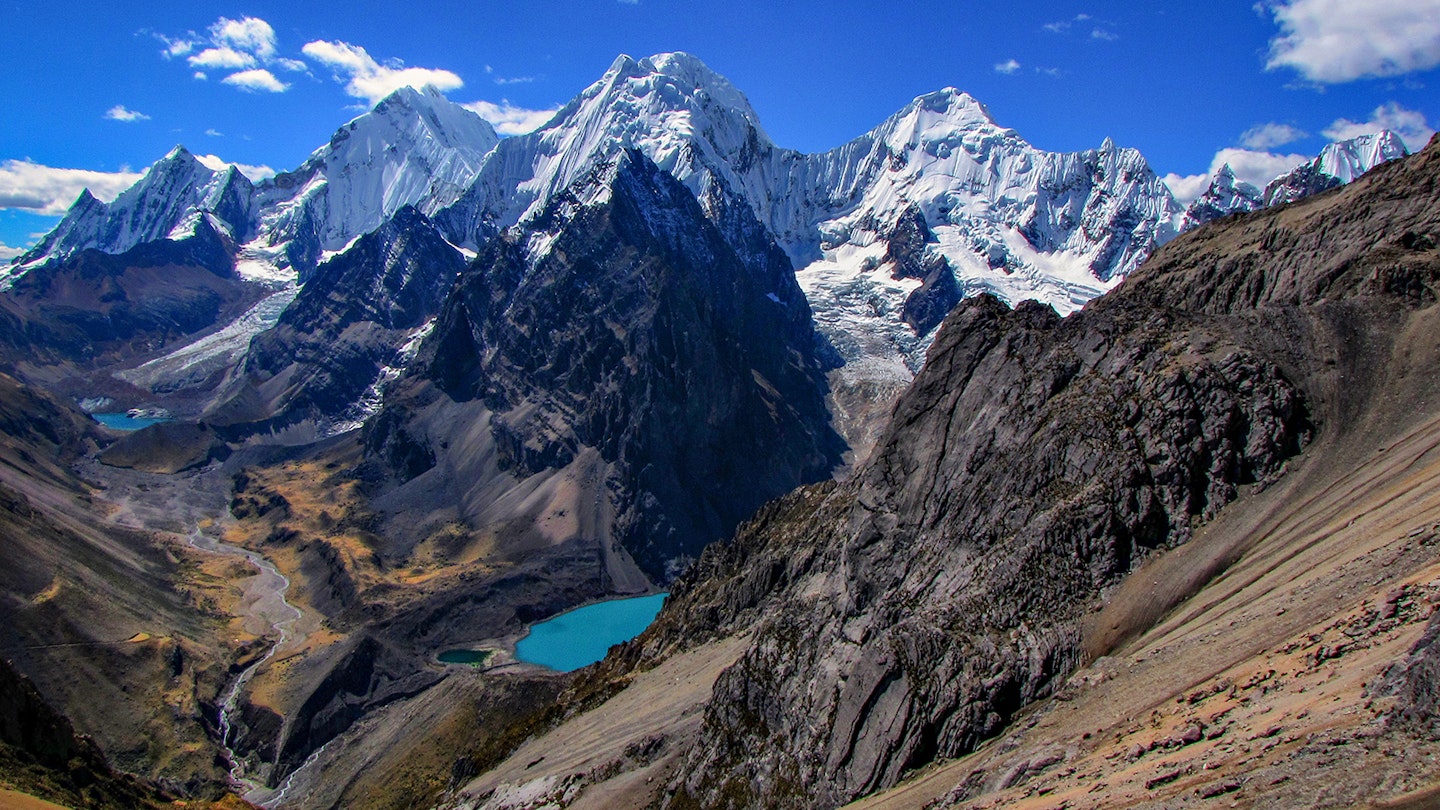
Take your adventure to the next level with a hike on the Huayhuash circuit © Michael Mellinger / Getty Images
More demanding than southern Peru’s Inca Trail and lesser known than neighboring Cordillera Blanca , the Cordillera Huayhuash suits most better as a postcard image than pursuable feat. From extreme altitudes to breathtaking (sometimes literally so) views, hiking the complete Huayhuash circuit has been noted as one of the most physically and emotionally challenging treks in the country, but also one of the most rewarding.

Whether you opt for the full 130km (81 miles) Huayhuash route or one of the many partial hikes, you’ll surely be dizzy with elation (if not elevation) once the adventure comes to an end. But as any long-distance hiker will tell you, it’s all about taking it one step at a time. Take the following tips into consideration when planning your trip:

Nature wins
What does one of the best alpine treks in the world look like? Peru ’s version is a treasure trove of turquoise lakes and thermal springs, barricaded by an army of jagged mountains doused in pristine snow. Along the way, local guides will proudly point out Yerupajá, Peru’s second highest peak (6635m, or 21,768 ft), and can take you to the ridge of Cerro Huacrish for a near panoramic view of the full circuit. Like the condors that hover nearby, you’ll get a bird’s eye view of alpine meadows and extensive grassy fields dotted with sheep, alpaca and other members of the camelid family.
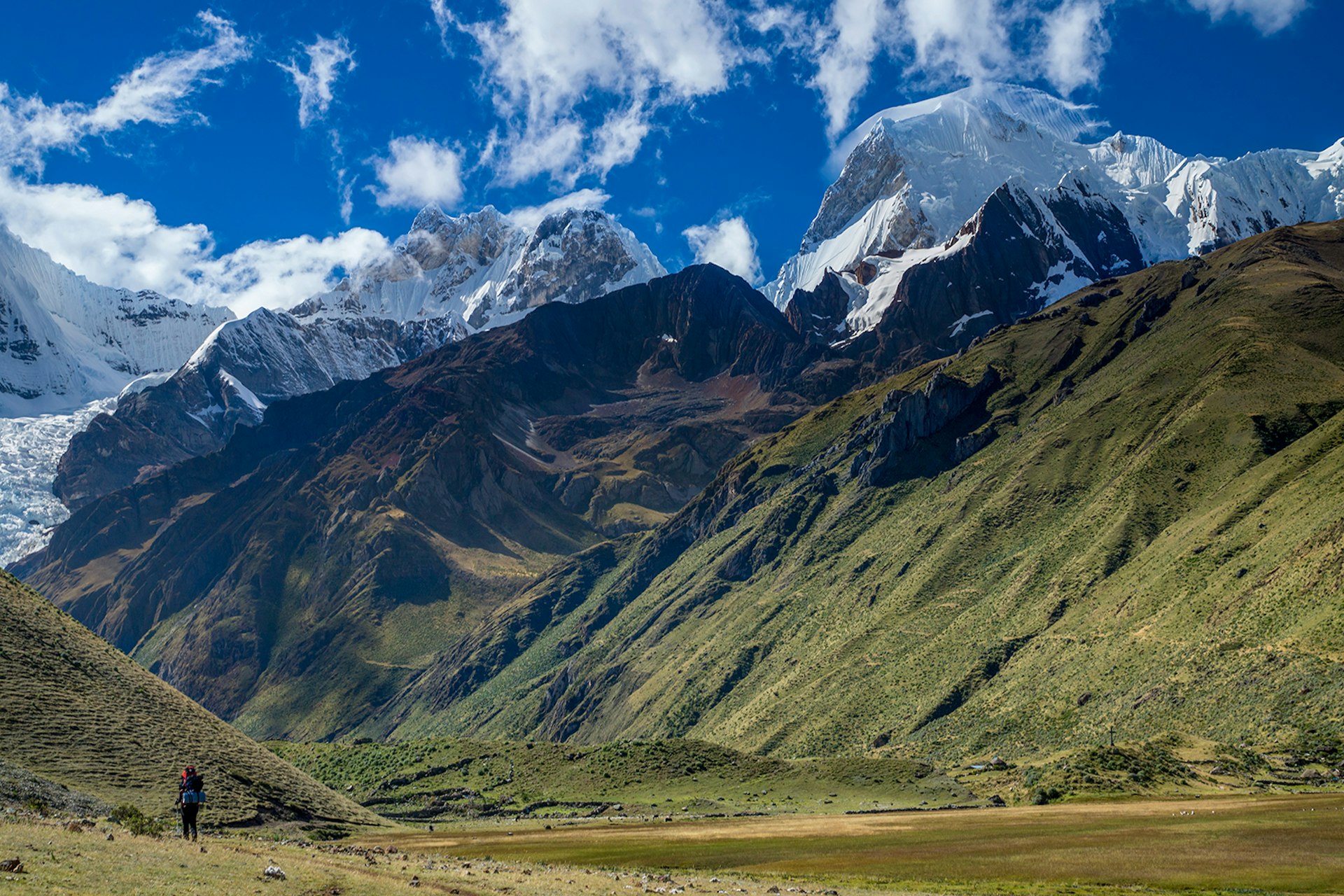
Know where to start
Depending on time and physical restraints, there are various lengths of looping routes to choose from, most of which begin in the small village of Llámac. A popular option is the four-day trek, often referred to as 'mini Huayhuash'. This moderate trek won’t disappoint in terms of stunning views seen from the west side of the mountain range. Of course, to experience the range in all its glory, one must commit to hiking the complete Huayhuash circuit. This route is typically done in just short of a fortnight (10-12 days) at a pace of five to eight hours a day. Since roads to the initial campsite, Quartelhuain, were paved relatively recently, hikers have been known to use this as a starting point; however this would shave off some time and distance from the actual full circuit.
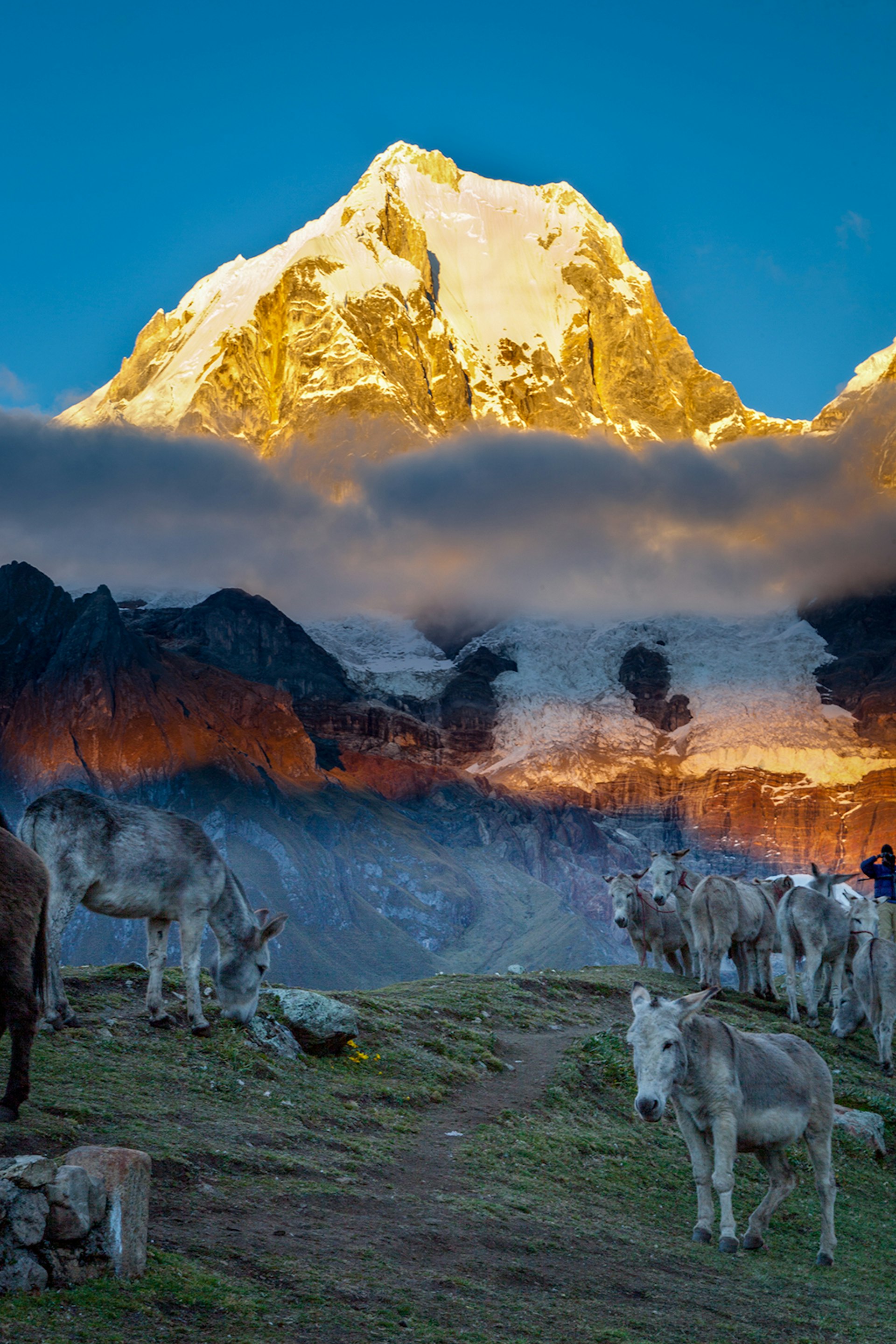
We’d all like to be pointed in the right direction every now and then, especially on a hike. Proof of its rugged qualities, Huayhuash is devoid of posted signs for visitors, so even experienced hikers often end up hiring local guides or travel companies to aid in navigation. Find a guide in Huaraz or put it off until you arrive at villages like Llámac or Pocpa where locals will be eager to lead the way (for a fee). Local guides are going to give you the added value of a deeper and more connected understanding of the mountains, from the meaning behind their Quechua names to the flora and fauna nestled in the high altitude. At a minimum, hikers are encouraged to hire a mule driver ( arriero ) and a pack animal to lighten the load.
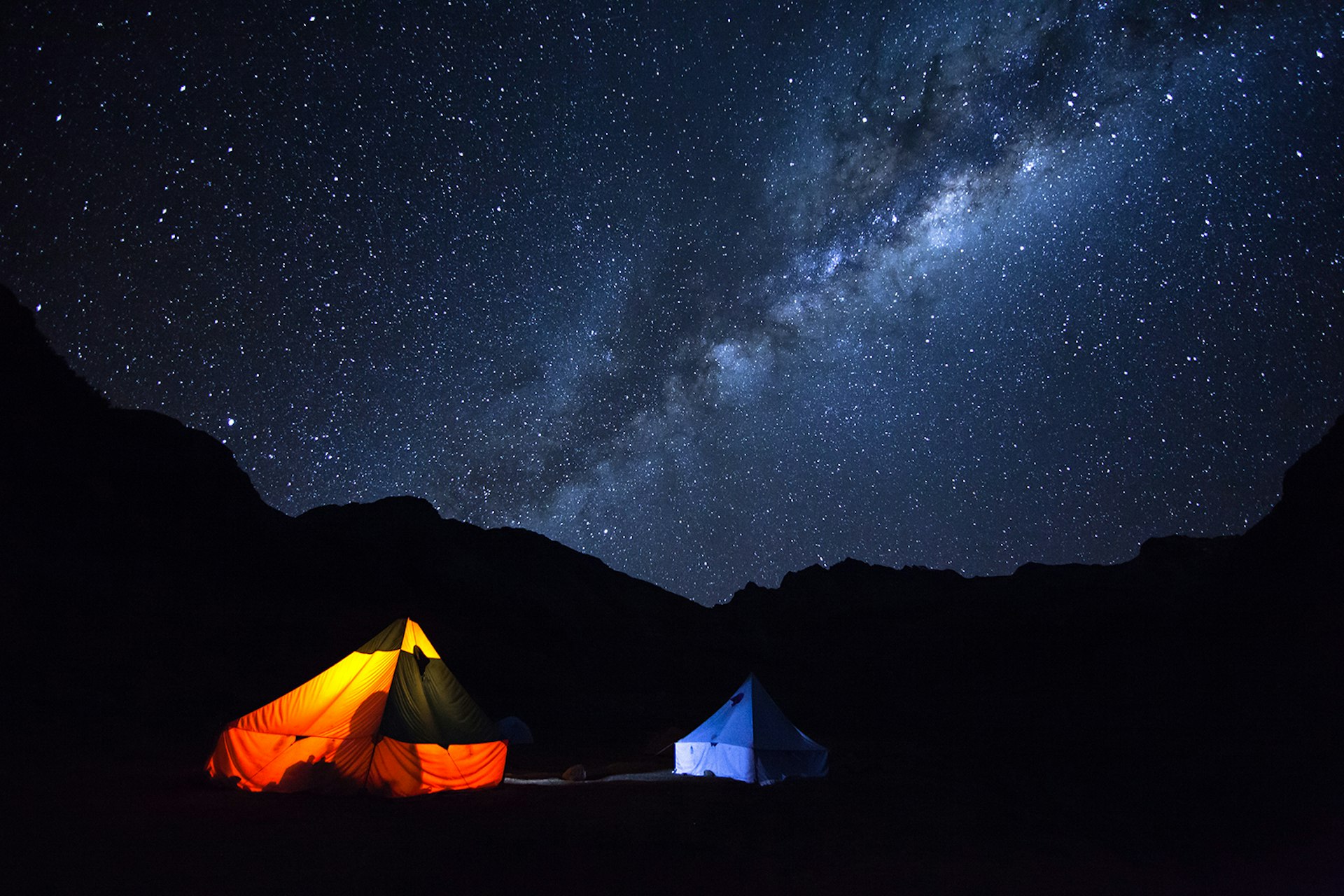
Highs climbs, low temps
Snow-capped mountains above, dry plains below. The stunning juxtaposition of colors and natural landscape found in this region of Peru is what keeps hikers coming back. Though recent years have seen some uncharacteristically heavy rain and snowfall in the mid-year months, the prime hiking season is May-September – chilly yet dry. Pack plenty of layers, a good sleeping bag and tent in order to be prepared for temperatures that can drop as low as -10 ° C (14 ° F) when the sun goes down. Help shake off those chills and ask your guide to take you to the Rio Pumarini hot springs, a warm reward when you reach the Viconga campsite near the halfway point.
Have a tight feeling in your lungs and uneasiness in your stomach? Altitude sickness is prevalent on this undulating trail that nears 5000m at its highest and never dips below 4000m. Even those who take caution by pacing themselves and staying hydrated can be affected, so take it as an friendly reminder to slow down and enjoy the moment.

Keep it together
For well over a decade, the mountain range has been considered a reserved zone though it is not a national park. Communities in the surrounding area are in charge of keeping their respective campsites clean, and while they do the best they can, there have been issues around littering more recently. Strong winds can easily cause food wrappers to flutter, so a floorless ‘cook’ tent can act as a lightweight shelter or windbreaker to keep items from blowing away (and a stove flame from blowing out).
Small fees are required at each campsite, but be sure to spend time talking to the locals to learn more about the surrounding area and culture. Though campsites will be populated by only a few fellow hikers at most, it’s common to pass quite a few shepherds and cattlemen that live in these secluded areas of the Andean range. Perhaps not until you reach Huayllapa, on the second half of the trek, will you realize for just how long you’ve been disconnected; this is where you can replenish supplies. At the end of the trek, share any leftover food or gear that’s no longer of service to you with your guides or residents of Llámac.
Though infrastructure remains below some tourists’ expectations, now is the time to venture to Huayhuash and, with the guidance of locals, challenge yourself to truly step into nature.
How to get there:
From Lima , the city of Huaraz can be reached by an eight-hour bus ride with companies like Oltursa or MovilTours . LCPerú offers daily flights between the capital city and Huaraz, with a flight time of just under one hour. It’s recommended to spend at least a full day in Huaraz in order to acclimate to the elevation. From the city center you can catch a ride on the bus Turismo Nazario in order to arrive at the village of Llámac (a five-hour ride) where you can begin your hike.
Explore related stories
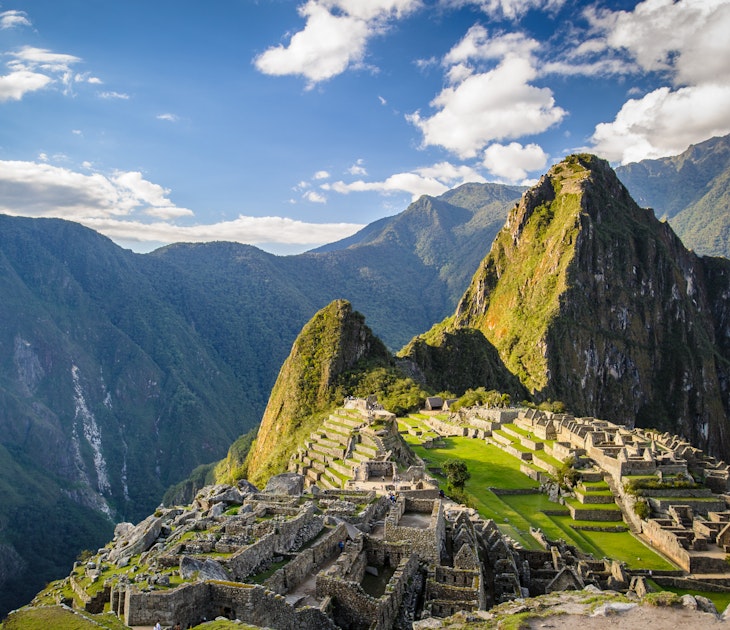
Sustainable Travel
Jan 21, 2018 • 6 min read
It’s one of the world’s most spectacular archaeological sites, yet Machu Picchu has become a victim of its own popularity, with the 2017 introduction of a…
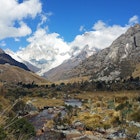
Sep 15, 2016 • 6 min read
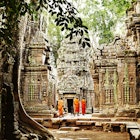
Aug 17, 2015 • 6 min read
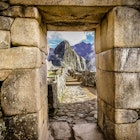
Oct 24, 2014 • 5 min read
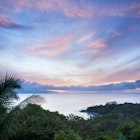
Feb 17, 2014 • 10 min read
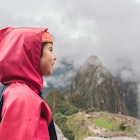
Jan 30, 2024 • 7 min read
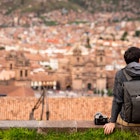
Jan 10, 2024 • 6 min read

Jan 2, 2024 • 11 min read

Dec 27, 2023 • 8 min read
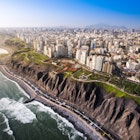
Dec 12, 2023 • 5 min read
You are here: Home » Treks Around the World » Huayhuash Trek, Peru: All You Need to Know About Hiking in the Cordillera Huayhuash
Huayhuash Trek, Peru: All You Need to Know About Hiking in the Cordillera Huayhuash
Last Updated on November 18, 2022 by Audrey Scott
Doing the Huayhuash Trek in the Cordillera Huayhuash in Peru had been a dream of ours for over a decade. Although our expectations were high, the reality of our experience far exceeded them: eight high mountain pass crossings, surrounding peaks of 6,000+ meters (20,000+ feet), turquoise alpine lakes, stunning glacier-covered mountains, and a diversity of landscapes. Each day felt like a different experience, a new discovery. After answering endless questions about planning, organizing and preparing for a Huayhuash trek, it’s time to share it all in this Huayhuash Trekking Guide.
Many people have never heard of the Cordillera Huayhuash since the Inca Trail and Machu Picchu usually get all the tourist and adventure travel attention in Peru . However, this small sub-range of the Peruvian Andes packs a huge punch for its size. Although only 30km long it includes six peaks over 6,000 meters (20,000 ft.) and features spectacular panoramic views of scores of high snow-covered peaks from different perspectives.
It’s not a coincidence that the Cordillera Huayhuash, together with the Himalayan Mountains in Nepal and India , is often listed among the top in the “best places in the world to trek” lists. Yes, it's that stunningly beautiful.
Here's why the Huayhuash Trek is one of the best treks we've ever done and why we continually recommend it. Writing this Huayhuash Trekking Guide brings back excellent memories and makes us want to return to explore even more.
How to use this Huayhuash Trekking Guide: This article is intended to be comprehensive. It contains all the information we wish we'd found when we researched and planned our own Huayhuash Trek. It includes all you need to choose, organize, pack for and enjoy trekking in the mountains of the Cordillera Huayhuash. Plus, it outlines what to expect day by day on the Huayhuash Trek. If questions remain, leave a comment so that others may benefit from the answer and information.
Table of Contents
Peru Covid Travel Update
Peru is open to travelers and you can find all of the Covid travel and entry requirements on this official website . In addition to filling out a health declaration in advance, you will need to show proof of vaccination or testing to enter the country.
Currently (February 2022), the local communities along the Huayhuash treks are open for foreign visitors and camping, but some may have special requirements to enter. Be sure to check in advance with your trekking agency or tour operator. In addition, for safety and health reasons many trekking agencies are limiting group tours and are focusing mostly on individual tours.
Choosing a Huayhuash Trek
Huayhuash treks fall roughly into two categories: short (4-7 days) and long (8-14 days). If you have the time, we recommend choosing a route that is 10-12 days through the Cordillera Huayhuash. This length of circuit can provide a complete Huayhuash experience and deliver more views and stunning landscapes than you thought possible in one trek.
Classic Huayhuash Trek (8-14 days)
Longer treks will take you over more mountain passes in a full circuit so you can appreciate some of the high peaks from multiple angles. Each day includes at least one, and sometimes two, mountain passes ranging from 4,000+ meters/ 13,000+ feet up to 5,050m/16,570 feet. It is recommended to do three acclimatization hikes in and around Huaraz before embarking on one of these treks (see below for details).
We chose a 10-day Huayhuash trek and were very happy with the route, pace, difficulty and overall experience. We met other trekkers who had done an 8-day trek, but we found their route cut out some of our favorite vistas.
Short Huayhuash Treks (4-7 days)
Also known as Mini Huayhuash Treks, these shorter routes intend to provide trekkers a sort of “best of” sample of the Cordillera Huayhuash in a shorter period of time. These routes tend to focus around Lake Jahuacocha or Lake Carhuacocha and cross over several 4,000+ meter / 13,000+ feet mountain passes. Although not as challenging as the full Huayhuash Trek, these treks still require prior acclimatization in and around Huaraz.
Note: If you don’t think that you have the time, physical endurance or strength to do one of the Huayhuash Treks, consider one of the Santa Cruz treks in the nearby Cordillera Blanca. As we understand, these treks still include stunning scenery but are shorter and less physically demanding.
What to Expect on a 10-day Huayhuash Trek: Day by Day
- Our Route: Matacancha – Mitucocha – Carhuacocha Lake – Huayhuash – Viconga – Huanacpatay Valley – Huayllapa Village – Gashpapampa Valley – Jahuacocha Lake – Llamac Village
- Total Hiking Distance: 70.4 miles / 113 km
- Number of Days: 9 nights/10 days, including a van transfer to the trailhead from Huaraz on Day 1 and return to Huaraz on Day 10.
- Maximum Altitude: 5,050 (16,570 feet)
- Season: May – early September (dry season)
- Difficulty: Medium-Difficult
Note: The itinerary outlined below is the one that we took. Although the route is the same, some of our campsites and overnights may differ slightly from some of the classic 10-day Huayhuash Trek itineraries. Together with our guide, we decided to adjust the itinerary so that we would climb up to San Antonio Pass on the morning of Day 7 vs. the afternoon of Day 6. This meant that we spread out the campsites after that a bit differently and did not have two nights at Lake Jahuacocha — a deliberate itinerary adjustment which was preferable to all of us.
We calculated distances and times using an exercise app. While fairly accurate, there may be some small differences than if we'd used a more sophisticated GPS device.
Day 1: Drive from Huaraz to Matacancha (4,150 meters / 13,615 feet)
This is a driving day (7 hours) from Huaraz to get you to the trailhead so that you ready to start hiking the next day. You go through some beautiful scenery, including some overlooks with views of the Cordillera Huayhuash and a drive over the Cuncush Pass (4,750 meters/15,580 feet).
Day 2: Matacancha – Cacanan Pass – Mitucocha
Once at the trailhead, you’ll have time to unload all the gear, learn how to set up your tent, enjoy views of Mount Rondoy (5,870 meters / 19260 feet) and eat a hearty dinner before turning in early for the night.
- Hiking Distance: 5.66 miles / 9.1 km
- Number of hours hiking: 5 hours
- Maximum Altitude: 4,700 m (15,420 feet)
This day begins with a steep zigzag ascent to Cacanan Pass (4,700 m/15,420 ft) which marks the continental divide (all rivers east of it flow towards the Amazon and all on the west flow towards the Pacific Ocean). Enjoy a snack and rest at the top before descending into a green valley where you may find a few vicuñas (related to llamas) grazing high in the hills or vizcachas (animals which look like a rabbit crossed with a squirrel) dashing around.
You’ll also have your first view of some of the snow-covered high peaks of Ninashanca (5,607 m), Jirashanca (6,094 m) and Jiraschanco Chico (5,445 m). The trail continues past the small village of Janca to the campsite near Lake Mitucocha at the foot of Mount Jirashanca.
Day 3: Mitucocha – Carhuac Pass – Carhuacocha Lake
- Hiking Distance: 6.5 miles / 10.5 km
- Number of hours hiking: 5.5 hours
- Maximum Altitude: 4,650 m (15,255 feet)
The walk up to Carhuac Pass (4,650 m) is rather gentle and takes around three hours. You’ll be rewarded at the top with the first view of Mount Yerupaja (6,634 m), Peru’s second highest peak and the highest of the Cordillera Huayhuash. On the way down towards Lake Carhuacocha you’ll pass some Incan ruins and another small village.
The campsite is on the shore of the lake and features a stunning panoramic view of the snow-covered peaks of Yerupaja, Yerupaja Chico (6,121 m), Siula Grande (6,344 m) Jirashanca and Jirashanca Chico (5,446 m).
Day 4: Carhuacocha Lake – Siula Pass – Huayhuash
- Hiking Distance: 8.5 miles / 13.7 km
- Number of hours hiking: 7 hours
- Maximum Altitude: 4,800 m (15,750 feet)
Wake up before sunrise, grab a cup of coca tea and climb to the top of the hill behind the campsite to watch the light transform the nearby snow-covered peaks as the sun rises. The reflection of the snow-covered peak in the lake is like a mirror, perfectly still and crisp. Mother Nature puts on a beautiful show as the colors change to pink and orange.
This is a beautiful morning walk that winds its way past the turquoise alpine lakes of Grangrajanca (4,245 m), Siula (4,290 m) and Quesillococha (4,332 m). As you rise in altitude to reach Siula Pass (4,800 m) more layers of mountains and lakes appear.
It’s a steep and rocky ascent to the pass, but you’re rewarded with views of Mount Carnicero (5,960 m), Jurau (5,600 m) and the eastern side of Siula Grande (6,344 m). Enjoy a picnic lunch here before descending to the campsite near Huayhuash.
Day 5: Huayhuash – Portachuelo Pass – Viconga (Hot Springs)
- Hiking Distance: 7.3 miles / 11.75 km
- Maximum Altitude: 4,750 m (15,585 feet)
The day begins with a relatively easy ascent to Portachuelo Pass (4,750 m). Enjoy a snack at the top with views of the snow-covered mountains of the Cordillera Raura. The descent is long and steady, passing through green valleys filled with wildflowers and perhaps a llama, alpaca or two.
The Viconga campsite is at the foot of Mount Cuyoc (5,550 m). This campsite is the one place along the trek where you'll have an option to bathe.
Note: There are several hot spring pools near the campsite. We highly recommended you enjoy them thoroughly, both to bathe and to relax your muscles in the warm water. There is a small pool for washing with soap and then two other pools to soak in once you’re clean.
Day 6: Viconga – Cuyoc Pass – Pampa Cuyoc
- Hiking Distance: 5 miles / 8 km
- Number of hours hiking: 4 hours
- Maximum Altitude: 5,000 m (16,404 feet)
This relatively short day includes Cuyoc Pass (5,000 m), the first of the trek’s two 5,000+ meter mountain passes. This is a relatively long switchback ascent through rocky, high desert terrain. The panoramic views from the top are spectacular and include a sort of “best of” the Cordillera Huayhuash, including Jurau, Sarapo (6,127 m), Siula, Yerupaja, Rasac (6,017 m), Tsacra (5,548 m) and Huacrish (5,622 m).
Descend to Pampa Cuyoc at the base of San Antonio Pass (5,050 m) for lunch and a relaxing afternoon. There are optional short hikes to nearby hills for anyone who still wants to stretch their legs.
Note: Many itineraries include an optional climb up to San Antonio Pass on the same day with an overnight at Huanacpatay campsite. Together with our guide, our group opted to hike up to San Antonio in the morning when the skies were clearer and we had more energy.
Day 7: Huanacpatay Valley – San Antonio Pass – Huayllapa Village
- Hiking Distance: 11.7 miles / 18.8 km
- Maximum Altitude: 5,050 m (16,570 feet)
Begin this day with a steep climb up the scree and rocks to San Antonio Pass (5,050 m), the highest pass of the trek. Take your time at the top to enjoy the best viewpoint of Mount Siula Grande (of “ Touching the Void ” fame) and nearby alpine lakes. You may also spot a few condors flying about, searching for prey.
Descend the same way and continue on the trail through a series of green valleys and cultivated fields to Huayllapa village. After you set up camp in one of the school fields, enjoy a walk through the village.
Note: this is the only set of shops and services you will come across on the trek. Someone in our group had his hiking shoes repaired here as one of the soles had begun to fall off.
Day 8: Huayllapa Village – Tapush Pass – Gashpapampa Valley
- Hiking Distance: 7.2 miles / 11.6 km
Leaving the village behind the trail takes you up to a high plateau that rises gradually up to Tapush Pass (4,800 m). You’ll have glacier-covered Mount Diablo Mudo in front of you for much of the way up to the pass. Views over Lake Susucocha (4,740 m) are revealed at the top. Enjoy the wildflowers, birds and views of the Cordillera Blanca in the distance as you descend into Gashpapampa Valley for the night. Once you reach camp, bundle up since this was a pretty cold night and morning for us.
Day 9: Gashpapampa Valey – Yaucha Pass – Cerro Huacrish – Jahuacocha Lake
- Hiking Distance: 5.8 miles / 9.3 km
- Maximum Altitude: 4,850 m (15,910 feet)
Each time you think that the views and the moment can’t get any better, they do. Take it slow and enjoy.
The day begins with a slow and steady scree-covered ascent which takes you up to Yaucha Pass (4,850 m), the final high mountain pass of the trek. As you come over the pass you have an incredible panoramic view of Cordillera Huayhuash’s highest peaks, decked out in glaciers and snow-covered. Talk about dramatic. Keep your eyes out for condors here as well.
Continue on to Cerro Huacrish with another beautiful view to both the giant peaks of the Cordillera Huayhuash on the right and Cordillera Blanca and Huallanca on the left. Just sit and take it all in. Finally, as you descend towards Lake Jahuacocha you’ll reach another ridge that overlooks the turquoise lakes below surrounded by mountains.
There is one last very steep descent through pastures and grazing cows to get to the campsite near the shores of Lake Jahuacocha. Watch how the light and the reflection on the lake of the surrounding mountains changes throughout the day.
Since we had free time in the afternoon we did an optional hike out to Solteracocha Lake (3.6 miles / 5.8 km) that took two hours. Climb up to the rim above the lake and just enjoy the deep turquoise color of the alpine lake and the surrounding snow-covered peaks.
Day 10: Jahuacocha Lake – Pampa Llamac Pass – Llamac Village – Huaraz
- Hiking Distance: 8.85 miles / 14.25 km
- Number of hours hiking: 4.5 hours
- Number of hours driving: 5 hours
- Maximum Altitude: 4,300 m (14,110 feet)
This is the last day of hiking and although it isn’t as dramatic as the day before, it's still pleasant and features a relatively easy walk out to Llamac Village. You’ll be able to catch one last view of the Cordillera Huayhuash peaks from Pampa Llaman Pass (4,300 m) before descending through villages and high desert to the village. The vehicle will be waiting there to take you back to Huaraz (about a 5-hour drive).
Best time to do the Huayhuash Trek
The trekking season in the Cordillera Huayhuash and Cordillera Blanca begins mid-to-late May and runs until September. This is the dry season and also considered “Andean summer.” The high tourist season is July and August. During this time you'll have clearer weather, but the lack of rain means that the mountains will dry and brown throughout the season.
We did our trek mid to late May; we felt it perfect timing. We had a bit of rain at the very beginning of our trek, but the mornings were clear and the rains only usually began in the afternoon after we'd already set up camp. After a few days, the rains stopped altogether and we had perfect weather.
Because it was still early in the trekking season, trails and campsites were not crowded. Mountains remained green and lush since the rainy season had just ended.
If you can time it, try your Huayhuash trek during the shoulder season from mid-May to early June.
The low and rainy season is from October to April with the highest rain in January – March. Many high passes are still snowed in from December to March, so that that might make it impossible for trekkers and the donkeys to be able to pass. There is also the risk of landslides during this time which might wash out the trails and hillsides. There have robberies of independent trekkers during this time as are alone with no other people around, so it's not recommended to trek independently in the off season.
Because of all this we recommend timing your trek between May and September or early October.
Huayhuash Trek Difficulty and Conditions
The following information is based on our own personal experiences on a 10-day fully-supported Huayhuash trek. Support included a trekking guide, cook, donkey wranglers, and a team of donkeys to carry our gear, camping equipment, food and trash.
We added information for independent trekkers where available.
Huayhuash Trek Difficulty
We’d categorize the difficulty of the 10-day Huayhuash Trek we did as medium-high, leaning more on the high side of the range. This is because of its daily high mountain pass crossings (4,000+ meter/13,000+ feet), sleeping at high altitude and distance.
Don't let the elevation frighten you away. Our trekking group included people from their late 20s to a 74-year-old (who had both knees replaced within the last three years). We all had prior experience hiking and doing multi-day treks, but none of us were hard core mountain climbers. We'd all simply done our acclimatization treks in and around Huaraz — that's what makes the difference.
While this implies that special training is not required for the Huayhuash trek, you ought to be relatively active and in good physical shape before taking it on. You should be either be accustomed to or prepared for multi-day treks with steep, slow uphill climbs at high altitude.
Not a Technical Trail
The classic Huayhuash trek we did was not technical. To do it, we didn't need special equipment (e.g., climbing ropes, crampons, or other mountain climbing fittings). We do recommend using walking or trekking poles , however. They provide stability and balance and take some of the pressure off your knees and joints, especially on the steep descents.
Huayhuash trekking trails in the mountains are well-maintained and for the most part are relatively easy to follow. There are a couple of streams or rivers to cross, and depending upon the time of year you may need to take your shoes off or consider using river sandals. That’s all part of the fun.
Dealing with Altitude on the Huayhuash Trek
You will reach some high altitudes during the Huayhuash trek. The highest point on our trek was 5,050 meters / 16,570 feet at San Antionio Pass. Each day, we crossed mountain passes ranging from 4,000 – 5,000 meters / 13,000 – 16,500 feet. And, we were often sleeping around 4,000 meters / 13,000 feet. Understanding how your body responds to altitude and how to best manage your response to it is important for your enjoyment of this trek.
At altitude, our advice is to take it slow and steady on the uphill. Our guide, Edgar, was a hiking zen master at this – he would start our group out slow in the morning, especially if we had a steep ascent, so that our bodies could wake up and adjust. If you think you’re going ridiculously slow, then it probably means you are at the right pace. Trekking is like meditation The slower you move, the more likely you are to enjoy what's around you. And the more successful you will be.
It’s better to proceed deliberately and slowly with fewer breaks than to move quickly and wear yourself out so that you need to recuperate with frequent and longer stops. At high altitude this is even more important in order to avoid getting sick and to maintain your energy levels.
In addition, drink LOTS of water as your body needs more liquids at altitude. I would usually drink a liter of water at breakfast before we even began walking, just to have a bit of “hydration reserve.” It’s recommended to drink at least two to three liters a day at high altitudes like this.
Note: If you really suffer from altitude sickness you can also consider taking Diamox. We have avoided taking it by using natural methods (e.g., water, walking slowly, etc.), but we do know people who have benefited from taking it in small doses. Be sure to talk with your doctor first about its side effects, including the additional water you must drink when taking it.
Rain and weather conditions on the Huayhuash Trek
We'd been warned about rain because the timing of our trek coincided with the end of the rainy season (mid-May). We arrived prepared with waterproof ponchos, jackets, and pants. Mornings were usually clearest and at the beginning of our trek, it rained during a couple of afternoons. But we didn’t find the the weather a hindrance to our enjoyment. Only once on the trail were we forced to pile on all the serious rain gear. All other times, the rain arrived only after we'd set up camp, which included a waterproof dining tent.
Carry a waterproof cover for your day pack. Protect any valuable electronic gear like smartphones or cameras in a dry bag or multiple Ziploc plastic bags. All our gear was carried by donkeys, and all the bags were wrapped in multiple layers of plastic tarp to protect them from rain. In addition, we packed our clothes, sleeping bags and other important items in an additional layer of plastic bags.
If you are trekking independently and carrying all your gear with you, you must carry a good waterproof cover for your backpack and use Ziploc or other waterproof bags to keep everything dry inside in the case of heavy rain.
Note: If you monitor weather forecasts and apps, we recommend you consider taking them with a grain of salt. For us, forecasts for the Huayhuash (Ancash) mountain area predicted alpine weather armageddon right up until the moment we began our trek. Reality turned out to be quite different (see the photos). For those of you who book a Huayhuash trek and are freaked out by weather reports — just as we had been — and you find yourself tempted to cancel, seriously reconsider. If you book with a trekking company, as we did, check in with them for a bit of a local weather report reality check.
Food Along the Huayhuash Trek
If you do a fully-supported trek as we did, there's absolutely no chance for you to go hungry on the Huayhuash trek. Our group had its own cook and he created some incredible meals for us using a simple camping kitchen and limited ingredients.
On most days we were served three full meals, with lunch and dinner usually each consisting of 3 courses (e.g., soup or salad, main dish and dessert). On days where the schedule and route was a little tighter, we were given sandwiches as a picnic lunch.
Each morning we we were given bags of treats (e.g., chocolate, quinoa bars, biscuits, fruit, etc.) to ensure we never got hungry on the trail between meals. We always had a mid-afternoon tea and snack break at the campsite. There were always treats and surprises each day.
If you are vegetarian or have food restrictions (e.g., gluten, dairy, etc.), alert your trekking company and guide in advance so they can prepare accordingly.
Independent trekkers will need to carry and cook their own food, of course. There are a few big grocery stores in Huaraz that can supply you with basic ingredients, but if you have a specific type of camping food or brand that you prefer then you should probably bring that from home. Please clean up after yourself! We saw too many empty discarded cans of tuna and other food containers along the trail. That's just rude and disrespectful.
Clean Water Along the Huayhuash Trek
We were provided ample amounts of clean water (i.e., boiled for a certain period of time to kill germs) each morning by our cook and the support team. This is what we drank throughout the day as we walked. Our goal was to drink a minimum of two to three liters of water each day.
Of course, there are lots of mountain streams where you can gather water to drink throughout the trek. We carried water purification drops with us in case we needed to use water from a stream or other source. We never had to use them because clean water had already been prepared for us.
Huayhuash Trek Campsites and Sleeping Arrangements
You’ll be camping and sleeping in tents throughout the Huayhuash trek. There are no real homestays or other sleeping options, except in Huayllapa where there are some family guest houses. We slept in two-person tents (provided by the trekking agency). Although these tents were not huge, we had enough space to sleep and position our belongings on the edges of the tent.
By the time we arrived at the campsite each day, our tents were usually already set up for us by the support team. We were very thankful for this little bit of luxury after a long day of hiking.
Local communities manage the campsites along the different Huayhuash trekking routes. This community-based system is relatively new. It used to be that trekkers could pretty much pitch their camp anywhere, and for free. Understandably, local people got a bit tired of people using their lands, and often not cleaning up after themselves. Communities weren't seeing any financial benefit from tourism development in the region. A system was then set up to compensate the local communities for use of their lands and also to help share some money and benefit from tourism and trekking growth.
Campsites are still pretty basic and located in remote areas, so don’t expect services or shops. In general, you’ll find a place to pitch tents and an outhouse (or two) on the edge usually consisting of a drop toilet or a toilet bowl without water. With the exception of the hot springs near Lake Viconga on Day 5, there is no running water at the campsites. Expect to trek without showers. (Note: if you are on a fully-supported trek like the one we took, you will likely be provided a bowl of hot water in the morning for washing.)
Each community collects a fee from each person (usually $3-$8/person) who stays at a campsite and uses its facilities. You’ll often find an individual or family visiting early in the morning to collect the money. You’ll receive a receipt for your payment.
We heard stories of some trekkers trying to arrive late or pack up early to avoid paying these community camping fees. Just don’t. It’s disrespectful and it creates problems between trekkers and local people, making it difficult for future visitors wishing to enjoy the area.
Organizing a Huayhuash Trek
A Huayhuash trek can be done either independently (e.g., without a guide) or through a trekking agency (e.g., fully supported with a guide, cook, assistants, donkeys to carry gear, etc.). Decision factors include your trekking experience and physical shape, skill at reading trekking maps, budget, weather, and preference. Let's examine these.
Hiking the Huayhuash Trek Independently
Although you won’t see trail markers along the route you can usually pick up trails pretty easily based on their use by trekkers, donkey trains and local shepherds. This means that if you have a lot of experience doing multi-day treks, reading trail maps, using a GPS and hiking at high altitude then you should be able to safely do the Huayhuash trek independently.
Some advantages of trekking Huayhuash independently including being able to create and adjust your own route and setting your own pace. The cost will be much lower as you are not paying for a support team, guide, etc. However, you should still stay at community campsites and pay the required fees so as to respect local people and local community regulations.
However, there are some other considerations. Trekking independently means that you’re carrying all your own camping gear, food, clothing, and more. Since the only real village with shops is Huayllapa, you should expect to carry 7-8 days of food with you. All of this weight adds up and can get heavy, especially when you’re going over a 5,000+ meter / 16,500 foot mountain pass. We saw some trekkers struggle with their packs and the extra weight.
In addition, we also met some trekkers who were lost as they thought they were following one circuit, but ended up on another. Our guide would usually help to steer them in the right direction or offer a short cut to help them get back on track. While this may not sound like a big deal on the surface, it can be quite stressful when you only have a limited amount of food with you and the weather around you is changing as the day wears on.
For more on trekking Huayhuash independently check out this guide .
Choosing a Huayhuash Trek Tour
Given the length, distance and high altitudes of the Huayhuash trek, we knew we wanted to do it supported – with a guide, cook, support team, donkeys to carry our gear. Our goal was to enjoy the walk, including the stunning mountain landscapes and being immersed in nature without worrying about getting lost, carrying all our gear, or struggling to cook or set up our tent each night.
We were and are thrilled with our choice.
Having a local trekking guide provided us with the peace of mind that we were always on the right path. (Some of you may remember, we have a history of getting lost in mountains ).
Our local guide, Edgar, knew everything about the Cordillera Huayhuash from leading trekking and mountain climbing groups there for over 17 years – all the local legends of the peaks around us, wildlife, birds, flowers, natural medicines, and more. As he was Quechua he could also provide context and information about indigenous culture, growing up in the mountains, and changes he’d witnessed over his lifetime.
While doing the Huayhuash trek independently may save you some money and allow you more flexibility in route and pace, our experience proved to us beyond a doubt that the benefits of doing a supported trek with a guide, cook, support team and donkeys far outweighs the costs.
Choosing a Huayhuash Trekking Agency
If you do as we did and work with a trekking agency for a supported Huayhuash trek, the next step is trying to figure out which trek to choose based on the route, level of comfort, budget, and schedule you're looking for.
Booking a Huayhuash Trek in Advance
Because we had a limited window of time to do our 10-day Huayhuash Trek we needed to book our trip in advance. When I began to search around and contact different trekking agencies in Huaraz I found that prices varied quite a bit and could be very expensive, especially if there wasn’t an existing group departure for the dates I wanted.
A bit discouraged, I continued to search, focusing on trekking companies which already had existing trek departure dates that fit our schedule. That’s when I found Quechuandes Travel and Adventure Agency recommended on some traveler and trekker forums and their open group departures calendar ( usually on their Facebook page ).
They had a departure date for the 10-day Huayhuash trek we wanted to do during our limited time window. From the first communication with Marie, the co-owner, I was impressed by the transparency of information, pricing and details. I also appreciated that she was explicit that the price was the same whether we booked in advance or as a walk-in. And, we felt that price was fair to all parties — to us, to the company, and to the guides — from the beginning.
We paid a deposit (50%) to secure our spots for that departure date (Note: Transferwise offered the best rates for this international wire transfer so if you’re new to the service use this link to get a free $500 international transfer ). The remainder we paid in cash when we met in person in Huaraz a few days prior to the trek departure.
Another thing that impressed me about Quechuandes were the materials they sent in advance. They focused on sustainable tourism — the environment and conservation, being respectful of local culture, understanding local socioeconomic issues. You could tell that this information was not copied from the internet, but created after years of experience working with the local communities and in these mountains.
Regardless of which operator you choose to take you on the Huayhuash Trek, select one which works with local guides and support staff, pays fair wages, and operates in a responsible and respectful way towards the environment and local people.
Booking a Huayhuash Trek in Huaraz
If you have a flexible schedule, it’s also possible to book your Huayhuash trek directly in Huaraz, the city which serves as the base for all treks in Cordillera Huayhuash and Cordillera Blanca. There are heaps of trekking agencies around, many with signs outside indicating upcoming trek departures and availability.
You can walk around, meet with different trekking agencies, ask about price and services, and then make a decision. If the price sounds too good, it might be. Ask questions to be sure of what you’re getting for your money. We witnessed other groups on the trail whose food options appeared limited and whose tents and donkeys looked worse for wear.
It’s worth it to spend a bit more for the comfort of a trained guide and cook, and to know that the staff are receiving fair wages and the animals are well cared for.
As the Huayhuash Trek has become more popular these last years many departures are already filled up so you may not be able to get on the trek for the time period you'd like. So if you have any sort of limited schedule it's best to book in advance.
Price of a Huayhuash Trek Tour
Current (2019) costs for for the 10-day Huayhuash Trek with Quechuandes (minimum of 5 people in the group) is $70/day or $700 for the full trek. The maximum group size was eight persons. Given the level of support and service we received we felt this was a very fair price, and it was much lower than many other similar trekking agencies.
The tour and price included:
- private transport to the trailhead (Matacancha) and from the end (Llamac)
- a certified mountain guide, cook, muleteer (donkey handler), and assistant
- donkeys to carry gear (up to 8kg per trekker), food, cooking equipment, etc. + emergency horse
- food, snacks and clean water
- 2-person tent and sleeping mat. If you wanted a private tent, that was an additional fee
The tour price did not include sleeping bags or community campsite fees (approx. 200 soles/ $60 per person for ten days). I rented my Marmot down -10 C sleeping bag from Quechuandes for 20 soles/$6 per day ($60 total). Dan was able to borrow a sleeping bag from a friend in Berlin, but otherwise he would have rented one from them as well. It is essential you carry a proper alpine sleeping bag on this trek.
Renting Trekking and Camping Gear in Huaraz
You can arrive in Huaraz without any trekking or camping gear and be outfitted with all that you need pretty quickly either through renting or buying. Quechuandes, the trekking agency that we used, rents out a large selection of gear (that’s where I rented my -10 C down Marmot sleeping bag). Many other trekking agencies offer the same.
In addition, there are quite a few shops in town specializing in trekking gear where you can buy new or sometimes even used clothes or other items. A couple on our trek bought used fleece jackets and waterproof pants from Huaraz all of which served them well.
Leaving your luggage behind during the trek
Most accommodation and tour operators/trekking agencies will allow you to leave your big bags or luggage with them for the time that you're doing the Huayhuash trek. We left our big backpacks at the hotel in Huaraz we were staying at prior to the trek and then picked them up on our return. Although we haven't heard of any problems with luggage and theft, it's always best to securely lock your bags for their time in storage.
Acclimatization hikes around Huaraz before the Huayhuash Trek
Especially if you’re coming from sea level (e.g., Lima) or low altitudes, it's a wise (if not essential) idea to spend a couple of days acclimatizing in Huaraz (3,050 meters / 10,000 feet) and doing a few acclimatization day hikes. This means hiking to a higher altitude during the day and then sleeping at lower elevation at night (e.g., Huaraz).
For the Huayhuash Trek with its daily high mountain passes, at least three acclimatization hikes are recommended prior to setting off. Marie from Quechuandes essentially told us we had to do a minimum of three acclimatization hikes before starting the Huayhuash trek. This may sound a bit extreme, but we get it. She’s trying to ensure that trekkers identify any problems they may have in advance and be sure they are fully prepared so they can mitigate risks and enjoy the trek to the fullest.
In fact, we met a group of women on an 8-day Huayhuash trek who did not do any acclimatization treks. They were hurting the first couple of days and looked miserable. Don’t do that to yourself. Don't sabotage your trek for the sake of saving a couple of days. It's a poor decision. Altitude sickness is no joke. It’s not fun and it can become very dangerous. It’s better to take the time to acclimatize properly before departing on the long trek. Not to mention, the acclimatization hikes are all pretty fabulous and enjoyable in their own right.
Marie sent us this list of suggested acclimatization treks . After talking with her we chose the following acclimatization day hikes to help prepare us for the Huayhuash Trek.
Lake Wilcacocha Acclimatization Hike
Distance: 11.9 km / 7.4 miles Walking time: 3.5 hours Max elevation: 3,700 meters / 13,140 feet
This is a simple and easy hike near Huaraz. It's a good one to begin with. It features a steady incline for a couple of hours along a dirt road until you reach Lake Wilcacocha at the top. The lake itself is not particularly impressive, but there is a nice overlook so you can get a feel for the countryside around.
To get there, take the Route 10 or Route E collectivo (public bus) from near the Huaraz central market (corner of Raymondi and Hualcan streets). It costs around 2-3 soles ($0.60-$0.90) per person. Let the driver know that you want to get off near Laguna Wilcacocha. After getting off the bus, cross the small bridge and you’ll see a sign at the trailhead.
Lake Rajucolta Acclimatization Hike
Distance: 16.6 km / 10.3 miles Walking time: 5 hours, 20 minutes Max elevation: 4,270 meters / 14,010 feet
This is not one of the typical acclimatization hikes, but it came recommended by Marie. We really enjoyed it. It’s a nice walk that isn’t too difficult at the beginning, but increases in difficulty as you climb up to the lake. Mount Huantsan, the 3rd highest peak in the Cordillera Blanca (6,395 m / 20,980 ft), guides the way and serves as a stunning backdrop to Laguna Rajucolta.
There were no other hikers on the trail the day we went. We and two other hikers going on the same Huayhuash trek as us had the whole place to ourselves, with the exception of a few shepherds and their flocks of animals. Highly recommended.
The Laguna Rajucolta hike requires private transport with a 4×4 vehicle to get there and back as the roads get rough after turning off the main road. The drive takes around 1.5-2 hours from Huaraz. We hired a driver through Quechuandes for around 220 soles ($66) for the entire car (4-5 persons). He dropped us off at the trailhead in the morning and then waited for us all day to return.
Laguna 69 Hike
Distance: 13.8 km / 8.6 miles Walking time: 4 hours, 45 minutes Max elevation: 4,600 meters / 15,090 feet
This is one of the more popular day hikes in the Huaraz region, and for good reason. Located in Huascaran National Park in the Cordillera Blanca, this hike climbs up to Laguna 69, a beautiful alpine lake with Mount Chacraraju (6,112 meters / 20,052 feet) as a backdrop. The views on the path up are also pretty stunning and spectacular. Be sure to allow and take time to look around and enjoy them. There are some challenging, steep ascents. But, that’s also what makes it an excellent acclimatization hike and preparation for the Huayhuash trek.
The easiest way to organize the Laguna 69 hike is to buy a “tour” in Huaraz that essentially includes bus transportation with a guide. We bought ours from Quechuandes for 35 soles / $10.50 per person and had an early morning 5AM pickup at our hotel. You’ll stop for breakfast along the way. If you don’t have a packed lunch with you already, your breakfast stop is also an opportunity to buy lunch for the hike. The entrance fee for Huascaran National Park is 30 soles / $9 per person.
Where to stay in Huaraz
There is certainly no shortage of places to stay in Huaraz . We stayed at El Jacal Classic before and after our trek. It is located a few blocks from the main square and downtown area, so it is both conveniently located and quiet. Request a room that is not at the top of the stairs as it can get a bit loud with people coming and going. Breakfast is served on the rooftop, which has a great view.
If you are hiking with Quechuandes they also offer the Quechuandes B&B now for clients that looks like a great option for staying in Huaraz before and after your trek.
They are accustomed to trekkers, so it's no problem to leave your luggage there when you're off in the mountains.
What to pack for the Huayhuash Trek
Check out our full Ultimate Trekking Packing List with all the details on what to bring with you on a day or multi-day trek like the Huayhuash Trek (or anywhere else). However, we offer a customized Huayhuash Trek packing list to ensure you have what you need, yet don't overpack.
We suggest you ask your trekking agency and perform some independent research about the temperatures at night during the time of your trek. This will determine how many layers you'll need to carry and the weight your jacket(s). For example, temperatures dipped to -10 C / 14 F during a couple of the nights and early mornings on our trek so we were very thankful to have extra layers of long underwear, fleece and more.
As mentioned above, tents and sleeping pads were provided by Quechuandes.
You really don’t need much in this department. Don’t worry about packing clean clothes for each day, as everyone is just wearing the same thing or repurposing the same clothes each day. Here’s what we suggest:
- 1-2 pairs of trekking pants : We're both been using Clothing Arts Travel Pants ( for men and for women ) as our go-to trekking pants these last few years. They hold up well on multi-day treks in terms of hiding dirt, drying quickly, not getting stinky. We find the additional secure pockets useful on treks for keeping phones, money, tissues and other things handy.
- 2-3 short-sleeved t-shirts: Preferably quick-dry or regular cotton ( his and hers quick-dry t-shirts).
- 1 long-sleeved travel/trekking shirt : This is useful not only as a layer of warmth in the chilly mornings when you first start hiking, but also as protection for your arms from the strong sun ( his and hers ).
- Hiking shoes: We both recently shifted to wearing Oboz Sawtooth hiking boots. The insoles and support for your feet are really good, and the shoes are sturdy and can stand up to some tough terrain. In addition, Oboz plants a tree for every pair of shoes sold so you can feel good that your purchase is going towards reforestation and environmental projects. Men's Obuz Sawtooth Hiking Shoes: Buy at REI | Buy at Backcountry | Women's Obuz Sawtooth Hiking Shoes: Buy at REI | Buy at Backcountry
- 1 set of evening clothes for dinner and sleep sleep: T-shirt, long pants (or pajama bottoms), socks. To ensure these remain dry, pack them in a plastic bag or other impermeable container inside your backpack.
- Underwear : Usually one pair for every day of the hike. Here are recommended men's boxer shorts and women's underwear
- Hiking socks: I love SmartWool hiking socks as my first pairs lasted me almost seven years of heavy usage. If you prefer a thinner sock check out their ultra-light line. I often wear a sock liner together with wool hiking socks.
- Bathing suit: For the hot springs on day 5 of the hike.
- Fleece jacket : For cool nights or sleeping (can double as a pillow, too).
- Waterproof rain jacket : For this trek I upgraded to a NorthFace Climatech technology waterproof jacket and I love it. It not only provided protection against the rain and cold, but the jacket material is very breathable so it didn't feel like a sauna inside when I used it. Highly recommended.
- Waterproof poncho: This long backpack poncho goes over you, your backpack and most of your legs so it really provides great protection from the rain.
- Waterproof pants: Pick up a pair of light pull-on biking waterproof/water resistant pants . They fold up into a small bag so they barely take up any room or weight in your backpack, but keep you quite dry when the clouds open up.
- Light down jackets: These can be stuffed into a tiny cinch bag and are so light that you can carry them with you in your day pack. We used these for warmth and comfort at night when temperatures drop. Dan loves his seamless ultra-light down jacket from Uniqlo .
- Flip-flops or river shoes: These are useful for the evenings when you want to get your feet a break from hiking shoes or you need to run to the outhouse in the middle of the night. Women's River Shoes | Men's River Shoes
Other Trekking Gear
- Sleeping Bag : This needs to be comfort rated to at least -10 C / 14 F. I rented my heavy duty down sleeping bag from the trekking agency, Quechuandes. If you are looking to buy a sleeping bag for your trek, one of the guys in our trekking group used this North Face 3-in-1 One Bag Sleeping Bag and found it warm enough and comfortable. Dan was looking at this Hyke & Byke Eolus 0 Degree sleeping bag before one of our friends lent him one to use. It was recommended and seemed like a good price.
- Refillable water bottle: Bring with you 1-2 refillable water bottles and/or a water bladder so that you always have at least one liter of water on you at all times. You'll be able to refill your bottles with clean water in the morning before you leave for the day and when you get to camp in the afternoon. If you really want to play it safe consider carrying with you a SteriPEN or sterilization drops .
- Trekking poles: We highly recommend using trekking poles for this trek, especially for the steep downhill sections. We'll usually share one walking stick set of two so each of us uses one stick. However, most people in our group used two poles each. This set of travel-friendly walking sticks fold up easily for luggage and assemble quickly when on the trail.
- Waterproof backpack cover : You never know when a rainstorm will hit, so it’s essential to keep a rain cover for your backpack close at hand. We also put electronics and other items in plastic or zip-loc bags inside the backpack as a extra protection for them.
- Quick-dry travel towel : To dry off after showers, and also after a swim. Hang it on the outside of your backpack in the morning so it dries quickly in the sun and air as you move.
- Silk sleep sack : To provide an extra layer of protection and warmth between you and the sleeping bag.
- Headlamp : None of the campsites have electricity so a headlamp is essential for finding your way to the toilet and to sort through your stuff at night in your tent.
- Silicone earplugs : A precaution in the case your camp has a snorer.
Toiletries and Health Kit
You'll have access to hot springs to bathe on day 5, but for the rest of your trek you'll receive a small bucket of hot water either first thing in the morning or in the evening to wash your face and other basics.
- Soap, toothbrush, toothpaste and dental floss : The basics.
- Sunscreen : The higher the SPF, the better. You're at high altitudes for most of this trek where it's much easier to become burned. Keep applying sunscreen.
- Sunglasses: At high altitudes the sun is super strong so go for sunglasses that will protect your eyes vs. be fashionable.
- Hand sanitizer: To be on the safe side, especially for lunch and snacks on the trail.
- Pack of tissues: You will be provided with a roll of toilet paper, but it’s always a good idea to carry a pack of tissues in case of messes, spills or emergencies.
- Duct tape : Very effective for hot spots and blisters on your feet. Also consider picking up some Compeed , which is magic when you already have blisters.
- Medical Kit (for emergencies): Band-Aids , anti-bacterial gel (for cuts), rehydration powders, ciprofloxacin/azithromycin (or another medication against stomach bacteria), Tylenol (anti-headache/aches), Immodium (or some sort of “stopper” if you get diarrhea), tea tree oil (great to apply to mosquito bites) Note: all these are easily and inexpensively purchased at local pharmacies, including in Huaraz from where you depart for the trek.
Electricity and Charging Batteries
None of the campsites have electricity. Prepare yourself for not having access to electricity during the trek. Some tips to handle this and further your battery power.
- Put your smartphone on airplane mode. There is no connectivity along the trek anyhow, so don't waste your phone’s battery power trying to find a network.
- We brought a solar powered power bank and used it to charge our smartphones, when necessary.
- Consider buying a phone case that doubles as an extra battery. Here’s an example for our iPhone X battery case . It provides another 1-1.5 charges.
- Take an extra camera battery or two.
- Don’t spent time reviewing your images on your phone or camera, as this will drain your battery power quickly.
Conclusion: Huayhuash Trek, A Trek of a Lifetime
Yep. For us, there's no way to oversell our experience on the Huayhuash Trek. During the trek, we felt the kind of deep decompression we feel whenever we head into the mountains on a long walk. The sense of accomplishment — individually and shared with a group of fun people — is profound. The memories, as we write this piece and flip through one stunning, astounding image after another, are still fresh.
All that's left now is for you to give it a try. Any questions, ask them in the comments. And if you decide to do it, let us know how you get on.
About Audrey Scott
9 thoughts on “huayhuash trek, peru: all you need to know about hiking in the cordillera huayhuash”.
Very helpful. I’m planning a trip to Peru in late April–mid May 2020, and want to hit Cordillera Blanca. I’m an Alaskan, thus somewhat used to high mountains, but these altitudes are a bit higher! All of your advice is good.
Yes, the altitudes in the Cordillera Blanca are pretty high! But, if you acclimatize properly in advance and go slowly, you should be fine. Have a great trip!
We are doing a supported trip in early July. Our goal is to arrive to Huaraz on a Saturday evening. Leave for Huayhuash on Tuesday. We are aware we have to drive first for about 4-5 hrs from Huaraz to access the trail head. We are planning on spending those 2 full days acclimating. We live in Jackson Hole, Wyoming. Our elevation is 6500 ft. We are in good physical condition, I just want to know if 2 days of acclimating will be enough? What are your thoughts?
Great to hear that you’re planning to do the Huayhuash Trek later this year. It’s impossible for me to know exactly about whether 2 days of acclimatizing will be enough, but given that you already live at some altitude and are used to doing physical/outdoor things I think you’ll probably be OK. I would talk with the trekking agency you’re using for their acclimatization hike recommendations, but I would try and do the Laguna 69 hike on your 2nd day of acclimatization as this will push your body and help prepare you for the altitudes to come on the Huayhuash trek. Perhaps do the Lake Rajucolta hike (or similar) on the first, which would be a bit more of a challenge than the Lake Wilcacocha hike. Remember to take it very slow and drink LOTS of water.
Have a great trek!!
Fantastic recommendation. Did the trip include the cost of food? Who designs the menu?
Thank you very very much. Very inspiring and I am psyched to go with my brother and our two 15 yr old sons in June 2020
Our supported Huayhuash trek highlighted here with Quechuandes did have all food included as part of the price. This included not only breakfast, lunch and dinner, but also a bag of snacks (e.g., nuts, quinoa bars, etc.) to carry each day. Food was excellent and done by the designated cook on the trek – a mixture of Peruvian (e.g., causa) and European/American standards (e.g., pasta, mixed vegetables, etc.). If you have any food allergies (e.g., gluten-free) or restrictions (e.g., vegetarian/vegan) let the trekking agency know in advance so that they can adjust their shopping and menus accordingly.
Have a great trek this summer with your sons and brother!! It’s challenging, but so rewarding and beautiful.
Fantastic details in your blog. My trip June 2020 postponed. Hoping to make Huayhuash a reality sooner then later. Thanks for all the details.
Sorry to hear that you had to postpone your June 2020 trip. Huayhuash will still be waiting for you when it is safe again to travel. It is such a beautiful area and the trek is truly fabulous.
Hi all. Just to comment about doing it out of season. I did it in February, the worst month for weather. And it was doable! Definitely lost out on views sometimes and it rained most afternoons – making it cold! But we saw no other trekkers and still had fun! Just a heads up for anyone who can’t choose when they are in Peru!
Leave a Comment Cancel reply
Save my name, email, and website in this browser for the next time I comment.
This site uses Akismet to reduce spam. Learn how your comment data is processed .

Huayhuash. com
Cordillera huayhuash circuit, classic trek.
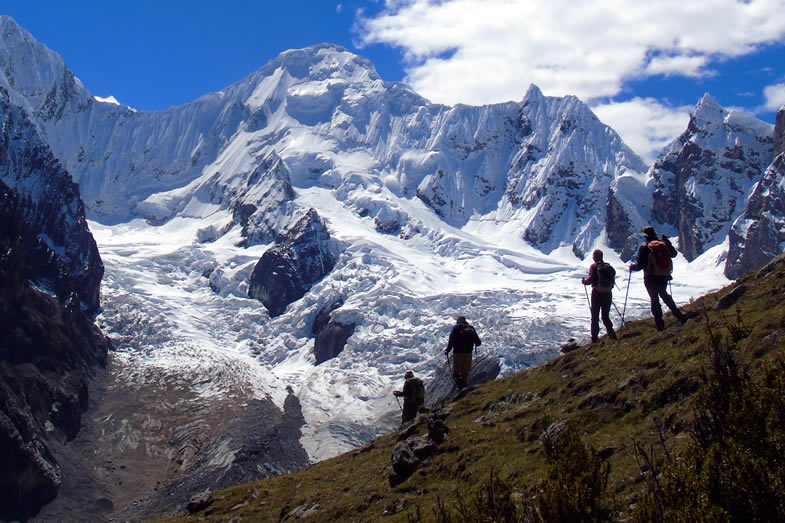
Considered by many adventure and nature lovers, as one of the most spectacular trekking circuits in the Andes. It goes all over whole the Cordillera Huayhuash in 12 days, crossing passes between 4600m and 5000m, camping near to the lakes located under the snow-covered peaks, following trails that take us to viewpoints from where the views of the landscapes are even more impressive, visiting legendary places such as the base camp of Siulá Grande mountain, well known because here took place the epic mountaineering story of Joe Simpson 'Touching the void'; besides observing the daily activities of the settlers who live in the mountain chain; as well as the great diversity of flora and fauna that we find in this region.
- - The classic circuit, also is considered one of the 10 best hiking circuits in the world.
- - One of the wildest mountain ranges in the Andes, where is located the second highest mountain in the tropics, Yerupajá 6634m .
- - Visit whole the mountain range with the escort of a Local crew.
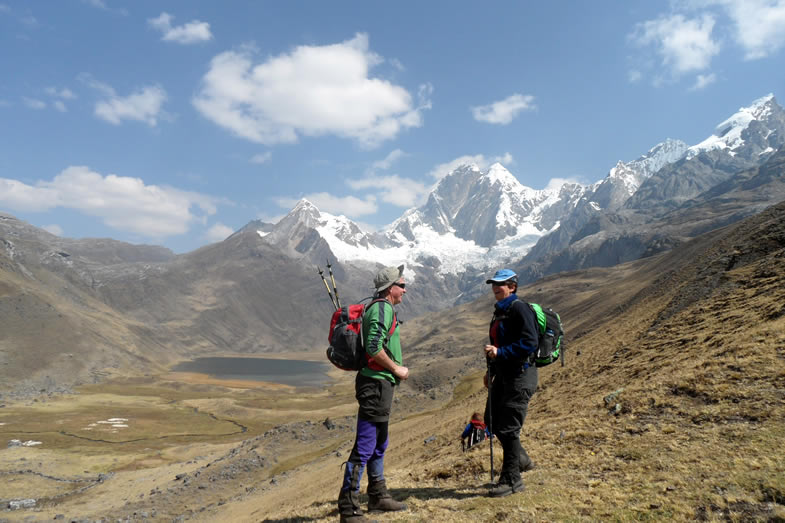
Day 1: Huaraz - Llámac - Cuartelwain 4170 m
At indicated time, pick up in the hotel and transfer to Cuartelwain 4150 m / 13 615 ft, we arrive there after of 5 hours. This will be our first camp.
Day 2: Cuartelwain – Qaqanan pass 4700 m - Mitucocha 4230m
After breakfast, we start walk up to Qaqanan pass 4700 m / 15 419 ft, we get to the pass after of 3 hours; then we go down to the East side of Cordillera Huayhuash, after to have walked 2 hours more we get to the next campsite on the shores of Mitucocha lake 4250 m / 13 944 ft; below of Hirishanca and Rondoy mounts.
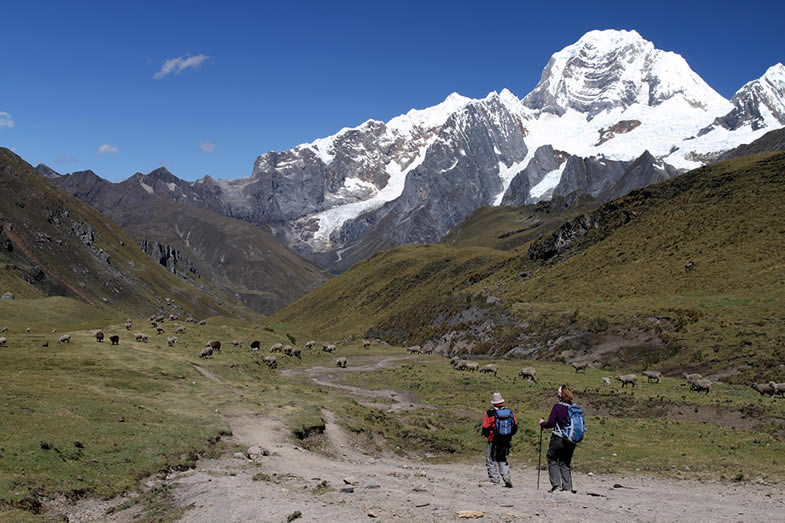
Day 3: Mitucocha - Carhuac pass 4650 m - Carhuacocha 4138 m
At indicated time we take the trail to Carhuac pass 4650 m / 15 256 ft. where we get after of 2.5 hours, from this pass we have a nice view of Yerupaja chico, Yerupaja and Siula mounts; then we walk down 2 hours more to get to Carhuacocha lake 4150 m / 13 615 ft, where we set up our tents on its shores.
Day 4: Carhuacocha - Siula pass 4850 m - Huayhuash 4330 m
This day we depart early for Siula pass 4850 m / 15912 ft, we walk along the shores of Carhuacocha lake, on the way we visit Three lakes (Qanrajancacocha, Siulacocha and Quesillococha), we always will have the view of Hirishanca chico, Yerupaja and Siula mounts; after of 4 hours we reach the pass, from this point we have a panorama of the most snow covered peaks of East side of Cordillera Huayhuash specially of Siula mountain. After resting and having taken the photos we walk down to Huayhuash campsite 4300m / 14 108 ft, where arrive after of 3 hours more.
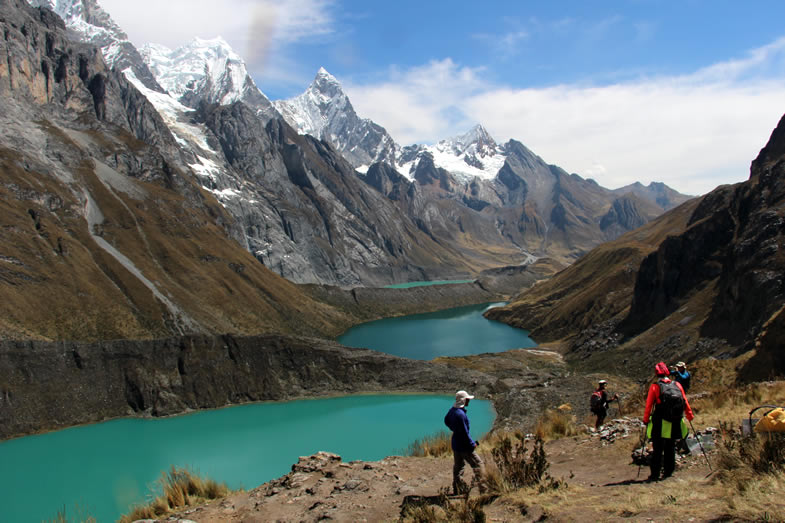
Day 5: Huayhuash – Portachuelo pass 4750 m - Viconga 4400 m
At indicated time after breakfast we depart for Portachuelo pass 4750 m / 15 584 ft, we get to the pass after of 2 hours, this pass is the boundary between the Cordillera Huayhuash and the Cordillera Raura; from the oass we walk down among Ichus (grass plant that lives over 4000 m / 13 123 ft in the Andes), on the way is possible to see llamas and alpacas (Andean camels); we pass near to Viconga lake and we get to our campsite after of 2 hours more, our campsite will be located at 4400 m / 14 436 ft, near to the hot springs.
Day 6: Viconga - Cuyoc pass 5000 m - Guanacpatay (Elefante pampa) 4450 m.
We head to the highest pass, Cuyoc 5000 m / 16 4040 ft, we get there after of 3 hours, this pass is located between Cuyoc and Pumarinri mounts, from this point we have nice views of Cordillera Raura and part of Cordillera Huayhuash too. From the pass we descend to Guanacpatay valley and we set our campsite at 4400 m / 14 436 ft, after to have walked down around 1.5 hours.
Day 7: Guanacpatay – San Antonio Pass 4990 m – Cutatambo 4250 m
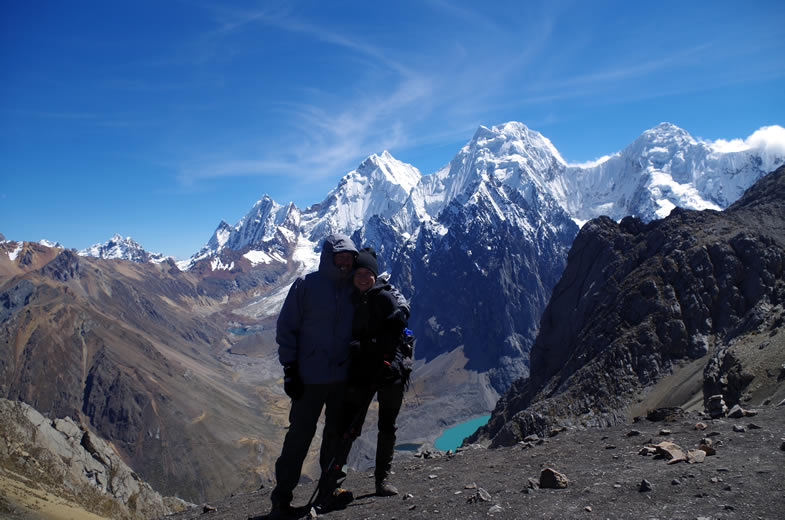
After breakfast we depart for San Antonio, a viewpoint located at 5000 m / 16 404 ft, we get to that point after of 2.5 hours, this point is unique, because from there we have the nicest views of Carnicero, Jurao, Siula Grande and Yerupaja mounts as well as Jurao and Siulacocha lakes. After resting and having taken the photos, we go down to Cutatambo valley 4250m / 13 944 ft, our next campsite where we get there after of 2 hours more.
Day 8: Cutatambo, visit the base camp and glaciar of Siula Grande mount, route of Joe Simpson.
This day we depart for Gran Vista viewpoint 5000 m / 16 404 ft; on the way we visit the base camp and glacier of Siula Grande mount, made famous by Joe Sympson in his book “Touching the void”, and later made into a film with the same name; we get to the viewpoint in 4 hours walking, after to have seen very close the famous mountain, walked around the lake near to the glacier and having taken the photos we return for the same path to the campsite.
Day 9: Cutatambo - Huayllapa 3500 m
At indicated time after breakfast we depart for Huayllapa village 3500 m / 11 483 ft, we take the path near to the river and walk down for around 3.5 hours through the valley of the same name among native trees and shrubs of the region, getting in Huayllapa we can get some sodas and beers.
Day 10: Huayllapa - Tapush pass 4800 m - Qashpapampa 4500 m
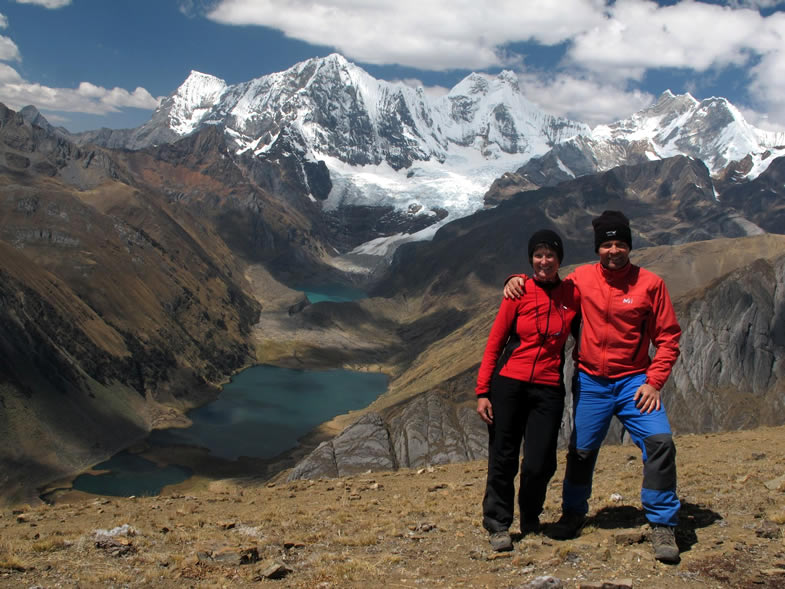
From Huayllapa village we depart for Tapush pass 4800 m / 15 748 ft, we get there after walking around 3.5 hours, from this pass we can see some a part of Cordillera Blanca (Tuco mountain), after a break we go down to Qashpapampa 4500 m / 14 764 ft, located below Diablo Mudo mount, many times used as base camp to climb the mentioned peak, we get to the campsite after of 2 hours more.
Day 11: Qashpapampa - Yaucha pass 4800 m - Jahuacocha 4070 m
At indicated time after breakfast we depart for Yahucha pass 4800 m / 15 748 ft, we get there after of 2.5 hours, from this pass we have a spectacular view of the West side of Cordillera Huayhuash, among the snow covered peaks to see are: Ninashanca, Hirishanca, Yerupaja Chico, Yerupaja 6634 m / 21 765ft (the second highest peak of Peru after of Huascaran 6768m / 22 205 ft), Rasac, etc. After restinh and having taken photos we go down by Huacrish valley to Jahuacocha lake 4070m / 13 353 ft, we get there after of 2.5 hours more. Our tents will be set up near to the shores of Jahuacocha lake, having an impressive view of the mounts of this part of the mountain range.
Day 12: Jahuacocha - Pampa Llámac pass 4300m – Llamac - Huaraz
Last trekking day, we depart for Pampa Llamac pass 4300m / 14 108 ft, we get there after of 3 hours, Pampa Llámac is the last viewpoint of the Huayhuash circuit, from this place we can see by last time very close the mounts of Cordillera Huayhuash; after we descend to Llamac village 3300 m / 10827 ft, in of 2 hours more. In Llamac a car will wait for us to take back us to Huaraz city.
Other options:
• It is also possible to have rest days in Carhuacocha and/or Jahuacocha where you can walk around the lakes to do some fishing. Another option for those in search of more extreme adventure is to organize a climb of Pumarinri (5465m) or Diablo Mudo (5350m). These are two moderate peaks that can be climbed with just one extra day. If you are interested you’ll need to bring basic mountaineering equipment along with you (climbing boots, crampons, ice axe, harness, and rope) and a mountain guide.
Classic circuit map
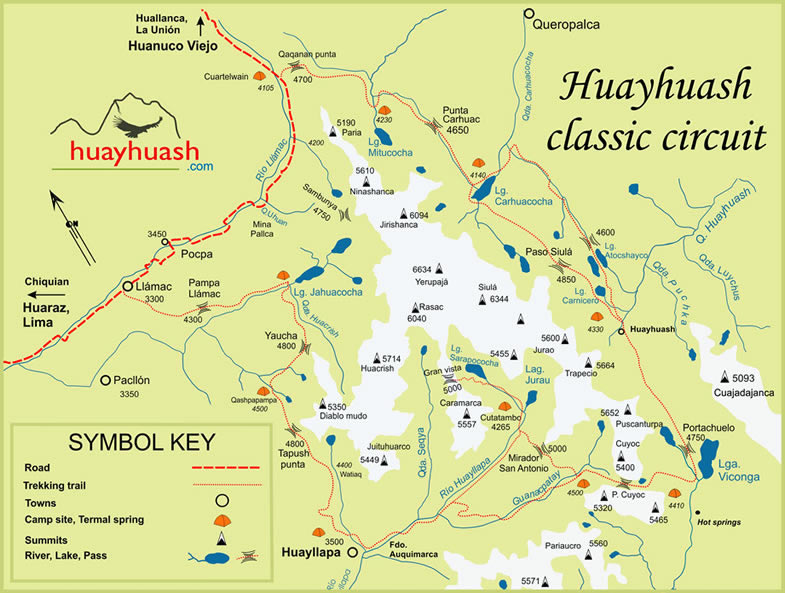
- Altitude profile
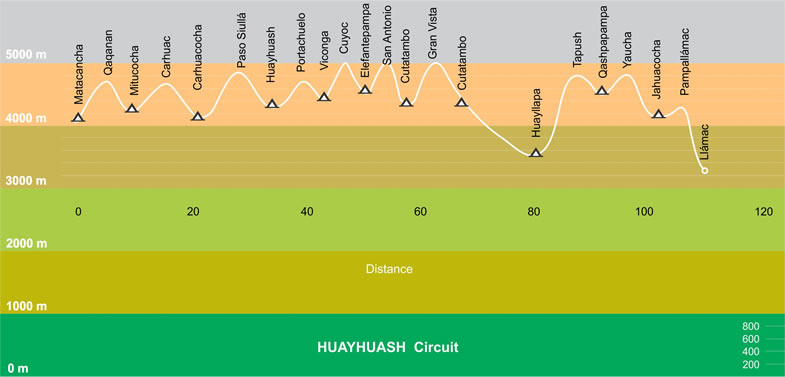
If you are interested in this tour and/or you need furhter information CONTACT US
How difficult is this trek?
The 12-day trek is considered the most difficult of all the routes that there are in the Cordillera Huayhuash, due to the fact that it is carried out in places above four thousand meters and almost every day cross passes above 4600 m / 15091 ft, even some days we reach up to 5000 m; It is well known that in high places the level of oxygen is lower, so breathing becomes quite slow and one gets tired easily; so it is recommended to be in good physical condition and train before coming. Regarding the trail in most of the route is wide, it is the same used by pack animals (donkeys, horses and llamas); except for some shortcuts which lead us to viewpoints that few know and offer us more interesting views, which are not very marked.
The best season for the 12-day trek is from May, which is the month when the dry season begins until the end of September; because the first days of October fall the first rains; even during the months of the dry season (May - September), we have some rainy days, but in general, during the full 12-day journey, it is not normal that the bad weather exceed 2 days, so it is recommended always to carry the waterproof clothing.
Clothing and accessories
It will depend on the way you want to make this circuit, if you are going to be part of a guided tour with a travel agency, we recommend you read our list of recommended equipment; otherwise, if the hiking is going to be carried out independently, to the suggest list you must to add tent, stove, kitchen utensils and everything necessary to camp in remote areas.
Acclimmatization
There are two factors that are very important to make this trek, one is to be in good physical condition and the other acclimation; it is recommended before leaving for this destination to spend at least 2 days in places above 3000m; usually the departure point for this trek is Huaraz city; from here there are many options to make day trips for that purpose. For those who have in mind to visit Cusco, Machu Picchu or another destination located above 3000 m / 9844 ft, they are recommended to start for those destinations because it will serve as acclimatization to make after the Cordillera Huayhuash circuit.
Trekking permit
The trekking route that we call as the classic circuit, is the one that runs through most of the Cordillera, that implies that we visit more areas managed by the communities settled along the mountain range; the payment made to the communities by use of the campsites and visit their territories vary from 15 to 50 soles, in the 12 day trek every passenger must to pay 220.00 Peruvian Soles.
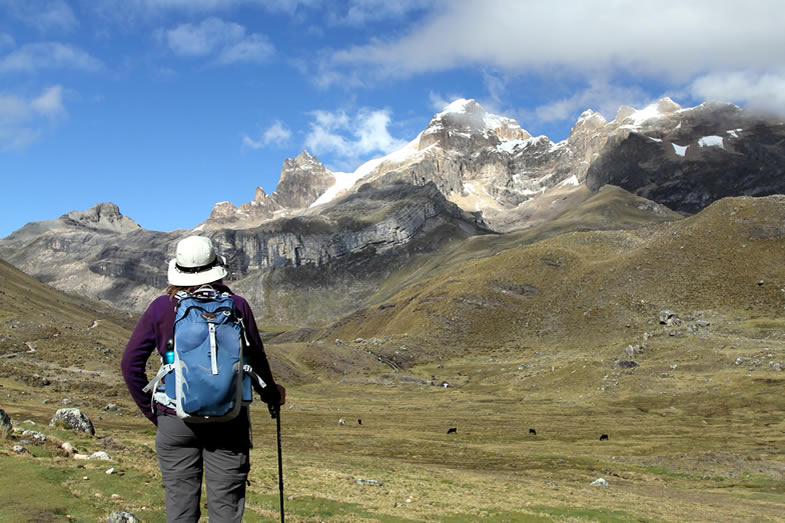
Guided tour vs independent
As the area to visit is remote, it is recommended to take a guided tour, since in those tours there will always be a Trekking Guide who knows very well the place and more people in the crew like: Camp Cook, Assistant and Arriero (Horseman), besides transport the equipment and food for 12 days is very difficult, so the use of pack animals (donkeys, horses and llamas) are necessary. The fact to be part of a guided tour allows to the passenger dedicate just to walk and enjoy the views, because he/she will have everything arranged during the trekking days, the meals will be prepared, the tents will be set up and set down by the crew; in the case of emergency the Trekking Guide arranges everything to evacuate if the problem is serious with a member of the party.
For people who want to do independently, of course they can do it, there is no restriction; but they must come prepared and have experience in multi-day treks; they can organize it in their own way, by carrying their luggage themselves or by hiring at least one Horseman and some pack animals to help with the luggage.
Until 2005 some incidents were reported, some of them serious, where groups of thieves in their desire to steal the belongings of tourists killed some of them; thereafter, the village communities began to administer the territories that correspond to them, they were organized to take care of and also charge in their respective areas; from that date until now no serious cases have been reported, except for the loss of some belongings, which some visitors leave outside the tents at night. Of course, it is always necessary to take the precautions, it is recommendable to walk in pairs; because as the area is remote and some paths are narrow, especially those that lead to the viewpoints; you can suffer falls; and the fact of having company will help asking for help, especially for those who do the trek independently.
Recommended reading
Climbs and Treks in the Cordillera Huayhuash of Peru
Peru's Cordilleras Blanca & Huayhuash: The Hiking & Biking Guide
Plan your trip with local specialists
- Get started
- Detailed itinerary
- Trekking Season 2024
- Let's plan your adventure!
Find your perfect trip:
- Gather friends and you travel for free!
- Looking for partners?
- Traveling with family ?

- Best Hikes In The World
- Appalachian Trail
- European Hikes
- Nepal Hikes
- Patagonia Hikes
- See All Hikes
- Mount Kenya
- Mount Kilimanjaro
- Mount Toubkal
- See All Mountains
- South Africa
- New Zealand
- Switzerland
- United Kingdom
- Packing Lists
Cordillera Huayhuash – Epic South American Circuit Trek (Travel Guide)
The Cordillera Huayhuash Circuit is known to be one of the most challenging and most beautiful treks in South America .
This guide will help you plan your Huayhuash trek, whether you’re going independently or with an experienced guide or trek operator.
Cordillera Huayhuash Circuit Overview
The Cordillera Huayhuash Circuit is a 68 mile / 110km trek through a remote region of the Peruvian Andes . Elevations on this trail reach upwards of 16,600 feet/ 5,060m.
The region was made famous by the tragic mountaineering book (and film) Touching the Void . It is a survival story of a climber who falls into a crevasse after his partner is forced to cut the rope, then has to save himself. Don’t worry though. There is no mountaineering involved on the trail.
The appeal of the Cordillera Huayhuash Circuit is in the scenery. This region is brimming with turquoise alpine lakes, craggy snow-covered peaks, open green fields, misshapen multi-colored mountainsides, and fire-hued sunsets.
It takes anywhere from 7-14 days to complete the Huayhuash circuit, with 10 days being the average pace. There is only one village where you can resupply along the way. Otherwise, it’s entirely a wilderness experience. Be fully equipped with all the gear you need to sleep, cook, and stay warm and dry in the mountains.
The Cordillera Huayhuash region is not nearly as popular of a destination as it’s Cordillera Blanca counterpart. While you will likely see a few other groups every day, it is certainly not a busy destination.
If doing this trek independently, you will arrive via public transportation to Pocpa. From there it takes a few hours to walk to the start of the trail. Alternatively, you could arrange transport with a trekking agency.
It is better to bring backpacking snacks from home for the trek, as the options at the grocery store are limited. If you’re on an extended trip and not beginning from home, perhaps you could do your food shopping in Lima.
There are no permits required for the Cordillera Huayhuash Circuit. However, there are nine different communities charging fees for land use. The total price for all the fees adds up to about 205 soles ($62).
Cordillera Huayhuash Trek Facts
- The distance of this trek is 68 miles / 110km and takes 7-14 days to complete. Most people hike in a clockwise route.
- The maximum altitude on the circuit is 16,600 feet/ 5,060m. There is a total of 18,700 feet/ 5,700m of vertical uphill walking.
- Difficulty is strenuous. It’s a high-altitude, wilderness hike with drastic elevation changes.
- Best months to hike the Huayhuash circuit are May- September.
- Guides are not mandatory, but are recommended for inexperienced trekkers.
- No permits required. There are campsite and land use fees that amount to a total of 205 soles/ $62.
What to expect while trekking the Cordillera Huayhuash circuit
Typical itinerary, huaraz: 2-3 nights.
The city of Huaraz sits at 10,000 feet/ 3,050m. I recommend spending several nights here in order to start acclimatizing. Take a bus out of town and do a day hike to further help with acclimatization.
Additionally, if you have any extra belongings you don’t want to take on the trek, you can store them at your hotel or hostel.
Day 1: Quartelhuain
Catch the 5 am bus from Huaraz to Chiquian. The bus company is called El Rapido . From Chiquian, take the 8 am bus to Pocpa. Once you’ve arrived in Pocpa, it takes several hours of walking along the road to reach Quartelhuian. Spend the night there.
Day 2: Mitucocha Camp
Elevation gain: 1,706 feet/ 520m
It’s a relentless climb up to Cacananpunta first thing in the morning. Then a mellow hike down to the campsite. While this is a short day, I recommend staying at Mitucocha Camp. It’s better to ease into the trek than do two big climbs on the first day in the backcountry.
Day 3: Carhuacocha
Elevation gain: 1,400 feet/ 430m
The climb up Carhuac is rewarded by views of snow-capped peaks on the descent. The campsite is beside an alpine lake and is an excellent spot to catch some sunset photos of the lake and mountains. This campsite is not very large, so expect to be in close proximity to any other trekkers.
Day 4: Huayhuash
Elevation gain: 1,300 feet/ 400m
Today is one of the most spectacular days as far as scenery goes. There are several alpine lakes that act as mirrors to the surrounding peaks.
You can even jump in one if you’re feeling bold and not afraid of the cold. Expect to hear and see giant chunks of ice breaking from the surrounding cliffs and crashing to the ground.
Day 5: Viconga
Elevation gain: 1,380 feet/ 420m
Today is just as scenic as all the rest, but perhaps the highlight of this day is the Viconga campsite. There is a hot spring for weary trekkers to soak in while enjoying the surrounding mountains. The man-made concrete tubs are filled with natural hot spring water, and it’s the perfect way to end a long day.
Day 6: Cuyoc Camp
Elevation gain: 2,330 feet/ 710m
This is the biggest elevation gain of the hike so far. However, it’s not as steep as previous climbs and you should be well acclimatized by now. Take it slow. You’ll be rewarded at the top with views of peaks and colorful mountains.
Day 7: Huatiaq
Elevation gain: 2,525 feet/ 770m; however, there will be additional elevation gain if you choose to take the scenic route in the morning
The guidebook suggests two days to reach Huatiaq from Cuyco Camp, but it is possible to do in one. This is also the day you can go to Huayllapa to resupply. You can start your morning by choosing your route: a more scenic, uphill climb. Or an easier walk down the valley if you’ve had enough of stunning mountain scenery.
There’s a small shop in Huayllapa where you can buy basic supplies. They don’t have anything too extravagant; just Ramen noodles, oatmeal packets, and packages of cookies.
After visiting the village, start the steep climb up to the campsite.
Day 8: Incahuain
Elevation gain: 2,750 feet/ 840m
This is the last full day of trekking the circuit. There are two passes today, and after you can choose to do a ridgeline walk if you want to get some bonus views. The ridgeline is not too difficult, so you might want to give it a go. Finally, after more alpine lake views, you descend down to your final campsite of the trek.
Day 9: Llamac
Elevation gain: 1,100 feet/ 340m
Set off early if you’re planning on taking public transportation back to Huaraz. The bus leaves around 11:30am. There is one final low pass to get over, then you hike down into the village of Llamac.
Things You'll Need for Your Cordillera Huayhuash Trek
Gear checklist.
- Backpack (about 50L)
- Trekking poles
- Tent (there are no trees for tying tarps or hammocks)
- Sleeping bag , around 20 F (-7C) and a sleeping pad (in case you aren't hiking with a tour operator)
- Camp stove and fuel canister, can be purchased in Huaraz
- Water bottles, capacity for 2-3L
- Water treatment method
- Navigational equipment: map, compass, guidebook, GPS or SmartPhone
- Hiking clothes
- Trail runners / hiking boots
- Rain jacket
- Down jacket / warm synthetic layer
- Long-sleeve base layer shirt
- Base layer bottoms
- Warm hat and gloves
- Sunscreen and trekking sunglasses
You're welcome to check out our multi-day hiking list for more helpful ideas on what to pack for Cordillera Huayhuash.
Recommended Guidebooks and Maps
Peru’s Cordilleras Blanca & Huayhuash: The Hiking & Biking Guide is the most comprehensive resource on the circuit.
Please Note: The latest version of this guidebook will go on sale on Amazon on 1 September 2023 . So, make sure you're first in line to buy it!
You can also download the maps.me maps of the region, since a lot of the trail is marked on the app.
If you’re trekking without a guide, we recommend buying a map at one of the trekking shops in Huaraz.
Please Note : It’s important that hikers who go without the assistance of a guide and mules are aware of what they’re getting into. This is a high-altitude trek through a remote region of the Andes with no road access. Should something go wrong, it would not be easy for help to arrive.
Hikers must be fully equipped with enough food to last until the village of Huayllapa. The threat of acute mountain sickness is real, and hikers should have an understanding of symptoms and treatment.
Furthermore, there are no trail signs and sometimes the path is not obvious. Trekkers should have a basic understanding of navigation and carry a map, compass, and GPS or SmartPhone with the regional maps downloaded for offline use.
Cordillera Huayhuash FAQs
When is the best time to hike cordillera huayhuash.
May to September are the best times to hike the Cordillera Huayhuash Circuit.
The weather is cold, but dry. Expect frost on your tent every morning and have layers accessible during the day.
The other months of the year are the wet season, and the passes will likely be difficult to cross because of snow.
What can I expect on a typical Cordillera Huayhuash trek?
There are no permits for this trek but bring enough money for the land use fees. They amount to 205 soles ($62).
Take the local buses to get to the trailhead. Arrange your ticket the day before at the El Rapido bus station in Huaraz.
The bus to Chiquian leaves at 5am, and from there you will catch a different bus to Pocpa. On the last day of your hike, catch the 11:30am bus out of Llamac.
Either bring food for the trek from home or buy it in Lima, as Huaraz does not have many good options for backpacking food.
How difficult is the Cordillera Huayhuash Circuit Trek?
The Cordillera Huayhuash Circuit is an extremely difficult trek, especially if you are planning to self-navigate and carry your own gear.
While the distances may seem small, keep in mind that it is at a high altitude with drastic elevation changes.
Furthermore, there is no easy way to get out should you experience symptoms of acute mountain sickness.
Therefore, it is crucial that you take several days to acclimatize in Huaraz and do a day hike before beginning the circuit.
Is it safe to hike the Cordillera Huayhuash Circuit alone?
In terms of is the region safe for tourists, yes, very much so. In terms of if the mountains are safe for you personally, this really depends on your experience.
Ask yourself these questions:
- Do you feel comfortable navigating your own way in the mountains?
- Have you gone on a backcountry trip of similar length before?
- Do you have experience hiking at high elevations?
If the answers are yes, then you are probably ready.
Where do I find water along the Cordillera Huayhuash Circuit?
All of the Cordillera Huayhuash campsites have water sources, and there are streams throughout the day as well. Just be sure to fill up before you start up the passes, as you might hike several hours between water sources during the day.
Is acute mountain sickness a risk with Cordillera Huayhuash?
Yes. Do proper research ahead of time on what the symptoms of mountain sickness are and be aware of how to treat it. You can read about acute mountain sickness.
Do I need travel insurance for Cordillera Huayhuash?
If you plan to hike Cordillera Huayhuash Circuit, make sure that you are adequately insured for up to 4,000m. Get a quote from World Nomads .
Do I need to know Spanish for Cordillera Huayhuash?
Not necessarily, but it is helpful if you learn a few Spanish phrases. While traveling around Peru, it will be a challenge to get around if you are only trying to speak English.
Once on the trail, you really don’t need to speak to that many people other than the locals who collect land use fees. If you don’t know Spanish, don’t let it be a deterrent to coming to Peru. Just be ready to have a tough time.
You may also like...
See our detailed guide to South American mountain ranges . Or check out our country hiking guides below.
- Best Hikes in Chile
- Best Hikes in Argentina
- Best Hikes in Ecuador
- Best Hikes in Mexico
- Quilotoa Loop Trail
- Best Hikes in South America
- Climbing Chimborazo
- Best Hikes in Patagonia
Also see our detailed Mountain Guides or explore our Hiking Tours available exclusively on Mountain IQ .
References : BBC Travel , Lonely Planet , Wikipedia
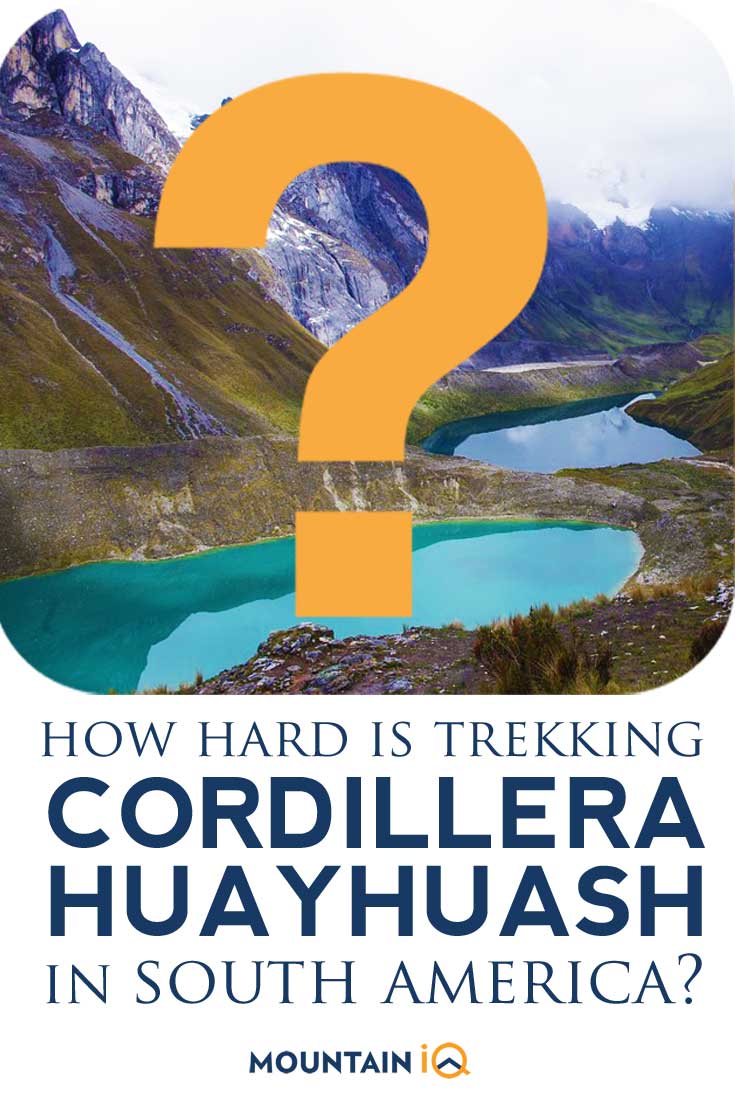
About the author
Megan Maxwell
Megan is a long-distance hiker, blogger, author, and outdoor professional. She has travelled all over the world in search of mountains and unique trails. She found her love of hiking on the Appalachian Trail back in 2012 and since then has hiked in the Himalayas, the Andes, and a few countries in Europe. On her blog, Mountains with Megan she provides information on hiking and backpacking all over the world.
Leave a Reply
Your email address will not be published. Required fields are marked
We work with local guides to offer great value adventures at unbeatable prices.

Trekking Peru's Cordillera Huayhuash
A self-supported journey on peru's stunning huayhuash circuit.
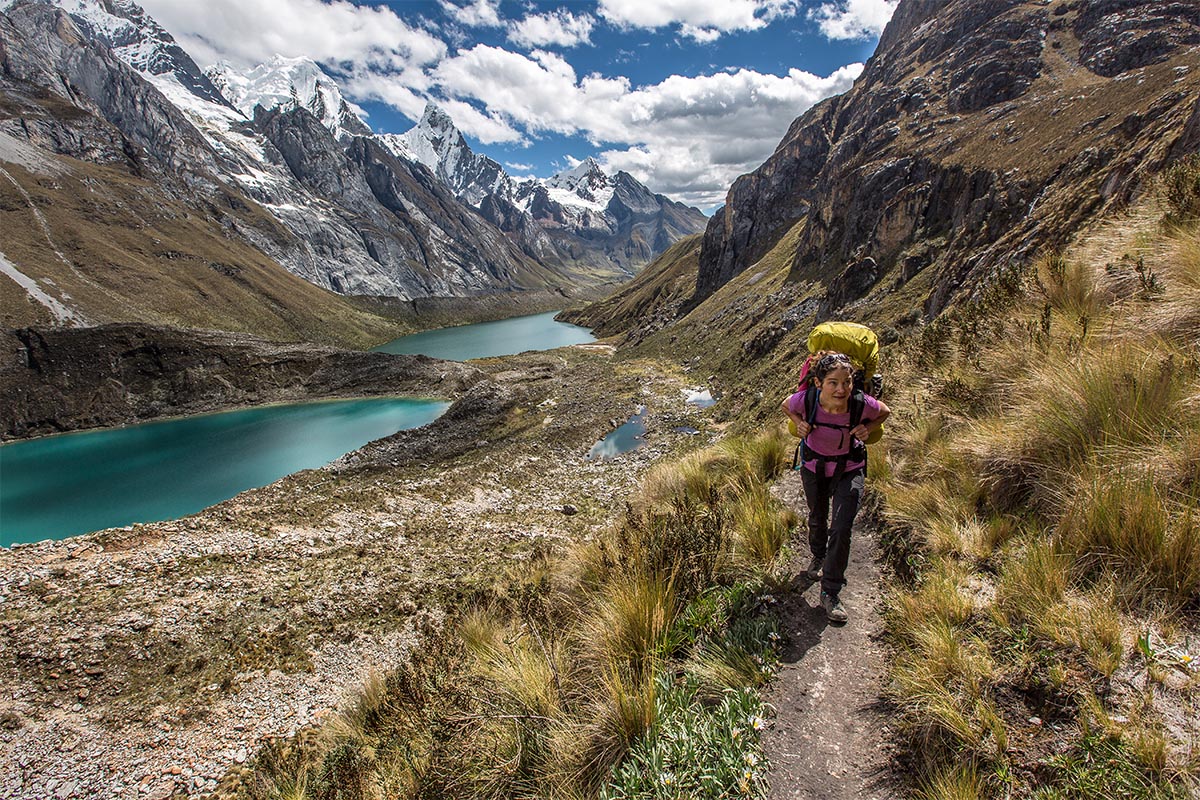
Brian McCurdy Photography
We use affiliate links and may receive a small commission on purchases. Read more about us .
From our campsite, the green valley rises, steepens, and becomes rocky and cold. Eventually it turns to glacier and then vast, snow-blanketed mountain. I pull the hood of my down jacket tight to my face. The cool, thin air and the enormity of my surroundings rousing me better than the darkest cup of coffee. Around a small ridgeline and between two small knolls, I glimpse our day’s objective, and squint my eyes to pick out the trail winding through the green and scree up to the pass. The scale of this landscape silences me and I wipe chilling tears from my cheeks, feeling immensely grateful for another day in the Cordillera Huayhuash.
The Journey
Peru is most known by tourists for ancient Machu Picchu and many cultured cities rich in archaeology and history, but it’s also home to some of the tallest and most remote mountains in South America. Of the trekkers who visit Peru, most head straight to the Cordillera Blanca just north of Huaraz, enticed by the high concentration of peaks exceeding 6,000 meters (around 20,000 feet). However, the Cordillera Huayhuash (pronounced “why-wash”)—just 19 miles long, 9 miles wide, and only boasting three summits over 6,100 meters—caught our attention. With the Huayhuash’s less touristy vibe and miles of trekking potential, we made the decision to stray south of Huaraz and slightly off the beaten path. And we are thrilled that we did: after biking through the Cordillera Blanca and hiking in the Cordillera Huayhuash, the Huayhuash stands out as one of the most memorable adventures we’ve ever experienced.
Days 1 and 2: Setting Off (Matacancha to Mitucocha to Carhuacocha)
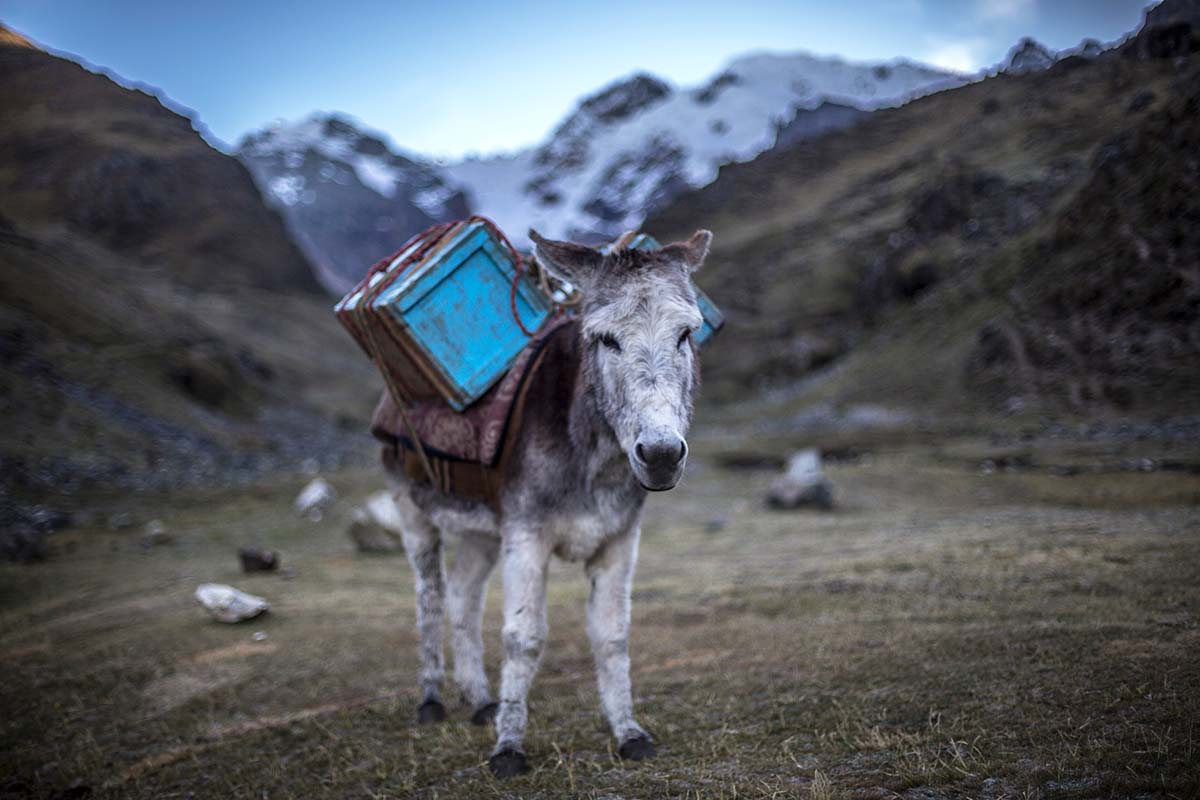
Bikepacking Peru's Huascarán Circuit
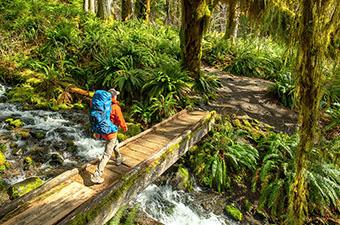
Best Backpacking Backpacks of 2024
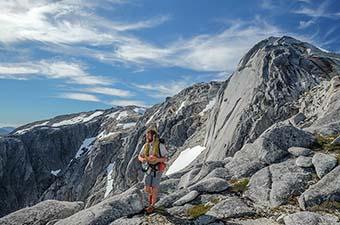
On Location: Valle Cochamó
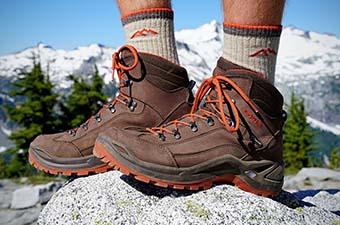
Best Hiking Boots of 2024
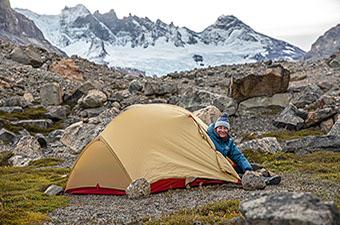
Best Backpacking Tents of 2024
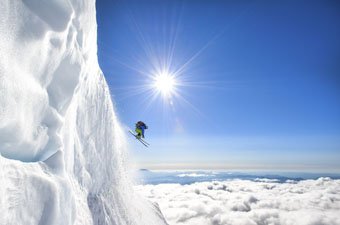
Jason Hummel: An Alpine State of Mind
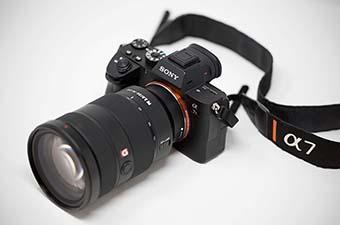
Best Mirrorless Cameras of 2020
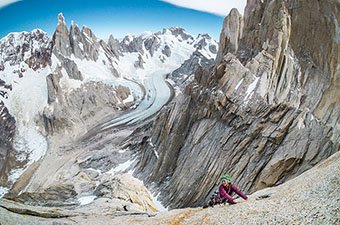
Quinn Brett: Look Up, Stand Still, Breathe

Mobile Menu
Megamenu - desktop hamburger menu.
- Hiking Gear
- Backpacking Gear
- Biking Gear
- Camping Gear
- Footwear Reviews
- Climbing Gear
- Skiing Gear
- Winter Gear Reviews
- In-Depth Gear Reviews
- Hiking Shoes
- Hiking Boots
- Trail Running Shoes
- Mountain Bike Shoes
- Approach Shoes
- Climbing Shoes
- Beginner Climbing Shoes
- Mountaineering Boots
- Winter Boots
- Rain Jackets
- Down Jackets
- Synthetic Jackets
- Fleece Jackets
- Hardshell Jackets
- Softshell Jackets
- Windbreaker Jackets
- Ski Jackets
- Winter Jackets
- Hiking Pants
- Hiking Socks
- Trekking Poles
- Baby Carriers
- Running Vests
- Backpacking Tents
- Backpacking Packs
- Backpacking Sleeping Bags
- Backpacking Sleeping Pads
- Backpacking Stoves
- Backpacking Food
- Water Filters
- Altimeter Watches
- Handheld GPS
- Mountain Bike Helmets
- Mountain Bikes
- Mountain Bikes Under $1,000
- Mountain Bikes Under $2,000
- Gravel Bikes
- Bike Brands
- Kids' Bikes
- Hitch Bike Racks
- Camping Tents
- Rooftop Tents
- Camping Sleeping Bags
- Camping Mattresses
- Camping Chairs
- Camping Stoves
- Duffel Bags
- Rock Climbing Shoes
- Climbing Helmets
- Climbing Harnesses
- Climbing Quickdraws
- Belay Devices
- Climbing Ropes
- Climbing Backpacks
- Winter Gloves
- 4-Season Tents
- Ski Helmets
- Ski Goggles
- Ski Backpacks
- All-Mountain Skis
- Ski Bindings
- Backcountry Skis
- Backcountry Ski Boots
- Skis for Beginners
- Hardpack Skis
- Mirrorless Cameras
- Full-Frame Cameras
- DSLR Cameras
- Point-and-Shoot Cameras
- Travel Cameras
- DSLR Lenses
- Mirrorless Lenses
- Lofoten Islands
- Lofoten Hiking
- Hardangervidda
- Jotunheimen
- 10 Great Norway Hikes
- Public Huts
- Torres del Paine
- Chalten and Glaciares
- Lake District
- Patagonia National Park
- Milford Sound
- Abel Tasman
- Marlborough
- Great Walks
- Adventure Towns
Add adventure to your inbox
- Privacy Policy
- Terms of Use
© 2024 Switchback Travel. All Rights Reserved. No part of this site may be reproduced without our written permission.

- Last minute guaranteed trips
- Covid Info Hub
- Info nights & events
- How to book
Huayhuash Circuit
Discover indigenous communities and breathtaking, remote landscapes.
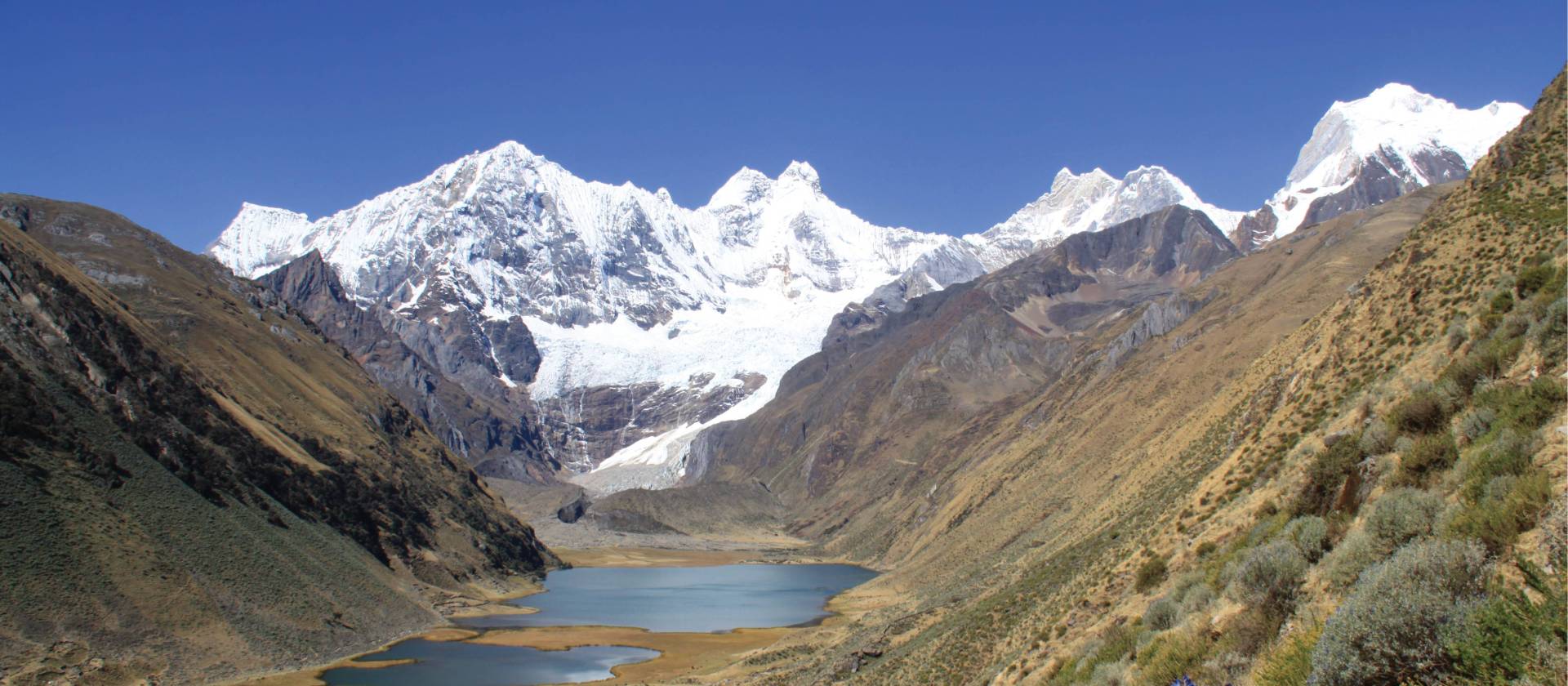
19 Days NaN
- 12 day trek
- 2 day Walks
- 5 nights hotel
- 13 nights camping
- 18 Breakfasts
Traveller Rating
Read 6 reviews
Share this trip with a friend
Destination
Antarctica & the arctic, australasia, central america, central asia, indian subcontinent, middle east, north america, south america, vessels & boats, advanced search, thoughtful travel.
- Accommodation
- Bike Information
- Trail Surface
- About your leader
- Departure dates
- Essential information
- Trip reviews
- Related articles
Similar trips
Suggested extensions.
Share this trip
Huayhuash Circuit Trip highlights
- Undertake the challenging 127 km circuit around the Cordillera Huayhuash in Northern Peru - some of the best trekking in South America
- Trek among towering peaks over 6000m, cascading glaciers, alpine meadows and azure glacial lakes
- Explore Huaraz and the stunning Cordillera Blanca
- Experience indigenous communities and fragile ecosystems
- Behold views of incredible landscapes providing endless photo opportunities
Why Book With Us
- Fully supported camping based trek including three hearty meals a day during the trek freshly prepared by our trained cooks. Water on trek also included.
- Receive a duffle bag for the time of the trek and save money by using our gear pack while trekking including sleeping bag, warm fibre filled jacket, thermarest and more.
- Carry a day pack only during the trek. Personal gear and camping equipment will be carried by our trek animals.
- Extra acclimatisation days built in while exploring the surrounding of Huaraz on day walks.
- Safety is our foremost priority and we carry a portable altitude chamber, emergency oxygen, group medical kit and satellite phone on the trek.
- Airport transfers on the first and last day of the trip and transfer from Lima to Huaraz return included.
The Cordillera Huayhuash is one of the most spectacular ranges in the Peruvian Andes. It was a region that attracted worldwide attention following Joe Simpson's graphic account of his ascent of Siula Grande in his book 'Touching the Void'. This full circuit trek is the best way to fully appreciate the sheer scale of these snowcapped summits including Yerupaja, the second highest mountain in Peru. Our trip includes ample time for acclimatisation in the Cordillera Blanca and Huaraz before spending 12 days crossing high passes - all in the vicinity of 5000m. A highlight for all will be a side trip to Siula Grande Base Camp and an ascent of Cerro Bella Vista for incredible views. Each day provides an ever changing backdrop of soaring peaks including the distinctive needle like peak of Jirishanca and the impressive summit of Yerupaja at 6640m. At night we camp in tranquil locations alongside glacial lakes and alpine meadows in this unrivalled corner of the Andes. Anyone wishing to add a trip to Machu Picchu can easily do so, please ask for more details.
Read more...
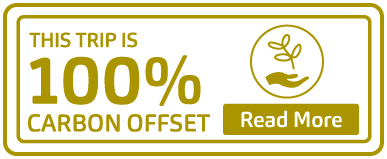
Expand all | Collapse all
Day 1 Arrive Lima
Meals: Nil
Day 2 Drive to Huaraz
Day 3-4 in huaraz, day hikes.
Meals: B,L
Day 5 Drive to Matachancha
Meals: B,L,D
Day 6 Trek to Mitucocha via Cacananpunta Pass
Day 7 trek to lake carhuacocha via carhuac pass, day 8 trek to huayhuash village via siula pass, day 9 trek to viconga lake via portachuelo de huayhuash, day 10 trek to huanacpatay valley via cuyoc pass, day 11 trek to cutatambo via santa rosa pass, day 12 day trek to ascend cerro bella vista, day 13 trek to huayllapa village via jurau valley, day 14 trek to gashpapampa via tapush pass, day 15 trek to jahuacocha via yaucha pass, day 16 rest day at jahuacocha, day 17 trek to llamac and drive to chiquian, day 18 drive to lima, day 19 in lima, trip concludes.
The map and elevation chart are for illustrative purposes only and meant to provide general guidelines.
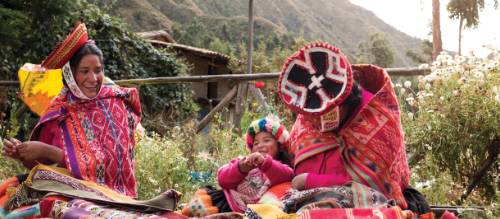
Peru Regenerative Travel Project
Help us replace cook stoves in village kitchens to reduce exposure to indoor air pollution
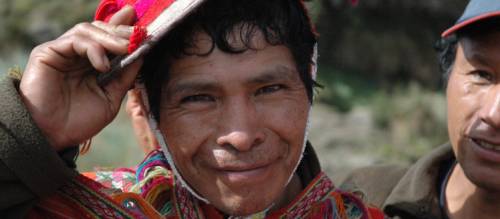
Porter Welfare Policy
Learn how we look after our porters across the world, including Peru
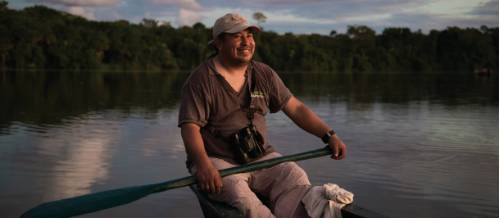
This trip is 100% Carbon offset
By booking this trip you are supporting sustainable projects around the world
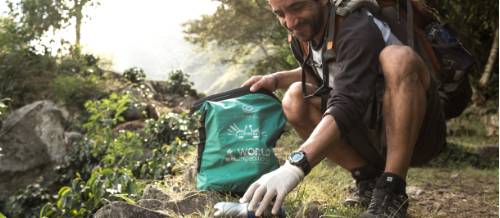
10 Pieces Litter Project
Take only photos … and 10 Pieces of litter, leave only footprints on Peru treks
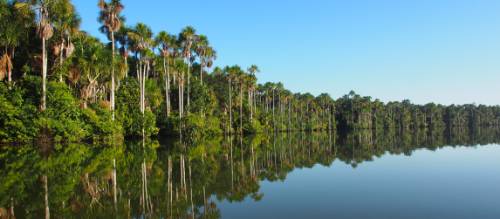
Thoughtful Travel Charter
We are committed to true sustainability by aiming to only leave a small footprint
What's included
- 18 breakfasts, 15 lunches and 13 dinners
- airport transfers if arriving on Day 1 and departing on Day 19
- expert bilingual guide
- group medical kit
- comfortable and central hotels, primarily Casa Andina Classic hotels
- all internal transportation via private vehicle, except for Lima to Huaraz which is on a comfortable tourist class coach for groups up to 9 travellers. Your guide will accompany you throughout.
- the use of a gear pack including sleeping bag, fibre filled jacket and thermarest sleeping mat
- group camping equipment
- Pack animals or porters on trek to carry personal gear
- portable altitude chamber carried on trek
What's not included
- Cost of laundry and alcoholic beverages (except wine on last trek day)
- Medical treatment
- International flights
- Airport taxes
- Excess baggage costs
- Travel Insurance
Per Person, Twin Share
Select your dates and book now
The following errors occured:, huayhuash circuit trip reviews.
Rating: ☆ ☆ ☆ ☆ ☆ ☆ ☆ ☆ ☆ ☆ ☆ ☆ ☆ ☆ ☆ ☆ ☆ ☆ ☆ ☆ ☆ ☆ ☆ ☆ ☆ ☆ ☆ ☆ ☆ ☆
Other trip reviews
Why travel with us.
Award Winning Adventures
Enhancing your journey with authentic experiences, genuine cultural exchange and real exploration are the focal points on all of our adventures. In 2019, we were crowned by our peers as the best in adventure travel at The Travel Awards in Sydney.
Our vision is to leave the world a better place by following our sustainable active outdoor travel charter . All our adventures are 100% carbon offset and our Regenerative 2030 Project aims to integrate ‘regenerative’ projects into every one of our global operations by 2030.
Ultimate Value
When you book one of our adventures, you will receive quality services at the best prices with plenty of inclusions. There are no hidden costs, single travellers don’t pay more and you’ll enjoy many ‘extra touches’ that ensure your holiday is excellent value for money.
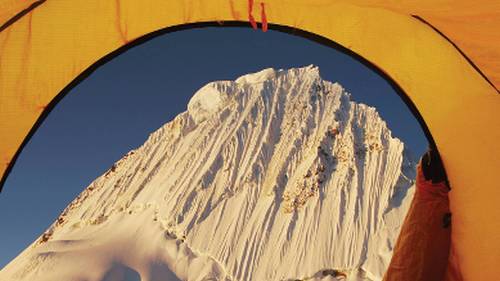
Alpamayo Circuit
Activities:.
Moderate to Challenging
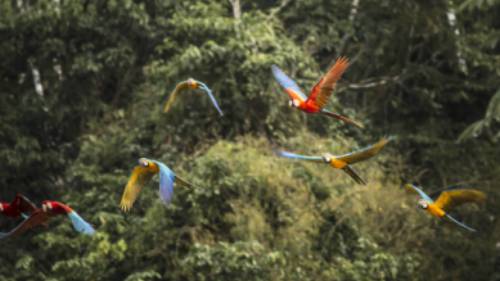
Amazon Rainforest
Discovery and Cruising
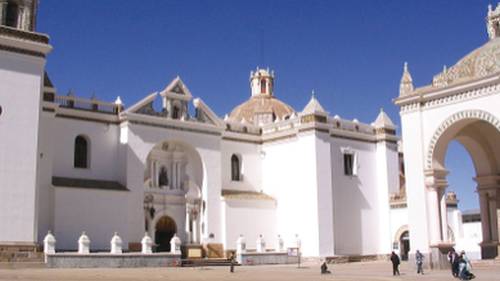
Cusco to La Paz
Adventure Touring
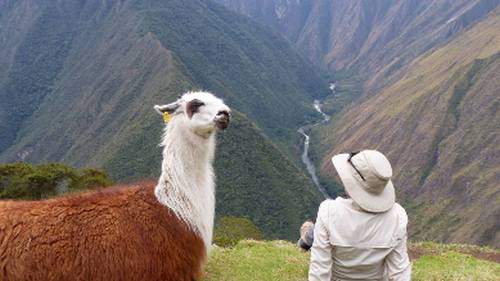
Inca Trail Adventure
Introductory
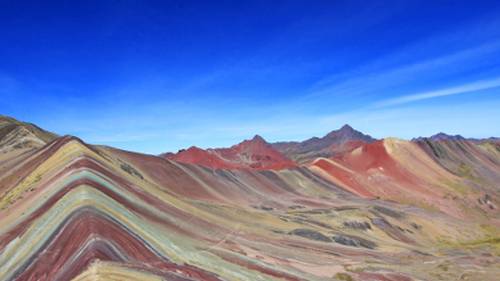
Ausangate and Rainbow Mountain Trek
- Cookie Policy
- Strictly Necessary
- Performance
When you visit any web site, it may store or retrieve information on your browser, mostly in the form of cookies. This information might be about you, your preferences, your device or used to make the site work as you expect it to. The information does not usually identify you directly, but it can give you a more personalized web experience. You can choose not to allow some types of cookies. Click on the different category headings to find out more and change our default settings. However, you should know that blocking some types of cookies may impact your experience on the site and the services we are able to offer.
These cookies are necessary for the website to function and cannot be switched off. They are usually only set in response to actions made by you which amount to a request for services, such as setting your privacy preferences, logging in or filling in forms. You can set your browser to block or alert you about these cookies, but some parts of the site will no longer work. These cookies do not store any personally identifiable information.
These cookies allow us to count visits and traffic sources, so we can measure and improve the performance of our site. They help us know which pages are the most and least popular and see how visitors move around the site. All information these cookies collect is aggregated and therefore anonymous. If you do not allow these cookies, we will not know when you have visited our site.
These cookies allow the provision of enhance functionality and personalization, such as videos and live chats. They may be set by us or by third party providers whose services we have added to our pages. If you do not allow these cookies, then some or all of these features may not function properly.
These cookies are set through our site by our advertising partners. They may be used by those companies to build a profile of your interests and show you relevant ads on other sites and promotional activities through our newsletters. They work by uniquely identifying your browser and device. If you do not allow these cookies, you will not experience our targeted advertising across different websites or via newsletters.
- Why hop with us
- Hop Login Here
- How We Started
- Who Travels with us?
- Why Hop With Us?
- Unique Hop Stops
- Peru Hop vs Public Buses in Peru
- Frequently asked questions
- Guide to Peru
- How It Works
- Tickets & Trips
- Exclusive Hotel/Hostel Discounts
- Group Travel
- Secret Slave Tunnels
- Nazca Lines Viewing Tower
- Paracas National Reserve
- Pisco Vineyard
- Machu Picchu
- Day Trips from Lima
- Day Trips From Cusco
- Day Trips from La Paz
- Paracas Day Trips
- Huacachina Day Tours
- Extra Tours
- Rainbow Mountain
- Ballestas Islands
- Quad Bike ATV
- Paragliding in Paracas
- Buggy and Sandboarding
- Nazca Lines Flight
- Full Day Tour
- Ruta del Sillar Tour
- Lake Titicaca
- 2 Hour Tour
- Isla del Sol
Huaraz , Treks
The Cordillera Huayhuash Trek
Everything to know about one of the most beautiful alpine treks!
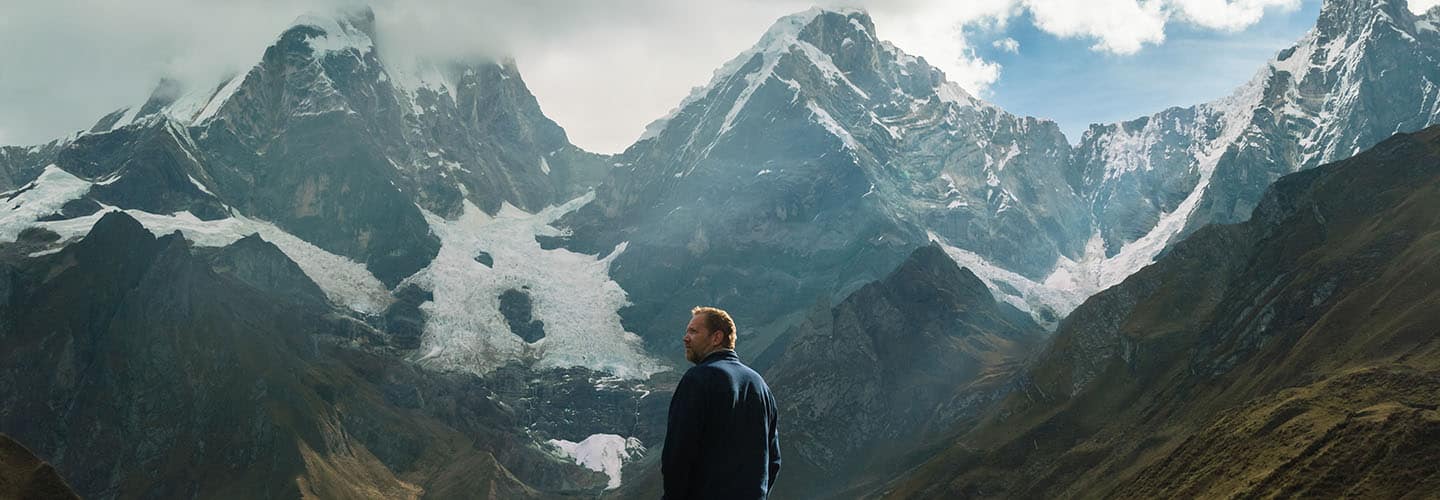
Possibly the best alpine trek in the entire world, the Cordillera Huayhuash trek has become well-known among outdoors enthusiasts for its sheer mountain peaks, pristine glacial lakes, and encounters with traditional Andean culture.
In recent years the Peruvian government has invested in infrastructure and security measures which have made the area much safer. Huayhuash is gaining popularity among tourists in recent years, but it’s still not as well-known as treks in other regions of Peru, so the natural environment remains mostly unspoiled. That’s what makes it perfect for those who want to experience the Andes at their most peaceful and picturesque.
Did you know: Peru Hop was setup by 2 Irish guys in 2013 and has been voted #1 Travel Company in Peru for 2024 – Click here for more info .
However, in past years, this route was considered fairly dangerous and hikers would occasionally die on the trek. Not only was the region a stronghold for the Maoist-inspired Shining Path guerrillas, but the trails themselves were often considered hazard and unsafe as well.
About the Trek
With a length of about 130km (81mi) and elevations as high as 5,490m (18,012ft), trekking the Cordillera Huayhuash is not for the faint of heart. The weather can often be extreme and hypothermia is a possibility. In addition, those unaccustomed to high elevations could develop altitude sickness, a condition which causes symptoms such as headache, nausea, loss of appetite, and trouble sleeping.
To be clear, this trek is difficult and sometimes dangerous, so the full trek should be attempted only by experienced hikers. Anyone hesitant to commit to the full distance of the classic circuit also has the choice of several different shortcuts which can reduce the length of the hike by several days.
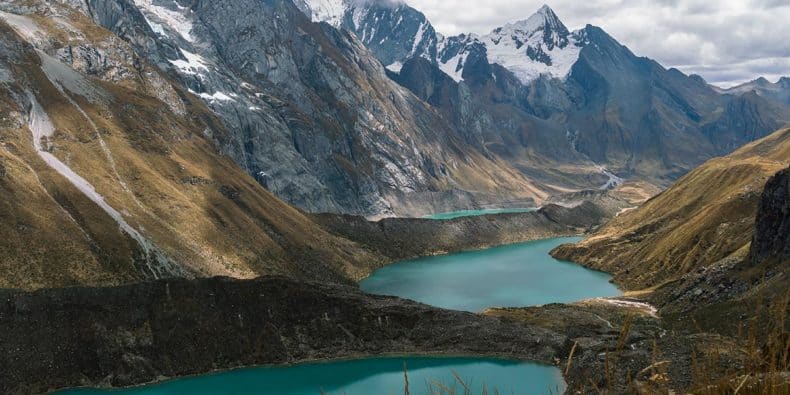
For those who decide they are up to the challenge, Huayhuash will have many rewards in store. The entire path is above the treeline, giving visitors a panoramic view of gorgeous mountainous landscapes at all times. Aside from the main 130km circuit, there are also a number of optional side treks, including climbs of Pumarinri and Diablo Mudo.
Visitors are also treated to pleasant natural hot springs about halfway through the route. Wildlife to spot on the trek includes the condor and more than 60 other species of birds, as well as the vicuña (a wild relative of the alpaca) and vizcacha (a type of chinchilla resembling a rabbit). All of this combines to create a setting which can only be described as utterly sublime.
Taking a Tour vs Going Solo
The safest and easiest way to complete this trek is to book a guided tour from the many local providers in the region. Though doing the trek on your own is certainly possible, it’s not recommended to attempt this unless you have ample experience hiking in high altitude, adequate equipment, lots of food, and a solid command of Spanish and/or Quechua. It’s definitely possible to get yourself in trouble on this route (either with local people or with natural hazards on the path), and you will need to be able to fend for yourself in isolation if something goes wrong.
If you do decide, against our advice, to do this trek without purchasing a guided tour, it is essential to hire pack animals such as mules or donkeys to carry a large amount of food and supplies that are needed for such a long trek. Hiring pack animals can be arranged while in Huaraz.
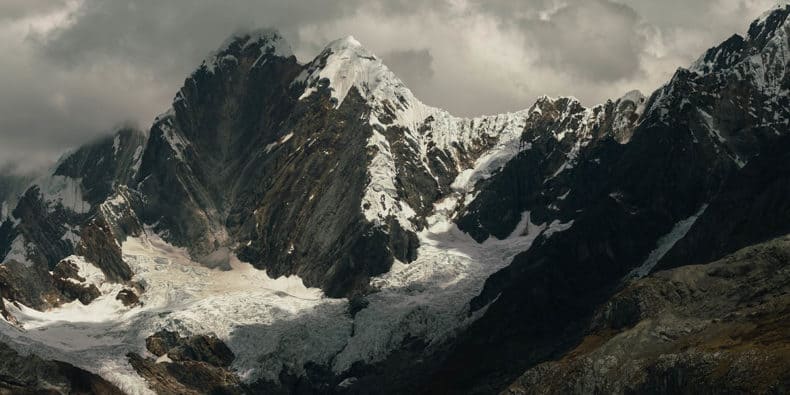
When to Do the Huayhuash Trek
The best months to hike the Cordillera Huayhuash are May through September when the weather is dry but cold (during the wet season there can be snow which blocks the mountain passes). Make sure to always keep current with weather updates before you depart and be aware of how changes in the weather could affect your ability to complete the trek.
For booking treks in Peru, we highly recommend using Find Local Trips , a booking and tour comparison website designed to help you find the best tours and activities in South America.
How To Get To The Cordillera Huayhuash
The most popular departure point is Huaraz, a city of 127,041 in north-central Peru, about 8 hours by car or bus from Lima. There are many direct buses operating daily from Lima to Huaraz, including Oltursa, Movil Tours, and many others. There are also flights operated by LC Peru.
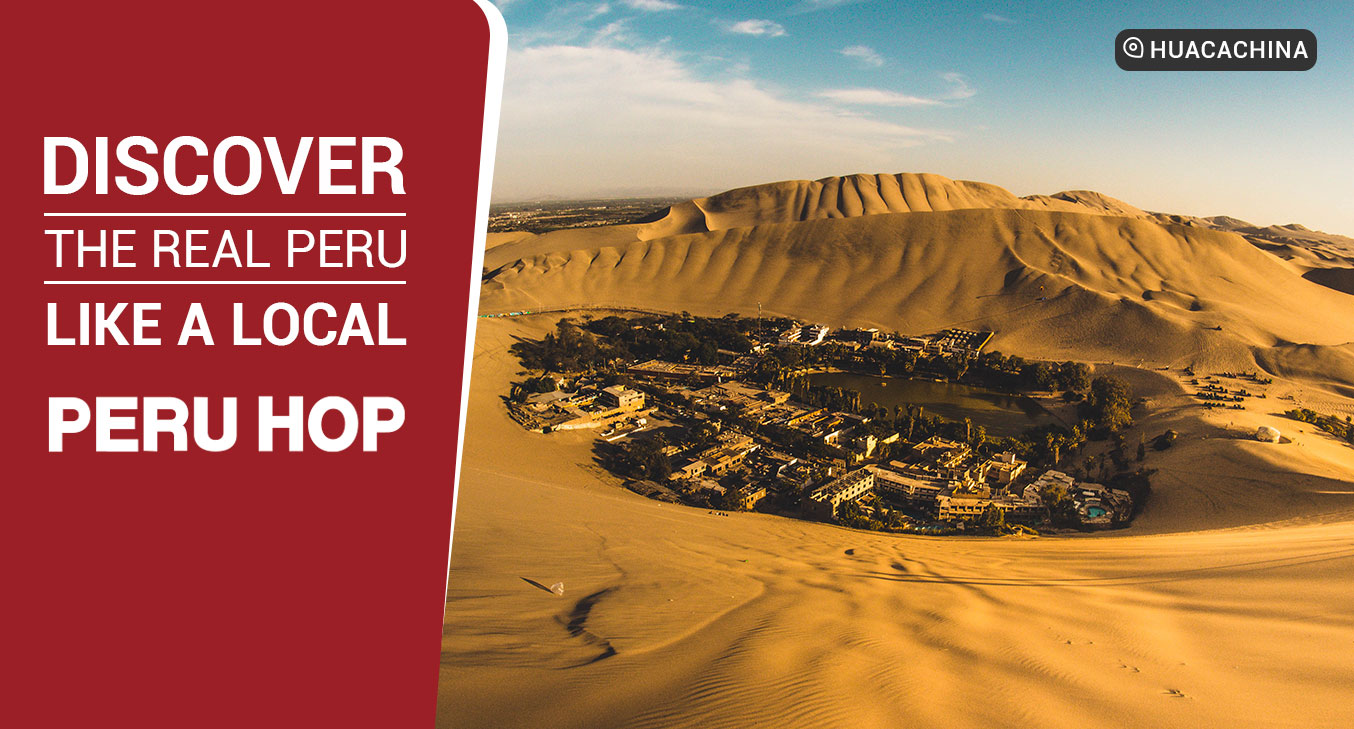
From Huaraz, It’s possible to hire private transport to bring you all the way to the first campsite, Cuartelwain. It’s also possible to take a public bus from Huaraz to the town of Llamac, as long as you don’t mind walking along a dirt road for several miles from Llamac to reach Cuartelwain.
The Classic route
Here is an example of a typical route through the Cordillera Huayhuash, this one taken from Huayhuash.com . Most companies will also allow you to add extra days of rest or to reduce the length of the trip via shortcuts on the trail.
Day 1: Huaraz – Llámac – Cuartelwain 4170m Day 2: Cuartelwain – Qaqanan pass 4750m – Mitucocha 4230m Day 3: Mitucocha – Carhuac pass 4600m – Carhuacocha 4138m Day 4: Carhuacocha – Carnicero pass 4630m – Huayhuash 4330m Day 5: Huayhuash – Portachuelo pass 4750m – Viconga 4400m Day 6: Viconga – Cuyoc pass 5000m – Guanacpatay (Elefante pampa) 4450m. Day 7: Guanacpatay – San Antonio Pass 4990m – Cutatambo 4250m Day 8: Cutatambo, visit the base camp and glacier of Siula Grande mount, route of Joe Simpson. Day 9: Cutatambo – Huayllapa 3500m Day 10: Huayllapa – Tapush pass 4800m – Qashpapampa 4500m. Day 11: Qashpapampa – Yaucha pass 4750m – Jahuacocha 4070m Day 12: Jahuacocha – Pampa Llámac pass 4300m – Llamac – Huaraz
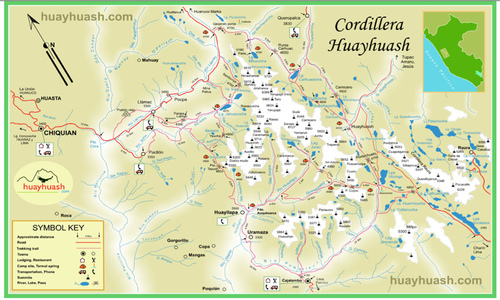
What to bring
- Walking shoes and socks
- Regular pants
- T-shirts (long-sleeved and short-sleeved)
- Trekking boots
- Warm sleeping bag
- Waterproof pants and jacket
- Sunglasses and sunscreen
- Baseball cap or bandana
- Fleece for extra warmth
- Warm hat and mittens
The above equipment should be sufficient if going on a guided tour (double-check with your specific provider). If arranging your own trek, you will also need tents, cooking equipment, and enough food and water to last the entire trek, at the very least. In this case, it is recommended that you consult with an expert or someone else who has already completed the trek to help you create an appropriate list of supplies.
Trekking Fees
Each region of the Huayhuash is managed by the specific community that lives in the area. Each community charges an entrance fee to their grounds. This entrance fee will cover different things depending on the community. For some, it only covers usage of the trail. Others include campsites, toilets, and even night patrol guards. If you choose to take a guided trek with a tour provider, these fees may or may not be included–this should be clarified with the specific company.
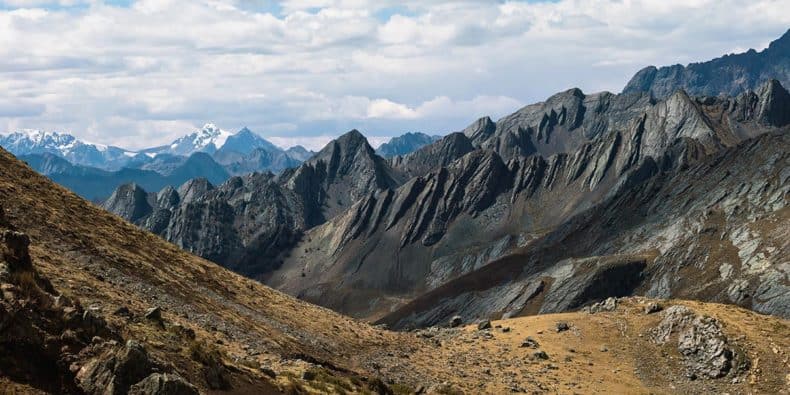
Llámac: Cuartewain and a part of the Jahuacocha camping site S/. 20.00 Pocpa: S/. 10.00 Queropalca: Mitucocha and part of the Carhuacocha camping site S/. 40.00 Quisuarcancha: Part of the Carhuacocha camping site S/. 20.00 Tupac Amaru: Huayhuash camping site S/. 20.00 Uramaza: Visit to Viconga lake and hot springs S/. 20.00 Huayllapa: Viconga, Guanacpatay, Cutatambo and Huatiaq camping sites S/. 40.00 Pacllon: Qashpapampa and part of Jahuacocha camping sites S/. 20.00
There is also a charge of S/.1.50 per night for each pack animal (donkey, horse or mule) for grass consumption.
After you finish
The best way to continue your adventure after completing the Cordillera Huayhuash circuit is to head back to Lima and book a trip with Peru Hop. This bus service will take you from Lima across all of southern Peru and even to further points in Bolivia. Peru Hop is a hop on hop off style bus, so if you decide that you really like a certain spot or you want to do some extra activities or side trips, it’s no problem at all–your itinerary is completely flexible.
If you want to check out some of the absolute best treks in Peru, then check out our list of the best treks in Peru to explore some of the best options for you to explore and challenge yourself with.
You May Like
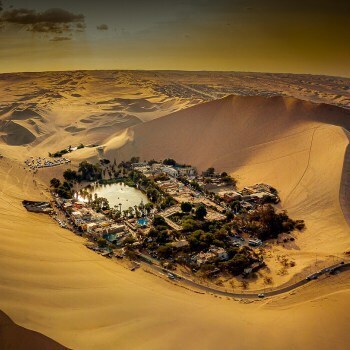
The #1 Thing to Do in Lima - Desert Oasis

How 2 Irish Guys set up Peru's BIGGEST Travel Company

Peru 2024 Travel Updates - All You Need to Know

Lima to Machu Picchu - Agencies DON\'T want you to read this!
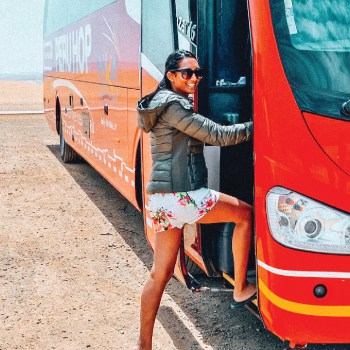
OFFICIAL: View #1 Travel Company in Peru by Tripadvisor

What NOT to do when visiting Rainbow Mountain

These Hidden Destinations close to Lima will AMAZE you

PERU INSIDER - Top Travel Tips in 2024

08 Nov Peru’s Huayhuash Trek: Ultimate Guide by a Solo Female Traveler

Named one of the 10 most beautiful treks in the world, the Cordillera Huayhuash circuit should absolutely be on your Peru itinerary. While this bucket list hike is not for the faint of heart, the magnificent views of snow-capped peaks, turquoise glacial lakes, rocky terrain, and mind-blowing views pay off all the challenges of the trail. Over 5-12 days you’ll push your strength and test your stamina for one of the most rewarding and immersive adventures through the Andes Mountains.
In this guide I highlight everything you need to complete Huayhuash as a part of a guided-group. Anyone looking to tackle this trek can find this post useful, but I especially added some perspective and tips for solo female travelers: because solo traveling doesn’t mean you can’t have an adventurous trip. So buckle up, for your adventure girl summer in Huayhuash!
What's in this post
Click to skip ahead
About the Huayhuash Trek
- Where is the Cordillera Huayhuash
- Trail details
- How many days is the trek?
- Distance & elevation of the trail
- Difficulty of the trek
- Who can complete Huayhuash?
What to Expect
- What’s included & not included in a guided trek
- Privacy & safety as a solo female traveler
Huayhuash 8 Day Itinerary
Finding a group & booking trek.
- When to book
- Private group vs. random group
- My recommended tour operator
When is the best time to hike Huayhuash
How to prepare for huayhuash.
- Physically & with the altitude
- Packing List
Other Random Tips for the Trek
Travel insurance for the trek, how to get to huaraz, other resources for your trip.
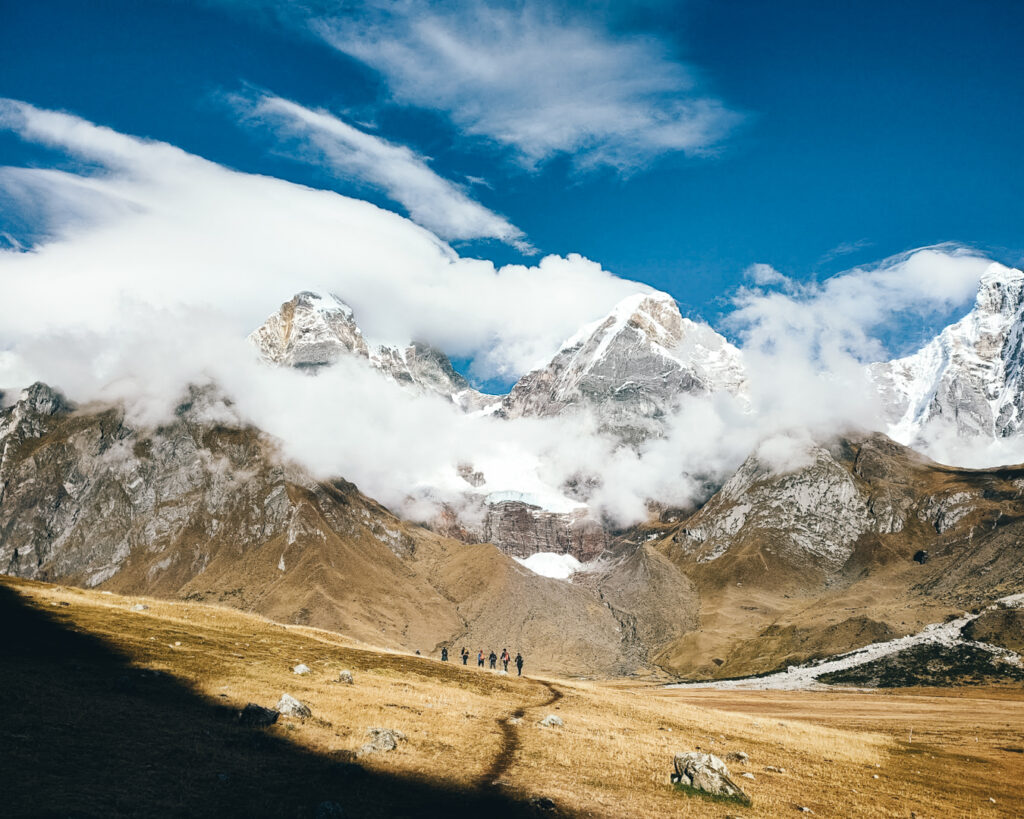
ALL ABOUT HUAYHUASH
Huayhuash refers to the mountain range known as Cordillera Huayhuash which is a bunch of mountain peaks grouped together. The trekking circuit takes you up and around them, seeing the icy peaks from different angles, enjoying the glacier lakes around them, and the valleys below.
Where is the Huayhuash Trek?
The Cordillera Huayhuash is a part of the Andes Mountain Range in central Peru, about 200 km north of Lima. To begin the Huayhuash circuit, you’ll start in Huaraz , a city that acts as a hub to begin some of Peru’s most impressive hikes and treks including Huayhuash.
→ Check out my guide to Huaraz here
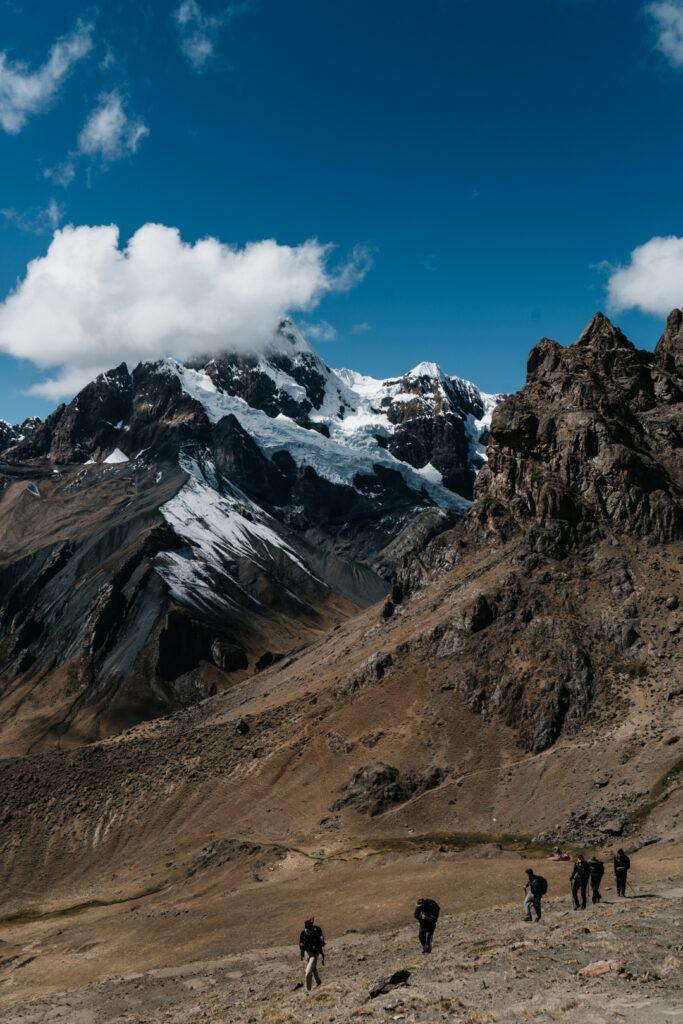
Trail Details:
How many days is the huayhuash trek.
The traditional Huayhuash circuit is meant to be 8-12 days. The most popular route is 8 days, which is what I did, so I’ll refer to it throughout this post. There’s also a 5 day option for those looking for a shorter route but you won’t complete the full circuit and will miss the panoramic view of the entire range – for that reason I don’t recommend it unless you’re short on time.
Distance & Elevation: How long is the Huayhuash trek and what altitude do you reach?
During the 8 days Huayhuash Circuit you’ll hike about 130 km / 80 miles and reach elevations as high as 5,050 m / 16,568 ft. This is the highest elevation, but every day will include one mountain pass at or over 4,700 m / 15,419 ft and you’ll camp at higher elevation as well.
The map of the circuit is shown below on AllTrails (which is roughly accurate) but when you discuss with tour operators they should give you a map and explain the hiking details of each day since there can be slight variations.
How difficult is the Huayhuash trek?
As I’m sure you can guess, Huayhuash is labeled a difficult trail for the average person and I would agree . Personally, it was doable for me but that’s easy to say in hindsight sitting in a coffee shop typing this. During the trek it took a lot of determination, physical stamina, and mental fortitude.
The Huayhuash circuit is difficult for many reasons, not just trail distance, but for the high altitudes and stamina to span over the whole trip. Every day you’ll complete a mountain pass (the highest pass reaching 5,050 m / 16,568 ft) and the entire trip is over 4,000 meters.
For the unaware sea-level dwellers, hiking at higher altitudes is 10x more difficult than at sea level. There’s less oxygen for your lungs which can introduce other complications depending on how your body reacts. Additionally, weather can be unpredictable so high up, and you may need to hike or sleep through hail or even snow. What’s more, how your body and mind copes to these conditions over 8 days can also be an additional challenge.

On the other hand, while being in shape will make your life easier, you don’t have to be a professional trekker or someone who grew up in Colorado summiting peaks on weekends to do the Huayhuash trek. And unless you’re out of shape, you don’t need to do any official training beforehand either. Now, I do recommend acclimating and completing a few day hikes at high altitude prior. But other than that, this is not like a summit or technical trek which requires training.
In actuality, Huayhuash is not that technical of a trail, it’s just putting one foot in front of the other – which admittedly may be easier said than done. But as long as you have the appropriate gear, the mental fortitude, are properly acclimated, and are in decent physical shape, you should be able to complete it.
For context, I’m a moderately fit person, meaning that I’ve always been able to engage in more physical activities like hiking but I wasn’t working out regularly at the time of my trek and low key I would get out of breath from just running up stairs in Huaraz. During Huayhuash, I was the slowest in my group because I had difficulty breathing, especially during ascents.
However, I was able to keep up more or less, always arriving within 20 minutes or so from the rest of the group and they were always patient enough to wait. And even if I took longer, I think it would have been ok. Everyday the hiking was tailored so there was more than enough time to complete the trail and we frequently arrived to camp at midday. There were also slower groups than us. So while I think Huayhuash is a difficult trek as a whole, the daily hikes are doable if you’re acclimated, in decent shape, and confident – I say go for it.
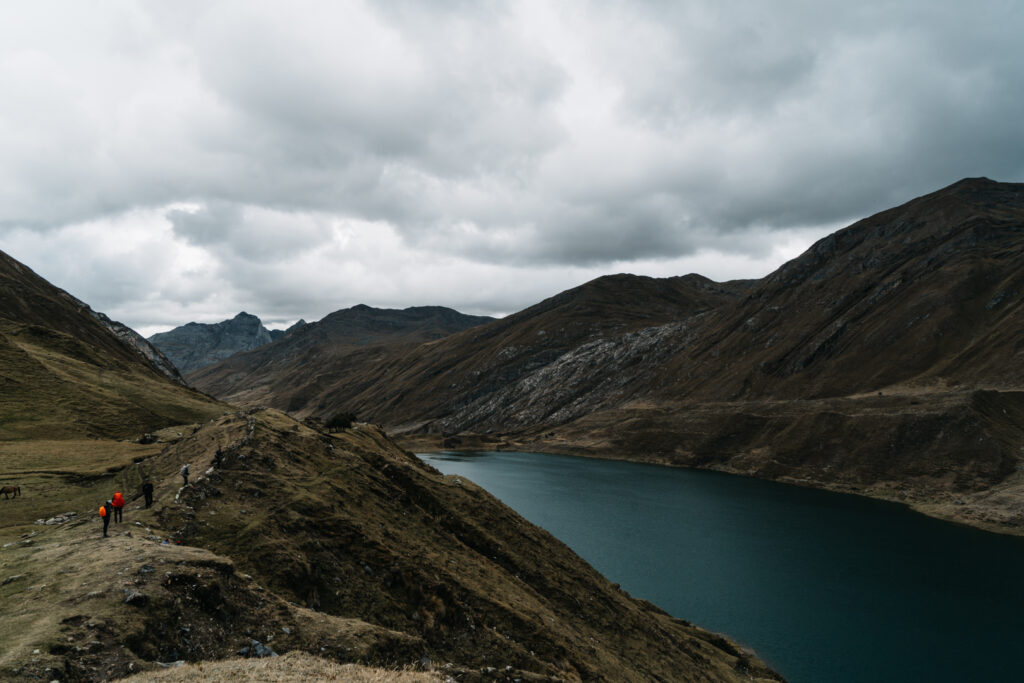
Who can complete the Huayhuash trek?
So ultimately, who can complete Huayhuash? That’s a difficult to specifically define, and ultimately it’s a question only you can truly answer for yourself. I saw older people doing it who were much slower than me (but did it); I also knew a professional rugby player who was struggling as much as me; but I also saw people who looked physically less strong who were absolutely killing it. Ultimately a lot has to do with how you react to the altitude and your mental stamina.
If you’re unsure if you should do the trek or not, my advice is to take all the information I’ve said into consideration, check out the itinerary and then do some day hikes in Huaraz or even the Santa Cruz trek to gauge how you fare.
When you do decide to do Huayhuash, be confident with yourself. My advice for any challenging activity is to go into it without hesitation, saying to yourself, “I can and will do this, even if it’s difficult.”
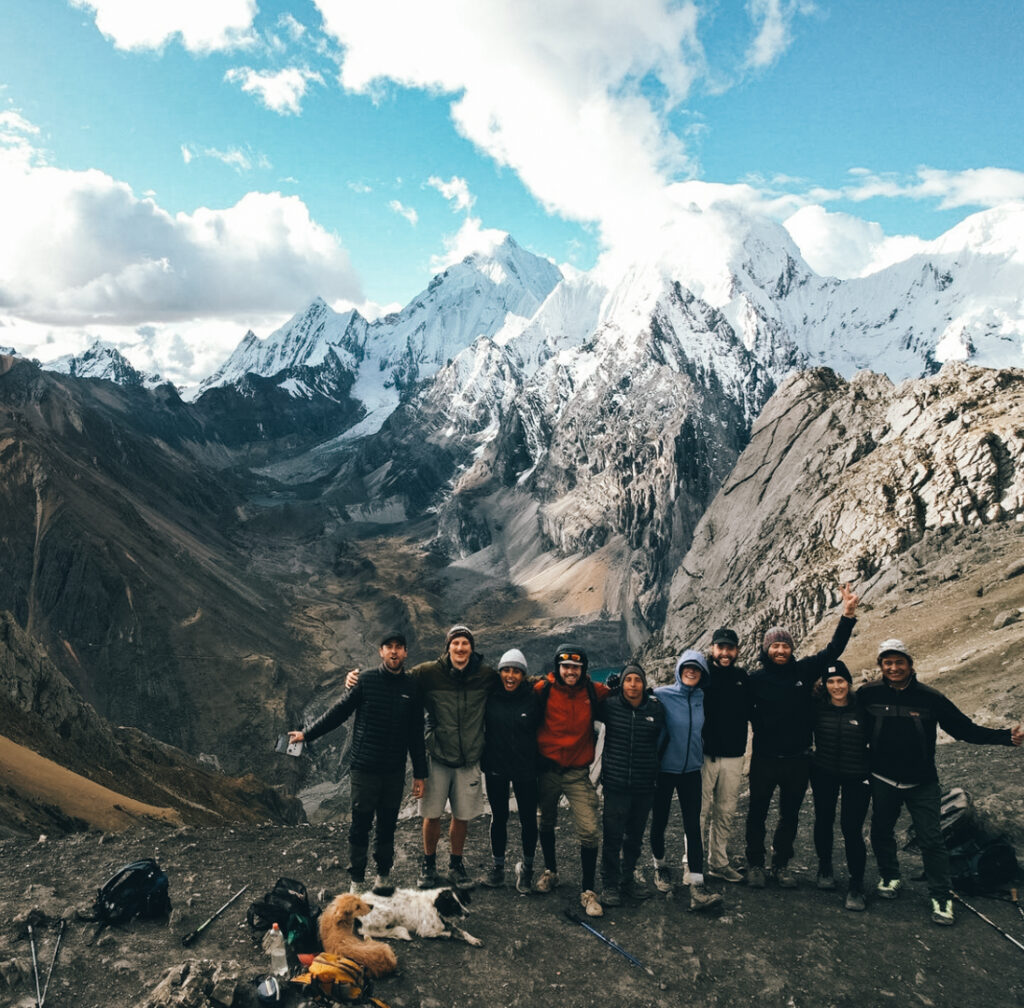
Huayhuash 8 day trek itinerary
Below is what you can expect day-to-day during an 8 day guided trek of the Cordillera Huayhuash. This is based off the itinerary I was given and completed. There may be slight variations if you go with a different company and definitely if you plan to trek on your own.
Day 1: Just drive
On the first day, there’s absolutely no hiking involved. Around 9/10 AM you’ll be picked up from your hostel /hotel in Huaraz and then drive about 5 hours to the first campsite. Along the drive you’ll stop in a small town called Llamac at a local restaurant for lunch. Menu del dia is about 10-15 soles and not included, so make sure to bring cash.
The first day is a great time to get acquainted with your group, especially if you don’t know anyone and get a taste of the camping situation for the next week.
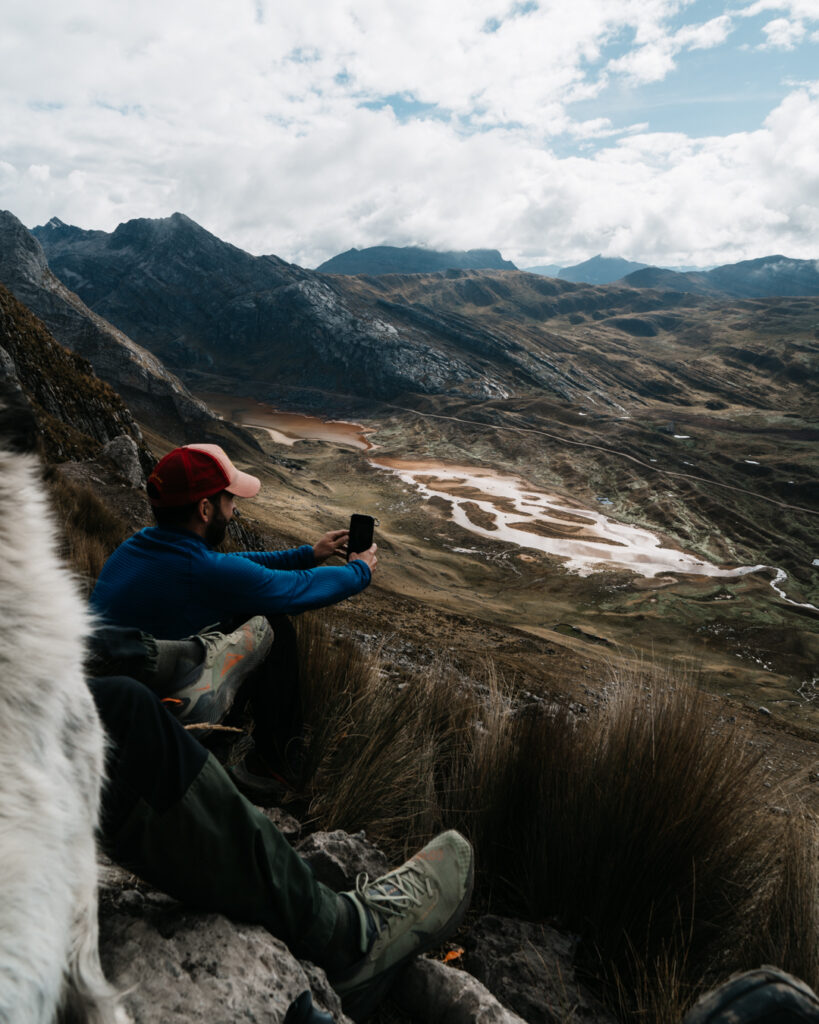
Day 2: Here We go
Bright and early you’ll begin the first day of trekking Huayhuash. It begins immediately with ascent to the first mountain pass. Depending on your mindset and how you’re dealing with altitude, it can be a breeze or quite difficult.
What I mean to say is that *most* people find it easier of all the passes because it’s a fresh start. I, on the other hand, found it difficult because I think starting is the hardest part of any trek. When you run into tiredness it’s all too easy to think, omg this is just the start how will I last . Obviously I completely discourage from thinking like this and rather to remember its a marathon not a sprint; you got this.
After the first pass, there is a second one but because its so gradual you don’t even feel like you’re doing a mountain pass. There’s also a lot of flat and down portions. Overall, Day 1 of Huayhuash is longer and covers a lot of ground but you’ll be rewarded with a stunning campsite at the foot of a glacier lake.
Day 2 stats:
- 18 kilometers (11.2 miles)
- 1,100 meters (3,608 ft) in elevation gain
- Roughly 7 hours of hiking
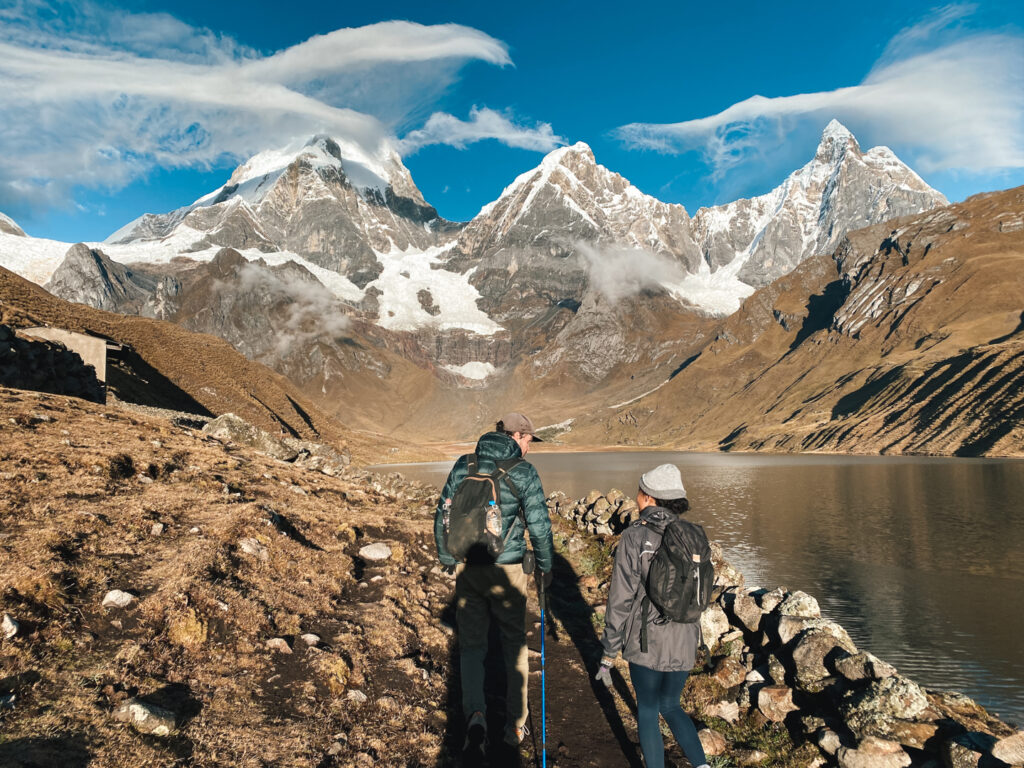
Day 3: The Three Lakes
On Day 3 you’ll begin a flat walk around the lake you camped beside and towards the first of three new lakes that you’ll see. At this first lake you can hike up to the ridge to see a stunning view of the blue water.
From here you’ll begin the mountain pass ascent. This is a pretty difficult one, but it does really pay off in views. Halfway through the incline, you’ll be rewarded with one of the most beautiful parts of the Huayhuash trek: Mirador de Tres Lagunas or the Three Lakes Viewpoint.
But you’re not done yet, after you take lots of photos and have a snack, you’ll continue the ascent up to the mountain pass. This is when I had to stick my airpods in so Bad Bunny could help me get up and over this bad boy.
After the mountain pass it’s all down and or flat to the next campsite.
Day 3 stats:
- 16 kilometers (10 miles)
- 700 meters (2,296 ft) in elevation gain
- 6-7 hours hiking

Day 4: The hardest day
You wanted to know which day is the most difficult? This is it. On Day 4 of the Huayhuash trek you’ll have the highest mountain pass at roughly 5,050 m, and then later you may or may not complete a second one at 5,000 m. To explain, I’ll tell you about my experience.
We started the first ascent which I’ll admit was so freaking hard. It didn’t help that it began with fog so thick you couldn’t see far in front of you which eventually turned into a windy snow storm. This meant with a group spaced out, hiking at different paces, I felt pretty alone at the back until our chef caught up and hiked with me (they make sure no one is left behind, and I was last).
At the top of the first pass you should have amazing views, however I wouldn’t know too much since we could barely see… After the pass though it’s down all the way to the campsite. Again, we only got glimpses of the views during descent, but if you have a clear day this should be an incredible scenery of blue lakes and brown, outlandish mountain peaks.
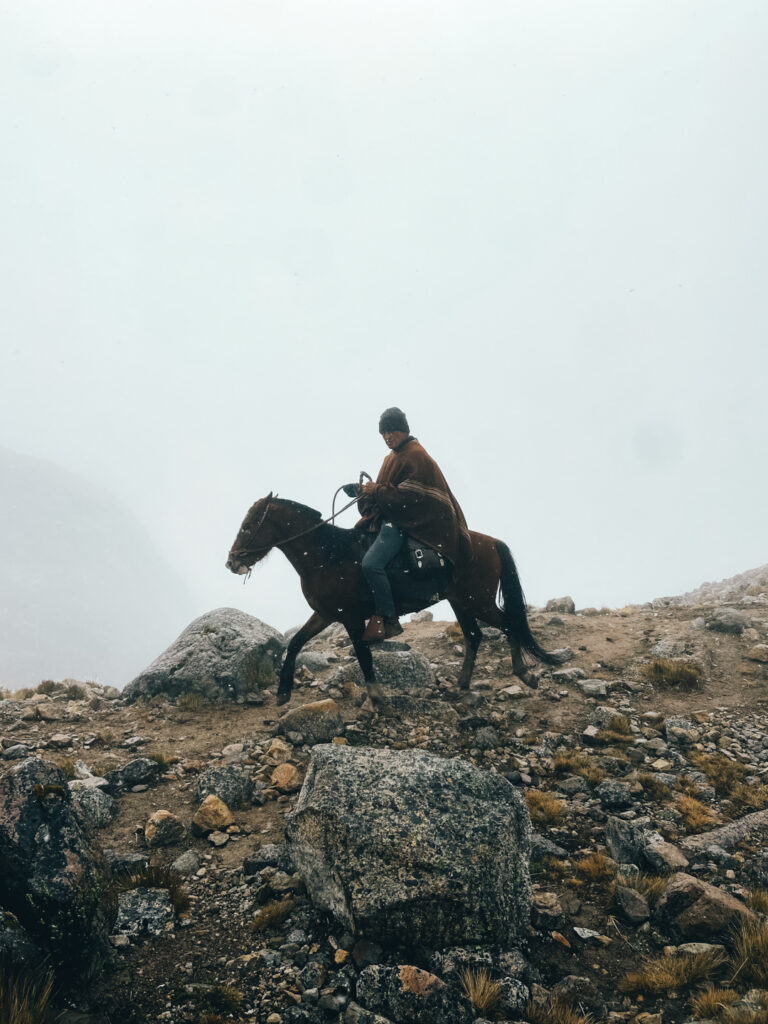
For as difficult as this mountain pass is, it doesn’t take too long and you’ll be at the campsite for lunch. Actually, because of the snow storm my group was so cold we barely stopped at all and made it to camp by 11 AM! For this reason, our guide gave us the option: do you want to do the second mountain pass, San Antonio, later that afternoon or the next day? It’s (in my opinion) THE most beautiful view of the whole trek, and our guide felt he could easily predict from the campsite if it would be clear at the top so we’d have nice views. He said if we waited until the following morning to do it, we might not be so lucky.
So, my group decided let’s go for it . We digested lunch and waited around for the clouds to clear. At about 3 PM, our guide said everybody up, it’s time , and we started the second ascent to San Antonio pass.
The climb there is only 1.5 hours but rough. I mean it’s really, really steep. But don’t give up because when you take the final steps and those mountains come into view, it’s one of the most rewarding feelings.
Day 4 Stats:
- 15 – 20 kilometers (9 – 12 miles)
- 700 – 1300 meters (2,296 – 4,265 ft) in elevation gain
- 5 – 8 hours of hiking
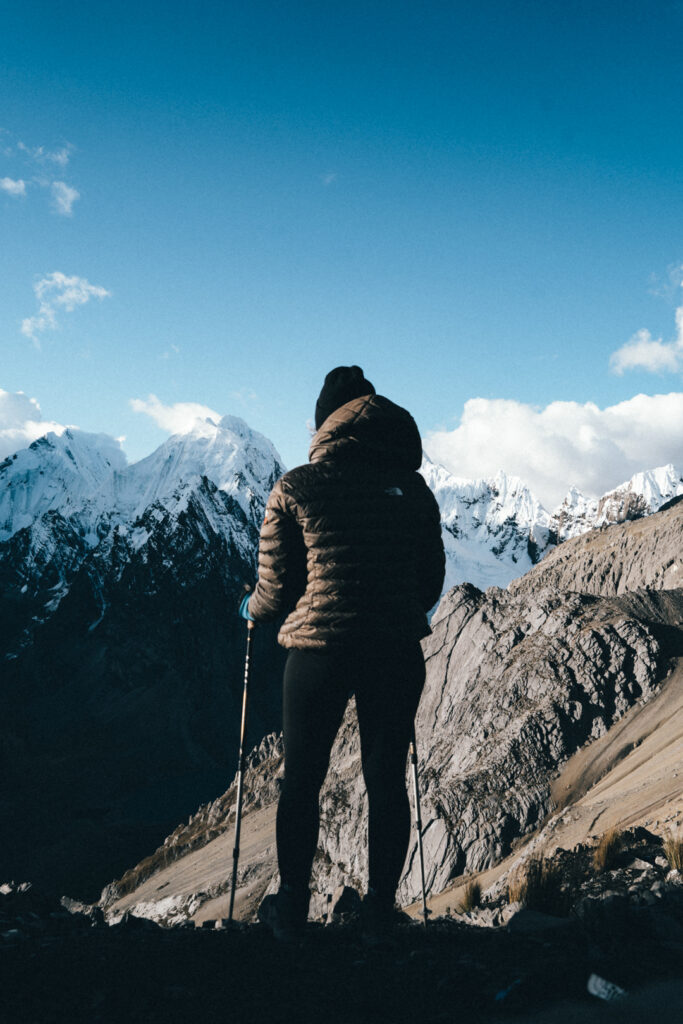
Day 5: A Breeze
If you’re like my group who completed San Antonio pass on Day 4, then you can expect Day 5 to be an absolute breeze. The hike doesn’t involve any mountain passes, it’s simply hiking down and flat all the way to the next campsite which is in a village, in a school’s grass “stadium.”
We arrived very early around 11 AM and practically had a much needed rest day that involved showering, laying in the sun, reading, playing soccer together and bonding over some drinks and games. I think we all needed this day to recover a bit and bond even more as a group.
Make sure to bring cash for this day if you want to have a shower or buy snacks and drinks.
Day 5 Stats:
- 16 kilometers (9.94 miles)
- -1000 meters (-3,280 ft) in elevation gain
- 4 hours of hiking
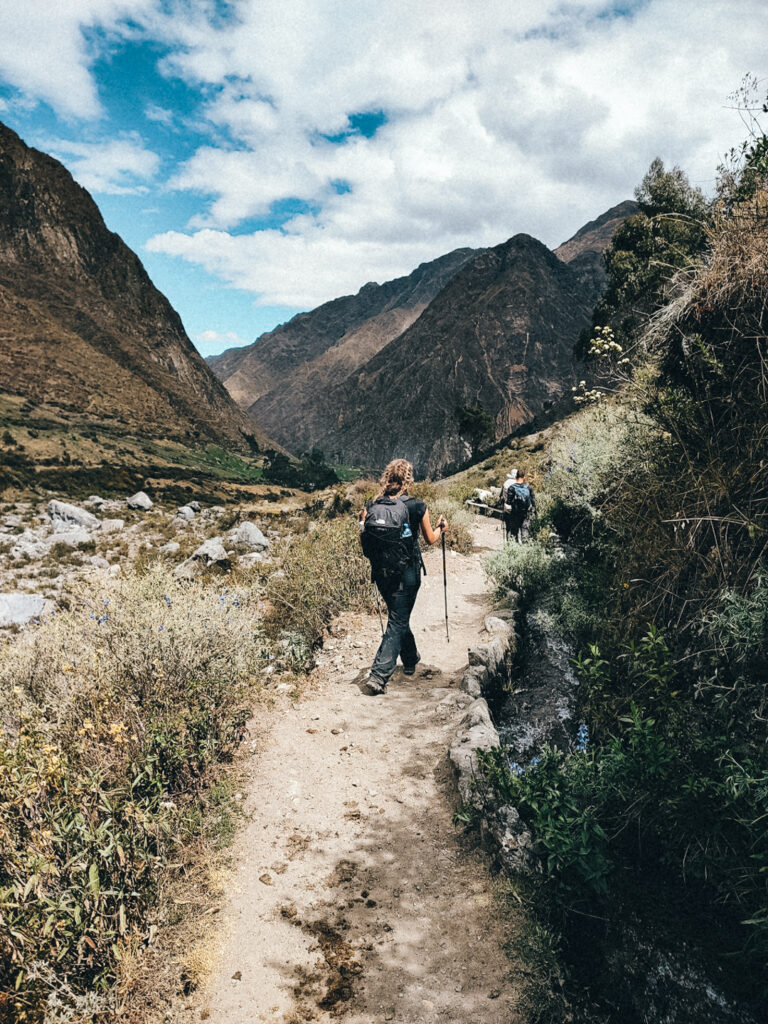
Day 6: Back up we go
In hiking, you may know that unless you’re at the end of the trail, what goes down usually has to go back up. So you guessed it, on Day 6 starting at 3,500 meters you’ll hike up and over a mountain pass at 4,800 meters.
With a 1,300 meter elevation gain, I was pretty nervous for this day but it actually ended up being the easiest ascent for me the whole trek. Probably something to do with feeling energized after an easy previous day, knowing that we only had two days more, and having a very hungover and slow guide.
However, this may have been a personal experience and a product of expecting the worst from such a big altitude gain. I would still rate this as a pretty difficult day.
Day 6 Stats:
- 13 kilometers (8 miles)
- 1,300 meters (4,265 ft) in elevation gain
- 6-7 hours of hiking

Day 7: An impressive Panoramic View
As I mentioned, I personally think San Antonio pass was the most beautiful view, but Day 7 comes as a close second. In fact, all tour companies will tell you it’s the most impressive day, and I have to say I would not want to miss this.
You know the drill, another day another mountain pass. I personally thought this one was pretty cool, even on the way up the rocky terrain felt other-wordly. Further along at the top, you’ll walk along the ridge of the pass and enjoy a 360 panoramic view of the cordillera.

As you walk it just keeps getting better as your campsite slowly comes into view. It’s then a very steep descent down, a time my knees were very thankful for my hiking poles.
At the campsite you can continue on to the highest of the lagunas; my group opted to lay in the sun and drink beer instead.
Day 7 Stats:
- 500 meters (1,640 ft) in elevation gain
- 5 hours hiking

Day 8: The final day!
Last day of the Huayhuash trek! Before you embark on a steep downhill though, you have one final mountain pass to complete. As you reach the top, it’s a wild feeling to know that you did it and bittersweet as you head down.
At the bottom you’ll wait for a bit and then have the same drive back to Huaraz.
A recommended end to your itinerary is to do as my group did, which was enjoy dinner and drunk karaoke that night before parting ways. After 8 days spent together, your group will nearly be family and it’s worth celebrating your trekking success together.
Day 8 Stats:
- 15 kilometers (9.3 miles)
- 700 meters (2,296 ft) up and then 800 down to the bus
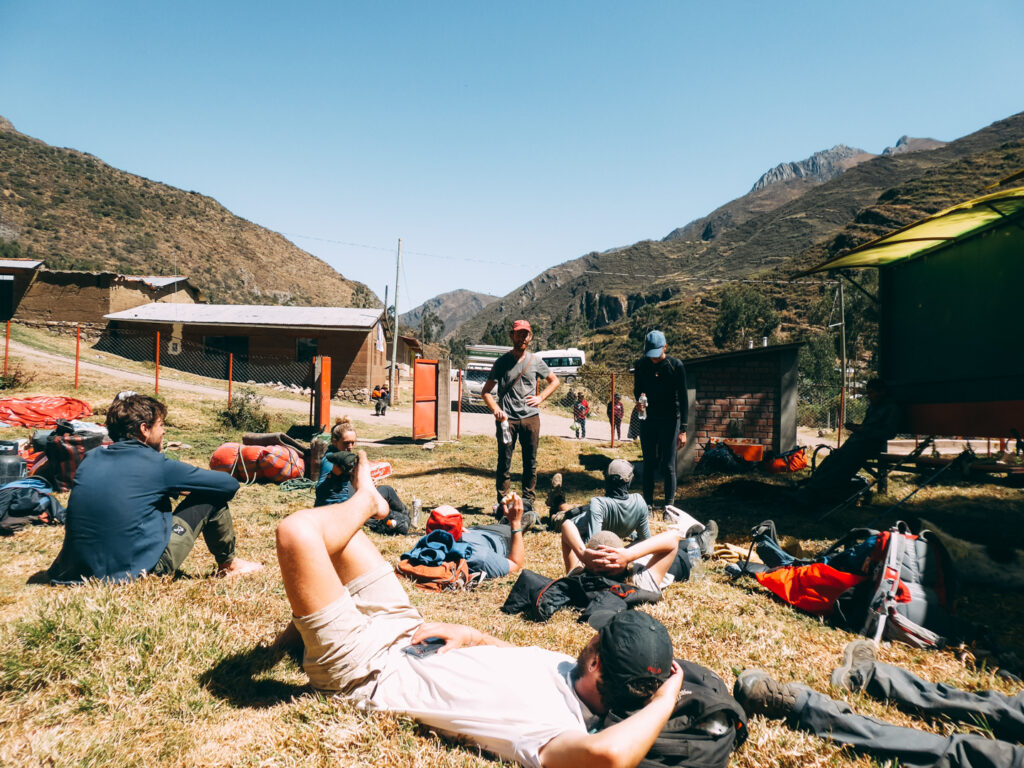
WHAT TO EXPECT TREKKING THE CORDILLERA HUAYHUASH
What's included in a guided trek:.
Most tour operators include the same for the Huayhuash trek: a licensed guide with a first-aid kit, camping equipment including tents, sleeping mats, and sleeping bags, all of your meals provided (except for the first lunch at the restaurant in Llamac), all transportation, and mules to carry a bag with your belongings. Some tours (like with Krusty Hostel /Huayhuash Expeditions) will also include the park entrance fee and an emergency horse to ride just in case.
What’s not included is any clothing, hiking poles , hiking boots , travel insurance , personal items and a water bottle – although boiled water is provided throughout, you just need to bring a bottle.
In terms of weather, expect it all. At night and in the morning you can guarantee it’s going to be frigid, with temperatures at or below freezing. During the day you can guarantee you’ll have everything from hot, to cloudy, to cold, to hail, and maybe even a snow storm (if you’re lucky like me…). My group joked that every day in our backpacks we needed clothes for all seasons, and the story of our lives was stripping and adding layers every other hour.
This is just how the climate is at high altitude, but to ensure the best weather it’s best to complete Huayhuash during the winter/dry season. More on that later. Regardless, it’s best to be prepared with different types of clothing and layers. Also, more on that farther down.
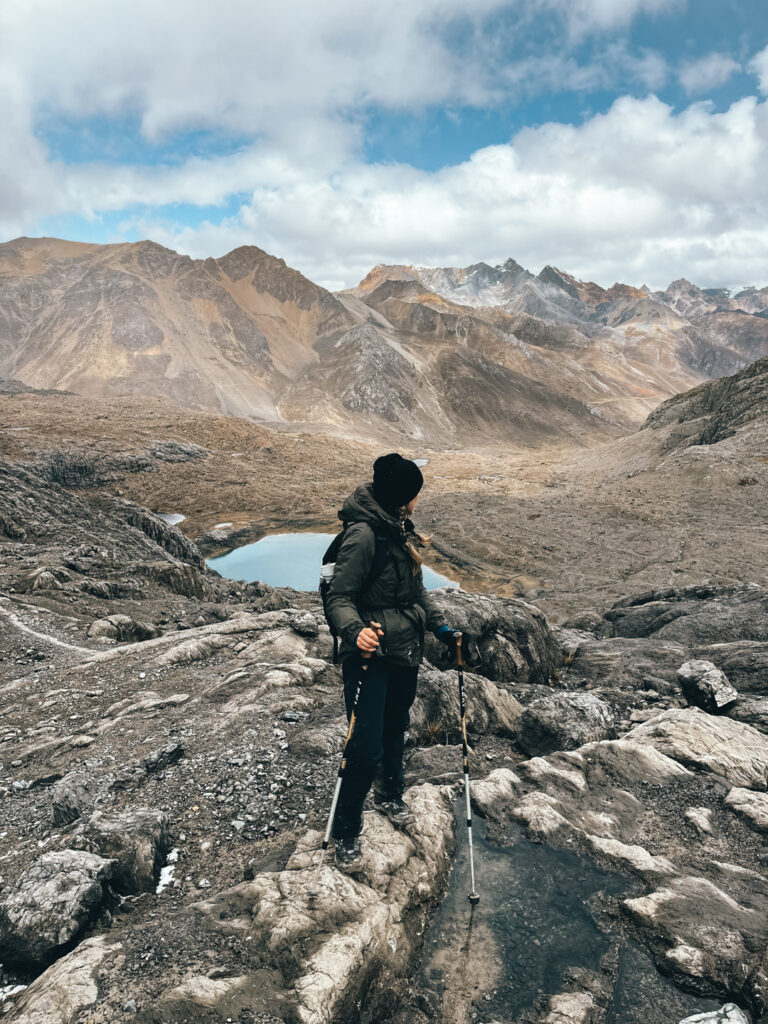
If you’re doing Huayhuash as a guided trek then you don’t need to worry about eating ramen and dehydrated food the whole trip. Group trips include a cook and so you’ll be spoiled by having all meals cooked for you.
In terms of food options, I would say you can expect pretty decent meals, however repetitive, with plenty of carbs and protein to sustain you for the week. Vegetarian options should be available, but make sure and double check before booking with a group and letting them know.
During my Huayhuash trek for breakfast we mostly ate bread with butter and jam accompanied with either cereal & yogurt, pancakes and once shakshuka. For lunch it varied between pasta or rice dishes with a protein and once ceviche. And for dinner, we always started with a hot soup followed by the main dish of also pasta or rice with a protein. Additionally, snacks for the trek were provided every morning (always cookies, a chocolate bar and one fruit) and after hiking we always had a tea time accompanied by a snack of usually popcorn but once chips and guacamole (my favorite day!!).
So if you’re wondering, should I bring any food? The answer is that you don’t need to bring anything substantial BUT if what I just described isn’t to your liking then I would definitely pack some extra snacks. Personally, I packed some nuts and candy gummies for everyday just in case I was ever hungry or wanted a sugar boost.

As you can imagine, during Huayhuash you won’t be staying anywhere luxurious. You’ll be camping in tents throughout the entire trip except for one night where a hostel is optional. I was worried about being really cold, but my tour company, Huayhuash Expeditions, provided excellent tents and sleeping bags. Combined with the warm layers I packed, I was pretty toasty while sleeping.
Fortunately, at every campsite there are toilets; not always the most clean, but they did provide some privacy compared to having to try and shit outdoors in the fear that someone can see you.
In terms of showers, there aren’t any except for on Day 5 when you either camp in the village or stay in the hostel available. To freshen up throughout the trek, I brought wet wipes and after every day of hiking I would wipe myself down before putting on my clean pajamas or camp clothes.
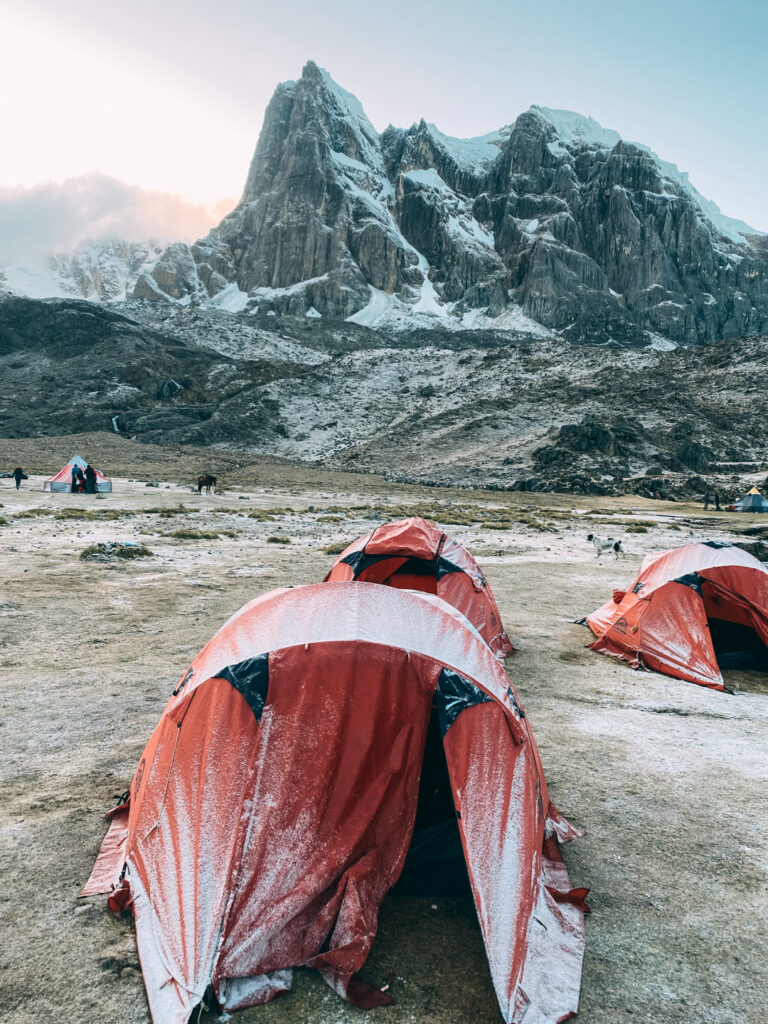
Privacy & Safety as solo female traveler:
Because you’ll be in a group, you don’t have to worry too much about safety during the Huayhuash trek. It’s unlikely you’ll ever be completely alone or encounter animals, and should you get injured there’s a first aid kit and emergency horse available. I also recommend getting travel insurance just in case.
But if you’re joining a random group as a woman alone, you may also be thinking what about the people in my group and what about sharing a tent with a stranger. This is a valid concern since you never really know and unfortunately uncomfortable situations can arise anywhere, especially when sleeping next to someone you don’t know.
If you’re really worried, it may be possible to request a private tent, however I actually do not recommend this because sharing a tent can actually be really fun (you have someone to laugh with through the suffering of cold mornings) and having another person in the tent can keep you warm at night.
Instead I recommend pairing up with another woman if you can. When booking your group, you can request to see the list and ask if there’s another solo female traveler.
However, if this is not an option, then try to pair up with someone you feel most comfortable around. When I did Huayhuash, there were two other women in my group but they both came with their partner so I knew immediately I was going to have to share a tent with one of the other five guys in my group. Not to sound psycho, but rather honest, I totally scoped them out on the drive there and as we were setting up first camp. Of course you can’t know a person after an hour or two, but talk and make friends and whoever seems like someone you vibe with (and honestly feel safe around) that’s who you ask to share a tent with. Use the spidey senses ladies.
As a disclaimer, I want to finish this section by saying all the men in my Huayhuash group were respectable people who I all really liked. However, I’ve been in other uncomfortable situations in the past so it seems worth it to mention this “tip” for those who may be worried about it.
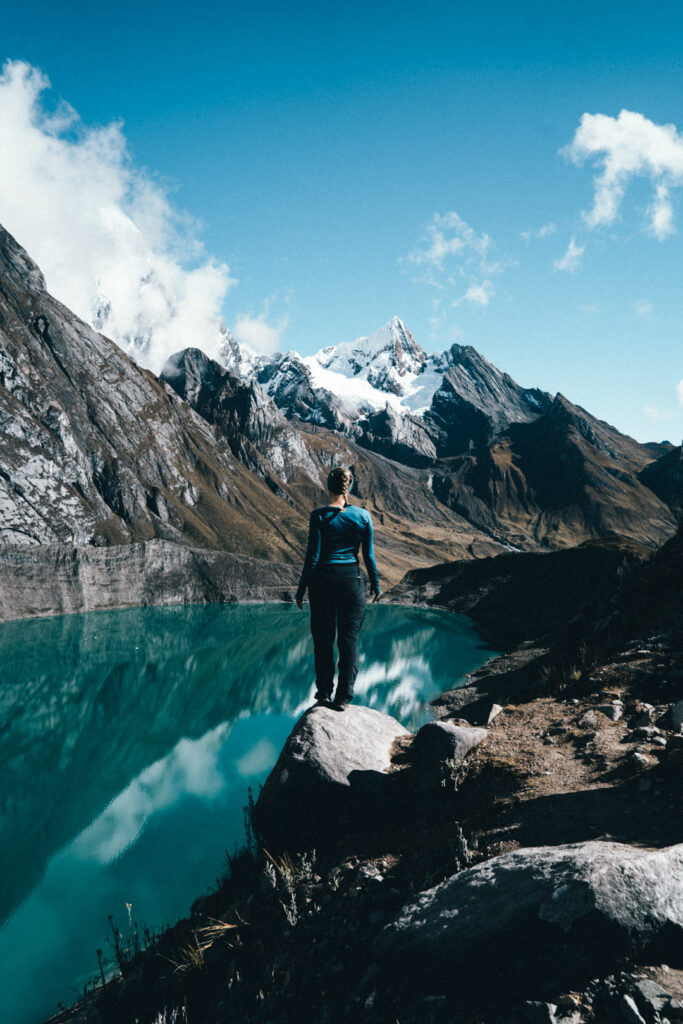
HOW TO FIND A GROUP & WHERE TO BOOK YOUR HUAYHUASH TREK
When to book your trek.
It’s tempting to think that for a big trek like Huayhuash you should book it in advance on the internet in order to save your spot. But I actually really discourage this. Rather, I suggest arriving in Huaraz a little earlier, not only to acclimate and enjoy other day trips, but also to book your trek there in person .
By waiting to book in person you have the opportunity to meet others and possibly form your own trekking group, plus it’s WAY cheaper in Huaraz. For most tours in Peru, when you book online vs. in person it’s almost always a double price difference. Huayhuash is no different. Online you’ll find the Huayhuash trek for upwards of $700 USD or more, while in Huaraz you can join a group for $380 – $500 USD.
Private vs. random group
When booking Huayhuash, you have two options: first to form your own group of friends and book a private group, or second to join a random group of other travelers. While I met a lot of friends in Huaraz to join me for day trips, I didn’t meet anyone interested in the 8 day Huayhuash trek and so did the second option by joining a random group.
While this sounds daunting especially as a solo traveler, don’t be discouraged if this happens to you too. My group was so incredible and we bonded so much through those 8 days. I really couldn’t have asked for a more hilarious and supportive group of people of whom I’m still in contact with later on.
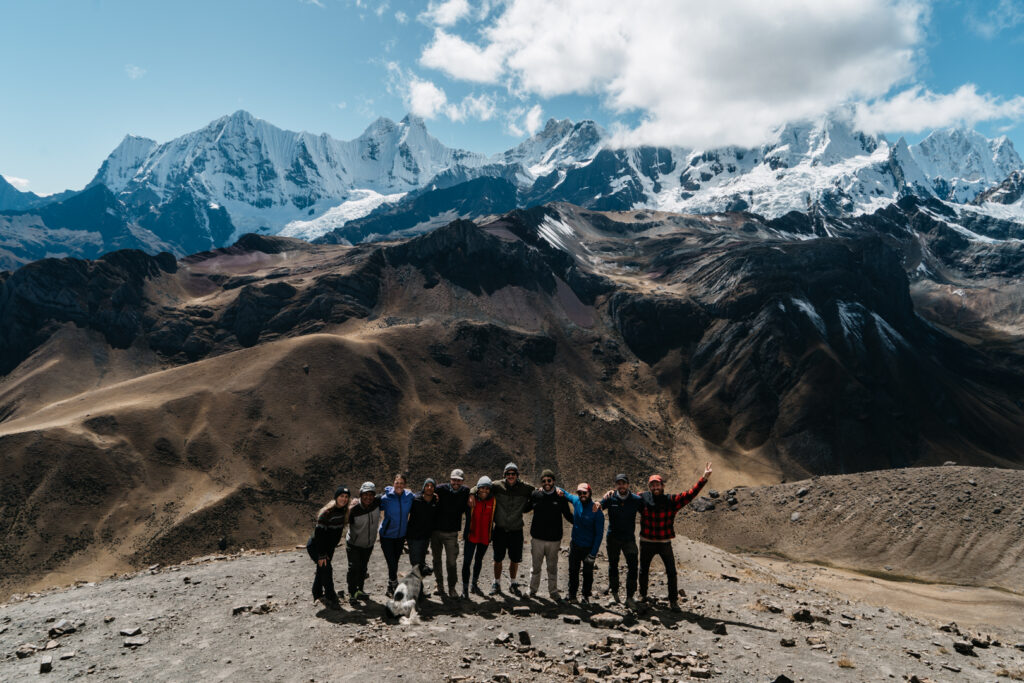
The best tour company for Huayhuash
There are many tour operators in Huaraz who offer the Huayhuash trek. After shopping around a ton, I found that the best option was booking through Krusty Hostel which uses Huayhuash Expeditions . They were highly recommended and had the cheapest price at 1500 soles, roughly $380 USD (for whatever reason, this price applied only when I booked through Krusty Hostel, not when directly whatsapping a Huayhuash Expeditions guide who gave me a much higher price).
After trekking with Huayhuash Expeditions for both Santa Cruz and Huayhuash, I can say I was extremely pleased with the gear, my guide, the group, and the entire experience. They included a few extras compared to other companies like a spacious duffle bag so you can bring plenty of warm layers, an emergency horse and the entrance fee to the park.
My guide for Huayhuash was also patient, encouraging and professional. Plus, Krusty Hostel is a popular place to book tours so you have a good chance at being paired with fun people and fellow backpackers. Like I said, I had the best group I could have possibly asked for, especially going into it not knowing a soul. We were practically family by the end of the week.
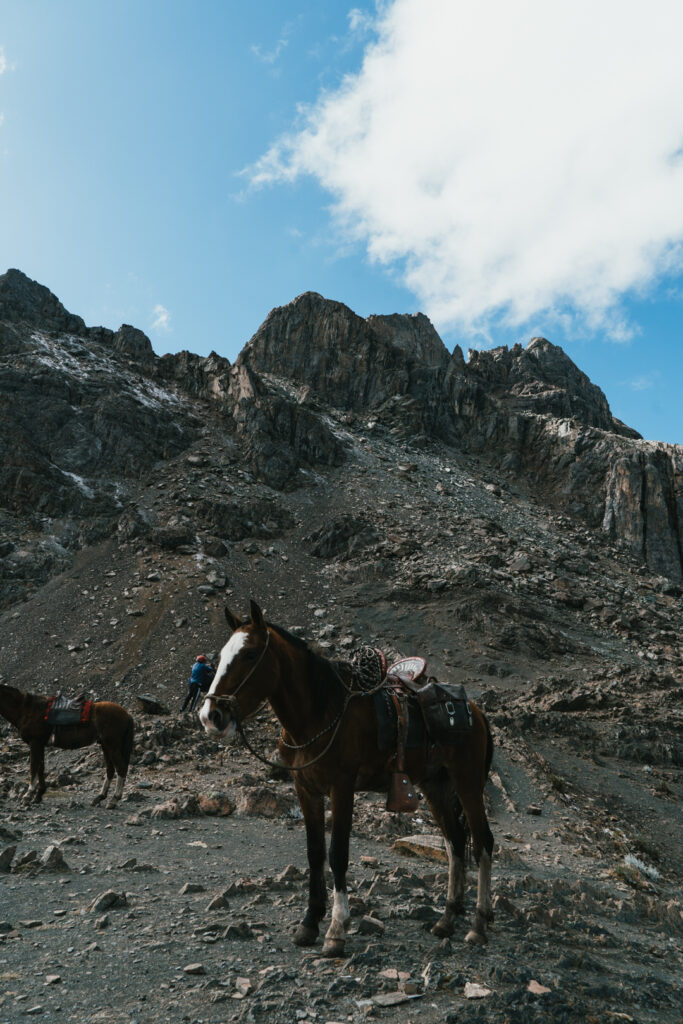
WHEN IS THE BEST TIME TO DO HUAYHUASH
The best time to do the Huayhuash trek is from May to September. This falls during Peru’s winter but it’s also dry season which means you’ll mostly avoid rain and snow during hiking. Of course at high altitude, you never know with the weather, but during these months the conditions are generally best.
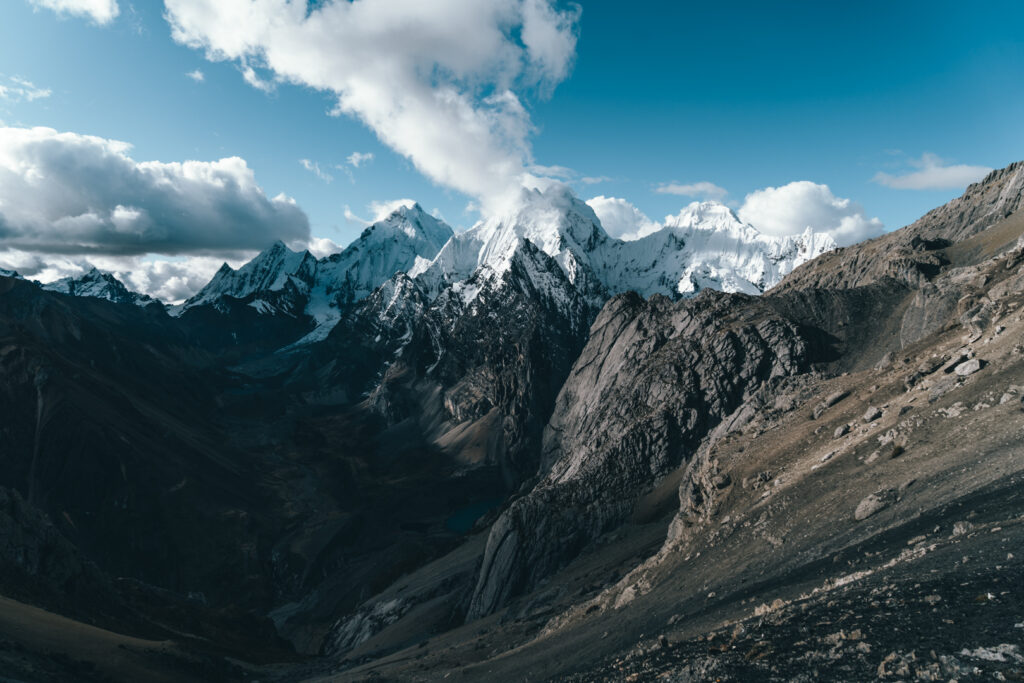
HOW TO PREPARE FOR THE HUAYHUASH TREK
Physically & with the altitude.
As I mentioned previously, I didn’t really do any “technical” training for Huayhuash, however I did several high altitude hikes to prepare. I really believe this made a huge difference for my stamina and definitely acclimating.
Some recommended day-hikes you can do are Laguna Churup, Laguna 69, Laguna 513, and Laguna Llaca. The 4-day Santa Cruz trek is also a great way to prepare if you have the time. You can learn more about all these hikes in my Huaraz guide here .
But whichever you choose, if you’re coming from sea level I would recommend 3 days to acclimate in Huaraz and to do a few other physical activities before Huayhuash.
And by the way, if you’re wondering wtf is acclimating… Let me explain. Basically there’s less oxygen at higher altitude levels and your body needs time to get used to functioning while using less oxygen aka acclimatization. Especially if you’ve never been at a higher altitude like this, you can expect feeling more fatigued much easier, having headaches, getting dehydrated quicker and if you get altitude sickness you can have other symptoms like nausea and diarrhea.
Even after acclimating in Huaraz, you still might feel symptoms during the Huayhuash trek. The best you can do is pack medication to treat symptoms (listed below), stay really hydrated, and hike slowly listening to your body. If you get really sick, of course tell someone in your group and your guide.
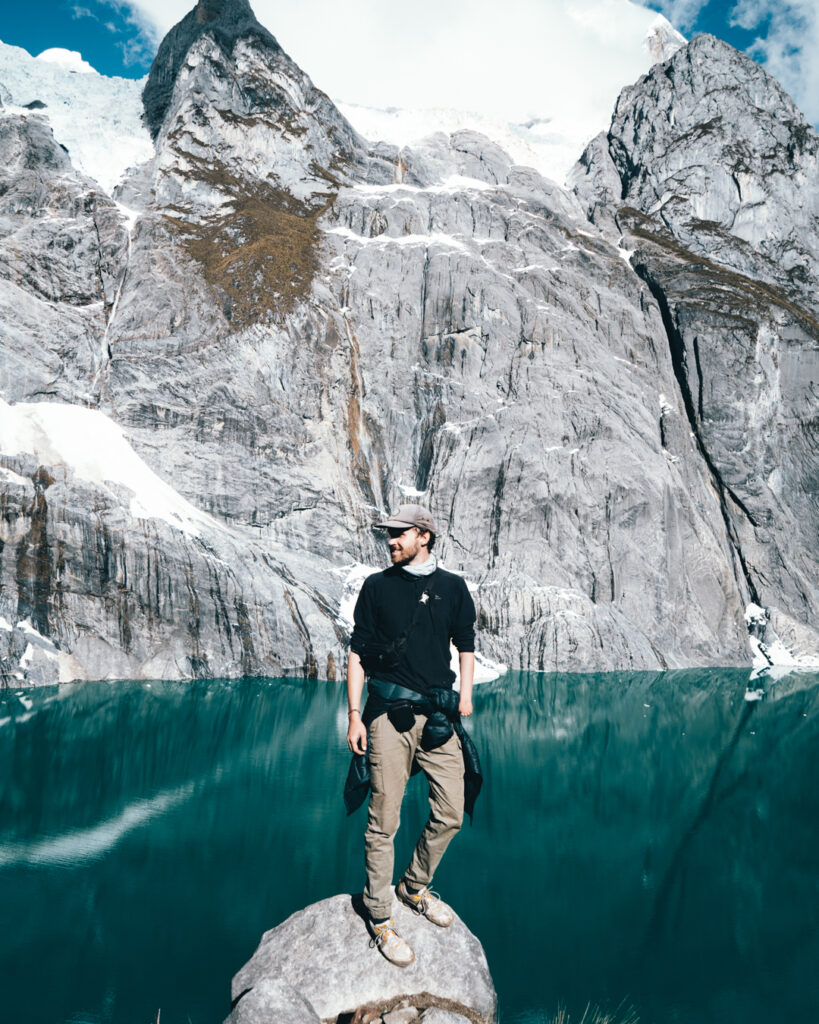
What to Pack for Huayhuash
If you’re joining a guided group, the company should provide all the equipment like a tent, sleeping mat, sleeping bag, and food. Therefore you’re really only responsible for bringing clothes & personal items.
Here’s what I recommend bringing along with links if you’re looking for suggestions:
- Waterproof hiking pants
- Long sleeve shirt(s)
- Short sleeve shirt(s)
- Pullover or hoodie
- Thermal base layers for nighttime
- Sweater, pants, socks (authentic alpaca wool from Peru is a good option! They have so many cute sweaters, ponchos, hats gloves, & scarves in Huaraz)
- Jacket for warmth
- Rain jacket
- Beanie , gloves , neck gaiter
- Baseball cap
- Supportive hiking boots
- Hiking socks
- Reusable water bottle
- First aid kit
- Altitude medication (Acetazolamide, or Diamox – very different from solely a supplement), imodium , nausea meds , ibuprofen , & electrolytes
- Microfiber towel
- Pillow (for camping)
- Flashlight and/or head lamp
- Hiking poles (bring your own or rent them in town)
- Kindle (a lot of downtime in the afternoons)
- Supportive backpack – the mules will carry your bigger bag (a duffel should be provided) but you’ll carry a day pack of water, extra layers and snacks while hiking
- Waterproof backpack cover
- Camera gear to capture the amazing views!
- Portable charger and/or solar charger – no outlets during the trek
- Wet wipes to freshen up after the hike
- Any toiletries – keep it to a minimum but for skincare I suggest bring your hydrating routine because high altitude and harsh winds dry out your skin so much
- Toilet paper (seriously don’t forget this)
- Diva cup (it’s not fun being reliant on tampons in the wilderness)
- Hand sanitizer
The most important thing is having layers to stay warm at night, and with the duffle bag provided you don’t have to worry about light clothing to carry so don’t hold back on the fleece.
Also note that you don’t need a fresh hiking outfit for every single day. It makes much more sense to re-wear clothes which sounds gross but everyone does it so F it. To feel clean it’s more important to bring a change of undergarments, undershirts, socks, and to never mix what you sleep in with what you hike in.

Random tips for Huayhuash
Saving your battery.
You won’t have any access to outlets during the Huayhuash trek, so if you want your phone/camera fully charged for photos then make sure to conserve your batteries. You can do this by keeping your phone in airplane mode at all times (there’s no service or wifi anyways), turning your phone off at night, putting anything with batteries in your sleeping bag at night (the cold drains batteries) and by using your camera/phone as little as possible.
Throughout Huayhuash, I used my phone and camera to take photos and that was about it. I didn’t even waste precious battery flipping through photos. Also if you have a portable charger , definitely bring this.
In combination with my portable charger and conserving my batteries, I was able to have enough charge on my camera and phone for the full 8 days. It’s crazy how much it lasts when you’re not scrolling through Tik Tok all the time…

Optimize Your Day Pack
During the day you don’t have access to your big bag, so make sure anything you may need while hiking is in your day pack. This includes water, snacks, clothing in case of a weather change such as a rain jacket or extra layer, sunscreen, sunglasses, hat, tampons/diva cup, toilet paper/tissues, and altitude meds should you get sick while hiking.
Bring something to keep you entertained
Tough mornings of hiking are usually followed by slow afternoons during Huayhuash. With no wifi in the middle of the wilderness, you might even find yourself being bored – in a good way. I entertained myself by hanging out with my group, reading, and sometimes doing yoga.
I would anticipate this time and bring something like a book or Kindle , journal and pen, a deck of playing cards or another game, or maybe pre-downloading some movies on your phone. Personally, I didn’t watch anything on my phone because I wanted to conserve battery for photos but if you have a big enough portable charger or don’t care much about photos you could do this. I did however pre-download music and podcasts for listening which use less battery.

Hike at your own steady pace
I mentioned it before, but I was by far the slowest in my trekking group. However, I stopped caring because I soon found that if I tried to keep up with other’s pace, I just got really tired and had to take a long break to catch my breath. It was much more sustainable to keep my own steady and consistent pace.
When you hike Huayhuash, remember it’s a marathon not a sprint. Do you, just keep going.
Figure out hairstyles that work for you beforehand
8 days of trekking with no showering can make your hair really annoying especially if it’s long. I anticipated this and brought a headband, plenty of hair ties so I could braid it, and a hat. I also washed it the night before leaving so that it was the most fresh to start. I recommend doing the same and finding hairstyles that work for you, keeping in mind your hair will be dirty a lot of the time.
Wet wipes to stay clean
Like I said, you’ll only have a shower one night out of the 8 days so if you’re like me and hate feeling dirty, bring wet wipes to freshen up. There’s also no trash around and you don’t want to litter, so bring a plastic bag to put dirty wipes in.
TRAVEL INSURANCE for huayhuash
Travel insurance is always a must to cover things like trip cancellation or changes, lost or stolen items, and medical emergencies. When doing adventurous activities like the Huayhuash trek, I would say it’s even more essential.
The problem with travel insurance while trekking is that most insurance companies have a cut off for any activities above a certain altitude. Usually around 3 or 4,000 m, well below the altitudes of the Huayhuash trek. Meaning, if you get injured during the trek, they won’t cover your bills.
For that reason I recommend World Nomads travel insurance which is made specifically for adventurous backpackers – specifically their Explorer package.
→ LEARN MORE ABOUT WORLD NOMADS TRAVEL INSURANCE COVERAGE HERE

How to Get to Huaraz to start Huayhuash
As I mentioned, the Huayhuash trek begins in Huaraz, Peru which is about 400 km (250 miles) north of Lima. Most people traveling to Huaraz from outside Peru will first need to fly into Lima then go to Huaraz.
Huaraz doesn’t have an airport so the only way to get there is to drive yourself or take a bus (the most popular and most practical option for most).
HOW TO GET TO HUARAZ FROM LIMA
To get to Huaraz from Lima, you can take an 8-9 hour bus. It’s possible to depart during the day, but the most popular option is to book a night bus so you can sleep (hopefully) the entirety of the trip.
There are a number of bus companies to book with such as Movil , Civa and Cruz del Sur . For easy booking and comparing prices, you can search and book your ticket on Busbud .
When choosing your ticket, note there are different seating options based on seat reclining degrees and other factors. For example, cheaper seats only recline 140 degrees whereas premier seats recline 180 degrees, similar to a bed for better sleep – a game changer on those overnight trips.
Ticket prices are typically around S/100 ($25 USD) depending on when you book and which seat you choose.
After arriving in Huaraz by bus, you can walk or take a taxi to your accommodation.
If traveling the other way from Huaraz to Lima, the process is the same.
HOW TO GET TO HUARAZ FROM TRUJILLO
To get to Huaraz from Trujillo, you can also take an 8 – 9 hour overnight bus which can be booked with Movil or Linea . For easy booking and comparing prices, you can search and book your ticket on Busbud .
When choosing your ticket, note there are different seating options based on seat reclining degrees and other options. For example, cheaper seats only recline 140 degrees whereas premier seats recline 180 degrees, similar to a bed for better sleep – a game changer on those overnight trips.
Ticket prices are typically around S/65 ($17 USD) depending on when you book and which seat you choose.
After arriving in Huaraz, you can walk or take a taxi to your accommodation.
If traveling the other way from Huaraz to Trujillo, the process is the same.
→ Also Read My Complete Guide to Huaraz Peru
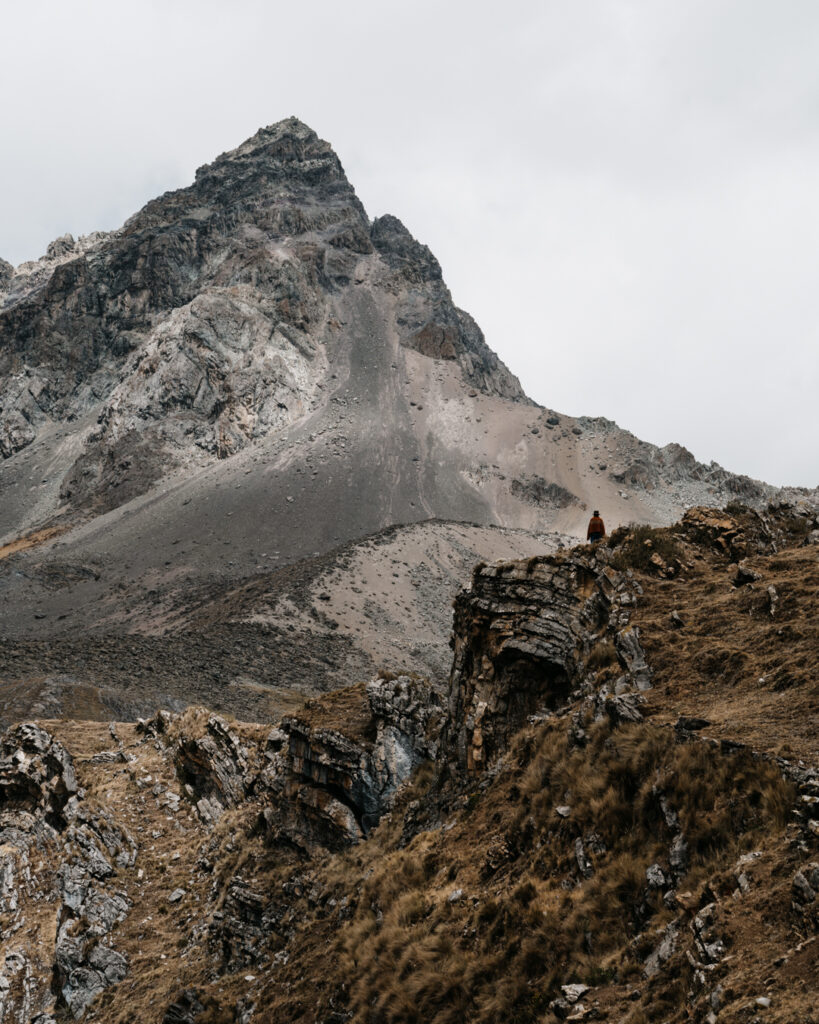
And that’s it! If you’ve made it this far, thank you for reading. This was a long and extensive guide for the Huayhuash trek, but I really wanted to answer all the questions I had myself, especially as a solo female traveler, before completing this challenging trek.
If you found this helpful or end up completing Huayhuash yourself, I’d love it if you leave a comment so I can congratulate you. This is a bucketl ist item you should absolutely be proud of.
Make sure to check out my other resources for Peru and South America. Happy traveling!
More Resources for Your Trip to Huaraz:
Accommodation recommendations.
Budget $: Krusty Hostel . A comfortable B&B that was very helpful in booking all tours and meeting other people. Search for availability here.
Mid-Range $$: Selina . Stylish and comfortable stay with dorm & private rooms available in addition to a spacious kitchen, yoga studio and courtyard. Search for availability here.
If these aren’t available or to your taste, you can search more on Hostelworld and Booking.com
Flight to Peru
Flights to Peru are typically cheapest to Lima, and this is the closest international airport to Huaraz. To get the best prices I recommend using Skyscanner .
Bus to Huaraz
To find the best prices and most convenient trip to Huaraz, I recommend searching on BusBud .
Travel Insurance
I recommend WorldNomads for adventurous backpackers in Peru. You can search for coverage here .
Things to do in Huaraz
There are many day trips to do in Huaraz such as Laguna Paron, Pastoruri Glacier, Nevado Mateo, Laguna 69 & more. Read my full Huaraz guide here to learn more about these trips & more.

Related posts
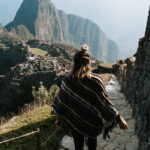
The Different Ways to Visit Machu Picchu Explained
Visiting Machu Picchu, one of the 7 new wonders of the world, is practically on everyone’s buc...
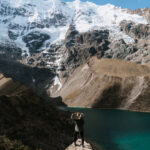
What to Bring Trekking in Peru: An Easy Packing List
On a trip to Peru, it’s likely you’re doing at least one multi-day trek whether it’s the Inca Trail,...

Peru’s Huayhuash Trek: Ultimate Guide by a Solo Female Traveler
Named one of the 10 most beautiful treks in the world, the Cordillera Huayhuash circuit should absol...
Liked this post? Share & save it on Pinterest
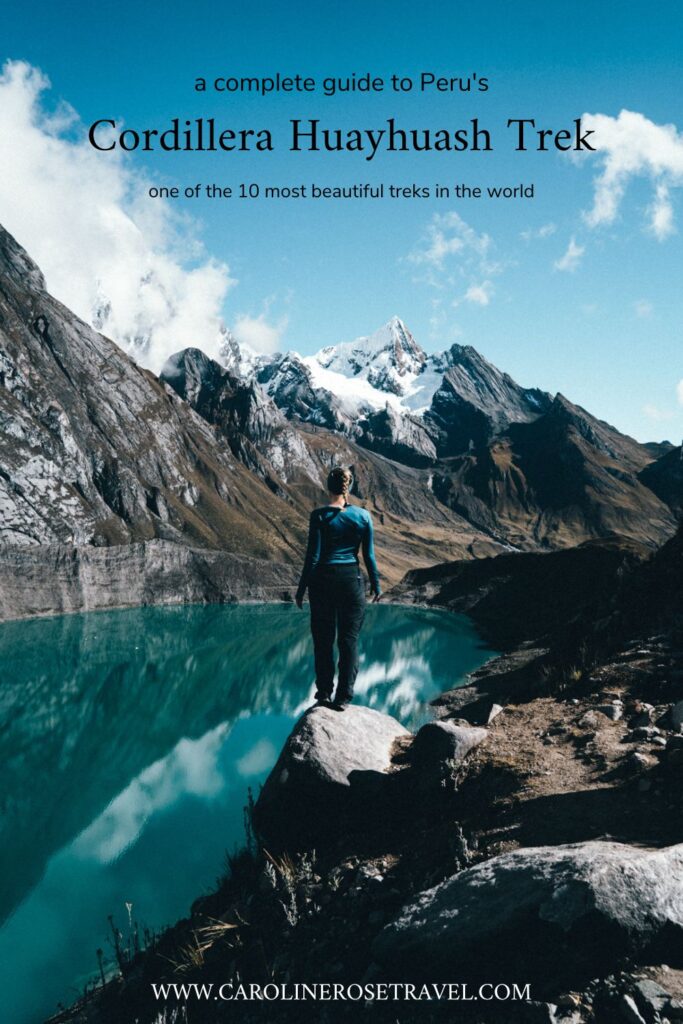
Tony The Tiger
Great report, Caroline! I am officially a fan of your site now 🙂
One question, when you booked the tour through Krusty Hostel, so you were physically at the Hostel not through their website, correct?
Caroline Rose
I realized I’m replying super late, so I apologize to you Tony. But for anyone else who may read this – fyi, I did book in person at the hostel. They should have a Whatsapp number too though that you can message to book activities ahead of time if you wish.
Hi! Thanks for such a thorough guide with awesome photos. A question about booking through Krusty – are the tours leaving daily? I only have 11 days I could spend in Huaraz and wondering if it’s worth the risk of not booking in advance, in case the tours are full or they don’t have enough people, etc.
The one day excursions should leave every day, although you should double check with them. However, the longer excursions such as Santa Cruz or Huayhuash trek usually leave on a particular day when it works for guides or when there’s a big enough group. So if you have a limited amount of time you should definitely check in beforehand with them to see if their scheduled trip works with your timing.
Save my name, email, and website in this browser for the next time I comment.
Subscribe me to Caroline Rose Travel
This site uses Akismet to reduce spam. Learn how your comment data is processed .

Hike Huayhuash: Our Guide to Peru’s Most Beautiful Trek

Blue, green, and turquoise lakes. Icy peaks, flowing rivers, and glaciers. And often not a human in sight. This is your experience if you hike the globally-recognized Huayhuash.
What is Huayhuash?
Huayhuash is a private conservation area managed by local communities. It’s recognized as one of the best hikes in the world. And with only 5-7,000 visitors a year , it’s much less crowded than the Inca Trail (which sees 500 people a day !).
Huayhuash is already well-known in trekking circles, and mountain biking is available now, too.
I think the best part of Huayhuash is that you can create your own adventure. Itineraries vary from three to eighteen days. They are generally moderate to moderately strenuous, so you don’t have to be an expert mountaineer to enjoy Huayhaush.
The crazy thing is, the Huayhuash mountain chain is only 30km (19 miles) long. Yet it includes 3 departments in Peru, campsites at 4,000 meters (13,000 feet) above sea level, hot springs, turquoise lakes, glaciers, and the country’s second tallest mountain.
Why Hike Huayhuash?
Unlike most hikes in the Andes, this landscape here is more open. Because of that you’ll get amazing views of the mountain chain as you walk and rest at campsites. That’s also why Huayhuash is considered one of the world’s best hikes. Highlights include the three lakes, all different colors, and Peru’s second tallest mountain, Yerupaja. Yerupaja is 6,635 meters (21,800 feet) tall.
The movie Touching the Void (based on a true story) takes place in Huayhuash, too. You’ll get up close with the mountain that Joe Simpson and Simon Yates scaled, Siula Grande.
Plus if you hike Huayhuash you’ll directly contribute to local communities who manage the campsites. And you’ll see cool wildlife like llamas, alpacas, viscachas, Andean foxes, and condors.
Last but not least, this hike is more affordable than its more famous competition in Southern Peru .
But Huayhuash is just as good… perhaps better.
Itineraries in Huayhuash
Again, Huayhaush really is a create-your-own-adventure, which is unique for a hike that’s so highly regarded. There are options for all types of budgets and expectations.
To do the WHOLE hike, there are 15-18 day itineraries. But more visitors take a 9-10 day option or the “mini” 7-day hike. Each of these includes the main attractions of the full 18-day hike. Finally, consider a 3-day hike if you’re short on time, funds, or aren’t sure about a longer trek.
Almost all of these start in Llamac in Ancash department and include the view of three lakes. Campsites are usually at over 4,000 meters (13,000 feet) above sea level.
Most Common Itineraries for Huayhuash
- 3 days: 15-20 km (9-12 miles). You’ll see a few of the major spots, all in the department of Ancash.
- 7 days: This is the “mini” version and is considered the minimum amount of time to see most of Huayhuash, and it changes depending on visitor preference.
- 10 days: Generally 110-115 km (about 70 miles); check out the sample itinerary below for more details!
- 15-18 days: This is the full Huayhuash hike and the only way to see everything.
- NOTE: All of these include one or two passes at over 4,000 meters (13,000 feet) a day and start in the village of Llamac in Ancash
Alternative Hiking Options for Huayhuash
Some hikes start in the thermal baths in the department of Lima and include the Raura mountain range, which is adjacent to Huayhuash. A few tour companies offer archaeology-based hikes, and several center on mountain climbing.
9-Day Example Itinerary
The most common itinerary for Huayhuash is 9-11 days. That’s because you see all the “big” attractions and aren’t going to be rushed . This is a moderately strenuous trek which includes several 8-9 hour long hikes.
You start off in Huaraz ( Ancash’s hiking capital and 8 hours from Lima ). From there it’s a 2 hour ride to Chiquian, and from there 1 more hour to Llamac.
Llamac is where trek begins.
From Llamac it’s a forty minute walk to Pocpa, and a further 1.5 hours to the campsite. Another option is to continue hiking uphill to Cuartelhuain for the night.
Start getting used to early mornings! At 7 am start the 2 hr uphill walk to Cacananpunta Pass, located at 4,750 meters or 15,580 feet above sea level. By lunchtime the hiking gets easier and you camp at Mitucocha.
Mitucocha is next to a river and you’ll chill with views of snowcapped mountains from the green valley.

This is another 5 hour day of hiking. Today the tallest point is Yanapunta Pass, at 4,650 meters, or 15,260 feet. If you haven’t started, consider coca tea for the altitude.
You end up at Carhuacocha lake to camp for the night.

It’s the first big day! That’s because you’ll walk for 8 hours, see the 3 lakes, and go over Siula Pass , next to the infamous Siula Grande.
Siula Pass is the tallest pass of the hike so far at 4,785 meters (15,700 feet). From there you’ll get an awesome view of the three lakes and mountain range behind them.
Afterwards it’s all downhill to the Huayhuash campsite.

This is a day of hiking for 5 hours to Viconga, where you can soak in hot springs. In case it’s not obvious, NEVER pass up a chance to soak in hot springs during a long, cold hike!
You’ll also go over Portachuelo Pass, which is about the same height as Siula, and end up at an altitude of 4,350 meters (17,560 feet) to camp for the night.

By now you might be used to getting up at 7am and walking for hours. Which is exactly what you’ll do today. The total hiking time today is about 8 hours.
You’ll summit Cuyoc Pass at 5,000 meters (16,400 feet). From there you’ll view the whole Huayllapa valley and head on down to the campsite. If you have energy go to the Antonio lookout. From there you can view the entire mountain chain .
For three hours you’ll walk to the town of Huayllapa, the first place you can buy limited food and supplies.
Rest up, make some phone calls, or just chill in town, because afterwards it’s 4-5 hours of slogging uphill to the campsite at 4,235 meters (13,900 feet).
This is the longest day. You’ll hike for roughly 9 hours and go over two passes that are over 4,700 meters (15,400 feet) high. At the second pass, you’ll have lunch and enjoy one last great view of Huayhuash.

Today’s short and 80% of the walk is downhill. You’ll finish at the town of Pacllon. From Pacllon take a bus back to Chiquian and then Huaraz.

Afterwards, rest up, eat, and bask in the knowledge that you did the most awesome hike ever.
Start thinking of how to brag to those people who could’ve come but didn’t :)
How to Prepare
How to prepare physically to hike huayhuash.
Since Huayhuash is a multiday trek and the passes you’ll cross are incredibly high, it’s important to be in good hiking shape and to acclimatize to the altitude.
You can acclimatize in the city of Huaraz and take day hikes from there. First I’d take it easy in Huaraz for a couple of days since the city itself sits at 3,000 meters or 10,000 feet. Before arriving, make sure you’re in good shape and able to take on a long, sometimes strenuous hike. Practice makes perfect, so get in plenty of hiking back home beforehand.
Day Hikes from Huaraz

The best hikes from Huaraz include:
- Churup: a glacial lake and a hike that is 6 km (almost 4 miles) total. It’s 3 km up, then 3 km downhill.
- Huascaran National Park: You can hike for hours among snowpeaks, crystalline lakes, and the famous quenual tree forest in this beautiful park.
- Lake 69: Just like Churup, this is a completely uphill climb to a glacial lake. But the trek for Lake 69 is twice as long at 12 km (7.5 miles).
- Paron: This lake is the largest in the Cordillera Blanca mountain chain and generally less visited than Lake 69 and Churup. The hike is 20 km (12 1/5 miles) and you may want to spend the night in nearby Caraz to get an early start.
- Pastoruri: Pastoruri may be the easiest glacier to visit ever! You’ll spend a few hours on a bus to take the hike , which lasts about an hour.
- Rajucolta: A 7-km (4.3 miles) hike to a beautiful glacial lake
- Wilcacocha: 7.6 km or 4.7 miles is all you need to find yet another amazing glacial lake near Huaraz!
Huaraz is a cool town with lots of backpackers and hikers. So it’s easy to find a guide, information on how to arrive to trails, and hiking buddies.
Always stay well-hydrated at these altitudes. Avoid alcohol and caffeine initially, and consider an over-the-counter medicine to avoid altitude sickness.
Finally if you want to try a shorter multi-day hike to prepare for Huayhuash I recommend Santa Cruz, yet another hike recognized as one of the best in the world !

How to Prepare Mentally for Huayhuash
Whether you think you can or can’t, you’re probably right (Henry Ford).
Remember it’s tents outside every night when you hike Huayhuash. There are no showers and toilets are waterless. So, it’s, ahem, rustic .
If you’ve prepped enough physically, you’ll know. And just knowing may be enough. Of course, who you go with is crucial. When the air is thin, the weather cold, and my legs tired, I always want the most positive people around me.
Finally, just enjoy the hike. It’s not a race, and instead of rushing through and tiring out on Day 4, take your time and set a good pace.
How to Book Huayhuash
Responsible tourism professionals.
Our friends, Hombres y Montañas (Men and Mountains) have worked in Huayhuash for generations. They are a family company and are professionals in responsible tourism.
Connect with them on Facebook to find out more and make a reservation.
Best time of the Year to Hike Huayhuash
May to September is the best time to hike Huayhuash because the rainy season has ended by about mid-May. The best time to go is late May and June . The vegetation will still be green and it doesn’t get as cold at night as in July or August, which are also the most popular months for trekking in the area.
Avoid traveling in the rainy season from November-April, when landslides are common and accommodations can be hard to find.
Where to Stay & Eat in Huaraz
The backpacker classic in Huaraz is Churup.
Cafe Andino and California Cafe are spots to check out for relaxing with a good book and coffee or coca tea.
There are lots of options for Peruvian food and nightlife, with 13 Buhos perhaps the best spot to grab a drink.
What to bring
The essentials.
Obviously, trekking equipment (and climbing gear if that’s your thing). For a hike similar to the one above, you should have this equipment at a minimum:
- Backpack with water cover
- Rain poncho, especially if it’s not June-September
- Rainproof tent
- Sleeping bag
- Waterproof hiking shoes or boots
- 2 pairs of hiking pants
- A couple of short sleeved shirts (the weather can get surprisingly warm)
- 2 long sleeved shirts
- 1 set of pajamas
- A bathing suit for Viconga and its hot springs
- Down jacket
- Sandals to let your feet breathe when not hiking
- Quick dry travel towel
- Toiletries, including sunscreen and hand sanitizer
- Medicine kit
- Straw filter or similar products
- Travel medical isurance
- Snacks! Coca leaves are great for altitude too
- A GPS if going alone
Nice-To-Haves
You may want to consider these, depending on your preference and how much you want to bring.
- Solar charger for smartphone
- Extra camera batteries
- Trekking poles
- Sleeping pad
- Emergency oxygen
TIPS: It’s common to rent equipment in Huaraz, or to even buy used equipment. Most agencies provide some or most of the equipment written above.

The temperature goes down to 0-2 C (32-36 F) at night and is coldest in July. But it goes up to 20C (68F), even at high altitudes, at daytime.
Expect lighter rainstorms in May and Oct. From June through September, known as “Andean summer”, you can get clear blue skies all day, every day.
Huaraz gets up to 20C (68F) during the day and will go down to 5-6C (40’s F) at night.
How to Get There
Buses leave regularly from Lima to Huaraz all day. The trip takes 8 hours. Huaraz has an airport but flights are not always regular.
From the north, buses from Trujillo and Chiclayo go to Huaraz, too.
The cost of hiking Huayhuash is going to depend on a lot of factors , especially number of days and what’s included. Depending on price, agencies may provide 3 square meals a day, a tent, sleeping bag, a team to carry supplies, cooks, entrance to the communities’ campsites, and transportation.
Having said that huge caveat, you can expect to more or less pay these amounts for Huayhuash:
- 3-day tour: $300
- 9-11 days: $500-650
- 15-18 days: Up to $1,400
- Personalized 152km (95 mile) hike: $4,000
If going alone, make sure you pay each community for using the trail and campsites. Remember that only ONE community (Huayllapa) has shops, so you’re not restocking daily.
And expect to pay in cash.
These communities provide the following campsites:
- Huayllapa: Viconga, Guanacpatayand Huatiaq
- Llámac: Cuartewain and Jahuacocha
- Pacllon: Qashpapampa and Jahuacocha
- Pocpa: Pocpa
- Queropalca: Mitucocha and Carhuacocha
- Quisuarcancha: Carhuacocha
- Siula Grande : Base camp
- Tupac Amaru: Huayhuash
- Uramaza: Viconga lake and hot springs :)
Huayhuash is among the best hikes in the world, and it’s way less crowded than Peru’s most famous hike, the Inca Trail .
Definitely consider it if adventure is in your blood. Just make sure to acclimatize to the altitude and to prepare your body first.
Again, the mountain chain’s preservation depends on local communities , so be sure to leave no trace and respect the people and wildlife. To get the most out of your trip and hike Huayhuash, check out our partners at Hombres y Montañas Huayhuash ( Facebook ). These guys are responsible tourism professionals who focus on adventure tourism in Ancash.
Unless otherwise noted, all photos by our friend Erick Bernabe from Hombres y Montañas. Muchas gracias, Erick!!
Share this:
Author: Brad
Obviously, I love Peru, and I love writing. I'm from the great state of Delaware. Very opinionated on punk rock and proper arm wrestling techniques. Grateful for each reader and hope to have brightened your day just a bit. Thanks for visiting my site!! View all posts by Brad
Leave a Reply Cancel reply
Your email address will not be published. Required fields are marked *
Notify me of follow-up comments by email.
Notify me of new posts by email.

The ultimate guide to independent & solo hiking the Huayhuash Circuit in Peru
Widely regarded as one of the best alpine treks in the entire world, the Huayhuash Circuit is a remote and impossibly scenic high-altitude route in Peru’s Cordillera Huayhuash (pronounced why-wash ). The trail, totalling 135km and crossing 12 mountain passes all above 4,500m, circles some of the highest and most impressive mountains in the Andes, offering surreal vistas of jagged snow-capped peaks, turquoise lakes, and even steamy hot springs. It’s definitely a challenging trek, taking most hikers 8-12 days to complete the full loop— but it’s worth every single blister and aching muscle to see rugged natural beauty that most visitors to Peru have never even dreamt of.
This is a comprehensive guide to planning your own independent Huayhuash Circuit trek, including information about acclimatisation, getting to Huaraz and the trailhead, a super detailed Huayhuash Circuit itinerary, campsites & fees, what to expect on the trail, and a full packing list. Happy trails!
What's in this travel guide
About the Huayhuash Circuit
Peru’s compact Cordillera Huayhuash mountain range, only about 400km north of Lima and yet a world away from the bustling capital, also lacks much of the tourist traffic of the nearby Cordillera Blanca (home to the popular Laguna 69 and Santa Cruz treks, among others). This feeling of being off-the-beaten-path is one of the best things about trekking in the Cordillera Huayhuash , a region perhaps best known as the setting of Joe Simpson’s epic survival following a mountaineering accident on Siula Grande (6,344m). But if one of the best things is the relative remoteness of the trails and the ability to enjoy insane views entirely to yourself, then the best thing about the Huayhuash Circuit is the scenery itself. “Magical” doesn’t even begin to describe the dramatic peaks or towering glaciers that dominate every angle of this trek.
Depending on the exact route and the addition of side-trips, the Huayhuash Circuit is a 110-150km trek beginning either in the town of Llamac or in Quartelhuain (my recommendation; also called Cuartelwain or Matacancha on some maps). Practically the entire trek is above 4,000m, which means that it’s just as essential to be acclimatised as it is to be a fit, experienced trekker.
There’s a lot of variability in the time taken to walk the circuit (anywhere from about 1-2 weeks), but your own trek will be a careful balance of how far you can comfortably walk in a day vs how much weight you can comfortably carry on your back . For us, 10 days was the magic number, so that’s what I’m going to describe in this post (you can still use all this info to plan a shorter or longer trip, though!). Expect to be pushed to your limits, but in the best, most inspiring kind of way — nothing worth doing is easy, and the views are that much sweeter when you earn them with blood, sweat, and the occasional tear.

Hiking independently or joining a guided trek
It’s definitely possible to tackle the Huayhuash Circuit as part of a guided trek. Most of these tours include porters/donkeys to carry your gear and food, leaving you with just a small daypack. You’ll also have meals prepared for you and all of the organisation sorted— just show up and walk. This can be a great option if you don’t have the necessary backpacking gear to camp and cook for yourself, the confidence to navigate or cope with changing conditions, the stamina to carry a heavy pack, or the time/willingness to plan your own trekking route. If you do want to join a trekking group, I became friends along the trail with a wonderful local mountaineering guide, Marco Reyes, who owns High Summit Peru in Huaraz— I highly recommend him!
But if you do want to go it alone? The reward of trekking independently is 100% worth the extra effort. I’ll talk more about what to expect on the trail (including navigational demands and the risk of altitude sickness) further down this post, but here’s just a rough idea of what’s required to trek the Huayhuash Circuit independently.
Huayhuash Circuit without a guide: is it for you?
- You can hike 5-10hrs for 10 days in a row, often on very steep or uneven terrain
- You are able to carry 15-25kg in your pack
- You have/can hire all the necessary gear for your walk (see Packing list for the Huayhuash Circuit below) and know how to use everything correctly
- You have some navigational skills and can read both a map and a GPS
- You know what to do in the case of a medical emergency (especially altitude sickness) and you have a way to call for help (PLB)
- You are able to complete at least 2-3 days of acclimatisation, preferably hiking, immediately before the trek (see Acclimatising for your trek below)

Leaving Jirishanca behind
Before you set out on the Huayhuash Circuit
Essential maps & information.
When you first begin planning your Huayhuash Circuit trek, there are a couple of invaluable resources that will make things infinitely easier. The first, of course, is this blog post! Next, I’d definitely recommend purchasing this guidebook and map:
Peru’s Cordilleras Blanca & Huayhuash: The Hiking & Biking Guide by Neil & Harriet Pike
Although it has many shortcomings (how is there no trail mileage anywhere in this book!?), is slightly outdated, and we were left routinely questioning their time estimates… this is the only real guidebook out there that covers the Huayhuash Circuit, and therefore it’s still essential in my mind. Between my blog post and this book , you should have a pretty solid idea of what to expect and how to plan the trek, as well as some directions and maps with major landmarks like campsites. I’d recommend scanning pages 152-174, printing them (they fit well on A5 sheets), and packing them in a little plastic folder for reference along the trail. Buy the book on Amazon here.
- Alpenvereinskarte Huayhuash (Peru) 1:50,000 Trekking Map
This is the best map covering the entirety of the Huayhuash Circuit, so I’d recommend purchasing this during the planning stages to help chart an intended route and also carrying it with you on the trail for reference. Be warned that this map will often use different names for things than the aforementioned guidebook, which might be different yet again from your GPS— this is a common theme in Peru, due in large part to Quechua (native Andean language) words that were phonetically translated by Spaniards during the conquest. You’ll get used to it, but just look closely at the map when you first get it so as to familiarise yourself with some of these variations (e.g. Quartelhuain vs Cuartelwain vs Matacancha, or Paso Jurau vs Paso Santa Rosa). Buy the map on Amazon here.

Weather in the Peruvian Andes is typically grouped into two seasons: a cool, dry winter (also referred to as the “Andean Summer” from May to September and a minimally warmer, but much wetter summer from October to April . The same is true for the Cordillera Huayhuash. There really isn’t much fluctuation in terms of temperature throughout the year (nighttime lows -10 to 0C, daytime highs of 18 to 22C), but there is a massive difference in terms of rain and cloud-cover.
I’ve experienced torrential rain in other parts of Peru during the wet season and I would strongly advise against a Huayhuash Circuit trek during this time. Not only are clouds likely to obscure the best views, but the navigation becomes markedly more challenging in poor weather and there’s a much greater risk of getting yourself into a sticky situation on some of the high-altitude passes. During the Andean Summer, you have a better chance of clear, sunny days with little-to-no rain .
Still, you must be prepared for all weather in the mountains, irrespective of the season! I did this trek at the very end of August and most days were sunny with occasional morning cloud cover that burned off within a few hours— but we woke up one morning to snow flurries and a campsite blanketed in white powder . Seriously, anything goes in the mountains, so prepare, prepare, prepare.

Acclimatising for your trek
Because most of us don’t live at high altitudes and aren’t used to breathing oxygen-poor air, it’s absolutely essential to give yourself time to acclimatise to the elevation before you hit the trail. This will greatly reduce the risk of altitude sickness. The best way to acclimatise before the Huayhuash Circuit is to spend at least a few days in Cusco or Huaraz and tick off some easier high-altitude treks.
Prior to this trek, I spent two weeks in Cusco (3,400m), where I did Palccoyo (4,900m), the Salkantay Trek (4,650m) and a short version of the Ausangate Circuit (5,050m), and then spent 2 days in Huaraz (3,050m), where I also hiked around Laguna Parón (4,500m). All of this acclimatisation made me really prepared for the Huayhuash Circuit and ultimately improved the quality of my trip. Even if you don’t have weeks to spend acclimatising, though, plan a minimum of 2-3 days in Huaraz before your trek. Learn more about altitude on the Huayhuash Circuit in the Altitude sickness section under What to expect on the trail below) and read this post about general high-altitude trekking.

Here are a few ideas of what to do in Huaraz before the Huayhuash Circuit:
- Walk around town (3,050m)
- Take a day tour to Laguna Paron (4,300m)
- Hike to Laguna Churup (4,450m)
- Hike to Huandoy Viewpoint above Laguna Parón (4,500m)
- Hike to Laguna 69 (4,625m)

Condors at Cerro Huacrish
Getting to & from the trailhead
Getting to huaraz, peru.
Although Huaraz is still 150km from the Cordillera Huayhuash, this bustling mountain town (often referred to as Peru’s trekking capital) is the base for your adventure . I read many times that it’s possible to fly from Lima to Huaraz on LCPeru (Tuesdays or Thursdays), but the route appears to have been suspended, so it definitely wasn’t an option in 2019. Feel free to check before your own trip to see if these flights are operating again, but it’s likely you’ll be bussing it just like we did.
Thankfully, there’s a regular Cruz del Sur bus running between Lima and Huaraz several times throughout the day and night , and it’s really simple to reserve this online in advance . I’d recommend getting first-floor VIP seats (for only a couple soles more) on the night bus, which departs from Lima’s Plaza Norte— there are multiple stations in Lima, so just make sure you go to the right one. This bus, like most buses in Peru, is crazy comfortable and you’ll even be served hot drinks and a sandwich, given a blanket and pillow, and have a personal entertainment system in your seat-back. Who needs to fly?!
Bus company: Cruz del Sur
Route: Lima (Plaza Norte) to Huaraz
Time: several daily options, but I recommend the 10.30pm-6am night bus
Cost: S/86 for VIP seats on the first level ($37AUD)
Read more about where to stay and what to do in Huaraz: COMING SOON
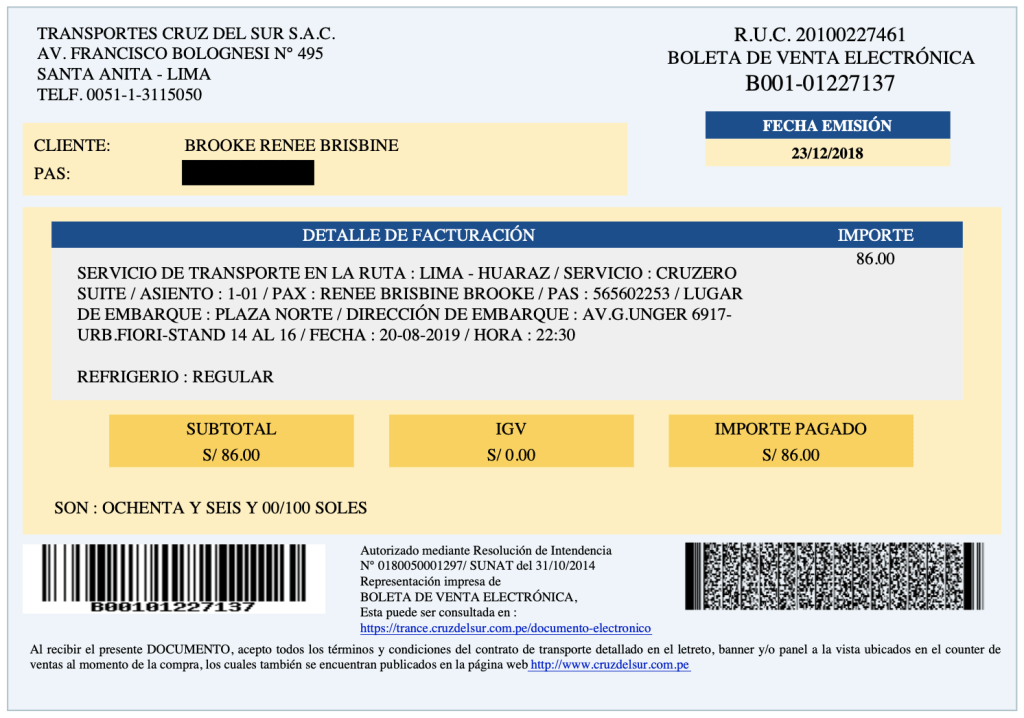
Getting to the Huayhuash Circuit
Starting in llamac.
The most popular starting point for the Huayhuash Circuit is the town of Llamac, just because it’s possible to take a public bus from Huaraz . According to the guidebook , this involves several steps:
- Catch a 5am El Rápido or Nazario bus from Huaraz to Chiquián (2hrs, S/10)
- Catch an 8am Nazario bus from Chiquián to Llamac or Pocpa (2hrs, S/12)
- Walk 12km along the road to the first campsite at Quartelhuain (4hrs)
Starting in Quartelhuain
To avoid an entire day of public buses and walking on the road, start instead at the first campsite in Quartelhuain (also called Cuartelwain or Matacancha on some maps). It’s not possible to get here with public buses, so it’s definitely not as budget-friendly an option, but it is so worth it to conserve energy for more exciting days to come.
To get to and from Quartelhuain (about 4hrs from Huaraz), we booked a private shuttle through High Summit Peru for $150USD. The owner of the company, Marco Reyes, is an incredibly experienced mountaineering guide— you might even see him out on the trail leading a trekking group like we did!— and his driver Jaime is the sweetest. It was 100% worth the additional expense to have flexibility in what time we departed Huaraz and, of course, to cut out walking on the road from Llamac, so I’d highly recommend booking a shuttle to Quartelhuain.

Huayhuash Circuit itinerary
The official Huayhuash Circuit trail offers a wonderful trekking experience, but often there are even better experiences to be had if you get off the standard trail and onto the ruta alpina (the higher, more scenic, and more remote alpine route) to explore lesser-seen gems of the Cordillera Huayhuash.
This is my exact itinerary (which even differed to my parents’), and I’d do the exact same route again in an instant. I’ve provided all the details of my itinerary below, including trail stats, daily highlights, campsites (more info in Campsites under Communities along the Huayhuash Circuit below), AND my favourite and highly recommended non-traditional variations to the Huayhuash Circuit that will pack in even more incredible scenery. Use it to inspire and plan your own itinerary or follow it closely, the choice is yours!
Day 1: Quartelhuain to Laguna Mitucocha
Distance: 9.1km Elevation gain: 685m Highest elevation: Cacananpunta 4,690m Trail hours: 5hrs Campsite: Wild camping at Laguna Mitucocha
- Rainbow of colours looking down into Quebrada Caliente from Cacananpunta
- Blaze your own trail to Laguna Mitucocha on the ruta alpina
- Wild camp on the lakeshore with amazing views of Jirishanca
Ruta alpina from Cacananpunta to Laguna Mitucocha: Rather than descend to the lake on the mule route, this is a higher, more scenic option that only adds about 30min of trail time.
Wild camp at Laguna Mitucocha: Instead of back-tracking through the valley to the official campsite in Janca, set up camp right on the shores of Laguna Mitucocha below towering Jirishanca. As you look at the mountain, the left side of the lake provides a slightly better vantage point, but the right side will get sun a full 90min sooner in the morning, so it’s a better option. As of yet, it’s not illegal to wild camp on the Huayhuash—pack in/pack out EVERYTHING when you wild camp and leave NO trace so you don’t ruin it for everyone else!
Read more: HUAYHUASH CIRCUIT (DAY 1): QUARTELHUAIN TO LAGUNA MITUCOCHA

Day 2: Laguna Mitucocha to Laguna Carhuacocha
Distance: 9.1km Elevation gain: 715m Highest elevation: High point below Jirishanca Chico 4,870m Trail hours: 6.5hrs Campsite: Laguna Carhuacocha
- Incredible view over Hidden Valley and Laguna Mitucocha ascending towards the high point
- Yerupajá and Siula Grande from Laguna Carhuacocha
Ruta alpina from Laguna Mitucocha to Laguna Carhuacocha: Rather than climbing over Carhuac through the Hidden Valley, this variation along non-existent trails is steeper, far more challenging, navigationally demanding, and about 3hrs longer than the traditional route— but really spectacular! You’ll rejoin the main trail just before camp.
Read more: HUAYHUASH CIRCUIT (DAY 2): LAGUNA MITUCOCHA TO LAGUNA CARHUACOCHA

Day 3: Laguna Carhuacocha to Huayhuash via Siula Pass
Distance: 14.8km Elevation gain: 820m Highest elevation: Siula Punta 4,830m Trail hours: 5.5hrs Campsite: Huayhuash
- Hike along the shore of Laguna Carhuacocha
- Climb the glacier moraine for views of Laguna Gangrajanca
- Amazing view of the Tres Lagunas and Jirishanca, Yerupajá, Siula Grande, and Carnicero from the mirador
- Conquer Siula Pass
Mule route via Punta Carnicero: This isn’t a variation I’d recommend, as it skips Siula Pass and the Mirador Tres Lagunas, but my parents took it when they were feeling sick and reported that it was surprisingly beautiful. If you can’t handle the brutally steep ascent up to Siula Pass, at least know that you’ll still enjoy wonderful alpine scenery on this hike, a worthy second-best option.
Read more: HUAYHUASH CIRCUIT (DAY 3): LAGUNA CARHUACOCHA TO HUAYHUASH

Day 4: Huayhuash to Viconga
Distance: 12.2km Elevation gain: 490m Highest elevation: Portachuelo de Huayhuash 4,770m Trail hours: 4hrs Campsite: Viconga
- Great views of the Cordillera Raura
- Hike around Laguna Viconga
- Relax in the boiling hot springs at Viconga camp and enjoy a cold beer with other trekkers
Read more: HUAYHUASH CIRCUIT (DAY 4): HUAYHUASH TO VICONGA

Day 5: Viconga to Cuyoc & Paso San Antonio
Distance: 14.3km Elevation gain: 1,270m Highest elevation: Paso San Antonio 5,080m Trail hours: 5hrs Campsite: Cuyoc
- Morning views of Nevado Puscanturpa
- Cuyoc glacier close enough to touch
- A fun side-trip and some of the best views of the trek from Paso San Antonio
Side-trip to Paso San Antonio: After arriving at Cuyoc camp and dropping your pack, you absolutely can’t miss an ascent of Paso San Antonio. If you’re a fast hiker, you can easily get to the top in 1-1.5hrs, but be warned that it’s insanely steep and the terrain gets really sketchy at the top. For the adventurous (and at your own risk), it’s also possible to scramble up the mountain on the left hand side of the pass for even better views of Siula Grande, Yerupajá, and Laguna Juraucocha below. The descent back to camp takes around 45min.
Read more: HUAYHUASH CIRCUIT (DAY 5): VICONGA TO CUYOC & PASO SAN ANTONIO

Day 6: Cuyoc & Paso San Antonio to Laguna Juraucocha
Distance: 13.6km Elevation gain: 1,300m Highest elevation: Paso Santa Rosa 5,060m Trail hours: 7.5hrs Campsite: Wild camping at Laguna Juraucocha
- Sweeping views of Siula Grande and Laguna Juraucocha from Paso Santa Rosa
- Descend towards the Quebrada Sarapococha
- Wild camp in front of the Jurau glacier
Side-trip to Paso San Antonio: If you didn’t get a chance to climb Paso San Antonio from Cuyoc camp yesterday (or if you’re super keen like me and want to go twice), you can also climb up for sunrise before hitting the trail. As I mentioned before, the ascent should take 1-1.5hrs and the descent is about 45min.
Paso Santa Rosa: Also called Paso Jurau, this high mountain pass offers incredible views of Siula Grande and Laguna Juraucocha. It is actually part of the traditional Huayhuash trail, but my parents and I were the only people who actually took this route from Cuyoc camp, all of the other independent trekkers and the guided group electing to hike out to Huayllapa instead. Let me just say that you’d be missing some of the best scenery of the entire trek, so don’t skip Santa Rosa! The ascent isn’t nearly as gruelling as San Antonio (although you will have a full pack on, but it’s worth the effort).
Wild camp at Juraucocha: Rather than trekking out to the official camp at Cutatambo, set up camp near Juraucocha at the base of the glacier. I’d recommend finding a spot behind the moraine so you don’t absolutely freeze to death at night, but the scenery is still wonderful. From this spot, you’ll be better situated to explore Quebrada Sarapococha tomorrow, one of the absolute best side-trips on the Huayhuash Circuit.
Read more: HUAYHUASH CIRCUIT (DAY 6): CUYOC & PASO SAN ANTONIO TO LAGUNA JURAUCOCHA

Day 7: Laguna Juraucocha to Rasac via Laguna Santa Rosa
Distance: 10.3km Elevation gain: 1,065m Highest elevation: Paso Rosario 5,090m Trail hours: 8hrs Campsite: Wild camping at the base of Rasac
- Explore Quebrada Sarapococha, the location of Joe Simpson’s basecamp during his famous and tragic ascent of Siula Grande
- Amazing views of Lagunas Santa Rosa and Sarapococha from Paso Rosario
- Wild camp right beneath Rasac
Quebrada Sarapococha: Ideally, you should spend an entire day exploring this incredible valley, climbing up boulders for better vantage points over Lagunas Santa Rosa and Sarapococha, Siulas Grande and Chico, and Yerupajá before ascending to Paso Rosario or Cerro Gran Vista for the ultimate panorama. This is definitely a lesser-explored area, so it’s unlikely you’ll see any other trekkers, but the reward for all the puzzling navigation and remoteness is truly unreal scenery.
Wild camp at Rasac: After descending Paso Rosario, trek up-valley to the base of Rasac, where it’s possible to wild camp in the shadow of the glacier. This was probably the best morning view we had on the entire trek.
Read more: HUAYHUASH CIRCUIT (DAY 7): LAGUNA JURAUCOCHA TO RASAC VIA LAGUNA SANTA ROSA & PASO ROSARIO

Day 8: Rasac to Huayllapa
Distance: 13.1km Elevation gain: 60m Highest elevation: Laguna Rasac 4,270m Trail hours: 4hrs Campsite: Omar & Flor’s in Huayllapa
- Early morning views of Rasac from the tent
- Peaceful hike down-valley to town
- Make some wonderful local friends in Huayllapa
Huayllapa: This little town (and I do mean little, it’s hardly more than one street) is only a short detour off the main trail, but I’d recommend stopping through even if just to get a snack from the local shop. The people in town are absolutely beautiful and we actually had a rather amazing encounter with some of the locals, which you can read about in my longer post on day 8 . If you do go, make sure to say hola to Omar & Flor from the Brisbine family!
Read more: HUAYHUASH CIRCUIT (DAY 8): RASAC TO HUAYLLAPA

Day 9: Huayllapa to Yaucha Punta
Distance: 16.3km Elevation gain: 1,585m Highest elevation: Yaucha Punta 4,850m Trail hours: 8hrs Campsite: Wild camping at Yaucha Punta
- Early morning sun on Tapush after leaving Huayllapa
- Walk through flocks of sheep around Huatiaq
- Trek around beautiful Laguna Susucocha
- Camp beneath condors and high peaks at Yaucha Punta
Wild camp at Yaucha Punta: I wouldn’t ordinarily recommend camping at a high mountain pass, but we pitched our tent just on the other side of Yaucha Punta out of necessity and found that it made a splendid and scenic campsite. It sets you up for a long final day, but also ensures that you get the magical morning glow on the mountains as you walk along the ridge to Cerro Huacrish tomorrow.
Read more: HUAYHUASH CIRCUIT (DAY 9): HUAYLLAPA TO YAUCHA PUNTA

Day 10: Yaucha Punta to Quartelhuain via Rondoy Punta
Distance: 21.7km Elevation gain: 915m Highest elevation: Rondoy Punta 4,750 Trail hours: 6hrs
- Incredible views and condors sightings at Cerro Huacrish
- Beautiful trail around Laguna Jahuacocha
- Panoramic views from Rondoy Punta onto a huge icefall
- “Close the loop” at Quartelhuain!
Yacha Punta to Incahuain via Cerro Huacrish: Rather than take the mule route down into Incahuain camp, add just 10min to your trek and follow the ridgeline to Cerro Huacrish for infinitely better views.
Incahuain to Quartelhuain via Puntas Sambuya & Rondoy: Skip the boring traditional exit out to Llamac by tackling 2 high mountain passes above Jahuacocha. The route is probably about 1hr longer than the trek through Pampa Llamac and into town, but the views are incomparable. My parents hiked out to Llamac and reported that the descent was positively brutal and seemingly unending, so it’s not really appealing from any angle. If you need to finish the trek in Llamac, you can walk back along the road (3-3.5hrs), but a better option is organising transport from Quartelhuain (allow 40min to walk here from the trail junction).
Read more: HUAYHUASH CIRCUIT (DAY 10): YAUCHA PUNTA TO QUARTELHUAIN VIA RONDOY PUNTA

Community tickets on the Huayhuash Circuit
Communities along the Huayhuash Circuit
Community fees.
A ticketing system was implemented a few years ago on the Huayhuash Circuit— you need to pay a small fee to each community as you pass through their land (irrespective of whether you stay at their campsite). Officially, there are 9 communities whose fees are approximately S/25 each, but in reality, you might miss paying for a few tickets based on your exact route and whether the cobradores (ticket sellers) are out and about. Plan to bring S/250 in cash and this should more than cover your fees .
When you pay each cobrador , you will receive a small ticket which includes the name of the community, the date, and sometimes also your name. Keep this ticket safe , as you may be asked to present it later to prove that you’ve paid (you will pass through a couple communities twice on the circuit and also through some checkpoints). Here are the exact fees I paid in August 2019 (you’ll notice many have changed since the trekking guidebook was published), as well as the location of the cobradores :
- Llamác S/30 : paid along the road to Quartelhuain, even if you are in a shuttle (we paid through the window at a road gate)
- Pocpa S/15 : paid at Quartelhuain camp
- Queropalca S/40: the cobrador is actually at Janca camp, but will come to Laguna Carhuacocha camp the following day and you can buy a ticket if you missed it previously (if you were camping at Laguna Mitucocha, por ejemplo )
- Quishuarcancha S/30 : paid just after crossing the swing bridge out of Laguna Carhuacocha camp as you head towards Siula Pass
- Huayhuash S/30 : paid in the morning at Huayhuash camp
- Viconga S/20 : paid in the morning at Viconga camp
- Huayllapa S/40 : paid along the trail about an hour before Huayllapa
- Cutatambo S/10 : this is the only fee we missed, so I can’t 100% confirm the location, but I assume it was at Cutatambo camp
- Pacllón S/20 : paid at Gashpapampa camp

There are 12 official campsites on the Huayhuash Circuit, each operated by one of the 9 communities who look after the trail. All have flat ground for pitching a tent, a water source (varying from taps to nearby flowing water), and some sort of toilet facility — and pretty much nothing else.
There’s no cost associated with using these campsites, since you’ll pay the community fees regardless of where you sleep, but they are usually in a nice spot and offer a good opportunity to mingle with other trekkers. Here’s a look at the available campsites along the Huayhuash Circuit:
Quartelhuain
Quartelhuain camp is super windy, but there are flushing toilets, so there’s definitely something to celebrate. You’ll buy your first community ticket here even if you aren’t camping.

Janca (Laguna Mitucocha)
The official camp near Laguna Mitucocha is actually 20min off the lake shore, so I’d recommend pitching a wild camp closer to Jirishanca. You’ll miss buying your community ticket at camp, but it’s possible to purchase it the following day at Laguna Carhuacocha camp.

Laguna Carhuacocha
This is a beautiful campsite set right on the lake overlooking Yerupajá and Siula Grande. Actually, there are two campsites, but I’d recommend staying at the first one, since the second seemed a bit busier with trekking groups. There’s only a measly squat toilet here, but there’s a tap for water and the scenery more than makes up for the poor facilities.

Another scenic camp under tall peaks, Huayhuash camp has 2 blocks of nice toilets and taps for water. Again, there are two sites located right next to each other, but the first is usually for independent trekkers (and small groups). You’ll purchase a community ticket in the morning from camp.

Perhaps the best camp of all, Viconga has 3 hot spring pools, including one for washing clothes and for bathing off the dirt and grime of the previous 4 days. There is a river running through camp that provides water, flushing toilets, and even a man selling cold beer and Coca Cola. Buy a community ticket in the morning.

Cuyoc camp has a nearby river for water, plus a little block of flushing toilets. Make sure you make the epic side-trip up to Paso San Antonio!

Instead of camping at Cutatambo (a further 30min away), I’d recommend setting up shop on the nearby shores of Laguna Jahuacocha, as this spot sets you up better for exploring Quebrada Sarapococha the following day. Position yourself behind the moraine to avoid icy wind off the glacier at night.

There’s a little campsite in Huayllapa with good facilities, but I’d recommend staying more local. While travelling through Huayllapa , we got to know an extremely beautiful family who truly went above and beyond to take care of my stepmum during a bad situation. It was their dream to open a hostel, and amazingly they emailed my stepmum just recently to say that her donation (of just $150USD) allowed them to build the toilets they needed, plus put in a patio out front and paint the exterior of the house. They’ve named one of the rooms in their new hostel “The Brisbine Room”, so now it is MY dream that someone reading this blog post will go hike the Huayhuash Circuit, visit Huayllapa, stay in “The Brisbine room” at Omar and Flor’s , and give them a little more than the S/10 ($3USD) they are charging per bed. I guarantee it will be a highlight of your trek.
Read more about Omar & Flor and our time in Huayllapa in this post: HUAYHUASH CIRCUIT (DAY 8): RASAC TO HUAYLLAPA

There are 2 Huatiaq campsites, both with similar facilities, including a toilet block and river access for water. The camps are about 5-10min apart, so just choose whichever is less crowded.

Gashpapampa
The is a nice, flat camp just on the other side of Laguna Susucocha. There are unappealing squat toilets and also river access for water.

Incahuain is an absolutely gorgeous campsite on the shores of Laguna Jahuacocha. There were quite a few people here, but enough room that it didn’t seem at all crowded, plus abundant water access and ample opportunities for a chilly swim (!!).

Cerro Huacrish
What to expect on the trail
If you haven’t already figured it out, the Huayhuash Circuit is navigationally demanding, especially if you’re hoping to take any of the high alpine detours or side-trips that I’ve recommended . There were days on this trip where, even with a map , guidebook , GPS, and two very experienced mountaineers for parents, we spent about 90% of the day looking for the trail . This is nothing like hiking in the Alps, where there are signs with time estimates at every junction, beautifully graded trails, and plenty of other trekkers you could ask for directions if you were really confused— I counted just 2 signs on this entire circuit, spent more time contouring along the hillside in what we hoped to be the general direction than actually on a trail, and went full days without seeing other humans.
The point is: you need to be a confident navigator if you want to set off on this trek alone and you really should have multiple means of navigating. I’d recommend carrying the guidebook (pages 152-174) , a full map , and a GPS with you on the trail. Yes, all three are absolutely essential! And even fully prepared, expect to do some confused wandering and a lot of guesswork. This means good common sense and some mountain experience is also pretty important.

Far from well-graded, the trails on the Huayhuash Circuit are very rugged, often covered in scree or loose dirt, and typically STEEP. Expect lots of slipping and sliding around, which means hiking boots with high ankle support and trekking poles really are essential.

Especially when you get off the main trail and onto the ruta alpina , it’s also extremely likely that you’ll be doing some bush-bashing, trail-blazing up the side of a rough hill, or even scrambling over large rocks . This is all part of the adventure, just be prepared to go off-piste and get your hands dirty once in a while.

High-altitude
For a high-altitude trek like the Huayhuash Circuit, where you never really step below 4,000m and you frequently ascend above 5,000m, you’ll notice the lack of oxygen in the air right away. For most people, this means you’ll be out of breath on the trail, you won’t have a very big appetite, you’ll need to pee more frequently, and you’ll have some difficulty sleeping . I probably moved a little slower than usual, but I thankfully didn’t experience any of these other symptoms— thanks to LOTS of acclimatisation!
Beyond the normal response to elevation, some people also experience altitude sickness, and the risk on this trek is pretty high . “Altitude sickness” includes Acute Mountain Sickness (which can be mild to moderate in severity) and High-altitude Cerebral/Pulmonary Oedema (both of which can be fatal)— it’s incredibly important to understand the risks, take appropriate preventative measures, and know what to do if you do become unwell on the trail. I wrote a super detailed post on high-altitude trekking that I would recommend reading— it will give you heaps of information on recognising and treating altitude sickness, plus what you can do to prevent it.
In brief, the most important things you can do on this trek to minimise the risk of serious altitude-related health complications are to:
- Acclimatise: I mentioned this previously, but it bears repeating that acclimatising properly before beginning your trek is probably the single best way to prevent altitude sickness on the Huayhuash Circuit. This should include at least a few days in Cusco or Huaraz, plus some high-altitude day-hikes.
- Ascend slowly: You shouldn’t try to climb too many high-altitude passes in a single day or gain a lot of elevation super quickly. Both the itinerary I described in this post and the one proposed by the trekking guidebook split up the ascents into reasonable chunks. There’s a reason for this!
- Camp low: The placement of campsites along the Huayhuash Circuit make it easy to follow the “climb high, sleep low” principle, so this isn’t too big of a concern.
- Understand altitude sickness: Again, it’s so important to recognise the symptoms of altitude sickness and respond quickly. Sometimes it’s as simple as descending to a lower elevation until you feel better, but other situations will also require medication or evacuation. Severe altitude sickness can be fatal within 24hrs, so it is no joke. Read my post about altitude sickness for heaps of detail on recognising and treating altitude sickness.
- Pack altitude sickness medication: No one ever plans to develop life-threatening altitude sickness, but it’s vital to be prepared, just in case. See a doctor and get a prescription for Acetazolamide, Dexamethasone, and Nifedipine before your trip. I found that my doctor knew very little about altitude sickness medication, so I did a lot of research in medical journals to find the appropriate dosage. It might be a good idea to read this post prior to seeing a doctor so you can discuss the information with them.
Read more about altitude sickness: HIGH-ALTITUDE TREKKING: A COMPLETE GUIDE TO PREVENTING & TREATING ALTITUDE SICKNESS IN THE MOUNTAINS

All official campsites along the trail have some sort of water access, be it a river, lake, or even just a running tap, but none of this water is clean or safe to drink without filtering first . Boiling water before cooking will obviously make it potable, but I’d recommend packing a filtered water bottle or some other type of filtration system for your drinking water on the Huayhuash Circuit. You’re never more than a few hours from a water source, so you don’t have to carry too much in your pack, either.
Food & other supplies
Aside from the cold beer and Coca Cola sold at Viconga camp, the only place on the Huayhuash Circuit to replenish food and supplies is in the little town, Huayllapa. Most trekkers will hit this around day 6-8 of their journey. There’s no fuel for stoves here, but there are snacks and drinks available from a little shop and hot meals made to order.
If you’re super strapped for space or weight, you could pack just enough food to get you to Huayllapa and do a complete restock here , but know that there definitely isn’t any dehydrated mountain food, so you’ll be carrying heavy, bulky items. Still, it’s probably lighter than carrying 10 days of food from the outset, but we decided we’d rather play it safe and pack things we knew we could fill up on rather than rely on snacks.

Many years ago, a young hiker was robbed at gunpoint and killed on the Huayhuash Circuit, leading to the conclusion that this area just wasn’t safe for independent trekkers. In the decades since, the local community has done a lot to restore safety to this area, though, and there’ve been absolutely no incidents in recent years. This is thanks in part to the 9 communities along the trek, who have assumed responsibility for looking after the trail and those on it. It’s impossible to say that nothing bad will ever happen on this trail again, but the Huayhuash Circuit felt completely safe during my trip, regardless of whether we were staying at designated camps with other trekkers or camping entirely on our own.
Far greater than the threat of robbers is Pachamama , whose constantly-changing weather and unpredictable trail conditions can make for a challenging trip. Under no circumstances should you embark on this trek without a well-stocked first aid kit, a good knowledge of mountain survival, and a PLB (Personal Locator Beacon). Both of my parents have had to be med-evac’d off a summit in recent years, and that means we as a family are really conscious of the fact that, even for experienced mountaineers, accidents can happen .
Particularly in the remote Andes where you can go days without seeing other humans, carrying a PLB could be the difference between life and death. We carried an InReach , but there are cheaper options with fewer features that will do an equally effective job in an emergency. Just make sure your model works in Peru— AND that you have good travel insurance that covers medical evacuation.

Snacks for the Huayhuash Circuit
Packing list for the Huayhuash Circuit
Considering that you need to be prepared for below freezing weather, rain or snow, and medical emergencies, plus carry all of your camping equipment, clothing, personal items, and food for 10-days over 5,000m mountain passes, packing smart is a big deal on this trek. The name of the game when packing for the Huayhuash Circuit is less, lighter, smaller .
Try to keep that in mind as you write your own packing list— where you’d ordinarily bring 2 or 3 shirts, por ejemplo , just bring one, and where you’d usually pack a hiking towel, go without. Even with substantial cuts to my normal hiking list, my pack still weighed in at 18kg and my dad’s at 28kg, so leave the non-essentials at home to avoid a backpack you can’t even pick up.
For a super detailed packing list for the Huayhuash Circuit, check out this post: SOLO HUAYHUASH CIRCUIT PACKING LIST: WHAT TO PACK FOR 10 DAYS WITHOUT A GUIDE
- 50-70L backpack
- Filtered water bottle
- Trekking poles
- 3-season tent
- Sleeping mat
- Sleeping bag (rated to -10C or better)
- Camping pillow
- Camp stove + fuel
- Bowl, cup, and cutlery
- Huayhuash guidebook (scan and print pages 152-174)
- iPhone with GAIA GPS app and Huayhuash maps downloaded
- InReach PLB
- Breakfast food: I like Cup of Soup or tortilla soup and hot chocolate or tea. This was a great way to get both salty foods and a heap of water into my system before hitting the trail, since dehydration is a real concern on high-altitude treks.
- Lunch & snack food: Try calorie-dense foods like beef jerky, nuts, salami, cheese sticks, fruit leathers, and trail mix. If you want to go a little light on the snacks, you can replenish your supply about 2/3rds of the way through the hike at Huayllapa.
- Dinner food: Lots of dehydrated mountain food; my favourite brands are Packit Gourmet (USA) and Outdoor Gourmet Company (AUS). Bring some variety, but also make sure to pack things that you know you’ll like. It’s common to experience loss of appetite and even some stomach upset at altitude, so the best way to ensure you’re actually eating is to bring your favourites! For us, that meant a LOT of spicy queso dip and Fritos (if you’re not hiking with chips and dip, you’re doing it wrong).
More about the exact food I brought in my detailed packing post: SOLO HUAYHUASH CIRCUIT PACKING LIST: WHAT TO PACK FOR 10 DAYS WITHOUT A GUIDE
- Short sleeve sport top (just one!)
- Thermal for camp
- Lightweight fleece
- Mountain jacket
- Wind jacket
- Down jacket
- Rain jacket
- Tights or hiking pants (just one pair!)
- Fleece tights for camp
- 3x hiking liners and wool socks (sleep in compression socks and a pair of clean wool socks until the last few days, when you’ll have to sleep in dirty wool socks)
- Compression socks
- 10x undies and 1x sports bra (keeping in mind that you’ll wear a bra and undies into the hot springs)
- Warm beanie
- Warm gloves + outer waterproof mittens
- Sturdy hiking boots
- Sandals for camp
Personal items
- Toothbrush + toothpaste
- Body wipes (mountain shower)
- First aid: ibuprofen and naproxen for headaches/inflammation, immodium for diarrhoea, KT tape and bandaids, alcohol wipes, etc
- Altitude sickness meds: Acetazolamide, Dexamethasone, Nifepidine (read more about when and how to use these medications in this post)
- Toilet paper
- Hand sanitiser
- Camera + spare batteries + Capture clip
- Powerbank + charging cables
- Lightweight dry bag for electronics
- S/250 per person for community fees + any additional cash for snacks in Huayllapa

Read more about the Huayhuash Circuit
HIGHLIGHTS FROM 10 DAYS ON THE HUAYHUASH CIRCUIT
SOLO HUAYHUASH CIRCUIT PACKING LIST: WHAT TO PACK FOR 10 DAYS WITHOUT A GUIDE
HUAYHUASH CIRCUIT (DAY 1): QUARTELHUAIN TO LAGUNA MITUCOCHA
HUAYHUASH CIRCUIT (DAY 2): LAGUNA MITUCOCHA TO LAGUNA CARHUACOCHA
HUAYHUASH CIRCUIT (DAY 3): LAGUNA CARHUACOCHA TO HUAYHUASH
HUAYHUASH CIRCUIT (DAY 4): HUAYHUASH TO VICONGA
HUAYHUASH CIRCUIT (DAY 5): VICONGA TO CUYOC & PASO SAN ANTONIO
HUAYHUASH CIRCUIT (DAY 6): CUYOC & PASO SAN ANTONIO TO LAGUNA JURAUCOCHA
HUAYHUASH CIRCUIT (DAY 7): LAGUNA JURAUCOCHA TO RASAC VIA LAGUNA SANTA ROSA & PASO ROSARIO
HUAYHUASH CIRCUIT (DAY 8): RASAC TO HUAYLLAPA
HUAYHUASH CIRCUIT (DAY 9): HUAYLLAPA TO YAUCHA PUNTA
HUAYHUASH CIRCUIT (DAY 10): YAUCHA PUNTA TO QUARTELHUAIN VIA RONDOY PUNTA
brooke brisbine
I've spent the last decade exploring the world— everything from solo trekking in the Andes to overlanding in Zambia, all while completing a PhD in Biomechanics, teaching at a university & securing permanent residency in Australia. In 2020, I finally fulfilled my dream of becoming a full-time nomad! Whether it’s vanlife in Mexico, scuba diving in the Galápagos, ticking off incredible US National Parks, or climbing in the Dolomites, I hope this blog will inspire your future adventures & help you find wonder in every corner of the globe. xx bb
Leave a Comment Cancel Comment
The comments.
Thanks for the guide! It was very useful for us when planning our hike. Sharing a few tips we learned and might be useful: 1. For getting to the Huayhuash we found a good balance of saving money and time by taking the bus to Chiquian and the a taxi to Quartelhuain from there. The taxi then cost 200 soles. We were lucky enough to have it shared between 4 people, making it very reasonable. 2. Viconga now has hot meals for lunch (we had rice and lentils) and wifi. 3. Perhaps not a *good* tip, but if needed (or just tired) one can get off the trail at Huallapa. There’s a combi leaving to Cajatambo at 6:30am, and from there one can take a bus to the coast and then to Lima/Huaraz. Overall it took us 14 hours to get back to Huaraz like that.
Thank you so much for sharing some alternate transport options and updated info for the trail!
Happy trails 🙂 xx bb
Roberta dos Santos
Hi, Brooke! It was the most complet post I saw about de Huayhuash Trek and I loved it. I’m going to do this Trekking all by my self alone (woman solo backpacking) at 23/August and I would like to know if you could share that image of the map your dad made of the Huayhuash Circuit that appears in your report (because I don’t have that book you indicated available for my country – Brazil). Could you? It would help a lot because it’s my first backpacking to a cold place (I’m from Amazônia, a really hot region) and I’m little scary lol.
Hey Roberta! I am SO sorry for the slow reply, I think I missed sending you that map before you set off for your trip!
I hope you had a fantastic time and managed to find a copy of the map I recommended when you arrived in Peru?
Happy trails xx bb
Thank you for the detailed (& inspiring!!!) description of the trek! I’m planning on going solo end of March this year and was wondering whether you could share your GPX route for the trail – I’ve found quite a few alternatives online, but I like your route description the best and would be great if I could stick with it 🙂 Would you recommend bringing a satellite communication device (like Garmin inReach or the like) for going solo to be able to communicate with friends & family or are there a few spots throughout the hike with mobile connection? I’ve done quite a few solo treks in remote locations, but none this challenging (high altitude) so I imagine my family would feel a bit calmer if the heard from me every now and then. Also, I know March is considered end of raining season but you’ve repeatedly mentioned how cold you were – when did you go & what kind of sleeping bag did you bring (mine’s at 5 to -10 degrees, considering whether I’d need a better one). Sorry to bother with all these questions and thank you again for this amazing blog!
I am in the process of putting together detailed GPX tracks for all of the backpacking routes I’ve written up on my blog, let me see if I can get that Huayhuash one out sooner rather than later so you’re able to use it to plan your trip!
I ABSOLUTELY recommend bringing and In-Reach– honestly, you should not hike alone without one in mountains like these. My route in particular takes you off the beaten path and I went days without seeing other humans, mobile reception was non-existent, and an accident would have been fatal without an SOS device, so please take one with you! Added bonus of being able to get weather reports and send check-ins to family 🙂
I went in August with a -8C bag– the temp doesn’t fluctuate much throughout the year, so expect it to be very cold whenever you go. It is honestly the coldest trip I have EVER done, still to this day. I ate dinner almost every night in the tent because I simply couldn’t sit outside. If you also get cold, consider packing a liner that will add some heat to your existing bag.
Hope that helps & don’t hesitate to ask future questions, always happy to help, especially fellow solo female adventurers 🙂
i. a stay at Siula Grande base camp instead of Laguna Juraucocha which involves a chilly wade across a stream but is pretty magical – this could be a variation;
ii. I trotted down all the downhill sections on the last day, was well acclimatized and used to run for GB and just managed to do it in 6 hours, so, I think it would take most people 9 hours, not the 6 which you recorded. There is a risk of people missing transport links out if they try to do it in your speedy 6 hours.
iii. Turismo Nazario on +51 990298650 will do transport to and from any trailhead to/from Huaraz or Chiquian
Thanks for the additional information, Andrew! And good note about the times posted here– you followed my alternate route exactly?? I know for sure I wasn’t running on any sections of this trail, so I wonder if we did a slight variation and that’s where the time discrepancy comes from? Nonetheless, great to note for those who are scheduling a hike out.
Aaron Jobson
Thanks for the great information Brooke. Just completed a 6 day hike in the Huayhuash and referenced your post a lot in the planning. We ended up getting a pretty good storm even in June and returned to Huaraz from Huayllapa. Fortunately we followed your recommendation and booked transportation with Marco and High Summit Peru. He saved us Snead all around amazing as you said. He says to say hi!
Hey Aaron, definitely a bummer about the storm, but I am SO happy to hear Marco was able to help you guys out, he’s truly the best guide in the area!
Hi all. Just to comment about doing it out of season. I did it in February, the worst month for weather. And it was doable! Definitely lost out on views sometimes and it rained most afternoons – making it cold! But we saw no other trekkers and still had fun! Just a heads up for anyone who can’t choose when they are in Peru!
Thanks so much for sharing, Ollie! It’s great to hear that the Huayhuash still holds up out of season– I spent December trekking in Peru several years previously and, despite the rain, I still wouldn’t trade the trip for anything.
Very valuable information. I do it in July. Will I get camping gas for a tourist stove in Huaraz? Is there freeze-dried food in Huaraz? Regards
Hi Marcin, you can definitely find fuel, food, and all variety of backpacking/camping gear for sale in Huaraz!
Happy trails, xx bb
I’ve been looking for this sort of comment for days! I think I’m gonna do it next February/March, it’s when I wanna get away from London and when I’m the least busy with work, so my only option really…But I wasn’t sure it was doable So besides of the weather, is support available in terms of camping sites/ transportation/ any logistical help? I’m thinking to do it solo and without guide, but just in case…
This blog is so amazing and helpful! Just want to update that the community fees have increased a lot since 2019. I would bring S/300 per person just for the community fees. You can ask a travel agency in Huaraz for updates on how much the total trek will cost you. And don’t forget to be respectful and leave no trace so hikers can continue independently enjoying the route 🙂
Thanks so much for the update, Jill! So glad to hear you enjoyed the trek.
Did you happen to take notes on the new amounts– I’d love to update this post with current pricing!
Happy trails 🙂
Jack Pendleton
Planning on doing this independently this July… Can I rely on AllTrails to be my map and GPS? That’s what I use for all my treks I’ve done before and I’ve mapped out a good route for Huayhuash, but can GPS signal be relied upon there? Many thanks for any advice.
GPS signal is reliable– I used Gaia a few times on this hike (although I like it far less than Alltrails).
You might find that your map doesn’t perfectly line up with all the trails you’ll see on the Huayhuash, though, as a lot of these paths are worn by animals and infrequently trafficked by people, in particular along the Ruta Alpina (which I’d HIGHLY recommend hiking wherever possible, as it’s far more scenic). Bring the paper map as well and prepare to do some route-finding in spots, but Alltrails should certainly help.
Happy trails! -Brooke
François Lechasseur
Did you do your trip? I’m thinking to do that trip too and I would like to know if we can use All Trail. Did you hire a guide? How many day did you take to complete the 130 Km?
I’m from Canada
Charles Van Cauwenberghe
Thanks for your additional good advice! After getting the Alpenvereinskarte we really can’t wait for our trip to start. About Paso San Antonio being dangerous, is that why you ascended it as a side trip and actually crossed Santa Rosa on the next day? Also; passing Rosario pass seems like quite the adventure (the route is not even mentioned on the map :p). And a final (for now :D) question: Would you recommend, as the final day of the trek, to go towards Cuartelhain or Llamac?
Hi Charles, no worries at all, happy to help 🙂
That’s exactly right, Paso Santa Rosa (also called Paso Jurau) is not as steep as Paso San Antonio and is widely considered to be the better option. After trekking up to San Antonio as a side trip and looking down the brutal scree field on the other side, I can’t imagine descending. I suppose some people do, not knowing that Santa Rosa is a better alternative, but I would not recommend it, nor did the mountaineering guide I met on the trail. I was actually the only person of the guided group and independent trekkers who even went up San Antonio and the following day my family were the only people to cross Santa Rosa, all the other hikers taking an easier route out to Huayllapa.
Yes, Paso Rosario was a definite adventure! Even if you don’t go over Rosario, I highly recommend exploring the Quebrada Sarapococha–it was one of the most spectacular spots on the entire trail and we had it entirely to ourselves. Camping beneath Rasac on the other side of the pass was also a real highlight for me!
As for the hike out, I’d make a strong case for Quartelhuain. Now, there is no public bus from here, so if that’s how you’re hoping to get back to Huaraz, it might not be the best option, BUT if you can organise private transport, the hike out to Quartelhuain is a million times nicer. I did the high route over Rondoy to finish in Quartelhuain while my parents opted for the easier route straight down to Llamac, and they reported that the descent was awful and unrelenting. The scenery over Rondoy was amazing, I didn’t see a single other hiker the entire day, and I got to complete the circuit fully back to my starting point– so I’d recommend Quartelhuain 🙂
Thank you for what is probably the most elaborate and exciting guide i’ve read so far on solo-trekking the Huayhuash circuit. Me and a friend of mine are relatively experienced in high altitude solo-trekking (mainly in Central Asia, so we are used to spend 50% of our time actually searching for the trail). I do have one question (at the moment :p); Is the ‘Ruta Alpina’ variation indicated on the Alpensvereinskarte or do we need to do additional research on this (and other) variations from the classic route?
Thanks again for your great guide!
Hi Charles, thanks so much for the message!
“Elaborate and exciting” is everything I aspire to be, so obviously this is one of the best compliments I’ve received on the blog!
The Ruta Alpina trails are shown on the Alpensvereinskarte and sometimes described in the guidebook, as well as shown on most GPS maps of the Huayhuash. It’s great that you have off-piste experience, though, because it is HARD to find the route even with a map, book, and GPS app (what I like to call “all the gear and no idea”). It’s the combination of there being (a) a lot of trails to begin with, (b) zero signs or cairns, (c) local foot traffic from farmers and mules that disguises the correct path, (d) erosion, (e) etc etc etc.
Given how little there is out there on the Huayhuash Circuit, it will be challenging to do too much advance research on the route (beyond what’s in this post or in the guidebook). My best advice would be to lay out a loose idea of the trek, even looking at the map to find interesting alternate routes, but then MAKE SURE you speak to a local mountaineering guide to confirm that the route is feasible. There are some passes that are technically passable– Paso San Antonio, por ejemplo — but any local mountaineer would tell you DO NOT descend because it’s wildly unsafe and neighbouring Paso Santa Rosa is better.
There’s a great B&B in Huaraz, Casa de Maruja– the owner is a mountaineering guide and he will happily look at your trekking plan with you to offer advice before you set out. We also met a mountaineering guide along the trail and asked some advice as our plans changed– he confirmed it was safe for us to go up and over Paso Rosario. You seem to know what you’re doing so I probably don’t need to say this, but yeah, it’s just a good idea to speak to someone who’s done what you’re trying to do, since there are some seriously challenging spots in these mountains.
Happy trails to you, and let me know if you have any other questions! -Brooke
You May Also Like
Buen apetito: a delicious cooking class with skykitchen peru in lima, vanlife diaries #42: la ventana, ensenada de muertos & cabo pulmo national park, baja mexico, ausangate & rainbow mountain trek (day 2): anata to hanchipacha via rainbow mountain.
The Partying Traveler
Survival of the littest.

The Complete Guide to Trekking Peru’s Cordillera Huayhuash
Peru’s Cordillera Huayhuash is the adventure that trekkers could only dream of. As an avid hiker and chaser of views, trekking the Cordillera Huayhuash circuit was something that had been on my bucket list for years. When I left Peru at the end of my first backpacking trip, I couldn’t help but feel a deep regret that I hadn’t allowed myself enough time to visit the northern part of the country . When the opportunity opened up to head back down to South America, I promised myself that I wouldn’t let the opportunity pass by again.
As I took those final few steps towards the village of Llamac on the final day of the trek, I couldn’t help but shed a few tears. The Cordillera Huayhuash was among the most challenging yet rewarding feats that I had ever accomplished. There were plenty of moments along the way that made me question my sanity and my capabilities. Step by step, I pushed forward. Step by step over 140 kilometers, across grueling high-altitude mountain passes, battling the sizzling sun, blustering winds, and shivering through every night and every morning. Step by step, we survived.

The Cordillera Huayhuash is one of the best things you can do in your life. It is yet another testament to the incredible diversity that Peru offers. For those of you who manage to make it up to Huaraz , it is a no-brainer whether to do the Cordillera Huayhuash or not. Here is everything you need to know about this once-in-a-lifetime adventure.
How To Prepare For The Cordillera Huayhuash Trek

Preparing Physically For The Cordillera Huayhuash Trek
The Cordillera Huayhuash is no walk in the park. You also don’t need to be an ultramarathon runner to be able to do it, but there is no denying that it will be a lot easier if you are in good physical shape. Unlike other touristy activities, this is not something that you can just impulsively decide to do. You should have experience with trekking beforehand and be aware of your capabilities and limitations. In the midst of a lengthy multi-day trek is not when you want to realize that you done screwed up.
There are a number of hikes in Huaraz that you can do to help yourself acclimatize and build up physical strength and endurance. At the very least, doing four of the following should help you prepare and gauge your fitness levels.
Laguna Paron
Laguna Paron is a good first acclimatization hike. At 4,200 meters above sea level, it is much higher than the city of Huaraz and is just below the average altitude that you will be dealing with at the Cordillera Huayhuash. The hike itself is quite short and easy, making it a good starter hike. It is less than 2 hours round trip from the parking lot to the viewpoints at the top. Anyone can do this hike, but if you find yourself breezing through it, then it is a good sign that you might be ready for the Cordillera Huayhuash.
Laguna Churup
This was the very last hike I did before taking on the Cordillera Huayhuash and it was one hell of a confidence boost. After three weeks of trekking around the Huaraz area, I found Laguna Churup to be quite easy. It takes you up to 4,450 meters above sea level but by this point, the altitude did not bother me at all. I was able to cruise through this hike. I definitely would not be able to say the same had I started with this hike, though.
This is one of the most challenging day trips you can do from Huaraz. Although I felt absolutely awful after struggling my way through this hike, I felt invincible the following few days. As far as day treks go, Laguna 69 will be the best indicator for whether or not you are ready for the Cordillera Huayhuash. If you can do Laguna 69 without any difficulty, then you might be okay for the Cordillera Huayhuash. There are at least three days I can think of on the Huayhuash Circuit that are significantly more difficult than Laguna 69.
Nevado Pastoruri
While the quick trip to the Pastoruri Glacier isn’t much of a hike, it does take you to about as high as you will be along the Cordillera Huayhuash. The glacier sits at around 5,000 meters above sea level. I did this following Laguna 69 and knocked out the hour-long hike in about thirty minutes. If the altitude doesn’t bother you here, then there is a good chance that you will be okay with most of the Cordillera Huayhuash.
Nevado San Mateo
Nevado San Mateo was the hardest thing I did before taking on Huayhuash. At 5,150 meters above sea level, requiring crampons, ice axes, and in the midst of a blizzard atop the mountain, Nevado San Mateo was unlike anything I had ever dealt with before. I had no idea what I was getting myself into when I agreed to go, but I conquered it nonetheless. It was a good reminder just how much more difficult something like Huayhuash could be if conditions were anything short of perfect.
4-Day Santa Cruz Trek
While not a day trip, taking on the Santa Cruz Trek is probably the best way to gauge your readiness for Huayhuash. It is only half the duration of Huayhuash’s eight days but it gives you a good introduction to sleeping at high altitudes, camping in a tent, and the overall grind of a multi-day trek. The highest point you reach on the Santa Cruz Trek is at Punta Union, which sits at about 4,750 meters above sea level. You will go up to 4,750 meters or higher about 5 or 6 times during the Cordillera Huayhash trek. I wouldn’t say it’s a good indicator for whether or not you are physically ready, but it is definitely a good introduction into what you will be living like for eight days.
You never truly feel ready for something like the Cordillera Huayhuash. Looking back, all of these small preparations added up. Had I gone into the Cordillera Huayhuash without properly preparing, it would have been exponentially more difficult. All of these made a difference. Each hike was like a mini-boss before taking on the final boss battle.
Preparing Mentally For The Cordillera Huayhuash
When it comes to an 8-day trek, you need to be as prepared mentally as you are physically. They go kind of hand-in-hand, as the more physically prepared you are, the more mental confidence you’ll have. But it is more than just confidence. It is mental fortitude and the willpower to keep going despite the challenges you face.
Within my group, my two close friends and I seemed to have the most problems. Food poisoning, bad blisters, twisted ankles, and a brutal cold made our time significantly more difficult. The three of us were a shining example of powering through adversity. My German friend had never gone on a trek like this before, and after renting boots that gave him blisters after the first day, he ended up finishing the trek in tattered Nikes. On one of the days, he did not take a single break throughout a 1,300 meter elevation gain. Despite being one of the slowest in our group, he was relentless. Mental fortitude.
At the end of the day, it’s just one foot in front of the other, over and over again. From your first steps at Cuartelhuain to crossing the finish line at Llamac, it is just walking. Or at least, try to think of it that way.
How To Find A Trekking Group For Cordillera Huayhuash
Spending eight days alone in the wilderness can be both dangerous and lonely. Although I love hiking alone, I definitely felt more comfortable going with a group, especially with friends that I knew beforehand. Depending on your style of travel, it may or may not be easy to find a group to do Huayhuash with. As a backpacker who frequents hostels and other highly social establishments, it did not take long for me to gather a group.
However, everyone has different schedules and plans would often fall through. At one point, I managed to put together a group of six people who were keen to take on the trek. After a few days of rain, three of them backed out. We scraped together another two people at the last minute and managed to book a tour together as a group of five, lowering the costs significantly than if we had booked alone.

Booking and Planning The Cordillera Huayhuash Trek
One of the hardest things about going on an 8-day trek with an agency is figuring out which agency is the right one. I spoke to a handful before deciding to trust the tour operator that had arranged a few of my other trips in Huaraz. We ended up being put together with a group from Huayhuash Expeditions, and I have nothing but glowing things to say about them as a company. And no, I didn’t get a free or discounted trek from them or anything.
As far as booking goes, there is no need to plan too far in advance. We booked and paid for the trek the day before we actually left. Of course, preparations were happening in the days leading up to the trek but there was never a rush or necessity to book the trek that far in advance. If you are planning on doing the Cordillera Huayhuash without a trekking agency, then you can basically just leave whenever you feel like you’re ready. Here’s how to get to the Cordillera Huayhuash from Huaraz on your own, which involves a bus to Llamac and hours of walking to the first campsite at Cuartelhuain.
When Is The Best Time Of Year To Do The Cordillera Huayhuash Trek?
The rainy season in this part of the country begins in late September and ends in late April. The ideal time of year to take on the Cordillera Huayhuash is during the dry, winter months between May and September. It is possible to still get great weather on the shoulder months of April and October as well. I did the Cordillera Huayhuash in late October when the rainy season had already started. We had rain on the first two days before having perfect weather for the final six days. The weather in the mountains can be a crapshoot, so you might be extremely fortunate or extremely unlucky no matter the time of year.
I did the Cordillera Huayhuash again a few years later, this time in June during the dry season. The weather was mostly perfect, but we still had some short stretches of rain. However, it was also noticeably colder than the first time I did the Huayhuash trek in October. The dry season also happens to be winter in Peru, so while you might avoid rain, the days are a little shorter and the nights can be absolutely freezing.
The rainy season is at its peak from November to March. While some agencies will still offer the trek, the demand is definitely lower around this time of year. Because of this, it will be more expensive and more difficult to find daily departures for the expeditions. Of course, if you are going it alone, then the Cordillera Huayhuash is open at all times of the year.
And before you go, make sure you have good travel insurance handy while you’re off adventuring across the world. I use SafetyWing to keep me covered throughout my travels for as low as $40 a month.
What To Bring On The Cordillera Huayhuash
Doing cordillera huayhuash with a trekking company.
If you are doing the Cordillera Huayhuash through a trekking company, they will likely cover most of the essentials for you.
What they will provide:
- Sleeping Bag and Sleeping Mat
- Breakfast, Lunch, Dinner, Snacks
- Donkeys to carry your stuff
That is typically the bare minimum, but some trekking agencies will go above and beyond.
- Emergency oxygen
- Coca leaves
- First aid kits
- Water filters or water pills
Which leaves you to bring
- Warm clothing (down jacket, waterproof pants, jumpers, etc)
- Winter clothes (gloves, hat, socks, thermals, etc.)
- Hiking boots (I rocked this fantastic pair of Oboz boots )
- Spare shoes for hanging out at camp
- Extra snacks or water
- Bag for the donkeys
- Travel medical insurance
- And camera, duh. (I shoot with a Nikon D5600 )
Doing Cordillera Huayhuash On Your Own
You’ll need to bring everything, which is a daunting task for an already daunting trek. If you have a lot of experience with wilderness backpacking, the Cordillera Huayhuash is more than doable on your own. Just remember, if anything were to happen, you will be days and days from civilization at some points of the trek. Don’t forget to bring cash to pay the locals as there will be places where you’ll need to pay fees to cross the land.
I’m not saying that one way or the other is better, but unless you bring all of your own gear to South America, it might be just as cheap to go with a trekking agency, and having all the logistics taken care of for you.
Cordillera Huayhuash: Day By Day Guide

Day 1: Let’s Have Some Fun!
- Trekking Distance: 0 kilometers (if starting in Cuartelhuain)
- Trekking Time: 0 hours (4-5 hours if starting in Llamac)
- Altitude Gain: 1100 meters + (all driving)
- Campsite Altitude: 4,200 meters
- Mountain Passes: 0
- Difficulty Level: 0/10
This is the calm before the storm. If you are doing the trek with an agency, there will be no trekking today, as they drop you off directly at the first night’s campsite. It takes about six hours to drive from Huaraz to the start of the Huayhuash circuit so by the time you get there, there won’t be much daylight left for trekking. Usually, the groups will leave Huaraz at around 9 AM. There is a quick lunch break at a small town just before you reach the Cordillera Huayhuash. Usually, you will arrive at the campsite in the mid-afternoon at around 3 PM. If you have booked with a trekking company, then camp is already set up for you. Take the next few hours to chill, hang loose, and get to know your trek mates.
The long drive will have you itching to get going but take it slow today. Try to use today to practice your breathing and find a rhythm with the altitude. Mentally prepare yourself for the next seven days of trekking however you need to. Meditating, a bit of yoga, or nothing at all. Today will feel like the day before a very long Christmas. It might be hard to sleep with all of the excitement but keep in mind that the 5:30 AM wake up call will come sooner than you think.

Day 2: Chasin’ Some Views
- Trekking Distance: 18 kilometers
- Trekking Time: 7 hours
- Altitude Gain: 1100+ meters
- Mountain Passes: 2
- Difficulty Level: 6/10
Here we go. The first actual day of trekking. Your legs are fresh and you can finally release all of that energy stored up from the bus ride yesterday. You are going to need all of it because guess what, we’ve got two mountain passes ahead of us. That may seem daunting but most of the incline is very gradual with a lot of flat ground in between. The first mountain pass came surprisingly quickly and most of the group was able to reach it with relatively little struggle.
Between the first and second pass, there will be a lot of downhill and flat ground. The views so far are not anything to gawk at but it is beautiful nonetheless. Eventually, you’ll reach a little shack where the guides will have to pay some sort of entrance fee to the local people hanging around.

From here, the ascent to the second mountain pass begins. The short break here got to me a little bit as I struggled with the initial incline towards the second pass. However, the second pass came along really quickly as well. I don’t think anyone even realized we were at a mountain pass because it didn’t feel or look like one at all.
It is a long day and you cover a lot of ground before getting to the second campsite. But once you get to the second campsite, oh boy. This is one of the most scenic campsites of the entire Huayhuash trek. We had rain and fog for most of the first day until we reached the campsite. Then everything started clearing up and we were blessed with a sunset to remember. The view of the mountains reflected in Laguna Carhuacocha right next to camp is a sight I will never forget. This alone would have made the Huayhuash trek worth it, but there is so much more to come.

Day 3: Feelin’ Wild and Free
- Trekking Distance: 16 kilometers
- Altitude Gain: 600 meters
- Mountain Passes: 1
- Difficulty Level: 8/10
Day three of the Cordillera Huayhuash is one of the most beautiful days of the entire trek. Day two took you to the foothills of the snow-capped peaks of the Cordillera Huayhuash. On day three, you actually delve deep into the mountains. Today takes you to incredible viewpoints overlooking stunning glacial lagunas and one of the most epic mountain passes of the entire journey.
Day 3 starts off pretty easy. You walk along the lake that you spent the night next to, with the terrain being mostly flat, if not a bit squishy and swampy. It stays mostly flat until you reach the foot of a laguna. From here you can take a quick 15 minute detour up to a mirador overlooking the first glacial laguna of the day. This view is epic, and you’ll likely spend a solid 20-30 minutes here. Take it all in.
View this post on Instagram you seeing this shit A post shared by eli solidum | 📍 mexico 🇲🇽 (@thepartyingtraveler) on May 17, 2020 at 8:55am PDT
Once you head back down, the real challenge begins. For me, this was among the hardest inclines of the whole trek. Just one foot in front of the other nonstop up a mountain for what feels like forever. This incline is steep and there is not a single stretch of flat ground to provide relief for your burning legs. Holding back the caboose of the pack were me and my Israeli trekking mate, who kept saying aggressively inspirational things like “In the army, I learned that if it doesn’t kill you, you can keep going.” So we did.
You finally get a brief break at the Mirador de las Tres Lagunas. This is the only respite in the steep and steady incline up to Paso Siula at 4,800 meters. But what a view for a lunch break. The Mirador de las Tres Lagunas is one of the most iconic views of the entire Cordillera Huayhuash. It’s easy to see why.
Once you get up to Paso Siula, the descent begins. We had a dance party up here to celebrate. In hindsight, I wish I abstained from dancing so hard had I known just how much further we had until camp. This descent felt like it took forever, despite how much fun our group was having. With 5 Israelis in our group (and the self-proclaimed partying traveler , of course) it was no doubt going to be a party. We pretty much danced the entire way down to the Huayhuash campsite (4,300 meters) before feasting on lunch and relaxing before what is definitely the toughest day of the entire trek.

Day 4: My Legs Are Sore
- Trekking Distance: 20 kilometers
- Trekking Time: 8 hours
- Altitude Gain: 1300+ meters
- Difficulty Level: 10/10
Another day, another mountain pass. But wait, there’s more! Tack on another mountain pass. That’s right, we’ve got two grueling mountain passes today. The fourth day of the Cordillera Huayhuash is arguably the hardest day of the trek, taking you up to 5,041 meters above sea level. The El Trapecio Pass is the highest point of the entire trek. It is also one of the most surreal, providing views unlike anything you’ve seen thus far in the trek.

It almost feels like something you would find along Patagonia. There are swarms of glacial lagunas that seem like puddles from the viewpoint you’ll get at the pass. It comes out of nowhere, as one minute you are trudging along the rocky terrain and as soon as you turn the corner, you catch a marvelous and unforgettable view. This part of the trek really drives home just how desolate and inhospitable this region is. As the symbolic halfway point of the trek, you are also likely as far away from civilization as you’ve ever been, with the nearest city now a full four days away.

The descent down to the campsite is one of the rockier terrains you’ll encounter along the trek. As difficult as the Cordillera Huayhuash is, the trail is never too challenging. It is always well-marked and pretty easy to walk on. Not today. Lots of rocks and your feet and knees will take an absolute beating on the descent. There are plenty of beautiful photo opportunities and stops to take a break, though, so you can take it slow today. But not too slow because…

After a quick lunch break, you will be going back up to 5,000 meters. This time, there will be no easy stretches or any flat ground. You will be going up 600-700 meters in the span of about 90 minutes. However, this is one of the most iconic views of the entire Cordillera Huayhuash. Take your time but whatever you do, don’t skip it. It might be tough to drag yourself up here after the exhausting El Trapecio Pass just hours before but you aren’t going to want to miss this.
Today is the hardest day. There’s no doubt about it. It is also the most jaw-droppingly beautiful. Also no doubt.

Day 5: Just Tryna Survive
- Trekking Distance: 15 kilometers
- Trekking Time: 4 hours
- Altitude Gain: -900 meters
- Difficulty Level: 3/10
Today is a breath of fresh air in the midst of a very long dive. After a challenging few days, we finally have what could be considered an easy day. The fifth day is entirely downhill, although it comes with the compounding sense of guilt and worry as you can’t help but think ahead. What goes down must come up, after all.

Our group breezed through this day, wrapping up at around 11 AM. It took us under four hours to crush the 15 kilometers of distance. That included plenty of time for snacks and breaks. The terrain starts flat before the descent comes into play. It gets rocky and steep as you descend alongside a stunning waterfall then it flattens out again until you reach the village of Huayllapa. In Huayllapa, you can relax and stock up on snacks and sweets. One can even take a “hot shower” for 4 soles.
Consider today to be the calm before the storm. You’ve gone down from 4,350 meters to just under 3,500 meters. And tomorrow? You’ll be going back up to a 4,800 meter mountain pass. If my math ends up being correct, then…
Day 6: Today Sucks Dicks
- Trekking Distance: 13 kilometers
- Trekking Time: 6 hours
- Difficulty Level: 9/10
I don’t really need to say much more than that. After the easy day yesterday, it is back to the grind. In the span of about four hours, you climb back up to 4,800 meters from your campsite down at 3,477 meters. On the bright side, the first couple of hours are at a significantly lower altitude than what we’ve been trekking at so far. I felt completely superhuman during the first hour or so, zooming ahead of the group for the first time all trek.
Then, I got distracted by a cute Quechua child asking for chocolate. The group caught up. So did my brutal cough that I picked up back on day four. Once I got back up to 4,200 meters or so, my lungs started getting punished by the altitude yet again. Eventually, I was having to stop every minute or so because of coughing convulsions that were significantly made worse by the altitude. Despite this, we still reached the mountain pass in about 4 hours, with me at the caboose.
There is no denying that today is one of the most difficult days of the entire trek. However, after this, it’s pretty easy cruising. Just put one foot in front of the other over and over again. My friend who struggled with blisters and the altitude a lot along the way literally did not stop once on this day. The mental fortitude of that guy… The rest of us would take breaks and even though he started the day off way behind us, he tortoise and the hare -d his way to the finish line without stopping. Keep a steady pace and remember, just one foot in front of the other over and over again.
Once I arrived at the mountain pass, I told the guide to go ahead down to the camp while I took in the view for a while. This mountain pass isn’t anything stunning but there’s nothing quite like relishing in one’s accomplishments while staring at the conquered trail behind you. The way down the campsite is stunning as well, with gorgeous mountains and even more surreal landscapes.

Tonight’s campsite was far from my favorite, made even worse by the late afternoon rains that dampened our clothes as well as our spirits.
Day 7: Almost Heaven
- Trekking Distance: 16 kilometers + 4 km with laguna
- Altitude Gain: 500 meters + 100ish with laguna
- Difficulty Level: 5/10
You’d think by day seven, you’d have seen all there was to see. Or at the very least, what would have impressed you on day one probably won’t impress you anymore. Following the unreal views on day four, I didn’t think it could get any better. However, day seven gives the rest of the trek a run for its money. There is no comparing the diverse views along the way but day seven was easily one of the most enjoyable days of the trek for a number of reasons.
After day six, you feel like you can conquer everything. The morale of the group had never been higher. I had no doubts that I could do day seven with ease so I was actually able to take it slow and focus on the views instead of focusing solely on surviving. Today feels like a walk in the park. As far as the ratio goes between difficulty and rewarding views, day seven is a relatively easy day with a plethora of jaw-dropping views.
Once you cross the mountain pass, you walk along mostly flat or downhill ground to catch an epic mirador. From here, you can see your campsite for the night along three lagunas. This stretch boasts some of the most panoramic views of the entire trek. You can see everything, everywhere. Condors flying overhead, glacial lagunas in the distance, the snow-capped mountains blanketed in wispy clouds… It feels like a movie. Except it’s real, baby.

Once we got to the mirador, I went into full chill mode. There was no more uphill, camp was within view, and nothing was stopping me from doing absolutely nothing but sitting and taking in the views. Seriously, take it all in.
It only takes about an hour to get down to the campsite from the mirador. Walking into camp felt like crossing the (almost) finish line of a marathon. Both of us had pushed ourselves to beyond what we thought we could achieve and absolutely crushed it. The adrenaline even allowed me to go on another quick side trip to Laguna Yerapaja, a turquoise glacial laguna that was one of the most beautiful I’d seen along the way. A perfect ending to an unbelievable trek.
Camp tonight is at 4,000 meters and is one of the most beautiful of the entire trek. Again, take it all in. You only Huayhuash once.

Day 8: We did it, mates.
- Trekking Time: 5 hours
- Altitude Gain: -700 meters
- Difficulty Level: 2/10
Well, here we are. The final day. It is all downhill from here, literally and figuratively. As you leave the Huayhuash range in the dust behind you, it is nothing short of bittersweet. While every second of actual trekking might feel like a lifetime, the actual eight days themselves will fly by. Although I thought I would be missing civilization, cell signal, and partying by the time those eight days were up, I felt like I could have stayed in these mountains forever. Life was simple out here and I was living without a care. But those eight days did come to an end.

Day eight is arguably the easiest day. The trail is entirely downhill or flat and the terrain is easy to walk on, for the most part. You’ll be walking along a cliffside for most of the way before descending down into the valley where Llamac is located. It is definitely bittersweet taking each step closer and closer to the end of the Huayhuash trek. You’re on the home stretch of this high altitude, high difficulty marathon and you’re only minutes away from being able to say you absolutely f*cking crushed it.
It’s almost impossible to describe the feelings I had as I reached Llamac. I mean… I’d never done anything like this before. I didn’t even know if I could do something like this at all. I spent months preparing physically and even on the first day, I still didn’t think I was ready. But here I was, at the finish line. Despite the blisters, despite my cold, my exhaustion, my cough, my headaches, my inner mental battles and everything else. I was there, and in desperate need of a shower, as all conquerors tend to be.
The Cordillera Huayhuash is an experience of a lifetime. Don’t second guess yourself. As soon as I arrived at the start of the trek, I began to wonder why I ever debated doing it in the first place. There’s no debate. Do it.

Follow Me On Instagram
If this post helped you out, show some love and support for the blog and help keep my adventures going by buying me a beer ! My adventures are entirely self-funded, so any show of support is greatly appreciated, and allows me to keep writing helpful travel guides and creating travel content to help you all travel the world on a budget.
More on peru:.
The Backpacker’s Guide to…
- Chachapoyas
- The Sacred Valley
The Best Things To Do In…
- Ollantaytambo
- Best Day Trips From Cusco
Where To Stay In…
- The Best Hostels in Peru
Attraction and Destination Guides
- Cordillera Huayhuash
- Salkantay Trek
- Vinicunca Rainbow Mountain
- Palccoyo Rainbow Mountain
- Colca Canyon
- Floating Islands of Puno
- Pisac Archaeological Site
- The Backpacker’s Crash Course Guide to Peru
- 14 of the Most Epic Day Hikes in Peru
- 20 Must-Visit Destinations in Peru
- The 8 Best Party Cities in Peru
Share this:
13 thoughts on “ the complete guide to trekking peru’s cordillera huayhuash ”.
What an experience that must’ve been! I would love to visit Peru one day!
Wow! What a stunning collection of photos and I for sure need to see Peru! I am loving the gorgeous photos of Cordillera Huayhuash and will have to add that to my bucket list for sure as the breathtaking landscapes are amazing! What a once in a lifetime place to see…so pretty. Thank you for sharing as I had not heard of Cordillera Huayhuash before your post 🙂
Peru is definitely on my radar…I would love to climb it soon, that would be an amazing experience.
Wow, I had to stop at each photo and admire it for the longest time. I don’t think I would have left Cordillera Huayhuash if I was there, just too beautiful. Thank you for sharing all you know about this wonderful place and how to trek it
The photos are incredible and stunning…Peru is truly a breathtaking place to visit. What an incredible journey you experienced.
8 days is such an accomplishment! You should be so proud of yourself.
Looks like it was quite an amazing hike out there. Certainly something you would need to prepare yourself for before you went.
Dude! Bitchin experience! Looks insane!
This is amazing and Peru is on my list of places to visit for sure. It is actually 2nd on my list of places to visor right behind Australia and I love the idea of trekking Peru’s Cordillera Huayhuash! So pretty and an experience of a lifetime!
Oh my goodness! Thanks for the very detailed experience and story dear. This story is amazing. If I go on hiking and trekking one day even if it’s not the same spot I might consider these tips.
That looks like a beautiful hike! You got some really amazing pictures on that hike!
This trek looks insane. Can’t believe I’ve never heard of. Following you on Instagram now brother!
[…] kilometers of high-altitude trekking through the remote Peruvian Andes. Need I say more? The Cordillera Huayhuash circuit draws adventurers from far and wide to the mountain town of Huaraz, only to take another six hour […]
Leave a Reply Cancel reply
Discover more from the partying traveler.
Subscribe now to keep reading and get access to the full archive.
Type your email…
Continue reading

- What’s In My Bag
- How We Afford Our Travel Lifestyle
- Tools and Resources
- Safety When Traveling Solo (and Female)
- United States
- South Korea
- Switzerland
- United Kingdom
- Georgia (Republic)
- South Africa
- Turkmenistan
- Solar Power Setup For Van Living
- Shop Jack and Jill Travel
- Must Have Travel Accessories Under $25
- Books Around the World
- Unconventional Gift Ideas
- Top Adventures
Huayhuash Trek, Peru: Everything You Need to Know
When we were planning our trip to Peru, Jack and I decided that if there was one trek we were going to do in Peru, it was going to be the Huayhuash Trek . Even though it had some ‘I swear this is the last trek we’re doing!’ moments – looking back at it, we’d do it again in a heartbeat. The Huayhuash Trek was definitely worth the time and money. We think it’s the most underrated trek in Peru (if not the world). It’s still one of the best and most memorable hikes we’ve ever done. And we’ve done so many.
I’ve spent some time thinking of the best way to tell our 10-day adventure on the Cordillera Huayhuash – and decided that a Q&A way is the best way to go to share with you guys about the highlights and lowlights of the Huayhuash Trek .
I have to admit that some of these are very tangentials but hope you enjoy reading them none the less.
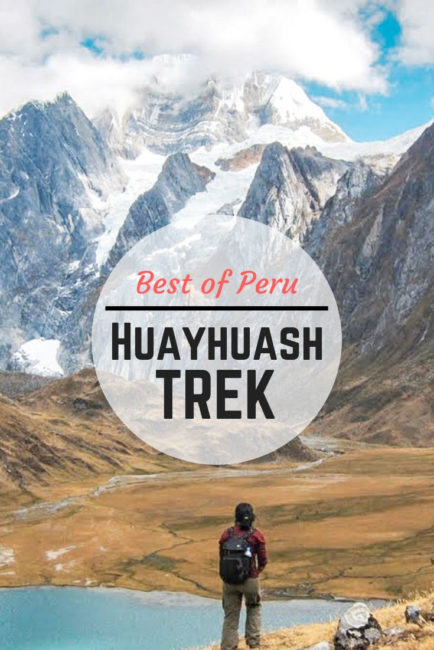
Facts on Huayhuash Trek
- The Huayhuash trek is 180 km (112 ml) long and can be done from as short as 8 days to as long as 14 days. We’ll be doing it in 10 days.
- For its (relatively) compact size, Cordillera Huayhuash packs a punch. It has 30 peaks, 6 of them are over 6000 m.
- We’ll be going over 8 passes – all of them between 4600m – 5000m in altitude, most of the walking will be done over 4000 m in altitude.
- The Huayhuash goes around the Cordillera Huayhuash, Peru, which is next door to its more famous cousin: Cordillera Blanca.
- All of the trek is over the treeline and because of that the sceneries promises to be spectacular.
- The mountain range contains Siula Grande – a mountain that became the background of the harrowing story of Simon and Yates in ‘ Touching the Void ‘.
- During the 90’s, the mountain range was rarely visited due to an active terrorist presence by a group called ‘Sendero Luminoso’ or ‘Shining Path’. After a trekker was shot and killed by the rebel, the Peruvian government closed the area for several years.
- We’ve been warned against not only of the danger of altitude sickness, but also of aggressive dogs who’d run after you on the trail, and then steal your food from the campsite.
Our newfound friends.
Jack and I have done some multi-day treks before, but Huayhuash Trek will be the first trek we’ve done…
At such a high altitude (4000 – 5000 m) Oxygen will be a rarity. Considering that I got sick when climbing Mt. Whitney (at 4500m) I’m a little worried. We’d have been in Huaraz (3000 m) for a week and will have done some day hikes at around 4000m – but it’s still mostly be a crapshoot how your body will react to such an altitude.
Fortunately coca leaves (known to help prevent altitude sickness) are neither illegal or rare in this part of the world. As of a matter of fact, many trekkers drink tea out of coca leaves throughout the day to help dealing with altitude.
Where we’re going to have a guide and donkeys All the treks we’ve done in the past were done independently. But due to a combination of altitude, length and lack of own gear we’ve decided to get an agency for Huayhuash. That means having donkeys to carry our stuff, a cook, and a guide. So all we have to do is walk. Tsk, should be easy enough, right?
There are those who are of course doing this trek independently, carrying everything on their back and existing solely on protein powder to save weight — now they’re hardcore (read: slightly mental).
Where our meals won’t consist of re-dehydrated rice and ramen day after day I imagine there would be days when the promise of a hot meal at the end of the day is what would keep us going. A promise of a hot AND non-ramen meal AND we don’t have to cook it ourselves? Gosh, we’re getting spoiled here!
Huayhuash Trek map
Read: What’s In My Adventure Backpack
Our Huayhuash Trek experience
- Was the Huayhuash Trek worth it?
Starting point of the trek?
- Can you do Huaraz Trek independently?
- How can I do the Huayhuash Trek?
Can anybody do the Huayhuash trek?
- How much did the trek cost?
Which agency did we go with?
How did you find the group and the agency, how was the food quality and quantity, on the mountains, how many hours do you walk per day.
- What was a typical day is like during the trek?
Did you sleep well?
- What did you do when you’re not walking up and down mountain passes?
- What did you think about when walking?
What was the hardest days on the Huayhuash Circuit?
Did you get to see amazing sceneries every day, what’s your favorite scenery, how many times did you end up going #2 on the trail, you talk a lot of bathroom and #2 here. why, most memorable character you encountered during the trek.
- What was this about being peed by a dog?
- What was this about killing a sheep?
- Do you have tips on trekking the Huayhuash Circuit?
Should I visit Huaraz? Should I do the Huayhuash trek?
First, was the huayhuash trek worth it.
Ah, such a difficult question to answer. See, it all depends on your own past experience. Was it worth it for us? YES. Yes, it was. We do enjoy being around mountains and we started to think that we’re a little masochistic as well.
We saw some amazing scenery – definitely some of the best we’ve seen in our lives. For us, it was worth it not only for the scenery, but like other endeavors that push your limit, it was worth it for the sense of accomplishment as well.
Beautiful sceneries abount on the Huayhuash Trek
How much did the Huayhuash Trek cost?
It came down to about $40 a day (so for 10 day – it was $400). Which is on the higher end of things. You can definitely go with a cheaper agency – as cheap as half the price.
But I’d like to think that the higher price means that the staff are being paid well and the donkeys are treated humanely. And that we wouldn’t have to worry about sub-par equipment and running out of food.
The nearest town to the trailhead is Huaraz in Northern Peru, an 8 hour bus ride from Lima. Peru has some of the best long-distance bus companies: Cruz del Sure and Ormeño are the 2 companies we’ve used and recommend. Huaraz is a backpacker/outdoor friendly city and you’ll be able to find everything you need to start your Huayhuash adventure. We recommend acclimatizing yourself for a few days by doing day hikes from Huaraz before setting off to do your trek. Laguna Peron and Laguna 69 are some of the most popular day hikes from Huaraz that you can do to get yourself a little taste of what’s coming 🙂
Getting a group together for the Huayhuash Trek turned out to be more difficult than we thought. They don’t go as often as the Santa Cruz trek (more popular and shorter treks).
2 gringo cafes in Huaraz: Cafe Andino and California Cafe have a community board with posts from people who want to form a group. Through this and LP’s Thorn Tree Forum we managed to get a small group together and formally formed a group with Huascaran. Other people joined afterwards.
We knew that we wanted to go with either Huascaran Adventure or Quechuandes – 2 agencies that came highly recommended and received the least number of complaints (according to South American Explorer). We decided to go with Huascaran because a person in our group has just come back from the a trek with them and had nothing but good things to say about them.
But we also chatted to the people from Quechuandes and they seemed to be running a pretty solid company there. I wouldn’t hesitate to have gone with them either.
2 days come to mind. The first was what I believe to be either the 4th or the 5th day – it was one of the steepest climbs we had to do. (I alluded to this on the previous post) But on top of that…
Jack hadn’t had any sleep in 2 days – and I was battling a shy colon and 2 days worth of… well, you know. And did I mention the altitude? We were hiking above 4000 m in height where even a walk out of the tent to pee at night would leave us gasping for breath.
The second hardest day was the one day we did 2000 m in elevation changes. That’s right. 6000 ft in one day. In the morning we climbed down 1000 m, and in the afternoon we climbed up 1000 m. PAINFUL.
No. I’d say the best sceneries were found on the first 2/3 of the trek. And I guess after that we just became a little desensitized to the sceneries around us (which was still amazing – but relatively less so.)
This is tough one. We’d say the most memorable one was a very short side trip to an lake covered with floating ice pieces.
It was the setup that took our breath away – a short but steep scramble up a hillside and there lies unexpectedly and unseen from below a lake of turquoise color with a glacier fed waterfall on one side, snow-covered peaks in the background and hundreds of little ice plates floating on it.
Breath taking.
Just another breathtaking scenery on the Huayhuash Trek
What was a typical day is like?
Around 6:30 in the morning, Epy – our guide – would wake us up with his signature ‘Buenos dias, matecito de coca…’ – and handed us a cup of coca tea and a bowl of hot water to wash ourselves to start the day.
We’d groggily drag ourselves out of our frost-covered tent (a daily occurence) to do our morning ablution and pack our sleeping bags.
Breakfast varies from delicious cheese omelette to grey watery sludge that the Brits like to call ‘porridge’. During breakfast, the staff breaks down our tent and start loading the donkeys. Then around 8 am or so we’d start walking until around 1 pm, then lunch and a siesta. At this point the donkeys carrying our stuff and the rest of the staff would pass us on their way to our next camp.
Then a couple of hours more of walking. Arrive in camp (between 2 – 4pm) – and relax. Play cards and socialize with fellow trekkers.
We tend to go to bed soon after the dark (because it gets really cold) – like around 8 pm. Repeat.
On average we did about 7-8 hours of walking every day.
Surprisingly yes. Surprising because Jack and I usually are bad tent sleepers. We get cold easily.
We were provided with a down jacket, an inflatable air mat, and a regular foam mat. Some of the tents were 4-season tent with solid wall throughout – so it does get quite warm inside.
Tip: we’d fill up our Nalgene bottle with hot water right before we go to bed just for that extra ‘oomph’ in comfort.
Obviously we can only talk about our experience with Huascaran, but we were happy with what was provided.
Example breakfast: oatmeal, omelets, pancakes with hot chocolate, coffee and/or tea. Example lunch: ceviche, fried rice, potato salads. Example dinner: soup for appetizer followed by entrees such as lomo saltado (stir fried pork), spaghetti, chicken stew, and then dessert.
Every morning we were given a snack bag that contains a piece of fruit, and 2 pieces of chocolate bars or cookies.
They gave you the same amount of food regardless whether your’re a weightlifter or a 90-lb supermodel. So if you tend to run hungry, I’d suggest bring extra foods. We weren’t starving but we weren’t swimming in leftovers either. Some people in the group got sick and lost their appetite so the other trekkers get to eat their shares. Maybe they were counting on that?
The same thing applies for snacks. If you’re not into junk food, bring your own stash of dried fruits and nuts.
We stopped at a village to get some potatoes that they proceeded to cook with heated stones, buried underneath straw and dirt.
Q: What did you do when you’re not walking up and down mountain passes?
Not much really. We played countless of ‘shithead’ (it’s an actual card game – I’m not making it up) and talked about bowel movements (as you do).
On day 5, our campsite happened to have a natural thermal bath that most of us didn’t fail to take advantage of. I can easily imagine this bath to have the prettiest natural setting of any baths out there.
And oh, and we practiced coordination as a group so we could take pictures like this:
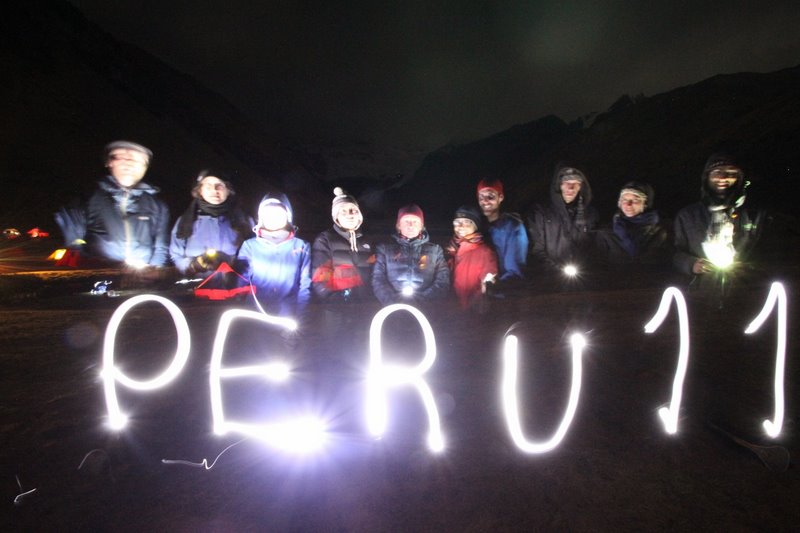
Morning frost
What did you usually think about when walking?
Jill – most of the times I zone out and just focus on breathing and pacing myself out. Usually I accidentally kick a rock every 15 mins or so that would yank me out of my zen – this was usually followed by about 30 secs of cursing or so. Funnily enough I only do this with my right foot (the kicking – not cursing. My right boot is more worn out then my left).
Jack – I thought about pizzas and beer mostly. I think starting from about day 7, this was what pretty much everybody in the group had in mind based on our conversations.
Oh gawd, too many to count unfortunately. I really hate going to the bathroom free-styling it off the trail. See, back in the states there are all sorts of rules of how and where to go to the bathroom in the wilderness. Here – you can practically go anywhere and however you want.
And people did. Behind every rock of convenient size, you’ll find traces of previous trekkers’ bathroom habit – dirty toilet paper and more. Nobody digs a hole or anything. I hate feeling that we’re contributing to the mess.
But when you’ve got to go, you’ve got to go.
Quoting a fellow trekker who was suffering from a bout of diarrhea – ‘There’s nothing worse than feeling that every step you’d take, you’ll end up shitting yourself’.
It’s weird but it does seem that you put a bunch of trekkers together, the coversation topic invariably would include bathroom habits and gems such as ‘burps that smell like poo’. It’s sort of understandable considering that altitude sickness and stomach problem were two of the main causes of illness among trekkers.
7 out of 10 within our group were affected by stomach issue during the Huayhuash Trek.
Vomit the Dog. Who, what? Well, one person in our group spent a couple of nights vomiting outside the tent – fortunately, one of the dogs that hung around the site happened to be nearby to lap it all up. Thus the name.
Despite his gross habit, Vomit was the happiest dog I’ve ever seen and charmed the socks off of everyone in our group. If you read this post and decide to do the Huayhuash trek, do keep a look out for him (we’d love to hear about how he’s doing!). He hangs out in the last campsite before exiting to Llamac (second to last day).
Vomit the dog kept us company for some time. He was our mascot for awhile and we were all so sad when we had to say goodbye to him.
Q: What was this about being peed by a dog?
Humpy (guess how he got his name) – another campsite-roaming dog – was not too happy that I was playing around with Vomit and decided that he’d mark me as his in the only way a dog would know. Yep, that’s right. I got peed on by a stray dog.
I didn’t even realise it until much later. However flattered I was that a dog was getting jealous of me, it wasn’t a pleasant feeling (to put it mildly) wearing a pee-covered jacket for the rest of the evening.
Thankfully it happened during the second to last day of our trek so I didn’t have to deal with it for too long. And a good thing too it was a rental.
And killing a sheep?
The group decided to buy and butcher a sheep for a Pachamanca feast (Pachamanca refers to a Peruvian style of baking using hot stones) during the last day of the trek. That was the first time Jack and I had ever witnessed a mammal being killed. It turned out to be more traumatizing than I’d like to admit really.
Of course it didn’t help that we named the sheep. The fact that we named him ‘Tasty’ is besides the point.
If we can do it, anybody can. We’re not the world’s biggest couch potatoes, but neither are we that kind of people who walk around talking about how they survived solely on protein powder for 2 weeks and battling polar bears while backpacking the Artic Circle .
The one thing to remember is to acclimatize well. Can’t seem to stress this enough. Spend a couple of days in Huaraz (or a week like we did) and do some day hikes to the nearby lakes.
General tips on trekking in Huaraz
- Acclimatize well.
- Check your equipment beforehand. Jack and I rented our sleeping bags and jackets from Huascaran and were pleased with them. A person in our group wasn’t so lucky and his rental sleeping bag has lost all of its insulating power and slept cold most of the nights. Or bring your own.
- Sleeping liner When I rent sleeping bags, I always use a sleeping bag liner (like this one ) for extra warmth, also for the ‘ick’ factor.
- Layer well. I love my Smartwool mid-weight baselayers in combination with a synthetic midlayer, and a puffy. A beanie, a Buff neck warmer , and gloves if needed.
- Insist on having an emergency horse (cheaper agencies might not include this). One person in our group ended up being so sick and ended up riding the horse during the toughest day of the hike.
- Don’t go with the cheapest agencies. They’re known to pay the staff horribly. We’ve heard stories about groups running out of food or subsisting solely on bread and crackers. As we were leaving, we came across a group at the trailhead who had to turn back to Huaraz after waiting for 2 days because their donkeys and guide never showed up.
- Bring wide spectrum antibiotics. For those stomach bugs – the second most common problem among trekkers in the area after the altitude sickness.
- Bring a pack of dried coca leaves and a first aid kit. Chewing on coca leaves help with altitude sickness even though they taste really gross. Also don’t count on your guide on having a well-stocked first aid kit (or know the proper way to administer them).
- Bring a pack (or two) of cards and learn some group card games. Not that I didn’t enjoy ‘shithead’ but after day 5 – I started wishing that somebody knew some other card game to play.
Can one do Huayhuash Trek independently?
I think for regular folks like you and me it will be tough, but we’ve met some on the trail who were doing it by themselves.
Never ending sceneries
3 ways to do the Huayhuash Trek
For the regular mortals: get an agency who will take care everything for you, including donkeys to carry the majority of your stuff and staff to make you food and clean up afterwards.
For the hardcore trekkers on a budget: arrange to have an arriero (donkey man) and a group of donkeys yourself. And a chef if you think you need one – you know, the whole staff. It’s basically how I imagine they did expeditions in the old days.
Your Spanish must be better than average to do this of course. And it might be a good idea to know how to read a map (the trails were not obvious all the time). You’re usually expected to cover the meals for the people you hire and sort out the food, logistics, and supply situation yourself.
For the superheroes: do everything yourself. Carry your own food, tent, and whatever it is you need on your back. Simply don that backpack and set out into the wilderness. Donkeys are for losers.
Couldn’t have done it without these guys.
We were lucky with gorgeous blue sky for most of our days.
The best way to do a 10-day trek is by taking a bunch of porters and donkeys with you 🙂
We honestly think that if you’re reasonably fit and you love being around mountains – you should definitely get yourself to Huaraz, Peru to do one of the many treks this area has to offer. This area around Huaraz is so beautiful we could’ve stayed for much longer. Only the onset of winter drove us away to chase the summer further south. We also loved the trekking possibilities around Cuzco, but to be honest… we still prefer Huaraz. It’s wilder. It’s more rewarding. It’s more in all the right ways.
Now whether or not you should do the Huayhuash Trek, well hopefully we’ve answered some of the questions you might have.
Any other questions? – off tangent or not, let us know in the comment section below.
Shop This Post
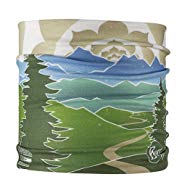
Explore More Epic Hikes , Huaraz , Peru , Top Adventures
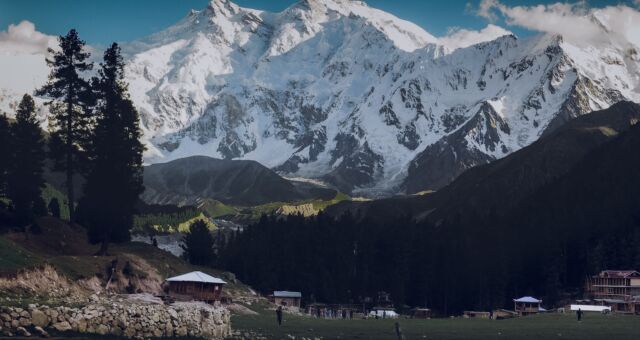
The Fairy Meadows in Pakistan and Hiking Nanga Parbat Basecamp
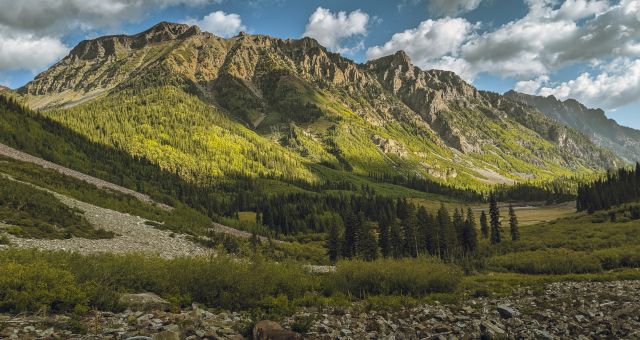
A Lazy Outdoorist Guide to Backpacking Colorado’s Four Pass Loop
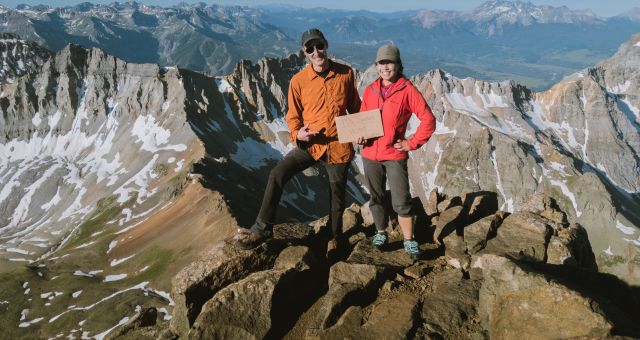
Hiking Mt. Sneffels and Why It’s My Favorite 14er
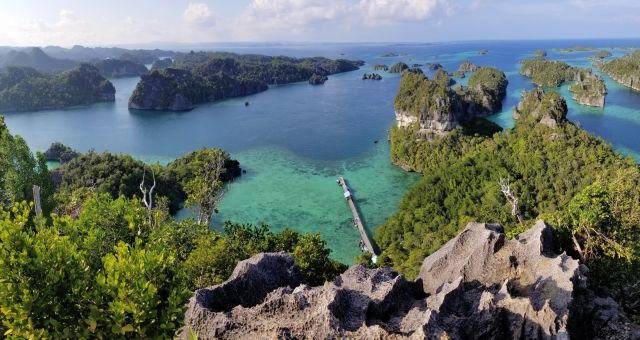
Visiting Raja Ampat, Indonesia’s Most Beautiful Diving Destination
30 comments.
All of these articles are great, thanks! Do you think it’s possible to just rent some donkeys and drive them yourself? Thought that might be kind of neat and would take off some of the load of carrying everything yourself. Were they pretty tempermental, or with a bit of guidance would you be able to do it yourself?
[…] beauty and scenery of the mountains makes up for it ALL. I particularly enjoyed this couples recap of their trekking experience. And this guy’s as well! Here’s hoping that Chris’ […]
I don't do much hikes and stuff but I do like to explore (well, compared to an average person). I was planning on doing a 4 day trek from Cusco to Machu Picchu and although this is not the same place, I at least got some insight about trekking in South America (most other sites/blogs just tell you about the highlights)!
Thanks so much for this post!
Hello from upstate NY, and I came across your awesome site while researching for a 62 day journey in Columbia, Ecuador, and Peru. If you have a moment, I would sure love to ask a few questions. 1) Most quotes for trekking Huayhuash are close to $1400 online, and that's way above what I want to spend. Any suggestions on how to book ahead? 2) I'm traveling solo… Did you carry your mountain gear the whole trip or have it shipped in? 3) any hostel suggestions for Huarez?
Hope your journey continues. I know you set this site up for friends and family but I have enjoyed reading it none the less. Safe journey and best wishes!
Hi Hanz, $1400 is way too expensive. If you'd like to book ahead, my suggestion would be to contact the 2 agencies (Huascaran Adventure and Quechua Andes) I recommended by email and ask for a quote. Or maybe $1400 was quoted because they thought it'd be only you? The more people you can get in a group, the cheaper the total would be. We used Thorntree to find other interested parties to form a group. Or the agencies could help out too – they'll tell you that a group of # are going on this date, would you like to join?
The agencies provided all of the gear: food, tent, sleeping bags, etc.
In terms of hostels, we used HostelTrail during our trip in S. America ( http://www.hosteltrail.com/cities/huaraz ). People we went with stayed in Caroline Lodging and had nice things to say.
Hi!! I stumbled across you blog researching for my upcoming trip to Peru. WONDERFUL post, so informative!! I just had a quick question about how you set up your trek through Huascaran – did you contact them before you arrived to Huaraz or arranged everything in person? I'll be getting to Huaraz the first of September and I'm unsure if booking ahead of time is better than waiting until I get there? What was your experience like?
We arranged everything on the ground. We did end up waiting a bit to get a group together to bring the cost lower, but since we had to acclimatize anyway it was no big deal. We used the time doing day hikes in the surrounding mountain. So I guess it depends on how much time you have. If I were you, I'd probably email a couple of companies just to put your name down (don't pay anything), and check back again when you're there. You'll end up meeting people and forming groups there as well. Also check Thorn Tree forum.
I just like the helpful info you provide in your articles. I will bookmark your weblog and take a look at once more right here regularly. I'm rather certain I will be informed many new stuff proper here! Good luck for the following!
Hi Jill, I also enjoyed a lot reading your post as it makes me remember my last trek to Huayhuash Mountain Range. I´m Peruvian and owner of an ecotourism agency in Peru. I have written a chronicle of Huayhuash including very useful information for travelers such as maps, elevation profile of the entire route and things to have in mind before departing to Huayhuash. Huayhuash is one of the most demanding treks in Peru but also probably one of the most rewarding treks in the world. I would also like to recommend the book "Touching the void" Cheers, Diego. This is our link: http://www.peruviansoul.com/28/chronicles/huayhua … Keep traveling and sharing your stories! Nice work!
Hi! Really enjoyed this post because I am considering doing this trek. What time of year did you go?
We went in early September. We really enjoyed the trek – it was tough but it was really worth it. Let us know if you have more questions.
[…] was a mentally and physically challenging experience for both of us. The 10 day trek around the Cordillera Huayhuash mountain range in Peru took us through remote Andean villages and numerous passes, the highest of […]
Loved the advice. We plan to go to Huaraz in June 2012 with a veteran of many trips to the Cordillera Blanca. Your article helped seal the decision. Thanks!
Awww, Vomit is so adorable! Great post, and I can definitely see the merit of going with one of the more quality companies. I'd be pissed if I was hiking eight hours a day and only had crackers to eat!
Sometimes you do get what you paid for – especially for service oriented industry.
sounds like it was definitely worthwhile! I think we had the same guide for our Santa Cruz trek (Miguel from Huascaran) just before you had him for this trek! We loved him!
Oh, how cool! Miguel is actually our chef in this trek. He's a pretty mean chef as well.
Loved the recap–got a good feel for the experience and had to laugh at the description of vomit. Still am 🙂
[…] Behind the Scenes on the Huayhuash Trek by Jack and Jill Travel […]
I should preface this by saying that I have very little interest in hiking :-p
I loved this entry! I was sucked in by the information and the amusing anecdotes. It almost made me want to sign up for an arduous mountain trek, haha.
And that photo of Vomit looks positively fierce. I thought you were going to tell a story about him attacking your camp by night or something :-p
Thanks for the kind words. Glad you enjoyed.
Hahaa… Vomit does look a little fierce there, eh? But he's only fierce when he was protecting his bone – and only towards other dogs. He's such a sweetie. We miss him.
Really great wrap-up! And that "PERU 11" torch pic – just the BEST!
Thanks – it was a very cold night when we gathered together to make the picture. I'm glad we got the shot pretty quickly 🙂
Great info! My boyfriend and I are in Huaraz now, just did the Lake Churup one day hike yesterday and I'm still feeling a little lousy from the altitude! We would love to do the Huayhuash Trek so if any of your followers are in the area and looking to form a group they can contact me at jessicaclairethomas(at)yahoo.com.au We are pretty easy going Aussies. Look forward to more of your posts.
Hola – hope you get your trek figured out. Have a great time out there and look out for Vomit, ok?
Wow- looks and sounds amazing. I wonder how much of the tribulations you will remember in a few months or if it will be mostly fond memories. Great post, very informative.
Probably not many – even now we're already plotting our next trek in Patagonia 🙂
Great post. Informative and entertaining 🙂 I can't believe you had ceviche during your trek! I definitely know what you are talking about re: #2. I ended up shitting my pants inside my sleeping bag on the salkantay trek to machu picchu. Think about that for a second. Actually, don't. It was a real nightmare though. I remember taking an almost frozen bottle of water to the "bathroom tent" which was blowing sideways and not really much of a tent, just a hole in the ground with a pinned up tarp over it, half-naked cleaning myself with freezing water and a wind whipping around the salkantay glacier. One of the worst nights of my life hands down. Definitely some really good tips in this post. Look forward to reading about the rest of Peru 🙂
Great read guys, sounds like quite the experience! We're off to Huaraz on Saturday in search of some trekking but I think a 3-day would be our max – we're obviously not as hard core as you! Any recommendations for a 2/3 day trek in the area?
Santa Cruz is a popular option for shorter trek in the area. You should definitely check that one out. The high season (the good weather season) was tapering off when we left so I think a 3 day trek is probably a wise choice. Have fun and good luck!
You are using an outdated browser. Please upgrade your browser or activate Google Chrome Frame to improve your experience.

- Trip Styles
- Destinations
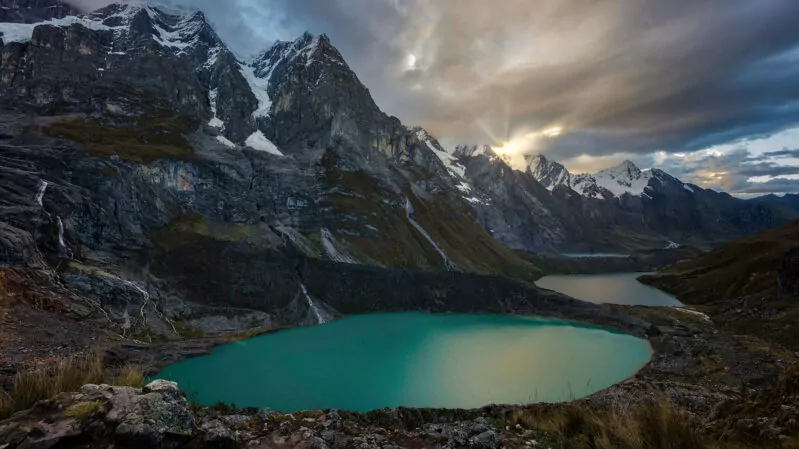
- Trip Destinations
- Peru Hiking Tours
- Cordillera Huayhuash Trekking
Cordillera Huayhuash Trek
Lima & huaraz, peru, trip highlights.
- Stunning Alpine Scenery
- Spectacular Glacier Fed Lakes
- 4 High Mountain Passes
- Unique Local Wildlife
- High Elevation over 15,000 Feet
- Ancient Inca Ruins
- Mountain Solitude
- Acclimatization Day Hikes
- Guides Choice Trip
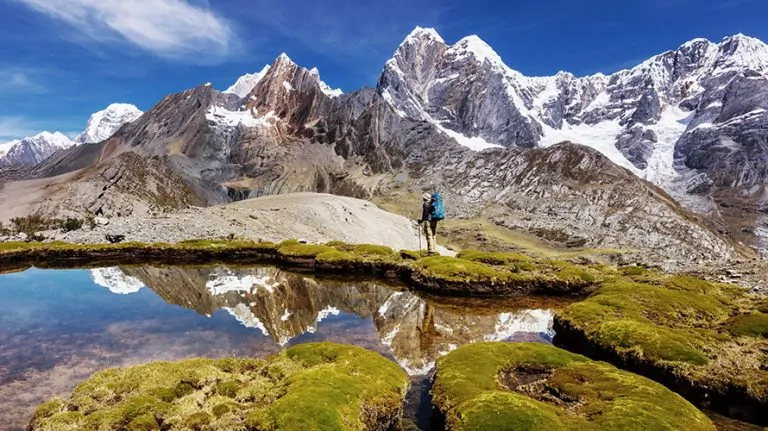
Description
This trip takes us into the Cordillera Huayhuash, a tightly bunched, sensational 18-mile long collection of high peaks in the Peruvian Andes. This trekker’s paradise is remote, wild and stunningly beautiful. The range is the home of Siula Grande (20,814′), the location of the famous mountaineering book and movie “Touching the Void.” We acclimatize for several days in Huaraz, Peru by taking spectacular high elevation day hikes in the surrounding mountains and sleeping at a lower elevation in town. We can then head into the higher mountains safely, feeling good and prepared for the upcoming trekking adventure. On this trek we cross four high mountain passes, all over 14,000 feet and three higher than 15,000 feet. We camp next to stunningly beautiful alpine lakes and in broad, grassy valleys with wildflowers and rushing alpine creeks. And all the time we’re staring in awe up at the soaring, snow-laden Andes giants that tower above us with peaks at elevations above 20,000 feet!
$3250 Per Person
$375 single supplement.
DIFFICULTY LEVEL 4
Scale of 1-5. 1 is least difficult; 5 is most difficult
Hiking Distances:
Up to 8.1 mi
Backpack Weight:
Significantly Rugged
Max Daily Elev. ↑↓:
Up to 3000 ft
Heights Exposure:
Significant Exposure
Please Note: Terrain, Elevation Gain and Heights Exposure ratings reflect the section or day of the trip with the maximum difficulty of each. Much of the trip is at easier levels. See the trip itinerary for more detailed information.
PHYSICAL DEMANDS OF THIS TRIP
- Hiking uphill or downhill with a 10-20 lb backpack for 7-8 hours
- Maintaining balance and footing on variable, uneven steep terrain
- River, creek crossings and rock hopping
- Hiking at elevations of 15,000+ feet
SOLITUDE LEVEL 3
1 least solitude, 5 most solitude
We rate this Peru hike a solitude 3. Expect hours of solitude at a time on the trail. Camps are usually set up in the vicinity of other groups in beautiful natural settings.
- Minimum Guests
Minimum of 2 Guests
We require a minimum of 2 guests to confirm this trip. If a trip date is not confirmed yet, you can register and will be notified when the trip is officially confirmed. We recommend not making final travel arrangements until your trip meets the minimum number of guests and is confirmed.
In most cases, if a trip does not reach the minimum number of guests, you may choose to transfer to another trip date or another trip, or be refunded your payments in full. We make the final determination for these trips 65-60 days before the departure date.
Private Trips
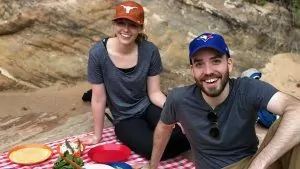
Travel in perfect company by booking a private trip exclusively for your group!
Our sliding scale for private trips is based on the final number of guests in your group. Rates are per person and do not include sales tax, national park fees or guide gratuity. The final rate is based on the actual number of guests on the trip and may adjust based on cancellations or additions.
Please Note: you can also enjoy a private trip at our normal scheduled rates by filling any empty tour to capacity. However, if group members drop from the tour those spots will automatically become available on our website for instant booking. By purchasing a private trip at the rates listed below, your trip will remain exclusive to your group regardless of cancellations.
Private Rates FOr This Trip
- 2 People: Rate x 2.5
- 3 People: Rate x 2
- 4-5 People: Rate x 1.5
- 6-10 People: Rate x 1.15
- 11-12 People: Rate x 1
- 13+ people: contact us for availability and pricing
*all rates are per person and single supplements apply
Learn About Our Private Trips
On this Peru trekking trip , a Wildland Trekking representative will pick you up from the Jorge Chávez International Airport in Lima, Peru. We transport you to our hotel (included) in the popular Miraflores district of Lima. The afternoon/evening is yours to rest, explore the city, and eat on your own. Be sure to drink copious amounts of water en route, as flying and traveling will certainly dehydrate you, and the elevation in Huaraz tomorrow is over 10,000 feet. Being hydrated (i.e. drinking lots of water and not drinking alcohol in excess), well fed, and being well rested are all critical components of dealing with significant elevation changes and properly acclimatizing. Proper self-care is important before, and during the trek.
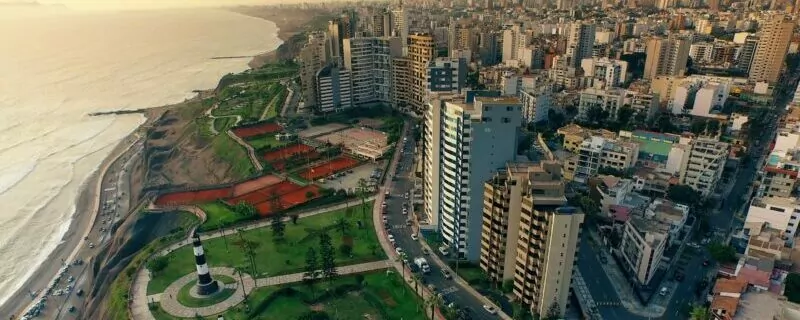
- Shuttle: 7-8 hours
This morning breakfast is included at the hotel and then the group will meet at 7am to share a private vehicle transfer to Huaraz, Peru. Along our scenic drive we will stop for lunch and restroom breaks whenever needed. Once we arrive in town, we’ll get checked into our rooms and the afternoon will be yours to relax or explore the city. At 6pm we will have our scheduled orientation meeting. After our meeting we will walk to our favorite, local Huaraz restaurant for dinner.
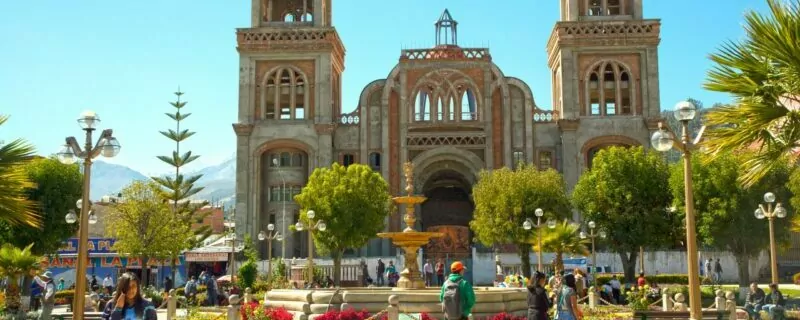
- Hiking Distance: 3.5 mi (5.6 km)
- Elevation Gain: 1755 feet (535 m)
- Elevation Loss: 2060 feet (628 m)
- Trekking Duration: 4-5 hours
This morning we enjoy a Peruvian breakfast at the hotel in Huaraz. Following breakfast, we pack our day packs and head to Chiwipampa, where we find the trailhead for our hike. We’ll set out on a 2-3-hour hike along locally farmed fields and beautiful sections of trail lined with the unique native plant species up to Wilcacocha Lake. At the lake, we’ll have lunch and take in the amazing panorama of the whole Cordillera Blanca Mountain range while helping our bodies acclimatize. After lunch, we descend to our transportation and ride back to Huaraz, where we’ll have free time until we meet for dinner.
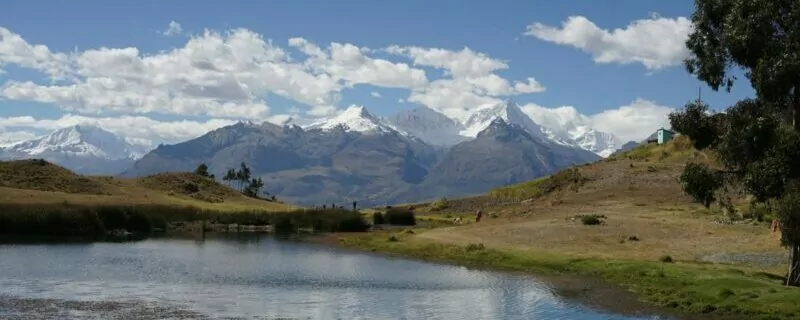
- Hiking Distance: 3.8 mi (6.1 km)
- Elevation Gain: 2360 feet (720 m)
- Elevation Loss: 2360 feet (720 m)
- Trekking Duration: 5-7 hours
This morning will serve as a second acclimatization day. After another delicious hotel breakfast we’ll pack our day packs and drive roughly 1 hour to the village of Pitec. At Pitec, we begin to hike slowly on our way up to Churup Lake. The walk will take 3-4 hours and once we arrive, we’ll have lunch and enjoy the amazing glacial lake and stunning mountain scenery. When we are ready, we’ll descend down a different trail between 2-3 hours until we get back to Pitec. Upon arrival at Pitec, we board our transportation for the 1-hour drive back to Huaraz. We will have time to freshen up before meeting for dinner.
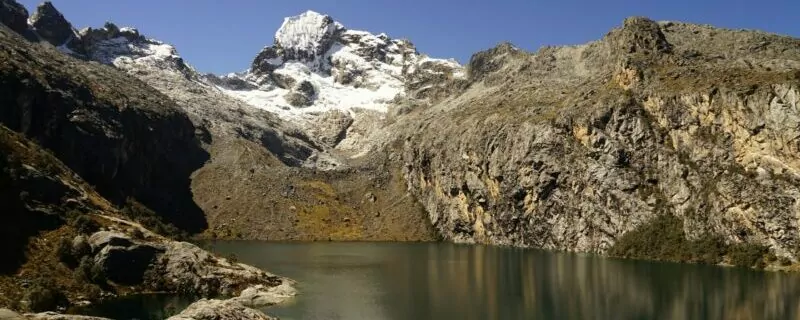
- Shuttle: 8-10 hours
- Camp Elevation: 12,569 feet
This morning after a filling breakfast we depart Huaraz and drive approximately 4 hours to the ruins of Wanuku Pampa. Wanuku Pampa is an ancient ruin built by the Inca (Quechua) people on the trading highway from Cusco, Peru to Quito, Ecuador. We’ll have lunch and spend some time exploring the ruins and historical area. When we are ready, we’ll continue our drive 4-5 hours more to Queropalca where our night’s camp will be set up and ready for us. Tonight’s dinner will be our first of many meals prepared by our team’s chef. After dinner your guide will provide the plan for the start of our multi-day trek tomorrow!
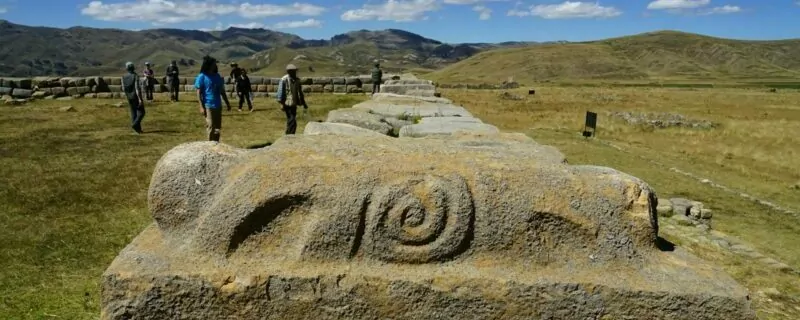
- Hiking Distance: 6 mi (9.7 km) / (Optional Hike: 2.25 mi/12.1km)
- Elevation Gain: 1620 feet (494 m) / (Optional Hike Gain: 1525 feet/465 m)
- Elevation Loss: 585 feet (178 m) / (Optional Hike Loss: 1525 feet/465 m)
- Trekking Duration: 4-5 hours / (Optional Duration: 1-2 additional hours)
After a nutritious breakfast, we’ll breakdown camp and pack our gear onto the mules. From here, we lace up our boots and begin hiking. We’ll be accompanied on our walk today with breathtaking mountain views of Siula Grande, Yerupaja and Ninashanca. We walk 4-5 hours until we arrive at the Carhuacocha Lake camp (13,615′), where we’ll have a relaxed lunch and camp for the next 2 nights. With our extra time here, you can relax at the lake and take in the amazing scenery. For anyone wanting an extra challenge and to explore a bit more, we can hike up to a viewpoint high above the lake before our much deserved dinner prepared by our chef and served by our camp staff.
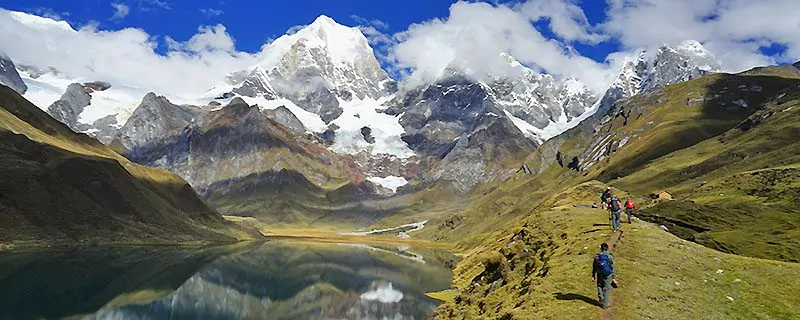
- Hiking Distance: 8.1 mi/13 km
- Elevation Gain: 2650 feet (808 m)
- Elevation Loss: 2650 feet (808 m)
- Trekking Duration: 6-7 hours
After a relaxed breakfast, we’ll leave our camp set-up and start our day hike up the valley to the Laguna Quesillococha, Laguna Siula, and Laguna Jancacocha. We will spend some time taking in the spectacular scenery from viewpoints along the way and pick a great spot to have our packed lunch. The prize view of the day comes from climbing up to our highest point of our hike and looking back over our trail and the lakes. After taking in this extremely picturesque vista, we’ll start heading back to camp the way we came. Today’s hike might be strenuous but is absolutely one of the highlights of the trip. At camp we’ll have time to change clothes and rest until our dinner is served.
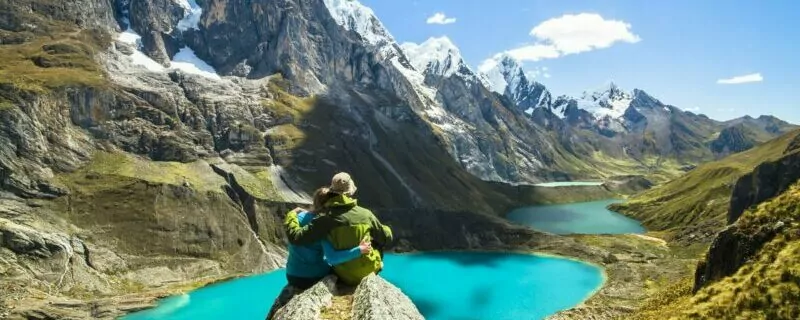
- Hiking Distance: 7.5 mi (12.1 km)
- Elevation Gain: 1800 feet (549 m)
- Elevation Loss: 1515 feet (462 m)
After breakfast this morning we’ll pack up camp and start off on our trek for the day. We begin hiking for roughly 3 hours until we reach the Carhuac pass (15,255′). At the pass we’ll stop to appreciate and photograph awe-inspiring views of the giant mountains Jirishanca (20,098′) and Ninashanca (18,396′). We’ll enjoy our lunch and take in the sweeping views around us before descending to Mitucocha camp (13,878′). Upon arrival at camp, we are greeted by our crew with hot drinks and snacks. You’ll have free time to relax or explore the area around Lago Mitucocha before dinner is served.
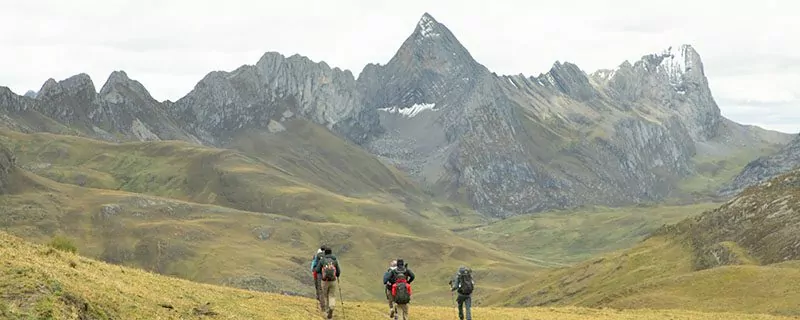
- Hiking Distance: 5.6 mi (9 km)
- Elevation Gain: 2475 feet (755 m)
- Elevation Loss: 2200 feet (671 m)
- Trekking Duration: 7-8 hours
After an early breakfast, we pack up and leave camp by 8 am. We begin our ascent to our second pass, Cacanan (15,419′). Once again, we are surrounded by gigantic, glaciated mountains and breathtaking views. We are literally hiking in the Land of Giants today, which for most guests is an indescribably rich and humbling experience. We’ll have lunch at or near the pass and descend to the Quartelhuain camp (13,468′). Tonight’s camp is picturesquely set in a high meadow landscape beneath the surrounding towering peak of the Cordillera Huayhuash. We’ll have time to relax and take photos of this amazing camp before another chef prepared meal.
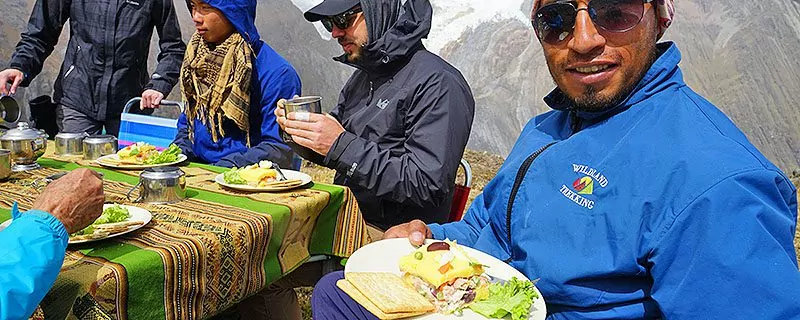
- Hiking Distance: 8 mi (12.9 km)
- Elevation Gain: 2675 feet (815 m)
- Elevation Loss: 2995 feet (913 m)
- Trekking Duration: 8-9 hours
After another breakfast in camp, we’ll pack up and begin our 3-4 hour ascent to our third pass and the highest elevation we’ll reach on our trek, Sambuya Pass (15,584′). As we hike we’ll soak up fantastic views of the mountains Ninashanca, Jirishanca, Yerupaja and Rondoy. After lunch, we’ll head down to our final camp at Jahuacocha lake (13,287′). Upon arrival at camp, we’ll have free time to relax with hot drinks and snacks. Dinner will be served with the outstanding views from camp as our backdrop. Your guide will provide the plan for our last day of hiking before we enjoy another well-deserved night of sleep in the Cordillera mountains.
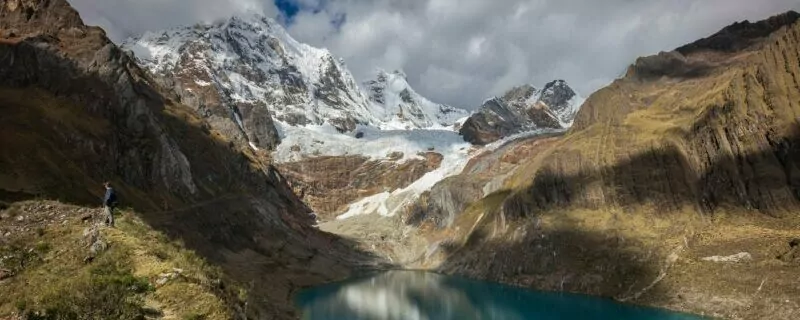
- Elevation Gain: 2040 feet (622 m)
- Elevation Loss: 4665 feet (1422 m)
- Trekking Duration: 5-6 hours
After a delicious breakfast, we begin hiking on a mostly flat trail until a short climb to our fourth and final pass, Pampa Llamac (14,108′). We’ll make sure to take a long break here and soak in our final panoramic views of the surrounding mountains before descending to the end of our hike at Llamac Village (10,827′). Here we’ll have lunch and board our private vehicle for the 4.5 hour drive back to Huaraz. Upon arrival in Huaraz, we’ll check into our hotel rooms, have showers and meet for our final celebratory dinner together. Here we will say goodbye to our guide and thanks for a successful trip.
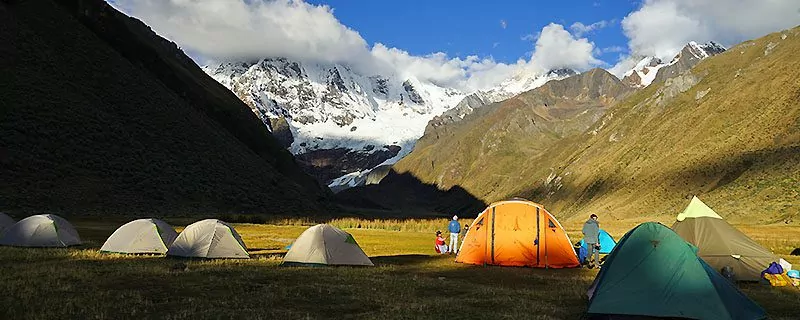
This morning breakfast is served at our hotel before our private group transfer back to Lima leaves at 7am. Along the way we will stop for restroom breaks and lunch. We will drop guests at the Lima airport no later than 3pm. Departure flights should be planned after 6pm. Our Adventure Consultant team can help book any extra add-on hotel rooms and airport transfers in Lima if desired. What an adventure it has been, thank you for choosing Wildland Trekking!
Please Note : We always do everything in our power to follow the set itinerary, however occasionally trips are subject to itinerary changes based on a variety of circumstances, including but not limited to: lodging/campground availability, extreme weather, political or bureaucratic obstacles, earthquakes, fires, flooding and more. Normal terms and conditions apply to trips with itinerary changes.
Trip Dates & Booking
Trip dates & booking.
Click on a date to register. You can also click here to request new dates or book through customer service.
AVAILABLE TO BOOK
This trip is available and bookable online! Click on the date to register now or contact us online to book through our award-winning customer service team!
This trip has 1 or 2 spots remaining and is bookable online! Click on the date to book now or contact us online to book through customer service.
REQUEST A RESERVATION
This trip is exclusively booked through customer service due to logistics with lodging, permits, staffing, availability, or something else. Please contact us online or call us at 800-715-HIKE (4453) to request a reservation.

Don't see your dates? Call us! We may be able to add new trip dates.
Trip details, what's included.
- A detailed trip packet that takes the guesswork out of your travel, training, packing, and preparing for the trip
- Trained hiking guide(s) with years of personal wilderness and hiking experience, medical certifications, and a passion for leading people into breathtaking landscapes. See Guide Bios .
- Transportation for the duration of the tour starting on Day 1 and ending on Day 12
- Lodging before and after the trekking portion of the trip (Day 1-11)
- All camping gear and supplies (including a dining tent and kitchen tent)
- Porters or mules to transport all gear, food, and most personal items
- Professional camp chef
- Drinking water and hot water for washing face, hands…etc.
- Use of a backpack and trekking poles
- Meals for the duration of the tour (from breakfast day 1 to lunch on Day 12)
- Emergency equipment including a company-issued first-aid kit and communication device
What's Not Included
- Transportation to Lima, Peru
- Trip insurance that includes medical coverage and at least $200,000 in evacuation and repatriation coverage (strongly encouraged)
- Bar bills, drink bills, extra snacks, telephone bills, wifi bills and other personal expenses (shopping/ laundry)
- All expenses due to unavoidable events e.g. flight cancellation, personal illness, strikes, etc. (we recommend trip insurance coverage for these variables)
- Clothes, raingear , and footwear
- Sunscreen, toiletries and personal items
- Water bottles and a headlamp or flashlight (disposable plastic water bottles are prohibited; please have refillable water bottles or hydration bladders)
- Guide gratuities are optional and at the discretion of each customer. A suggested guideline is to reward outstanding service with a tip of 10-15% of the total trip cost. Please tip your lead guide and they will distribute responsibly to the crew. Local currency is preferred, or USD is also appreciated.
- See the Packing Lists page for more information
Click here to see a printable, downloadable trip information packet with more detailed guidance about what to pack.
Meals: What to Expect
This Peru hiking tour features a combination of in-town meals and meals prepared by our staff. We’ll have dinners at carefully selected restaurants in Huaraz as well as meals prepared on the trail by a professional camp chef.
For optimal taste and energy, we supplement all our meals with spices, herbs, oils, cheeses, butter, sugar, and fruits and vegetables. In addition, we provide you with an assortment of trail snacks* (nuts, dried fruit, chocolate, & cookies) to eat at your own discretion.
We can often accommodate vegan, vegetarian, kosher and non-gluten diets and make adjustments for food allergies. These and other special dietary requests may require an additional fee, and in some countries may be more difficult to accommodate than others. Please inquire with us for more information about the specific trip you’re interested in.
*Common trail snack brands and items found easily in the US are not readily available in this destination. (i.e. protein bars, trail bars, beef jerky, etc…) We recommend guests that prefer these types of trail snacks to bring a few of their own choice items from home.
Gear We Provide
- We provide all group gear which includes the following:
- Trekking poles
- Tents, sleeping bags, sleeping pads
- Company-issued first-aid kit
- Emergency communication device(s)
Guest Packing List
When you register for this tour you’ll receive access to a printable, downloadable trip information packet with a detailed packing list specific to this trip ( click here to see it now.) All trips require a sturdy pair of hiking shoes or hiking boots, rain gear, a recommended clothing system, a headlamp or flashlight, a hydration system (water bottles and/or bladder) and other items specific to each trip.
Additionally, some guests choose to bring their own sleeping bag. We supply high quality, synthetic fill bags that are professionally laundered after every trip. Synthetic fill is non-allergenic, insulates when damp and stands up well to repeated washings, but is heavier and bulkier than down. If you’re able to bring your own down sleeping bag, there are multiple benefits . If not, we’ve got you covered!
Frequenly Asked Questions
We have compiled the most frequently asked questions that Wildland Trekking guests have about visiting and trekking the Cordillera Huayhuash. Learn the answers to these commonly asked questions about traveling in Peru by using the link below!
- Trekking Cordillera Huayhuash – FAQs
Trip Logistics
How do i register.
Reserve your spot today! In the Trip Dates & Booking section of this page, the green and red dates are bookable online by simply clicking on the date, and blue dates must be booked through our customer service team for a variety of possible reasons. To email our customer service team, you can click here to get the ball rolling. Our adventure consultants will confirm availability, and if you’re ready to register we’ll email you a link to a registration profile. You’ll have 72 hours to complete your profile (and that of any dependents) and pay the deposit.
Feel free to call us for more info – we’re here 7 days a week!
Where Do We Meet?
We will meet you at the Lima airport on Day 1 and transport you to the first night’s hotel (included). Our Peru communications team will be in contact approximately 45 days before your trip to coordinate your rendezvous and answer any last-minute questions you have.
Click here to see a printable, downloadable trip information packet with more detailed guidance about flights, shuttles, recommended lodging and more.
Travel to Lima, Peru
TRAVEL TO LIMA, PERU
Transportation to and from the origin city of Lima, Peru is the guest’s responsibility. You will need to arrive in Lima on the first day of the trip at any time. Our team will rendezvous with you at the airport and transport you to our hotel. Accommodations are included on Day 1. Your departure from Lima should be scheduled for the final day of the tour with flights departing no earlier than 6pm.
The group travels to/from Huaraz, Peru together in a private shuttle.
You can reach Lima from many U.S. and European international airports. Some of the primary U.S. departure cities include Miami, Fort Lauderdale, Atlanta, Washington D.C., Minneapolis, Chicago, New Orleans, Salt Lake City, Phoenix, and Los Angeles. The duration of nonstop flights to Lima is 5-9 hours.
Pre and Post-trip On Request Lodging
We secure limited amounts of pre and post trip lodging in Lima, Peru as an optional add-on for guests of this trip. This lodging is on request, and is available on a first come, first serve basis. If interested, please reach out directly to our team to check availability.
Safety Precautions
Your safety is our top priority. Our hiking tours are led by professional hiking guides, all of whom are wilderness-certified first responders or EMT’s, each with years of guiding and wilderness experience. Guides adhere to standardized risk management protocols in case of any potential or actual incident, and all tours carry an emergency communication device and comprehensive first-aid kit. Additionally we have a “24/7” system through which guides or guests can reach Wildland support personnel at any time.
In the interest of your safety, it’s important to refer to the Center for Disease Control website for up-to-date recommendations on immunizations before your trip.
Essential Eligibility Criteria
Essential Eligibility Criteria (“EEC”) have been specifically identified to help you understand the skills and abilities necessary to participate on each Wildland trip, and they apply uniformly to all potential trip participants, irrespective of the presence or absence of any disability.
Once you identify a trip in which you may be interested, please carefully review the EEC and itinerary details. If after reviewing the EEC that apply to your desired trip, you determine you need an accommodation in order to meet the EEC, please contact us prior to registering to discuss your requested accommodation.
The EEC exist for your own safety and the safety and enjoyment of all participants. If you are unable to meet the EEC for the trip, with or without an accommodation, you are not eligible for that trip. If you register and arrive for a trip for which you do not meet the EEC, you will be disqualified from participation on the trip and will be dismissed or evacuated from the trip without a refund.
Our approach to international travel is to combine the best of two worlds: the dialed-in details, professionalism and consistency Wildland trips are known for; and the cultural immersion and intimate regional knowledge that only locals can provide. To excel with this approach, we vet and hire the best local guides, welcome them into the Wildland family and train them to meet our standard of excellence with every aspect of a trip. But along with managing logistics and safety, your guides will teach you about the area’s history and culture, and provide a level of familiarity and intimate detail only locals can.
Check out our Meet Our Team page for staff bios.
Guide Working Parameters
Guides are required to take 8 hours off each 24-hour period to sleep, recuperate, take personal/down time…etc. In addition, as part of the 8 hours off they must sleep/rest or be in their tents/rooms uninterrupted for a minimum of 5 hours each night. We ask guests to respect these requirements and to not interrupt guides’ off time and sleep time unless there is a true emergency.
Age Restrictions
Age restrictions on this trip are as follows:
- 12 and older to join scheduled tours (mixed groups)
- 5 and older to join private tours, with final approval and specific logistical requirements (such as porter or stock assist) determined on a case by case basis
Trip Insurance
For your protection, we strongly recommend the purchase of field evacuation, repatriation, and medical trip insurance. International travel is expensive, and the modest cost of trip insurance is a sound investment in an uncertain world.
If you wish to purchase trip insurance, we recommend IMG/iTravelinsured. They are one of the world’s leading providers of travel insurance.
For information on recommended IMG/iTravelinsured policies please click here .
For even greater information, or if you simply prefer communicating with a real, live person, feel free to contact our exclusive agent Michael Bennett. Michael will help you identify the best product for your needs, and there is no cost associated with his assistance. You may contact him at:
Email: [email protected] US by Phone: 877-305-9083 Direct/International by Phone: 702-448-3664
If you already have insurance or wish to purchase from anyone other than IMG/iTravelinsured, we recommend careful consultation with the provider to ensure appropriate coverage. This is because many providers have a number of policy exclusions.
Weather in Peru
Peru is home to part of the Amazon Rainforest as well as the towering Andes Mountains. Most of our treks in the region reach elevations well above 10,000 feet, some reaching or exceeding 15,000 feet. Because of the wild elevation changes, the temperatures and weather can also vary wildly. The temperatures will be colder and potentially wetter as we hike to higher elevations than Huaraz (below charted averages) in the mountains. Camp/nightly temperatures are commonly well below freezing on this trek.
The average temperatures and precipitation in the Huaraz region are:
- Accommodations
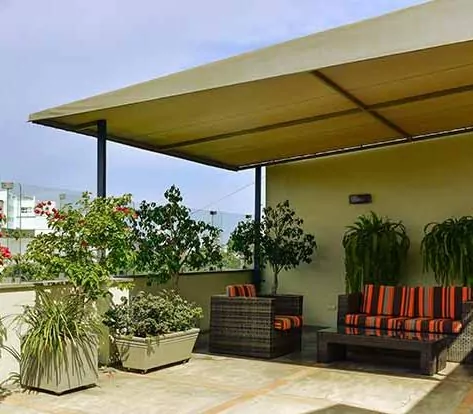
LOS GIRASOLES HOTEL
This stylish hotel sits in a beautiful neighborhood in the popular Miraflores district in Lima. The hotel’s tasty restaurant and relaxing rooftop terrace are great places to decompress from your travels and the hotel’s location near the Central Park and other main attractions makes this a perfect starting point for your Peruvian vacation and exploration of Lima.
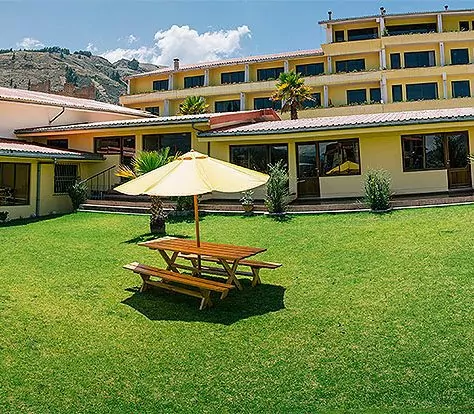
ANDINO CLUB HOTEL
This wonderful hotel is situated a short distance from the main square and cultural center of Huaraz, and has beautiful gardens and appealing, spacious rooms. It boasts stunning panoramic views of the Callejón de Huaylas (the valley between 2 mountain ranges), including 8 towering peaks higher than 6,000 meters!
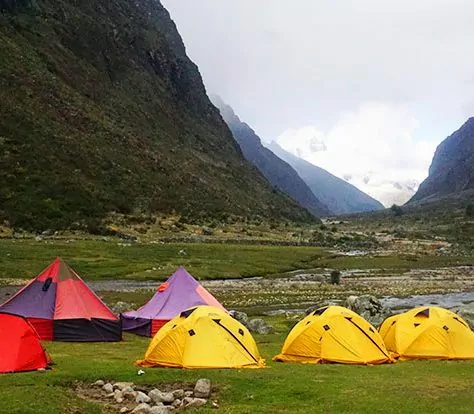
PREMIER CAMPING
Our Peru Treks feature premier camping with comfortable sleeping tents, kitchen tents, dedicated chefs, and a team of porters to carry, set up, and break down camp each day. We provide all top-of-the-line gear. Our guests regularly rave about the camping accommodations on our Peru adventures!
* These exact accommodations are not guaranteed. In some instances alternative accommodations of similar quality and location may be used.
Trip Reviews
Average customer ratings:.
- 5.0 (5 reviews)
- Most recent
Best Experience!
This is my third trip with Wildland and far away the best experience! Our guide Heimer was experienced, patient and understanding with all members of the group. The assistant guide, chef and donkey driver were equally as fantastic and made the experience wonderful. The views throughout the trip were stunning and the solitude was exactly what I was looking for. I can't recommend this trip enough, it's a hidden gem in Peru!
Spectacular
My trip with Heimer and his team exceeded my expectations. Not only was this scenery amongst the most spectacular I have ever seen but Heimer and his team took such great care of us. All we had to worry about was hiking and everything else was completely taken care of. Every detail was perfect. I would 1000% recommend this trip- you won’t regret it. Don’t forget to get some altitude meds from your doctor before you go- they are a lifesaver!
PHENOMENAL - JUST DO IT!!!
What a truly phenomenal experience! It's hard to even begin to describe how amazing this trip was. First off, we felt like we had a guardina angle watching over us, as WildlandTrekking arrange all of our transports from the airport to the hotel to Huaraz ... and back. Everything went super smoothly. The hotels in Lima and Huaraz were wonderful. Huaraz is an amazing and vibrant city that we enjoyed very much. The acclimating day hikes were incredible (day two is quite difficult but amazing!). And, then for the main trek itself! PHENOMENAL! Our main guide Heimer was just THE BEST! And, his crew, so friendly, helpful, and cheerful the whole trip. The treks and views were out of this world. The meals in the dining tent, breakfast, lunch and dinner were delicious and much appreciated. Every detail of this trip was well planned and very special. I will admit, the hiking was much more difficult than I imagined ... because of the high altitude and difficulty breathing ... but the crew's excellent care before, after, and along the way each day, balanced out the challenge. Who wouldn't like tea and snacks at 4 pm in a dining tent, after a long day's hike! If you think you might like to do this trip and are up for the physical challenge, then I say, don't hesitate! Just do it. It is truly an adventure from start to finish! (Honestly, I was kind of dreading the long drives, BUT we got to see so much of Peru this way, from huge vistas to tiny villages. So, while the drives are long, they are also a part of the adventure.)
See All Guest Reviews!
Related trips, you might also like....
Salkantay Trek Extended Package
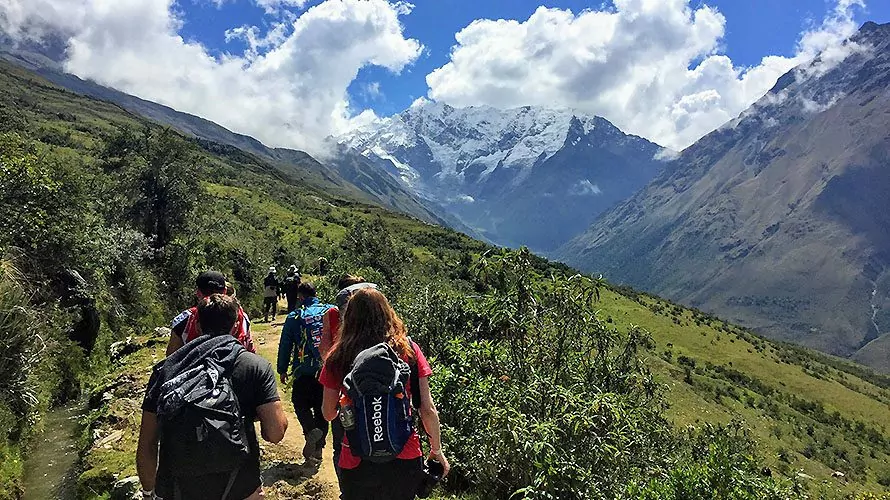
Classic Salkantay Trek
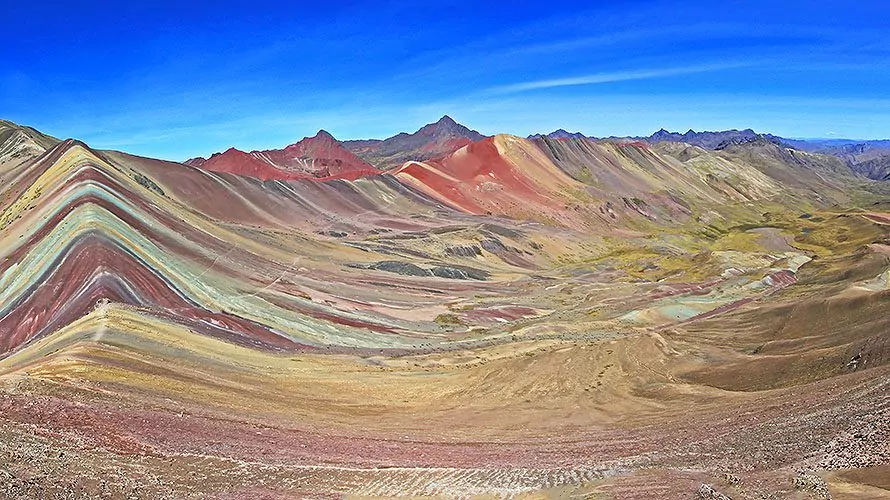
Rainbow Mountain Day Hike
- Similar Trips
- day by day itinerary
- logistical and travel information
- gear and clothing lists and more
Leave a Reply Cancel reply
Your email address will not be published. Required fields are marked *
First Name & Last Initial *
Save my name and email in this browser for the next time I comment.
wildland Wires
Sign up to receive our exclusive Wildland Wire emails and stay up to date with Wildland Trekking's promotions, discounts, contests, outdoor tips and tricks, trip reports and more!
Licensed Local Travel Company.
Get In Touch!

- Huaraz Hills Hike
- Wilcacocha Hike
- Rajucolta Lake Hike
- Llaca Lake Hike
- Yanapaccha Viewpoint Tour
- Paron Lake Tour
- Pastoruri Glacier Tour
- Churup Lake Hike
- Lake 69 Hike
- Ahuac Lake Hike
- 2 Day Pisco Base Camp and Lake 69 Trek
- 3 Day Quilcayhuanca to Cojup Valley Trek
- 4 Day Quilcayhuanca to Cojup Valley Trek
- 4 Day Santa Cruz Classic Trek
- 6 Day Santa Cruz to Ulta Valley Trek
- 9 Day Llanganuco to Alpamayo Base Camp Trek
- 10 Day Santa Cruz to Alpamayo Trek
- 11 Day Huayhuash Classic Trek
- 10 Day Huayhuash Trek Via Trapecio
- 8 Day Huayhuash Unique Trek
- 6 Day Huayhuash Mini Trek
- 1 Day Mateo Mountain Climb
- 2 Day Vallunaraju Mountain Climb
- 2 Day Yanapaccha Mountain Climb
- 3 Day Pisco Mountain Climb
- 4 Day Tocllaraju Mountain Climb
- 4 Day Chopicalqui Mountain Climb
- 7 Day Ishinca Valley Mountain Climbs
- 7 Day Cordillera Blanca Classic Climbs
- 7 Day Alpamayo Mountain Climb
- 7 Day Quitaraju Mountain Climb
- 7 Day Huascaran Mountain Climb
- Group Departures
- Testimonials
Huayhuash Classic Trek
- 11 Day Trek
- Fully Supported
- Small Groups Only
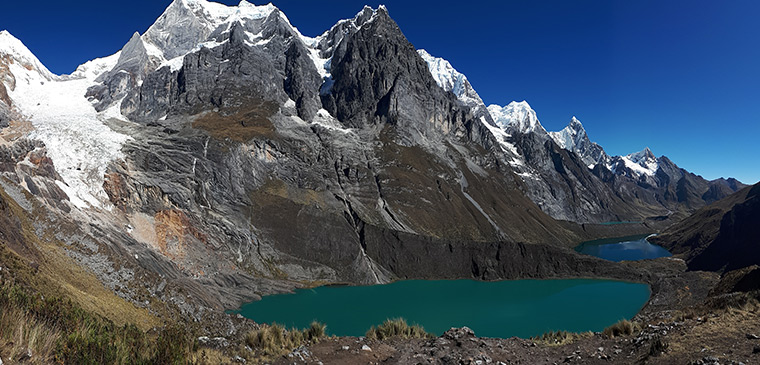
Hike one of the most beautiful trekking circuits in the world . This is the most dramatic high altitude trek in the Peruvian Andes with magnificent views of mountains of the Cordillera Huayhuash such as Yerupaja 6634m being the second highest mountain in Peru, Siula Grande made famous by Joe Simpson in his book and film “ Touching the Void ”, Sarapo, Rondoy, Ninashanca, Jirishanca, Rasac, Carnicero, Trapecio and beautiful glacial lakes. The dramatic and beautiful glacial lakes and valleys of the range provide memorable campsites and good trout fishing. Andean condors are seen more often in the Huayhuash than on other Peruvian treks, attesting to the area’s remoteness. Our Huayhuash Classic Trek includes all the best and famous spots in the range such as Siula Lakes, Santa Rosa Viewpoint/Pass, Siula Base Camp and a deep soak in the hot springs of Guñoc – Viconga. You won’t miss anything!.
Trip Highlights
- Unique Mountain Views
- U–Shaped Valleys
- Deep Glacial Lakes
- World Class Trek
Departure Dates
Trekking details, trekking itinerary, lets go vamos.
Day 1: Huaraz – Chiquian – Llamac – Pocpa – Pallca – Quartelhuain
You are picked up at your accommodation and begin the journey with a spectacular scenic drive along the Callejon de Huaylas Valley. There are opportunities for photo stops along the way. We drive through many rural villages until we reach our camp at Quartelhuain 4150m. 5 hours drive.
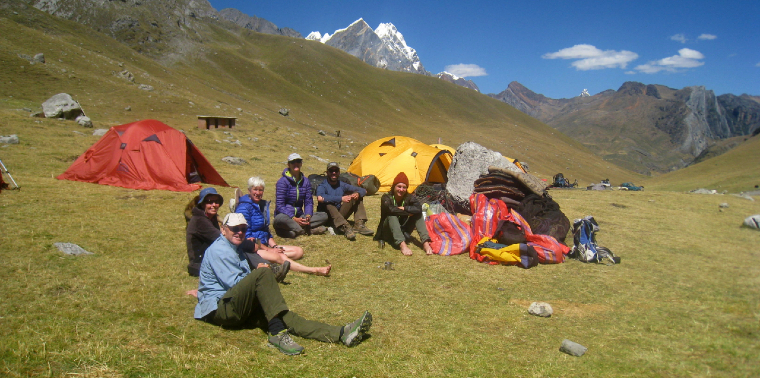
Day 2: Quartelhuain – Cacananpunta Pass – Janca
We slowly climb up to 4690m in the morning to cross the Punta Cacanan then, as we descend, we are rewarded with stunning views of the nearby peaks of Rondoy and Jirishanca. Our camp is situated at Janca Valley 4200m. In the afternoon, we can do a side trip up to Laguna Mitucocha 4250m where we will see Torrent Ducks and Andean Geese. 5 to 6 hours walk.

Day 3: Janca – Carhuac Pass – Laguna Carhuacocha
We ascend towards Paso Carhuac 4630m pass from where we have splendid views of Nevados Carnicero, Siula Grande, Yerupaja, Jirishanca. We then descend to our camp at the beautiful Laguna Carhuacocha 4150m. 5 to 6 hours walk.

Day 4: Carhuacocha – Siula Punta Pass – Huayhuash
We ascend towards Paso Siula Punta 4850m pass with nice views of the surrounding mountains and crossing above the glacier fed lakes of Siula and Quesillococha. From the pass we descend to our camp at Huayhuash 4350m passing a beautiful lake and always enjoying views of the great mountains of the range. 8 hours walk.
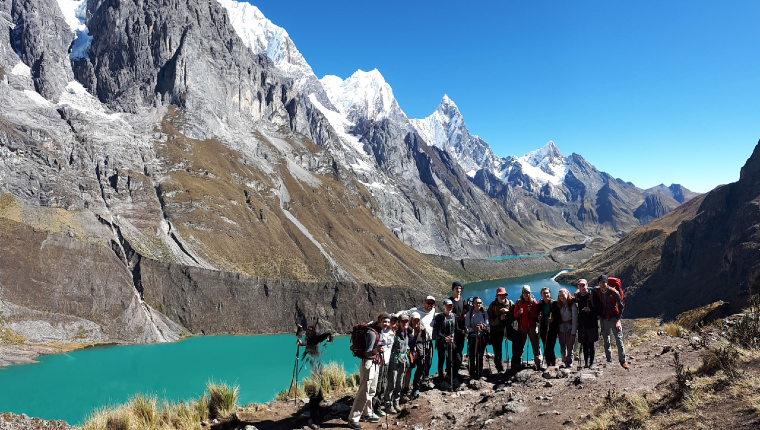
Day 5: Huayhuash – Portachuelo de Huayhuash Pass – Viconga
We ascend gradually towards Paso Portachuelo de Huayhuash 4780m pass from where we have great views of the Cordillera Raura. We then descend to the big lake of Viconga and then to our camp at 4350m near by the Viconga Hot springs. 5 to 6 hours walk.
Day 6: Viconga – Cuyoc Pass – Cuyoc
We go over Punta Cuyoc Pass with a sustained uphill hike of 3 hours to a breathtaking 4900m pass. From here we marvel the spectacular views of the mountains. We then descend to our camp at 4500m. 5 hours walk.
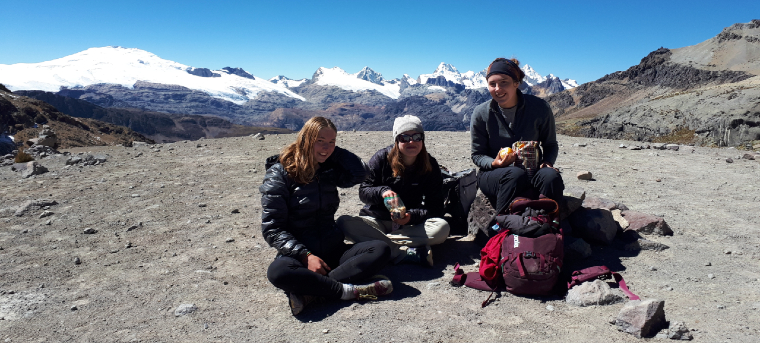
Day 7: Cuyoc – Santa Rosa Pass – Cutatambo
We ascend towards the highest pass on the trek Paso Santa Rosa 5100m pass from where there are fantastic views of mountains and lakes. We can see the Siula Glacier where Joe Simpson crawled down in his epic battle for survival, and also Siula Base Camp. We then descend to our camp Cutatambo in Callinca Valley 4265m. 5 to 6 hours total walk.
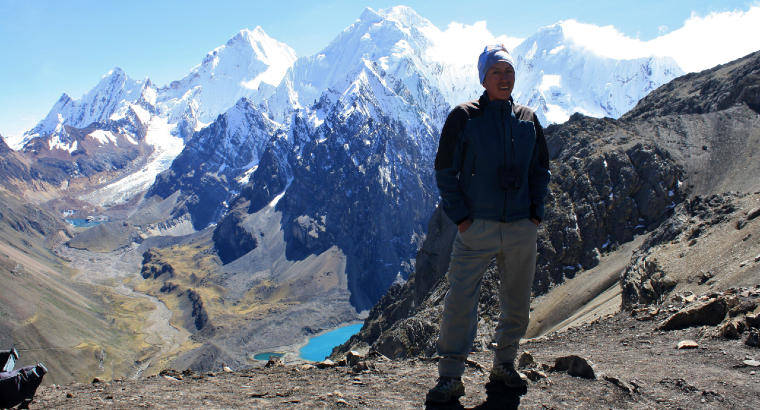
Day 8: Cutatambo – Huayllapa Village
Today we come down to Peruvian sea level, following Calinca valley for 4 to 5 hours. The community of Huayllapa is one of the highland villages of Lima Region located at 3670m. Villagers are mainly farmers and shepherds and few of them work in tourism sector as cooks and donkey drivers.
Day 9: Huayllapa – Tapush Pass – Gashpapampa
We slowly climb up to 4770m in the morning to cross Punta Tapush Pass, we then descend to Gashpapampa 4500m. 7 to 8 hours walk.
Day 10: Gashpapampa – Llaucha Punta Pass – Huacrish Lookout – Laguna Jahuacocha Lake
We descend before ascending towards Paso Llaucha Punta 4850m pass, with fantastic views of the mountains of Rondoy, Jirishanca, Yerupaja, Rasac and Sacra. From the pass, we hike up to a ridge which takes us to Huacrish Lookout to have an unique views of the Huayhuash Mountain Range. We then descend to our last camp at the beautiful Laguna Jahuacocha 4050m lake. 4 to 5 hours walk.
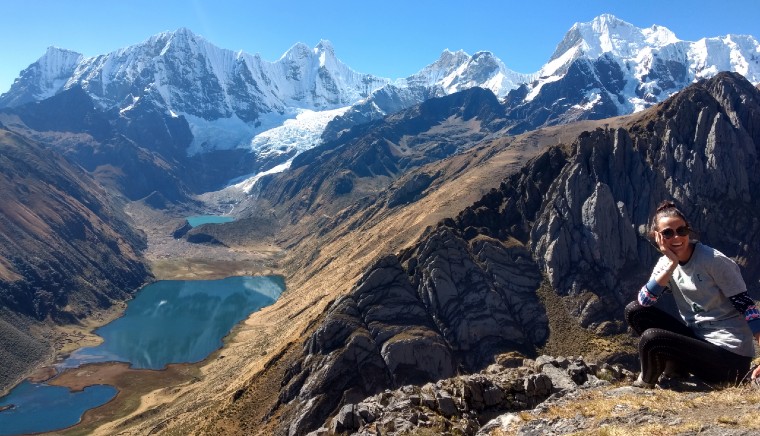
Day 11: Jahuacocha – Pampa Llamac – Llamac – Huaraz
Today is our final day of trekking, with one last climb up to Paso Pampa Llamac 4300m. We can enjoy our final views over the range before descending steadily down to Llamac. Here we meet our transport and drive back to Huaraz. 5 hours walk and 4 hours drive.
Altitude and Acclimatization
This is a major factor on this trek and we strongly recommend that you arrive in Huaraz at least 4 days before the trek departs and spend time doing day hikes to higher altitude, this will help with acclimatization to the new altitude.
Grading & Fitness
In order to get the most out of the trek you should be in good physical condition. It is not easy to grade the fitness level required for the trek, since it is a subjective matter. However, we have classified this trek as strenuous. We trek approximately six to eight hours per day with several long ascents and descents.
TRIP REVIEWS
Rodolfo, I really appreciated your easy going nature. Thank you for a great trip and great service. Hayden, Australia
Rodolfo and his crew were totally professional, knowledgeable and energetic, always willing to help. They could not have made the trip any better. Evans, USA
I had a really great time in Peru! Thank you again for being a great guide. Illiana, USA
A trek with a 10 out of 10 Wow factor! From start to finish Rodolfo and our trekking team were amazing. Sonia, Australia
FEATURED TRIPS
You might also like.
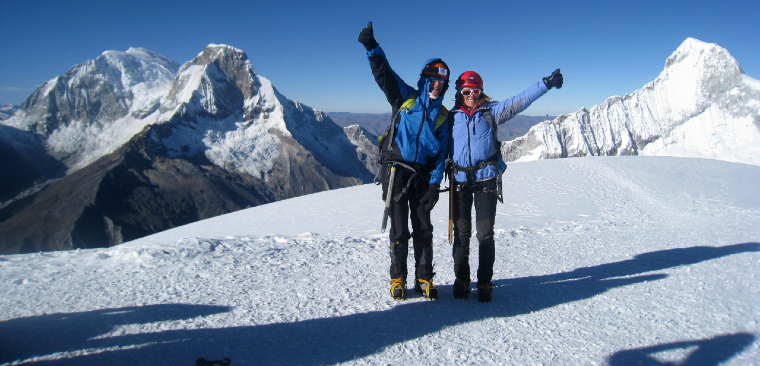
Would you like to do this trip?


Huayhuash Classic Trek
The Huayhuash Classic Trek is one of the most beautiful treks in the world. With this route you can discover the most impressive areas of the Cordillera Huayhuash in just 8 days. We camp by the most beautiful lakes with impressive views of the largest mountains in the range, including the second highest peak in Peru, Yerupaja, the famous Siula Grande and many more. We hike up 7 passes, including the highest with over 5000m altitude.
Trip Duration 8 Days
- Reviews 0 Reviews 0/5
- FAQs & Reviews
- Trekking around the Cordillera Huayhuash – one of the most beautiful treks in the world
- Untouched mountain landscapes, intensely glaciated
- Dreamlike campsites you will remember forever
- Crossing 7 high altitude passes
- Views to Yerupaja Grande (6634 m)
Character The circuit of the Cordillera Huayhuash lasts 8 days, almost always moves at altitudes over 4000m and overcomes at 170 km distance 7 passes between 4300 and 5000m.
Requirements Surefootedness, a head for heights, a good physical condition, team spirit and willingness to leave your comfort zone. You should have hiked in the mountains already. In preparation for this trip, we recommend conditioning and extensive walks. There are many high passes, some over 5’000 m. The hiking times per day are between 4 to 9 hours and can vary depending on the condition of the group and weather. The height differences to be overcome in the climb are a maximum of 900 m, in the descent maximum 1150 m per day.
Best Season The best trekking season in the Andes is from April to October, with rainy season in between. It is usually sunny and warm during this time. Due to the altitude, the nights can be quite cold (to minus 5 ° C).
Extra Time We offer this trip also as 10 days challenging trek or combined with the climb of Diablo Mudo mountain. Tailor-made programs are available upon request. Contact us!
- Transports according to itinerary
- Qualified and experienced guide (Spanish/English)
- Cook and assistant
- Donkeys and donkey driver
- All meals during the trek
- Good quality high mountain tent (2 or 3 person)
- Sleeping Mattress
- Dining tent, table and chairs
- Cooking utensils
- First aid kit and oxygen
- Meals in Lima and Huaraz
- Entrance fees to the Cordillera Huayhuash
- Alcoholic drinks
- Personal equipment
- Medical care or insurance
- Emergency rescue or evacuation
- Additional expenses as a result of leaving the trek early
- Travel insurance
- Tips (optional)
Our trekking adventure in the Cordillera Huayhuash begins. You are picked up from your hotel and we head south of Huaraz crossing the villages of Chiquian and Llamac. During our drive we pass traditional Andean towns with typical Quechua homes and rich farm land. After 6.5 hours of driving we arrive to our first campsite Matacancha (4150m). Before dinner you have some time to explore the area around the campsite and get ready for the next day.
Driving time: 6.5 hours Meals included: Packed lunch, tea time, dinner
Today we start hiking early and we reach Cacananpunta pass (4700m) after 2.5 hours. We hike back down to 4500m always enjoying views over Jirishanca (6126m) and Rondoy (5883m). Then we hike 2.5 hours up to Carhuac pass (4650m) from where we have good views of the beautifully stunning peaks of Yerupaja, Siula Grande and Jirishanca. From this vantage point, we descend to our next campsite at Carhuacocha Lake (4100m). On this campsite we have mountains all around us: Yerupaja Grande (6634m), Yerupaja Chico (6515m), Siula (6356m), Jirishanca (6126m).
Hiking time: 9 hours Meals included: Breakfast, packed lunch, tea time, dinner
This route takes you close to the most bizarre peaks and glaciers of the Cordillera Huayhuash and is the most scenic stage of the trek. From the western shore of the Carhuacocha lake, a gentle ascent to Lake Siula (4290 m), past the ice break of the glacier that descends from the Nevado Sarapo (6143 m) to the next lake (4650 m) and finally Siula pass (4950 m), a fantastic outlook with overwhelming summit panorama. We descent to the next campsite called Huayhuash.
Hiking time: 8 hours Meals included: Breakfast, packed lunch, tea time, dinner
The ascent to Portachuelo Pass (4750 m) is again dominated by magnificent mountain panoramas, this time on the ice-covered peaks of the southern Cordillera Huayhuash. Descent to the largest lake and the southernmost point of the trek, Laguna Viconga (4400 m). Here we have the opportunity to relax and swim in the hot springs right at the campsite.
Hiking time: 7 hours Meals included: Breakfast, packed lunch, tea time, dinner
Today starts a long and challenging day, we hike to the highest pass of the trek, Cuyoc Pass (5000m). We climb the steep path to reach the pass and finally enjoy the magnificent view of the surrounding high mountains. Two mountains are very close to us on both sides, Pumarinri (5’465m) and Cuyoc (5’550). We slide down a sandstone slope and then continue our descend over a section of rock until the Huanacpatay and Cuyoc Valleys meet. From here, it’s a 525m climb to the San Antonio viewpoint at 5’000m that proves its worth with stunning views of numerous peaks and a pair of lakes of the eastern Cordillera Huayhuash. We descend to our campsite at Huanacpatay (4’300m) with its views of the snow-capped Puscanturpa (5’447m) and Sueroraju (5’442m).
Today we descend with a zig-zag trail where the river transforms into a waterfall that cascades down in giant steps into a green picturesque valley. From here we enjoy a pleasant hike to the village of Huayllapa (3600m). Then we hike up a steep path of 4 hours to reach our next campsite Huatiac (4’350m) with beautiful views of the mountains around us.
Hiking time: 8 Hours Meals included: Breakfast, packed lunch, tea time, dinner
A long day with two challenging passes. First a rocky trail to Punta Tapush (4800 m). Again magnificent views, even on the slightly recessed Nevado Diablo Mudo (5’223m). We descend via the Gaspapampa Valley and Susucocha Lake (4’470m) with its diverse bird species. The final and partly steep and difficult ascent for the day is to Yaucha Pass at 4’850m. Finally descending to Jahuacocha lake (4150m). We camp next to the lake and enjoy the majestic mountains surrounding us.
Our final day in the Huayhuash and we leave the campsite trekking east via the Jahuacocha Valley trail that continues along a water pipeline. Then it is a long descent back to the Llamac valley and the village of Llamac. From there we drive back to Huaraz.
Hiking time: 5 hours Driving time: 4 hours Meals included: Breakfast, lunch
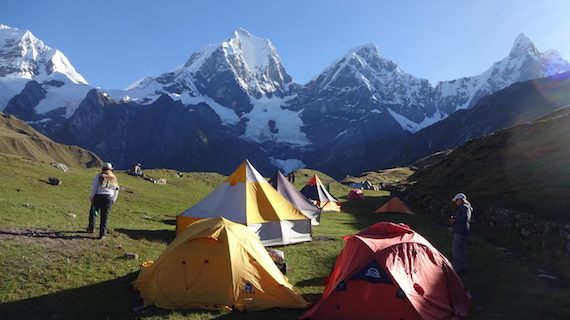
One of the most beautiful campsites of the trek: Carhuacocha
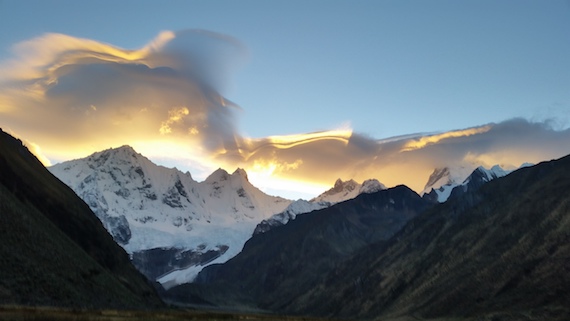
Sunset with views to the Cordillera Huayhuash
Camping During the trek, you spend the night in two-person tents. The selection of camp sites depends on the reachable water points and takes into account – as far as possible – scenic spots. In the Cordillera Huayhuash there are countless dream camps on highland lakes at the feet of snow-capped peaks.
Meals During the trek we pay attention to a healthy and high-calorie diet. Breakfast and dinner are cooked warm. For lunch, a box lunch is served. We can prepare vegetarian dishes on request.
Transport We use minivans or comfortable 4×4 off-road vehicles, depending on the group size.
Luggage Donkeys carry your luggage during the trek, you only carry your daypack.
Group Size Should we not reach the minimum group size of 9 trekkers, we charge an extra fee to guarantee the departure. If you by then not agree to trek in a smaller group, we can still give you back the full deposit payment.
- 5-8 pax: +300 USD per person
- 2-4 pax: +500 USD per person
Private Group Service All our trips can also be booked as private group service with tailor-made itineraries and trip inclusions. Contact us!
- Bag to load on the donkeys
- Head torch (with spare batteries)
- Well-worn in hiking boots
- Down jacket
- Rain jacket or poncho
- Fleece or warm pullover
- Comfortable clothes (quick dry, merino)
- Trekking trousers
- Long thermal underwear (merino)
- Cap, gloves
- Sunhat, sunglasses, sunscreen (min factor 40)
- Hiking poles
- Sleeping bag -10° comfort
- Toilet paper and wet wipes
- Personal medication travel kit
- Water bottle and water purification pills
- Extra Snacks (your favorite chocolate)
- Extra money
- How do I prevent altitude sickness?
- Are there any toilet facilities during the trek?
- Are there any showers at the campsites?
Some basic rules:
- Do not climb too fast, allow several days for a gradual acclimatization
- It can be very useful to take a break at around 3,000 m for a few days
- Drink more than enough water
- Do not drink any alcohol
- Cure infections and other diseases beforehand
- Do not take sleeping pills
- Carbohydrate-containing foods, as they consume less oxygen than fats and proteins
- Drink coca tea or chew coca leaves
Yes, there are very basic toilet facilities at the campsites of the trek.
No, there are no showers at campsites. The only option is at the Viconga hot springs where you can swim and relax.
LEAVE YOUR COMMENT

2-FOR-1 GA TICKETS WITH OUTSIDE+
Don’t miss Thundercat, Fleet Foxes, and more at the Outside Festival.
GET TICKETS
BEST WEEK EVER
Try out unlimited access with 7 days of Outside+ for free.
Start Your Free Trial
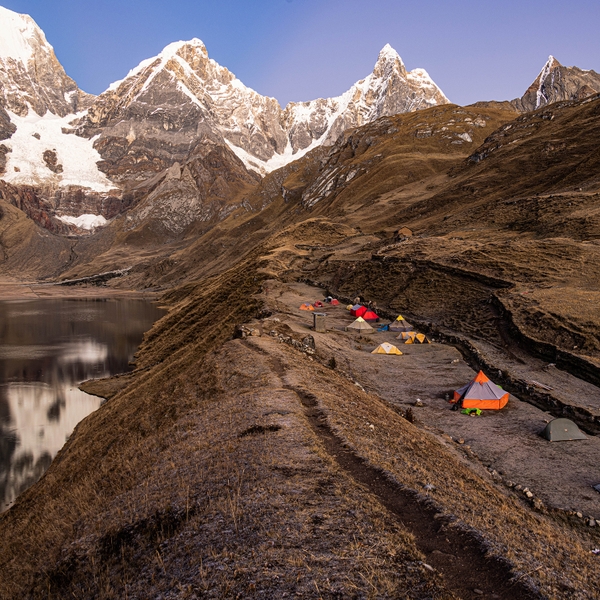
The Cordillera Huayhuash of Northern Peru Is Jagged, Raw Beauty
Travelers may think of the Himalaya and Patagonia when it comes to life-list trekking. But the Huayhuash circuit in Peru is an equally spectacular cultural immersion and takes you by the mountain made famous in the film Touching the Void.
Heading out the door? Read this article on the Outside app available now on iOS devices for members! >","name":"in-content-cta","type":"link"}}'>Download the app .
Darcie Reed and I had been hiking for four hours along a red- and iron-orange dirt path augured into the steep Andean hillside at almost 15,000 feet when, before a bend in the trail, Gilf Laurente stopped us.
“Close your eyes,” Laurente, our guide, who is from Huaraz, said, “and hold my hand.”
As we rounded the corner, he ordered, “Open your eyes.”
Before us, towering over the lake where we’d camp that night, was the faceted, glacier-cloaked spire of Jirishanca, known as the Matterhorn of the Andes for its sharp, tilted summit. The air was thin, but the view of Jirishanca, at 19,993 feet the highest peak in Peru’s Cordillera Huayhuash, took my breath away.
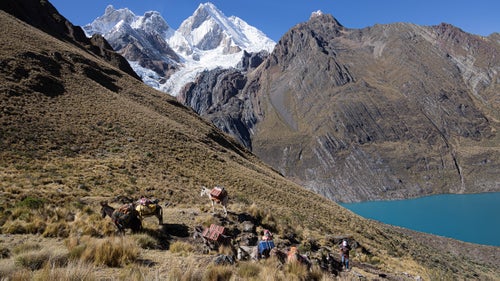
The Cordillera Huayhuash is a remote, stand-alone cluster of mountains in Northern Peru containing seven peaks over 19,000 feet. This tight group of peaks is firmly off the radar of most international trekkers, many of whom opt for more popular, hence congested, hikes like those of Nepal’s Annapurna Circuit or the Torres Del Paine Circuit, in Patagonia. The latter offers a few appointed huts, while the Huayhuash is raw wilderness, with no huts. Darcie and I, from Maine and New Hampshire respectively, had opted for a six-day trip focused on the northern half of a large trekking circuit. Our variation, while over fifty miles and with four passes at 15,000 feet or higher, is doable in two weeks, door to door. (The full eighty-mile circuit is more difficult to accomplish for someone with limited vacation time.) This version is a selection of high points and the most scenic vantages of all. At even the first peek of the snow-white, toothy Huayhuash, Darcie said, “This is unlike anything I’ve ever seen.”
I first heard of the Huayhuash Circuit, as it’s colloquially named, after seeing the 2003 film Touching the Void and subsequently reading the book of that name . In 1985, descending in a storm from the difficult first ascent of the west face of Siula Grande, a 20,800-foot peak here in the Huayhuash, Joe Simpson fell, breaking his knee. His partner, Simon Yates, doggedly managed to lower him on their rope almost all the way down the mountain. Yet as they neared the base, in the wind and whiteout conditions, Simpson was accidentally lowered over a cliff, reaching the end of the rope still in midair. Above, Yates was slowly being pulled from an insecure stance, requiring a decision: Cut the rope, or both die. Amazingly, both climbers survived, but Simpson, believed to be dead, crawled alone over five miles to camp, showing up five days later. Little did I know when reading the gripping story that nineteen years later I would camp beneath the peak myself.
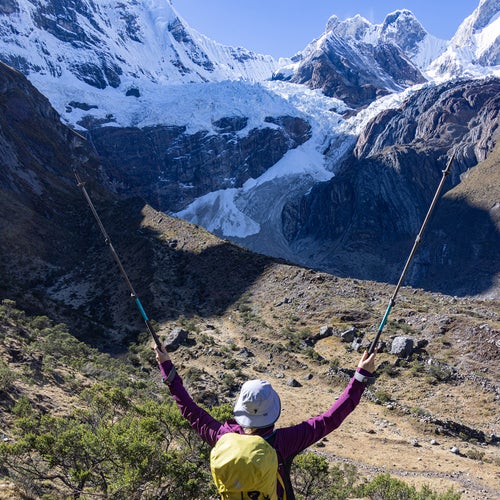
In July 2022, Darcie and I hired Gilf Laurente and Maruja Colonia, friends of mine from a 2008 expedition to Peru, as our guides and outfitters. Fourteen years ago they had outfitted my partner and me to climb a series of peaks, including Ischinca and Urus Este, in the more accessible Cordillera Blanca. That range hovers above the city of Huaraz, often referred to as “the Chamonix of South America.” At 10,000 feet, Huaraz is the jumping-off point for most treks and climbs in Peru’s Andes. Huaraz is an eight-hour drive north of Lima, the closest major airport. From Huaraz, most trailheads are within two to three hours, while the Huayhuash is another five hours north beyond those. That extra distance leads to a paucity of crowds.
Any visitor to the Huayhuash or the Blanca should spend a day in Huaraz and another on an acclimatization hike there. We took those steps and then, like most who follow them, did well on the trek without suffering from altitude illness. I am a travel, family, and wilderness-medicine physician, and we were armed with all the requisite medications; we even had a “hospital horse” saddled with an oxygen tank in the event of a Covid strike, but never needed it.
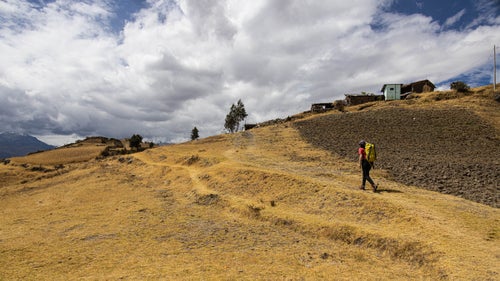
Darcie and I were the only clients on this trek, hiring our guide and staff for a private holiday. The price tag for our journey would be steep in other great ranges such as the Himalaya, but here it is quite affordable. Laurente and Colonia, a married couple, have been running their outfitting business, Colonia Adventures, for over twenty years. Colonia’s father was the first person to arrange guided treks and climbs in Peru. I learned of Colonia and Laurente in 2008 from a friend, Maury McKinney, then co-owner of a climbing school in New Hampshire. (Colonia and Laurente later named their son, now nineteen, Maury. That’s how much they treat you like family.) Darcie and I paid full freight, and, from wheels down in Lima until takeoff, the trek was $1,950 per person, all inclusive. If you opt for a bus instead of a private car from Lima to Huaraz, cut that in half. It felt like a small price to pay for excellent guiding in a region with rich culture and spectacular terrain. The peaks are raw and staggering in proportion, the glaciers azure, and the land stretches through this mountainscape to the horizon.
The days are long; you hike 10-12 miles on average with mules carrying most of your load. A mule driver, cook and guide are the staff. The schedule was always the same. Wake at six a.m. to tea brought to you in your sleeping bag by the cook. Breakfast, which is typically omelets or the like, is at six-thirty. Hit the trail by seven to cross a high pass by noon. Trailside lunch, something like nicoise salad brought by the cook, as you take in the views. After another seven hours of trekking, you arrive at camp. Your tent is up, and so are the appetizers. Fried bread would precede Lomo Saltado, a traditional beef-and-vegetable Peruvian dinner.
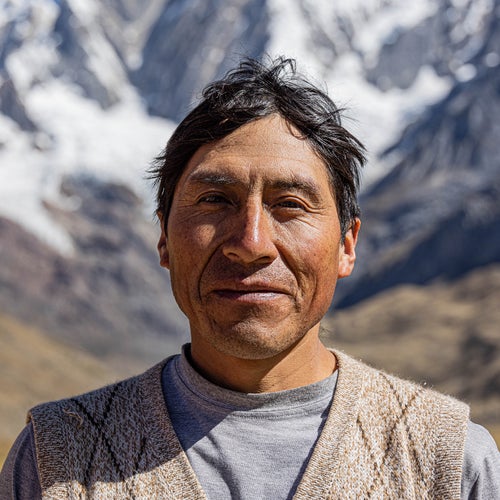
Huayhuash camps are scarce. There are no cairns, nor trail signs. So a guide is nice to have. It’s wild country, with gauchos and free-range livestock all around. Glaciers cling to giant faces, their sloughs sending roars up the valley. Heathered arms encircle flows of ice, as condors glide above.
Laurente is far more than a guide. He’s a virtual naturalist. One of the few certified climbing guides in Peru, he runs a government-sponsored school to train other guides. Technical climbing skills are a requisite part of the training, but he has also developed a deeper curriculum, which takes four years to complete. The program requires fluency training in Quechua, the local language, as well as English, and knowledge of the flora and fauna of the region, as well as climatology and weather forecasting.
This very doable trek might take in the most stunning alpine skyline I’ve ever seen, eclipsing those I’ve experienced in Patagonia, Alaska, and the Alps. The sight of jagged spires and pouring glaciers rewards you for each day’s effort. Each night you may be a mile or less from each glacial panorama, and the light of the sunrise and sunset illuminate the ice, making it glow to a warm, yet eerie, degree. We trekked during a new moon with perfect, cloudless weather. Each night, after all the others were asleep, I gazed at the celestial Southern Cross, almost believing it was just me and it.
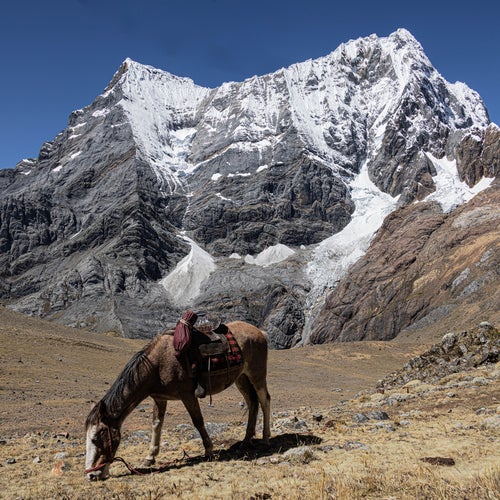
The most difficult part of the trek had been getting here. From my New Hampshire home, it’s a full three days of travel just to reach the trailhead. But once we arrived and got underway, we went a full three days without passing another trekker. Laurente would stop to point out medicinal plants, like Caramati, which relieves stomach pain, or Escozonera, which cures cough—all according to shamans. He shared his belief in the mountain gods, who allow us safe passage. Lore has it that the Northern Peruvian gods like sugar, so at each pass Laurente would press his hands together, silently thank the gods, and leave a piece of candy for them to enjoy.
The first time he spoke of the gods was at our initial camp, on the shores of the aqua-colored Jahuacocha Lake. “Mother Earth made this land and protects it,” he said. “Father of the Mountains allows us to visit and enjoy. They deserve recognition. We owe them.” Seeing the grandeur of the peaks, I almost began to believe this range is the domain of a higher deity. Each time he prayed and gave thanks, I came closer.
Over the week, we circled the entire northern half of the range. We’d cross through the paramo, or high grasslands, to keyhole passes with far vistas. Darcie, each time, would say, “Unbelievable. We’re so fortunate.”

The weather was bluebird that week, a gift Laurente attributed to the gods watching out for us. We passed stone walls, some of them up to 800 years old, still used to corral sheep and livestock. Most mountain villagers are shepherds, and a stone wall never falls out of use. Laurente was raised a shepherd, by a shepherd, before transitioning to his current role.
Our last pass before dropping down to Laguna Carhuacocha was our highest, at 15,800 feet, and brought the most stunning views yet. Four jagged spires, each over 19,000 feet, with tumbling glaciers, studded the skyline. The leftmost peak was Siula Grande.
Looking at its hulking north face, one aspect around from the site of Simpson’s accident, Darcie sighed. “Can you believe he lived?” she asked. I took a sip of cold, clean water and recalled how Simpson nearly perished of thirst, surviving by slurping water from shallow mud puddles.
Our discussion faded into silence as we gazed at Siula Grande and its taller neighboring peak Yerupaja. I saw Laurente scramble up a scree slope to our left. He returned a few minutes later and handed me a perfectly preserved fossil of a clam shell. He said, “Eighty million years ago this was all under the sea. Isn’t it amazing?”
I fervently agreed, then asked, “Is that what you were doing up there, looking for fossils?”
He chuckled. “No. I was praying to the mountain gods. And today, mi amigo, they rewarded us.”

Getting there: Fly to Lima. From there a number of companies offer luxury buses with hot meals that will take you eight hours to Huaraz. Or use a private car arranged by your outfitter.
Guides: Colonia Adventures can arrange all your needs, from fully guided trips to stripped-down outfitting. Find them on Facebook here .
Prices range vastly based on your needs, but for under $2,000 you can arrange a private ten-day trip. Group prices are lower. Laurente also guides technical mountaineering climbs in this range, including the easier peaks in the Ishinca Valley and also the behemoth 22,500-foot Huascarán (he’s led clients up it over a dozen times). His guest house would be your basecamp for the Huayhuash Circuit trek or other local adventures.
Numerous other companies, many European, also guide the Huayhuash Circuit. Most subcontract local Peruvian guide services for logistics, so hiring from those companies may mean paying a commission you could avoid. American companies such as Mountain Madness and Alpine Ascents have traditionally led treks in Peru, but paused since Covid. As of press time they weren’t offering Peru treks on their websites. Two local reputable outfitters are www.huayhuash.com and www.wildernesstravel.com .
Gear and weather: Count on below-freezing temperatures at night, and 70’s during the day. Peru is equatorial, so these temperatures are reliable year-round. The wet season is fall and winter, so the best time to visit is late North American spring into summer.
- Hiking and Backpacking
- Photography

- Huaraz – Huayhuash Trek
- Individual Tours in Peru
The Huayhuash trek on the mountain range is one of the most beautiful treks in the world – and it’s easy to believe.
The villages Pocpa and Llamac are usually the trailheads for this trek.
The entire length of the Cordillera Huayhuash ranges only 30 km but within its compact area lays amazing towering peaks. At almost every turn, you come face to face with glistening vertical walls of ice, snow and rock. Beautiful lakes, different kinds of birds and keep an eye out for the massive Andean Condors and for Siula Grande 6,344 m.s.n.m , the site where the popular book and motion picture “Touching the Void” took place!
- Entrance Fee: Camping fees (This varies per year, please ask current rate, approx. 260 soles
- Maximum altitude : 5200 Meters (Santa Rosa pass).
- Location: Cordillera Huayhuash.
- Average temperature : Between 13° C – 23° C during the day/ -3°C to – 1°C at night.
- Distance: 70 Km
- 06 Days/ 05 Nights
- April to October
- Easy-Moderate

Travel Program
Day 1: huaraz - transfer cordillera huayhuash at 9:00 am – via chiquian village -camp matacancha camp (4150 m).
Leaving Huaraz at 9am, arrive to the first campsite at 3pm aŌer a lunch stop in Chiquian. There is no hiking on the first day. After arriving, relax and enjoy the view of Rondoy mountain and the valley, where there is often spectacular sunsets.
Driving 4 hours approx
Overnight Camping
Hiking 5 Hours approx
B/L/D
Day 2: Camp Matacancha Camp (4150 m) - Mitucocha - Trekking Punta Carhuac Pass (4640 m) - Laguna Carhuacocha (4200 m)
Hiking 8 Hours approx
Day 3: Camp Carhuacocha - Trekking Siula Pass (4950 m) / Laguna Quesillococha - Huayhuash Camp (4450 m)
Day 4: huayhuash camp - trekking to pass trapesio (5041 m) / elefante camping over (4400 m).
Wake up early for the Trapesio pass at 5,041m, with an optonal 40 extra minutes of hiking to reach the glacier Then descend while passing 5 beautiful lakes to reach the campsite Elefante Camping at 4,400m. Approximately 6-7 hours of hiking to reach the campsite. It is also optional to hike 2 hours from the campsite to San Antonio pass at 5,100m.
Hiking 7 Hours approx
Day 5: Camp Elefante - Trekking up to the Pass Santa Rosa (5100 m) - Trekking Down to Village Huayllapa at (3487m)
Day 6: from village huayllapa - with public transport to the city of barranca and return to huaraz, or you also have the option of continuing to go to lima.
Waking up at 1am in Huayllapa, say goodbye to the staff and take a car to Barranca on the coast. From Barranca there is an option to go by bus back to Huaraz or conƟnue to Lima. Both the bus to Huaraz or Lima are not included in the price of the trek.
Overnight Hotel
Hiking No more hiking
Driving 8 hours approx
B/L/-
Included meals: B =breakfast; L =lunch; D =dinner
What's Included
Services included in the prices:.
- 5 MEALS PER DAY: (breakfast, snack, lunch, tea time, dinner).
- BREAKFAST: Omelet, pancake, fruit salad, serial, scrambled eggs… coffee, tea, milk, chocolate, butter, jam, cheese etc.
- SNACK: fresh fruit, chocolates, crackers, cookies, sweets drinks.
- LUNCH: salads, soups, rice, chicken, coca tea.
- TEA TIME: different hot drinking’s, coffee, tea, milk, chocolate, crackers, popcorn, and Tequeños.
- DINNER: different kind of soups, salads, main courses, pasta, chicken, trout, beef, vegetarian options available, dessert, hot wine
- One free acclimatization tour, you can choose; ( lake Paron , Lake 69 , Glacier Pastoruri ) Information: www.huaraz.viajes
- One free night at Hotel Valery; www.hotelvalery.pe
- Entrance Fee Huayhuash community (250.00 soles) per person
- Tent Superior (04 season) special for Huayhuash trek
- Sleeping mat: Size, 200 cm X 60 cm X 5 cm
- Kitchen tent
- Dining tent
- Certificated Trekking guide: (Speaks English and Spanish)
- Certificated cook
- Donkey driver
- Emergency Horse
- 05 Kilos personal Luggage for the Donkeys
- Kitchen and dining full utensils.: Chair, table, stove, gas, plates, caps, forks
- First aid kit
- Private transport
- Hot water every day in the morning to clean up your hands and face
- Boiled water to fill your bottle every day
- For traveling with us we give you a gift: A cap, a buffet and a t-shirt
Not included:
- Personal Trekking gear.
- First day breakfast.
- Travel accident and health insurance.
- Transfer – Airport/hotel/airport /🕸️🕸️bus station/Hotel – Lima.
- Bus ticket Huaraz/Lima.
- Travel luggage and Travel cancellation insurance.
- Not mentioned food (restaurant) and beverages.
- Personal Spending.
We Recommend To Bring :
- Hiking boots.
- trekking socks (synthetic fibers).
- Hat for cold weather (fleece or other).
- microfiber shirts and thermal.
- Trekking pants.
- Sunglasses.
- Day Backpack or advance 20-30 liters.
- down Jacket.
- waterproof jacket (Gore-Tex or other) seasonal.
- Waterproof Pant (Gore-Tex or other) seasonal.
- Waterproof Layer seasonal.
- Headlamp (with extra batteries and bulbs).
- Sunscreen (lips and skin).
- Personal First Aid Kit.
- Photographic Material.
- Wash bag and towel.
Hiking poles.
Toilet Paper.
What to Bring
What to Bring or take fo Day Hiking and Technical Equipment for Climbing Expedition
This equipment list is compiled to provide you with adequate help when choosing your equipment for a climb. Most items are required. Please consider each of them and make sure you understand the function and exclusive use for mountaineering, before substituting or removing items from this list. Please note that this list has been carefully annotated by the organizer. Remember that mountaineering, climbing or mountain expeditions tours is an extreme, risky sport, therefore everything related to it is of great attention.
Equipment Trekking
Equipment Mountain
Dressing appropriately for the mountains can make the difference between a pleasant trip and a really uncomfortable one. Clothing must provide the right degree of temperature, perspiration and be well ventilated. Preferably cotton clothing should be avoided, as in humid conditions they absorb body heat.
In general, the weather conditions in in the Andes of South America can vary from day to day and even throughout the day. Therefore, clothing must be versatile.
Please do not hesitate to contact us with any questions you may have regarding the necessary equipment.
→ If you need to rent mountain equipment click here :
Prices & Dates
PRICE (USD)
TRAVEL STATUS
01 MAY 2024 / 06 MAY 2024
01 JUN 2024 / 06 JUN 2024
01JUL 2024 / 06 JUL 2024
01 AUG 2024 / 06 AUG 2024
- Single Supplement (I want my own room and tent) – $000 on request.
Please note: Insurance for emergency evacuation is required for this trip. Call for more details.
» Additional dates available upon request » Rates may vary from July 26th to 31th for the national holidays
Prices (per person):
Deposit for reservations: — USD (– EUR) ✓ Full payment 40 days before. No refund if you cancel less than 30 days!
3% early bird discount when booking 6 months prior to departure 2024
Legend Booking-information: EZZ Single room supplement 🟢 On this trip, places are still available. 🟡 On this trip, only a few places left. 🔴 This trip is sold out / closed.
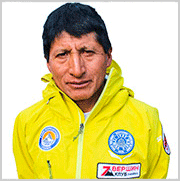
Juventino Albino Caldua
Expert guide certified by IVBV - UIAGM - IFMGA Co-Founder, Peru Expeditions
- WhatsApp: +51 943 081 066
- E-Mail: [email protected]

Hans Honold | Certified Mountain and Ski Guide
For a trip with a Professional Certified Mountain Guide from abroad with your own language that you speak, please request us to get in touch. We have guides working for our company from all over the world who are members of IVBV/UIAGM/IFMGA Certified Guides.
- Tel: +49(0)7344 929144-0
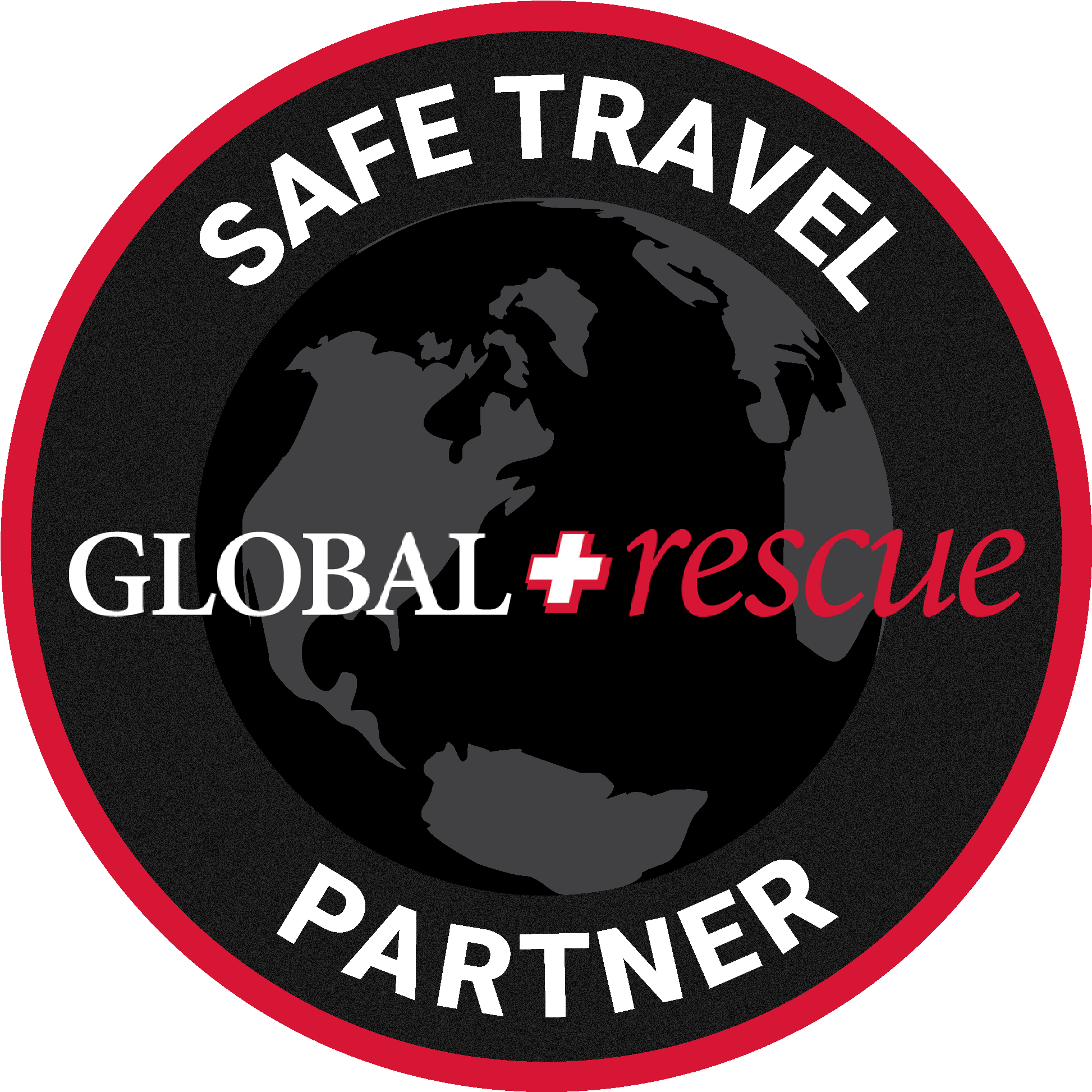
It is very important to have accident coverage for trekking and climbing mountains, more if you go a technical mountains over 6 thousand meters, we oblige and recommend buying travel insurance with our partner Global Rescue, you get the peace of mind that the finest medical, security evacuation, field rescue, intelligence and telehealth.
- Tel: +1 (617) 459-4200
Only $1000 deposit to book
Pay over time, interest free
No booking fee, no change fee
24/7 support
Accommodations
Scroll through our exclusive accommodations for this trip below. Although very unlikely, we will be able to make substitutions when necessary. The comfortable accommodations that guests stay in every night offer comfort, the level that these options are are 3 stars and some hostels in some towns of first class quality to make your stay very pleasant. *These exact accommodations are not guaranteed. In some cases, alternative accommodation of similar quality and location can be used.
Peru: Hotel Conde de Lemos Arequipa
Best mountain tents – luxury service – premium overnight in camping, peru: hotel rumi wasi in chivay, peru: hotel conde de lemos puno, peru: hotel inca wasi plaza cuzco, peru: hotel puma, peru: hotel rubi, peru: hotel churup, peru: hotel valery, peru: hotel kamana, maps & downloads.
- Weather Forecast
- Location on Google Maps
- Detailprogramm [DOC/PDF]
Frequently Asked Questions
What our travelers or clients always ask questions before joining our trips, tours & expeditions, read all the information provided here.
Suggested FAQs
What experience and how fit do i need to be to climb this mountain is this program suitable for children or older people.
For our mountain climbing trips: If they are easily accessible mountains: For easy-climb mountains, well, you don’t need much experience, but if you already want to climb mountains above 6,000 meters and the conditions become more difficult, we recommend if you already want to go through mountains above 6,000 meters, have a basic or intermediate course for a good preparation. It is very important to be physically, technically and psychologically prepared.
Regarding the preparation of children: Everything will depend on which mountain you want to climb with your children, once you are clear on which of our tours or mountains you want to go with your children, we can give you some advice or see how to prepare them before going with they.
Regarding older people: It all depends on the condition of experience and how well the person is in health, on many occasions older people are the best to walk in the mountains because they have more experience, so it is always good to ask and find out about their experience of older participant. If you have any other questions, please contact us. For calls or inquiries to this number: +51 943 081 066
Will I need to bring any technical equipment of my own? Is it possible to rent equipment, and if so, what would be the approximate cost of that?
In all our trekking or mountaineering trips we do not include personal equipment in our prices, so you have to have your own equipment: Personal equipment (such as boots, ice ax, crampons, harness, sleeping bag, mat, Goretex, etc. ) and also within each page of the trips that we sell is a small list so you can see it on our website.
Our company can also rent the materials that you would need for your trip, see the list here on our website: https://peru-expeditions.org/equipment-rental/ . For calls or inquiries to this number: +51 943 081 066
Are there any other special requirements such as permits/insurance/vaccines that I need to consider before the tour?
Safe and effective vaccines are available that provide strong protection against serious illness, hospitalization and death from COVID-19. Billions of people have been vaccinated against COVID-19. Getting vaccinated is one of the most important things you can do to protect yourself against COVID-19, help end the pandemic and stop new variants emerging.
We also recommend having accident insurance, we always recommend. We are Partners –Global Rescue. If you have any other questions about the trip we can schedule a date for a calling via WhatsApp. For calls or inquiries to this number: +51 943 081 066
What experience do I need to have? How fit do I need to be? Is this program suitable for children or older people?
To do long-distance hiking you need to at least train or do some tours such as visiting lagoons to get the experience and feel comfortable with what you do, it is always good before doing a long-distance hiking tour to test yourself so as not to be with the problems of altitude sickness during the trekking, and if you travel with children it is good to first train them before taking them, if they are accompanied by an adult of legal age, they must do a good acclimatization before going on the long-distance tour or with high altitude camps If you want to know or learn more advice, we can schedule a call via WhatsApp to clarify your doubts. For calls or inquiries to this number: +51 943 081 066
How far in advance should I start training and what kind of training do you suggest?
The preparation is according to what type and what technical level you want to go and climb a trek or mountain, the preparation will always gain experience little by little.
For this type of demanding or technical climbing sports, it is recommended to do some summits above 5 thousand meters beforehand and have good knowledge of high mountain technical equipment such as the use of technical ice axes, ice screws, correct use of crampons, and of course all the technical material. For more information, we can schedule an appointment to be able to explain in more detail everything about the mountain equipment and the preparations prior to joining our outings. For calls or inquiries to this number: +51 943 081 066
What is the average distance and altitude gain that we will hike each day?
Every day we have active walks around approximately 4, to 5 sometimes 6 hours of walking, everything is according to your pace and physical condition of each person, in each of our travel programs you will find more detailed information, and if If you need more information about each day of the travel program, we can schedule a call via WhatsApp to clarify your doubts or questions, for this please contact us. For calls or inquiries to this number: +51 943 081 066
Will there be porters to help to carry group and personal equipment?
In our trips, either hiking or mountaineering: Depending on the type or destination of the trip that you are going to book, in some parts of the treks you go with mules or donkeys or sometimes with horses, and within the mountain trips, the approach camps are also They go with mules or donkeys, but there are some stretches where pack animals can no longer reach. In this part, our logistics is fully supported by the porters.
Who are the porters? They are people from the area who were born and live in the heights of the towns, they are very strong and are very acclimatized, the reason is that after the tourist season ends they dedicate themselves to agriculture and livestock for that reason they are people They are used to the altitude and have lived in nature all their lives and they are happy to be in the mountains together with our expeditions. For calls or inquiries to this number: +51 943 081 066
How will accommodation and meals be handled during the trek?
About accommodation or meals during the tour: Well, depending on the type of tour, when the tour is a classic cultural tour or a city tour, we eat during the route in tourist restaurants and sleep in category hotels that the client has requested.
If the tour is with camps and trekking: During the activity, logistics we include the service of Breakfast, Lunch, and Dinner with traditional and typical meals of the region where you are going to travel with us, during the night we stay in tents, and we have a special tent for the kitchen and another for the dining room.
If the trip is at altitude or in the mountains: We bring special high mountain food, It are quicker meals to cook and we provide complete logistics such as Breakfast, Lunch and Dinner, and we sleep in special 4-season high mountain tents, with the best tents. If you have any questions or concerns, we can schedule an appointment via Whatsapp to clarify all your doubts and give you better information so that your trip is an unforgettable tour.
What is the guide-to-client ratio to climb this mountain?
In mountains above 5000 meters: A local guide takes a maximum of 3 clients = Ratio 3pax = 1 local guide
In technical mountains: In large-big mountains we manage the travel policy, a guide and a maximum of 2 clients = Ratio 3pax = 1 local guide. For calls or inquiries to this number: +51 943 081 066
What is the best time of the year to climb this mountain?
For all the trips that we offer within our main tourist destinations such as South America and Central America, also including the ascent of the 7 continents and the 7 highest peaks of each continent, on each page of our website for each trip we indicate that month or what season to travel, then please read the information you find in our travel offers for each tour. If you have any other questions you can contact us by WhatsApp with one of our travel experts. Thank you so much. For calls or inquiries to this number: +51 943 081 066
Do I have what it takes to succeed on this expedition?
In the interest of the team’s enjoyment and success, we work with every single guest to ensure they are properly prepared and ready for this expedition. We pride ourselves on vetting every member to make sure that the team can bond and succeed together. It really sucks to be grouped with members that are much faster, or much slower, than you are. No one wants to the weakest link on a trip like this. By setting expectations and a solid training plan, we work to insure maximum cohesive success. Use this trip as an exercise motivator, and we will succeed together with style.
How can I get to the trailhead/meeting point?
For the pick-ups of each trip, depending on the place or the trip that you are going to make with us, the meeting point is always at our office, in one of our trips we pick you up where you are staying or staying, or in some cases a A representative of our company will pick you up and then ship you to your transport to continue with your destination of the tour or trip you have booked with us. If you wish to request more information, do not hesitate to contact us. For calls or inquiries to this number: +51 943 081 066
What is the best time of the year for this hike?
What happens in the event of bad weather.
About the meteorological conditions of the climate, we try to organize the trips of each tour in the best season to have the best views and enjoy the selected trip but sometimes even is good season we can have bad weather, in this case on hiking or treks trips The complications are minimal, but when this happens during high-altitude climbing expeditions, the complications can become very difficult, that is why the bosses or leaders of the local guides must always make the most correct decision for the safety of our passengers, so we always recommend listening to the best advice from the local guide assigned for each tour. If you have any other questions please contact us. For calls or inquiries to this number: +51 943 081 066
Can I join a group?
We as a local company and connoisseurs of tours have departures on different dates. The best thing to do is to join a travel group to take care of your budget, and of course you can join our groups, but on trips like mountaineering we recommend going in small groups. To join a group, ask us for the dates and we will send you the necessary information to be able to join any of our trips.
Why go in a private trip: For trips whether trekking or high mountains, going privately is the most recommended option, but the costs are more expensive. So, if one joins a group, the prices will be more reasonable. In the mountains, the only disadvantage is if you are in a wall with another partner and if one of the participants gets tired or gets sick. In this case, you have to abort or cancel the summit and return together. For more information, contact us. We can schedule a call via WhatsApp to clarify all your questions.
In a mountain, for example, if 3 people go and one of the participants falls ill on the route, for security reasons they have to cancel or abort the summit or return all together. The same in a technical mountain if the climbing partner gets sick they all have to return, for these reasons sometimes it is better to go private only because for a single person the costs are more expensive for the same reason that the trip would already be private .
For more information please contact us. For calls or inquiries to this number: +51 943 081 066
Additional information
Vaccinations, first aid kit, why choose us, join a group.
VISA NEEDED
Citizens traveling for tourism purposes are exempt from the visa requirement for up to 90 days.
The passport must be valid for at least 6 months from the date of return to the country.
There are some countries that have some restrictions on the visa to be able to visit some countries in the world, for this important information request us to be able to give you more exact information, since the information changes every year and then to be able to provide you for more accurate updated information, → contact us!
CURRENCY EXCHANGE DEPENDING ON WHERE YOU ARE:
Local money | $1 = 000 | EUR 1 = 000 = Let us to know which destination would you like to travel to so we can send you the current information of the day to your → E-mail, or by WhatsApp.
Local currency is exchanged on site. You can change both dollars and euros, the two currencies are the most used. We recommend taking bills of different denominations.
ATMs are available in the larger cities. Attention! We avoid dollars from the years 1996-2006 (some series from these years are not accepted at all). It is better to take dollars issued after 2006 to better the most recent of the current year.
VACCINATIONS BEFORE YOU LEAVE
Compulsory vaccinations :
– They are not required
Recommended vaccinations : – Hepatitis A and B (3 doses: 0/1/6 months, at least 2 doses administered at least 2 weeks before departure) – Tetanus – Diphtheria – Typhoid fever – Yellow fever (yellow fever) – Antimalarial prophylaxis is recommended for traveling in the jungle area
In some destinations that you are going to visit, the information that is on our website may not be updated. To have more precise information, contact us by → E-mail or WhatsApp and we will provide you with more detailed information.
TRAVEL FIRST AID KIT
Everyone should have a personal first aid kit, and in it: medicines against diarrhea and stomach problems (sometimes appearing when the bacterial flora changes), painkillers and medicines for the throat. In addition, good creams with a UV filter or so-called blockers (sun radiation in the mountains is very high).
ATTENTION! Due to parasites and bacteria for drinking, we recommend using mineral water in the original bottle and boiled. To have more precise information, contact us by → E-mail or WhatsApp and we will provide you with more detailed information.
WHO ARE WE AND WHY CHOOSE US?
We are a travel agency that provides authentic and innovative experiences with a respectful relationship with the socio-cultural customs, the environment and the regulations of the countries we promote. We are characterized by the personalization of our tourist services, with empathy, attitude and professionalism; turning customer dreams into reality and exceeding their expectations. We are “Registered Travel and Tourism Agency”. To know more about → US click here please!
ARE YOU LOOKING FOR A TRAVEL PARTNER?
Join a group with us: Trekking, hiking and expeditions. What is your profile? Are you planning to go on a trek or expedition in South America and you are not yet sure about the most suitable offer? If you are looking for a partner, we have the solution. Peru Expeditions Tours has some groups that you can join and share you experience with on an unforgettable journey. (» Upcoming Trips / Upcoming Departures / Open groups / Confirmed / Trips Guaranteed 100%) » WHERE WOULD YOU LIKE TO CLIMB, WALK, HIKE, AND TREK? For more information please click here! → JOIN A TRIP WITH US!
Why Travel with us
Your safety is our priority, expert guides, sustainable tourism, andean chefs, food on the trail, small groups.
- Recommended Tours
Variant Huayhuash Trek Pass Cuyoc & Cutatambo 5
Huayhuash range trek to cajatambo village 5, huayhuash range trek demanding alpine route 5, cordillera huayhuash and diablo mudo 5.
YOU ARE AN ADVENTURE LOVER and you want to experience something extraordinary and extreme?
You are an adventure lover and you dream of leaving with a thrill. Peru Expeditions Tours is also an option for you. Take advantage of our travel offer that we have for you!
“We don’t sell tours, we provide memorable lifetime experiences.”
We are a recognized tour operator 100% peruvian company that specialists in adventure and traditional tours service.
Privacy Overview

- Quilcayhuanca - Cojup (3 days)
- Olleros - Chavin (3 days)
- Santa Cruz (4 days)
- Laguna 69 + Santa Cruz (5 days)
- Ulta - Santa Cruz (6 days)
- Cedros Alpamayo (9 days)
- Cedros Alpamayo - Santa Cruz (11 days)
- Huayhuash Circuit (8 days)
- Huayhuash Full (10 days)
- Vallunaraju (5.686 m)
- Pisco (5.752 m)
- Yanapaccha (5.460 m)
- Ishinca (5.530 m)
- Tocllaraju (6.032 m)
- Urus, Ishinca & Tocllaraju (3 Peaks)
- Alpamayo (5.947 m)
- Artesonraju (6.025 m)
- Alpamayo & Artesonraju (2 Peaks)
- Chopicalqui (6.345 m)
- Huascarán (6.768 m)
- Laguna 69 (Hiking)
- Laguna Churup (Hiking)
- Chavin (Bus Tour)
- Pastoruri (Bus Tour)
- Rock Climbing (Adventure)
- Mountain Biking (Adventure)
- Group departures

Cultural and Adventure Holidays in Peru
Trekking and mountaineering cordillera blanca and huayhuash.
We invite you to enjoy your holiday in the Peruvian Andes "the land of the Incas" tours, trekking, climbing and expeditions. For adventure seekers we offer trekking and mountaineering in Cordillera Blanca and Huayhuash, with its stunning mountain peaks and lakes. Perfect place not only for adventure seekers, also to be inspired and appreciate the andean landscapes and the inca culture.
Cordillera Blanca & Huayhuash
- 3 days: Quilcayhuanca - Cojup , short trekking near to Huaraz.
- 3 days: Olleros - Chavin , ideal if you like adventure and culture.
- 4 days: Santa Cruz , the classic trek in Huaraz.
- 5 days: Laguna 69 + Santa Cruz
- 6 days: Ulta - Santa Cruz , trekking Santa Cruz extended version.
- 9 days: Cedros Alpamayo , recommended trek surrounding the "most beautiful mountain in the world".
- 11 days: Cedros Alpamayo - Santa Cruz , trekking in Huascaran National Park.
- 8 days: Huayhuash Circuit , short version of trekking Huayhuash.
- 10 days: Huayhuash Full , the classic trekking considered one of the best in the world.
Climbing Cordillera Blanca
- 3 days: Vallunaraju (5,686 m) , easy access and near to Huaraz.
- 2 days: Yanapaccha (5,460 m) , it can be combined with Nevado Pisco.
- 3 days: Pisco (5,752 m) , classic mountain for beginner climbers.
- 4 days: Tocllaraju (6,032 m) , located in the Ishinca valley.
- 7 days: Urus Este (5,420 m), Ishinca(5,530 m) & Tocllaraju (6,032 m) , 3 peaks climbing.
- 6 days: Alpamayo (5,947 m) , the most beautiful mountain in the world.
- 6 days: Artesonraju (6,025 m) , depicted in the live-action Paramount Pictures logo.
- 11 days: Alpamayo (5,947 m) & Artesonraju (6,025 m) , 2 peaks climb.
- 5 days: Chopicalqui (6,345 m) , one of the highest peaks of the Cordillera Blanca.
- 6 days: Huascaran Sur (6,768 m) , Peru's highest mountain.
We offer a variety of trekking and climbing combinations
- 7 days: Trekking Santa Cruz & Climbing Nevado Pisco (5,752 m)
- 9 days: Trekking Santa Cruz & Climbing Nevado Chopicalqui (6,354 m)
- 10 days: Trekking Huayhuash & Climbing Nevado Diablo Mudo (5,427 m)
- 11 days: Trekking Huayhuash & Climbing Nevado Pumarinri (5,465 m)
Day Trips Huaraz:
Trekking and climbing peru, holiday in peru 2024, cheap holidays 2024, last minute package holiday deals, huaraz - peru.
Trekking Santa Cruz South America, Lagoon 69 South America 3 star Hotel huaraz South America, Trekking Huayhuash, huayhuashperu, trekkingcordillerahuahuash, huayhuashtrek, trekkinghuayhuash, trekkingsantacruz Peru.
Tour Operator Peru
Last minute travel peru, peru: trekking alpamayo south america, peru: huayhuash circuit huayhuash trek, holidays in peru.
Trekking Santa Cruz, Trekking Huayhuash 10 days, Trekking Alpamayo, Last minute trek peru, trekking tour peru
Peru trekking, peru climbing, peru hoteles, peru guide, trekking cordillera blanca, huascaran expeditions, climbing huascaran, trekking huayhuash, climbing alpamayo, tours en huaraz, trekking santa cruz, climbing pisco, trekking cedros alpamayo, climbing vallunaraju, trekking santa cruz ulta, tours laguna llanganuco, climbing chopicalqui, trekking laguna churup, climbing artezonraju, trekking laguna aguak, tours pastoruri, trekking laguna 69, trekking olleros chavin, climbing urus, climbing ishinca, climbing tocllaraju, trekking laguna willcacocha, tours chavin de huantar, trekking santa cruz llanganuco, tours laguna paron, Travel agency huaraz, jatun machay, turismo peru, trekking laguna uruscocha, peru trekking climbing, tours en peru, peru treks, treks y hikes en huaraz, climbing ranrapalca, climbing quitaraju alpamayo, peruvian guides, climbing huascaran, mini trekking huayhuash, peru mountains climbing, climbing diablo mudo, climbing churup.
trekking cordillera huayhuash, trekking cordillera huayhuash prices, trekking cordillera huayhuash peru, trekking map cordillera blanca, best treks cordillera blanca, cordillera blanca trekking companies, huayhuash trek season, huayhuash trek huayhuash circuit, huayhuash circuit map, huayhuash cordillera, huayhuash map, huayhuash trek price, huayhuash trekking, huayhuash mountains, huayhuash trail, tailor made holiday peru
Climbing Artesonraju Mountain
Trekking huayhuash 8 days.
Peru trekking Peru climbing Peru hotels Peru guide Huascaran expeditions Huascaran Climbing Climbing Alpamayo Mountain Alpamayo Climbing Climbing vallunaraju Trekking Santa cruz ulta Tours laguna llanganuco Climbing Chopicalqui Mountain Chopicalqui climbing Trekking laguna churup Climbing artesonraju Mountain Climb artesonraju Tours laguna parón Turismo Perú Trekking laguna uruscocha Perú trekking climbing Tours in Peru Perú treks Rock climbing in ihsinca valley Treks y hikes en Huaraz Ice climbing in Peru Mountain bike Peru Peru treks Peru trekking Trekking Peru Travel agency Peru Peru tourism Peru vacation packages Inka trail Peru Peru trekking holiday Tourism Peru Peru holiday Travel Peru Machu pichu Peru Peru travels Peru machu pichu Peru expeditions Travel agents Peru Tour Peru Trekking in Peru Hiking in Peru Holidays in Peru Vacations in Peru Tours in Peru Peru Mountains climbing Peru travel agency Peru travel agencies Peru travel information Peru Mountains adventure travel Peru Adventure travel Company Adventure travel South America Peru Mountains climbing in South America Adventure travel companies South America Climbing Alpamayo Group adventure travel Trekking routes Trekking route Annapurna trekking Hiking Peru Peru hiking Peru hiking tours Peru tour operators Peru tour operator Peru tour Cordillera huayhuash trek Cordillera huayhuash trekking Tour operators Peru adventure trekking Trekking adventure Peru Peru holidays Peru trekking holidays Walking holidays Trekking holidays Holidays Peru South America tours South America tour South America travel Inca tours Trekking tours Group travel tours Adventure tour operators Adventure tour companies Adventure Tour Company Adventure tour Adventure tour operator Peru adventures Adventures Peru Small group tours Small group travel
Responsive web services Peru index.pe Web Hosting & Domains Peru: AndeanHost
We are specialists in organizing tailor made trips in Huaraz, Parque Nacional Huascarán, Cordillera Blanca and Huayhuash.


IMAGES
VIDEO
COMMENTS
Trekking Cordillera Huayhuash, Peru. For the intrepid traveller and avid hiker, trekking the Cordillera Huayhuash in Peru is a real bucket list moment. Located around 140km south of the city of Huaraz, this spectacular mountain range is one of the world's greatest multi-day hikes. And, for very good reason.
More demanding than southern Peru's Inca Trail and lesser known than neighboring Cordillera Blanca, the Cordillera Huayhuash suits most better as a postcard image than pursuable feat.From extreme altitudes to breathtaking (sometimes literally so) views, hiking the complete Huayhuash circuit has been noted as one of the most physically and emotionally challenging treks in the country, but ...
Doing the Huayhuash Trek in the Cordillera Huayhuash in Peru had been a dream of ours for over a decade. Although our expectations were high, the reality of our experience far exceeded them: eight high mountain pass crossings, surrounding peaks of 6,000+ meters (20,000+ feet), turquoise alpine lakes, stunning glacier-covered mountains, and a ...
There is no doubt that the Cordillera Huayhuash is among the most beautiful mountain chains in the world. Located in the Peruvian Andes in South America and measuring a mere 30km in length; this mountain range is an incredible compact cluster of enormous icy towers surrounded by cascading rivers, turquoise lakes, and with a great diversity of flora and fauna.
Cordillera Huayhuash circuit, classic trek. Going down from San Antonio pass to Cutatambo campsite. Considered by many adventure and nature lovers, as one of the most spectacular trekking circuits in the Andes. It goes all over whole the Cordillera Huayhuash in 12 days, crossing passes between 4600m and 5000m, camping near to the lakes located ...
Cordillera Huayhuash Trek Facts. The distance of this trek is 68 miles / 110km and takes 7-14 days to complete. Most people hike in a clockwise route. The maximum altitude on the circuit is 16,600 feet/ 5,060m. There is a total of 18,700 feet/ 5,700m of vertical uphill walking. Difficulty is strenuous.
Of the trekkers who visit Peru, most head straight to the Cordillera Blanca just north of Huaraz, enticed by the high concentration of peaks exceeding 6,000 meters (around 20,000 feet). However, the Cordillera Huayhuash (pronounced "why-wash")—just 19 miles long, 9 miles wide, and only boasting three summits over 6,100 meters—caught our ...
Huayhuash Circuit Trip highlights. Undertake the challenging 127 km circuit around the Cordillera Huayhuash in Northern Peru - some of the best trekking in South America. Trek among towering peaks over 6000m, cascading glaciers, alpine meadows and azure glacial lakes. Explore Huaraz and the stunning Cordillera Blanca.
Here is an example of a typical route through the Cordillera Huayhuash, this one taken from Huayhuash.com. Most companies will also allow you to add extra days of rest or to reduce the length of the trip via shortcuts on the trail. Day 1: Huaraz - Llámac - Cuartelwain 4170m. Day 2: Cuartelwain - Qaqanan pass 4750m - Mitucocha 4230m.
Named one of the 10 most beautiful treks in the world, the Cordillera Huayhuash circuit should absolutely be on your Peru itinerary. While this bucket list hike is not for the faint of heart, the magnificent views of snow-capped peaks, turquoise glacial lakes, rocky terrain, and mind-blowing views pay off all the challenges of the trail.
Huayhuash is a private conservation area managed by local communities. It's recognized as one of the best hikes in the world. And with only 5-7,000 visitors a year, it's much less crowded than the Inca Trail (which sees 500 people a day!). Huayhuash is already well-known in trekking circles, and mountain biking is available now, too.
Widely regarded as one of the best alpine treks in the entire world, the Huayhuash Circuit is a remote and impossibly scenic high-altitude route in Peru's Cordillera Huayhuash (pronounced why-wash).The trail, totalling 135km and crossing 12 mountain passes all above 4,500m, circles some of the highest and most impressive mountains in the Andes, offering surreal vistas of jagged snow-capped ...
The fourth day of the Cordillera Huayhuash is arguably the hardest day of the trek, taking you up to 5,041 meters above sea level. The El Trapecio Pass is the highest point of the entire trek. It is also one of the most surreal, providing views unlike anything you've seen thus far in the trek.
It has 30 peaks, 6 of them are over 6000 m. We'll be going over 8 passes - all of them between 4600m - 5000m in altitude, most of the walking will be done over 4000 m in altitude. The Huayhuash goes around the Cordillera Huayhuash, Peru, which is next door to its more famous cousin: Cordillera Blanca. All of the trek is over the treeline ...
Tackle one of the world's most spectacular mountain circuits in the Cordillera Huayhuash, a compact yet magnificent range that's richly glaciated, steep, and dramatic. Six of Peru's highest mountains rise from this striking massif. This classic, multi-day trek in the Peruvian Andes is challenging but rewarding, with unequalled views of its turquoise glacial lakes, jagged, snow-capped peaks ...
Cordillera Huayhuash Peru is an award winning hiking tour! Visit today with The Wildland Trekking company. We are the #1 travel company on Trip Advisor! 800-715-HIKE ... Our Peru Treks feature premier camping with comfortable sleeping tents, kitchen tents, dedicated chefs, and a team of porters to carry, set up, and break down camp each day. ...
Hike one of the most beautiful trekking circuits in the world.This is the most dramatic high altitude trek in the Peruvian Andes with magnificent views of mountains of the Cordillera Huayhuash such as Yerupaja 6634m being the second highest mountain in Peru, Siula Grande made famous by Joe Simpson in his book and film "Touching the Void", Sarapo, Rondoy, Ninashanca, Jirishanca, Rasac ...
The Huayhuash Classic Trek is one of the most beautiful treks in the world. With this route you can discover the most impressive areas of the Cordillera Huayhuash in just 8 days. We camp by the most beautiful lakes with impressive views of the largest mountains in the range, including the second highest peak in Peru, Yerupaja, the famous Siula ...
The Cordillera Huayhuash is a remote, stand-alone cluster of mountains in Northern Peru containing seven peaks over 19,000 feet. This tight group of peaks is firmly off the radar of most ...
Trekking. The range has become noted for trekking in the form of the Huayhuash Circuit, which is considered a challenge trail and is undoubtedly far more demanding than the famous Inca Trail in the south of Peru. Fewer people trek the Cordillera Huayhuash than the nearby Cordillera Blanca.The full circuit is about 130 km long and generally takes between ten and fourteen days, depending on the ...
Individual Tours in Peru. Huaraz - Huayhuash Trek. The Huayhuash trek on the mountain range is one of the most beautiful treks in the world - and it's easy to believe. The villages Pocpa and Llamac are usually the trailheads for this trek. The entire length of the Cordillera Huayhuash ranges only 30 km but within its compact area lays ...
Trekking in Peru Cordillera Blanca & Huayhuash. 3 days: Quilcayhuanca - Cojup, short trekking near to Huaraz. 3 days: Olleros - Chavin, ideal if you like adventure and culture. 4 days: Santa Cruz, the classic trek in Huaraz. 5 days: Laguna 69 + Santa Cruz 6 days: Ulta - Santa Cruz, trekking Santa Cruz extended version. 9 days: Cedros Alpamayo, recommended trek surrounding the "most beautiful ...
100 likes, 15 comments - alonaserApril 7, 2024 on : "Cordillera Huayhuash, Perú ⛺️ ️ This trek is rated as one of the most beautiful in the world 量 #huayhuash #neture ..." Cordillera Huayhuash, Perú 🌿⛺️🏔️ This trek is rated as one of the most beautiful in the world 🌍🥾 #huayhuash #neture ... | Instagram